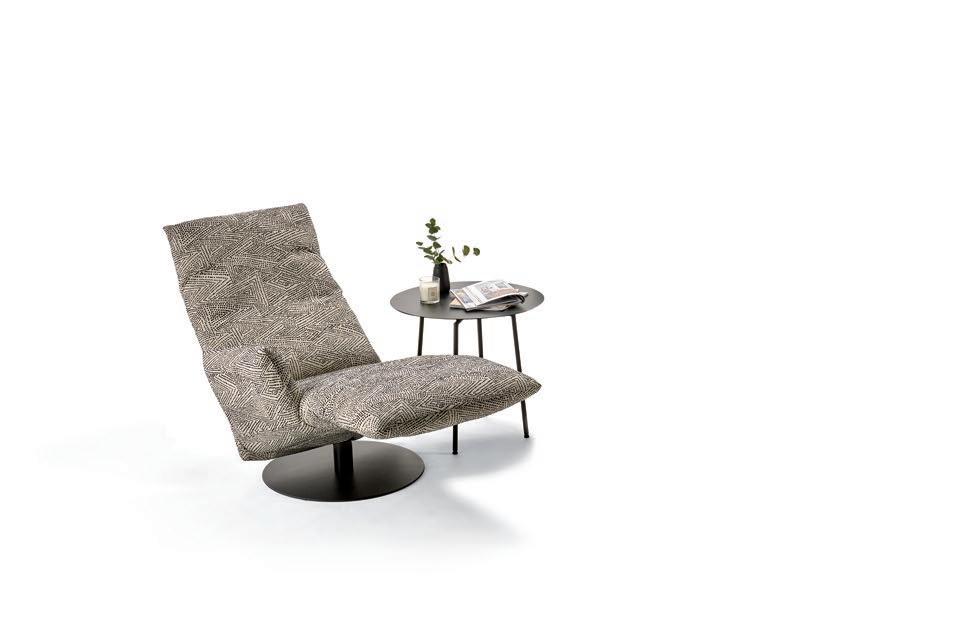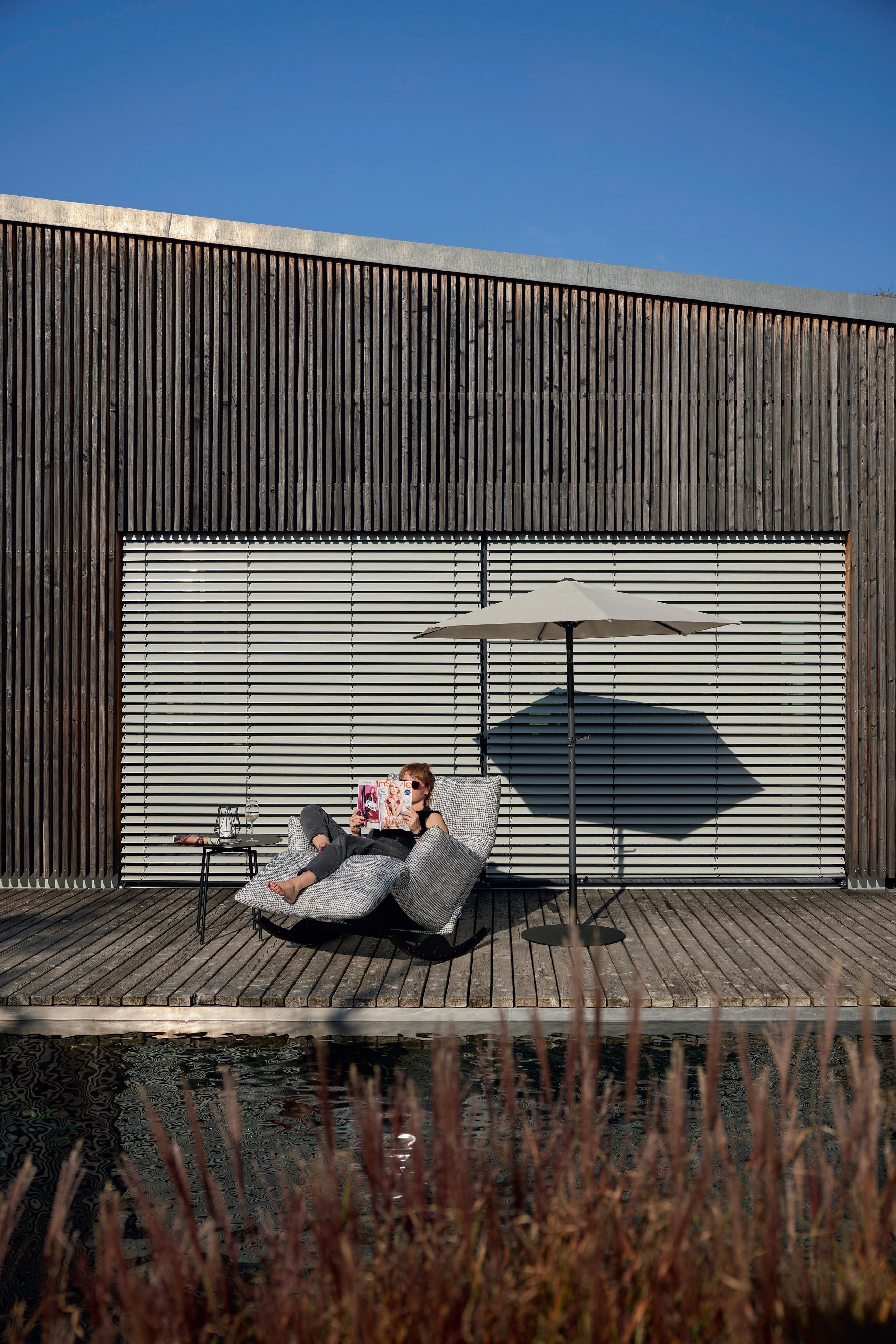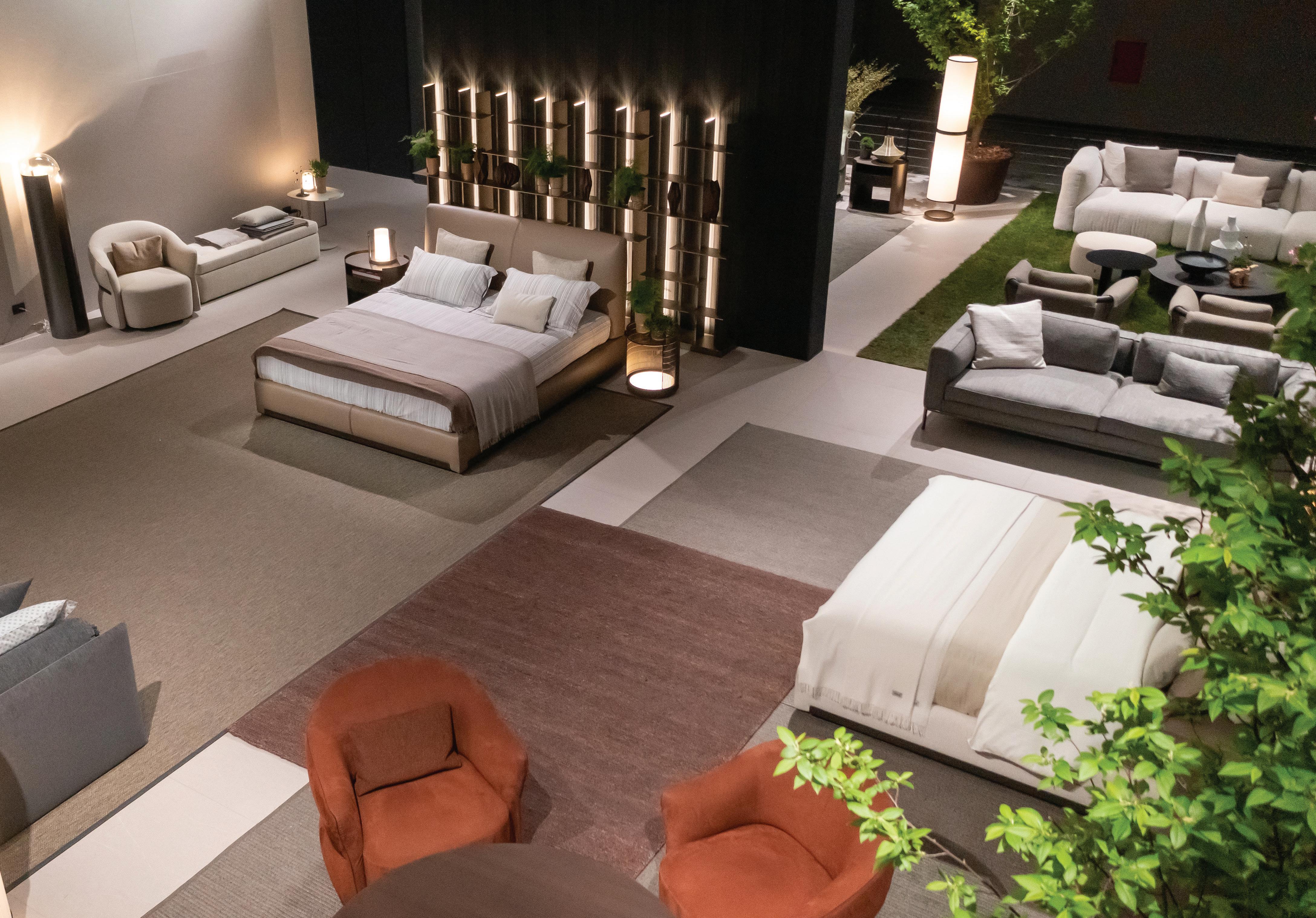SO H

SAROVAR'S BOLD BET
Ajay Bakaya on three decades of championing the mid-market when luxury ruled!
JOURNEY OF EXCELLENCE

PRESENTED BY







Ajay Bakaya on three decades of championing the mid-market when luxury ruled!

PRESENTED BY





Team SOH is pretty chuffed!
Our inaugural issue sparked a phenomenal response. While working on the debut edition, we were cautiously optimistic about how it would resonate with the industry—but this truly surpassed our expectations. We seem to be doing something right! Just as the first issue highlighted the passion, creativity, and resilience of our community, the response to it is a testament to the industry's thirst for insights, meaningful narratives and genuine connections. We're humbled by the appreciation and encouragement we've received, and we're eager to continue delivering content that inspires, educates, and uplifts. As we move forward, we'll be working tirelessly to set new benchmarks for ourselves, showcasing the soul of hospitality through SOH, not only to this industry but other sectors as well.
As a small celebratory dinner, I sit at my favourite table in Hakkasan Mumbai, surrounded by friends who embody the intrepid spirit of entrepreneurship. At this iconic restaurant, thirteen and still going strong, I'm reminded of the magic that happens when passion meets perfection. Tonight, our conversation turns to the vibrant hospitality landscape. My friends, a diverse tribe of entrepreneurs, are eager to explore investment opportunities in this dynamic sector.
And dynamic it is, for in my interactions over a month with stakeholders and leaders from the hospitality industry and other fields of business, one thing is constant: the upbeat sentiment that's propelling this sector forward.
Domestic tourism is booming, with travellers flocking to new and familiar destinations. Chefs are crafting culinary journeys that beckon adventurous palates. Mixologists are pushing the boundaries of craft cocktails, creating signature drinks that complement the dining experience. From boutique hotels to innovative F&B concepts, the creativity and energy are palpable. The recent Union Budget has brought some welcome cheer, with initiatives that will boost travel and tourism.
The numbers tell a compelling story— and savvy investors are taking notice, ready to bankroll the next big idea. They are eager to capitalise on this momentum, injecting capital into projects that promise to disrupt the status quo. From cuttingedge hotel concepts to immersive culinary experiences, the opportunities for growth are vast.
The heartbeat of hospitality is strong, fuelled by the passion and perseverance of its people. As Peter Drucker says, “The best way to predict the future is to create it.” And I'm proud to be part of this resilient, vibrant and beautiful community!

GURMEET KAUR SACHDEV gurmeetsachdev@soulinkkworldwidemedia.com







ED'S LETTER
The first time I read about Ajay Bakaya, co-founder of Sarovar Hotels, I was struck by his unconventional journey. From a start in pharmaceuticals to preparing for the IPS exams, Bakaya’s entry into hospitality was serendipitous. He began his career with The Oberoi, one of India’s leading luxury hotel groups, and eventually co-founded Sarovar Hotels with his colleague, the late Anil Kumar Madhok. Sarovar has become synonymous with democratising the Indian hotel landscape, offering impeccable service across the country at affordable rates.
As Sarovar Hotels celebrates 30 years, Bakaya graces our cover to share insights on carving out the mid-market segment in hospitality.
This edition also features Neel Raheja, Director of K Raheja Corp, known for his strategic partnerships that have propelled Chalet Hotels to the forefront of the industry. Raheja, along with Chalet’s CEO Sanjay Sethi, reveals how strategic expansions and efficient asset management have shaped their success.
One of the most unraveling story in this edition is the compelling narrative of the burgeoning desi middle class, whose newfound aspirations are fueling a surge in travel enthusiasm.
From a design spotlight on Aurika, India’s largest hotel by the number of keys, to the growing trend of hospitalityled luxury branded residences, this edition is packed with intriguing reads.
We’re overwhelmed by the positive response to SOH’s first edition and are grateful for the warm welcome from the hospitality and travel industry. Enjoy Edition 2!
Warm regards,
DEEPALI NANDWANI, EDITOR, SOH
Founder and Publisher
Gurmeet Sachdev
Editorial
Editor Deepali Nandwani
Managing Editor Rupali Sebastian
Contributing Editor Suman Tarafdar
Contributing Writers
Shalbha Sarda
Priya Pathiyan
Columnists
Manav Thadani
K.B. Kachru
Vijay Thacker
Creative
Creative Director Tanvi Shah
Team Songjukta Banerjee, Shiv Soni
Contributing Artists Priyankk Nandwana, Shashank Gautam
Sales Manager
Deepa Rao
Office Manager
Deepak Rao
Accounts Head
Amey Acharekar
For queries:
editorial@soulinkkworldwidemedia.com sales@soulinkkworldwidemedia.com info@soulinkkworldwidemedia.com
Printed and Published by Gurmeet Sachdev on behalf of Soulinkk World-Wide Media LLP. Registered office: 1/2, Old Anand Nagar, Nehru Road, Santacruz East, Mumbai, Maharashtra - 400055. Printed at Silverpoint Press Pvt. Ltd., A-403, TTC Industrial Area, Near Anthony Motors, Mahape, Navi Mumbai – 400709. Editor: Deepali Nandwani. All rights reserved worldwide. Reproducing in any manner without prior written permission prohibited. SOH takes no responsibility for unsolicited photographs or material all photographs, unless otherwise indicated, are used for illustrative purposes only. Unsolicited manuscripts will not be returned unless accompanied by a postage pre-paid envelope. All disputes are subject to the exclusive jurisdiction of competent courts and forums in Mumbai only. Copyright Soulinkk World-Wide Media LLP.
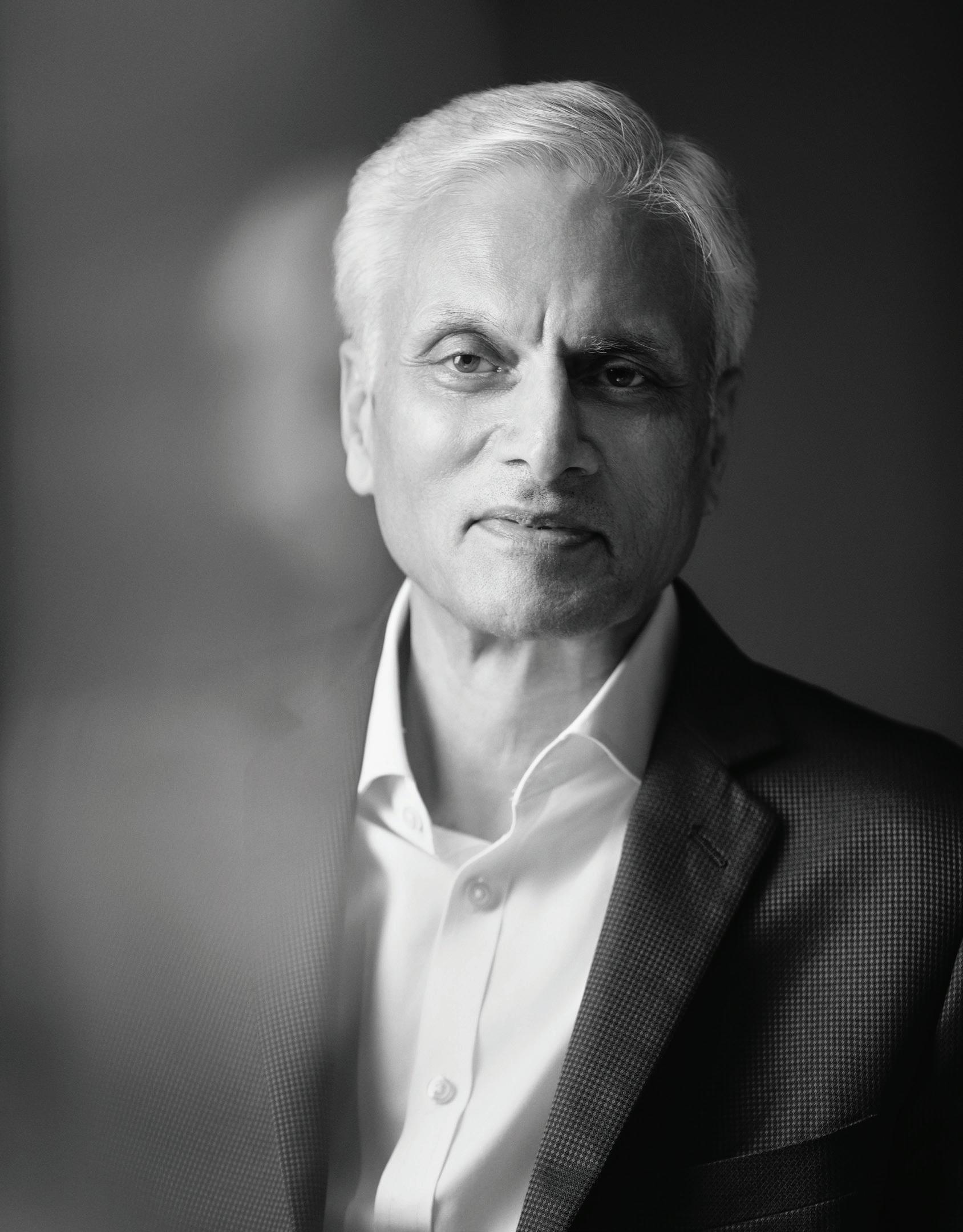
THE MIDDLE PATH TO PROFITABILITY
Rising steadily to pole position in the midscale segment, Sarovar Hotels, helmed by Ajay Bakaya, has transformed the hospitality landscape in India.
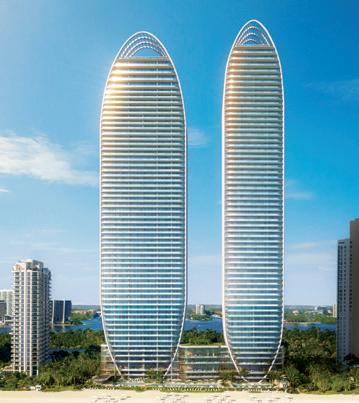
34
Branded Residences
Luxury brands elevate high-end homes into coveted addresses.

106
Managing risks
Vijay Thacker shows the path to robust governance and operational success.

150 Destination Dining
Chefs craft unique gastronomic experiences in unexpected locations.

160
Speakeasy with style
The Leela Palace Bengaluru's awardwinning bar ZLB23.

86
Crafting an experience
Manish Malhotra’s cultural and spiritual journeys take him to striking destinations.
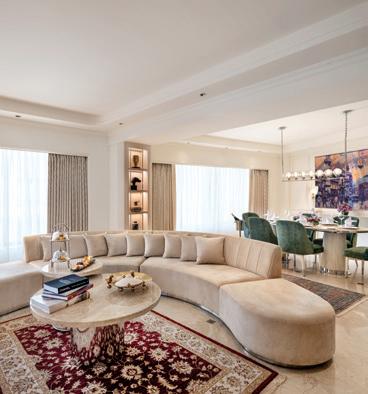
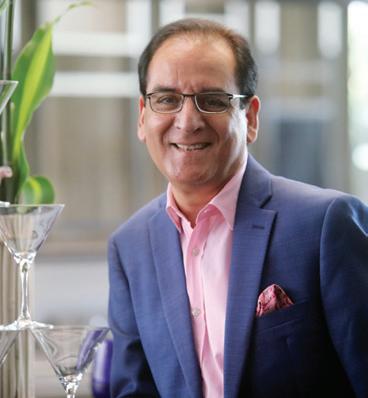
62
Decoding the budget
KB Kachru of Radisson Hotel Group analyses the government's financial blueprint for FY ’24-25.
134
Aurika Mumbai Skycity
How did India's largest hotel overcome challenges of site and situation?
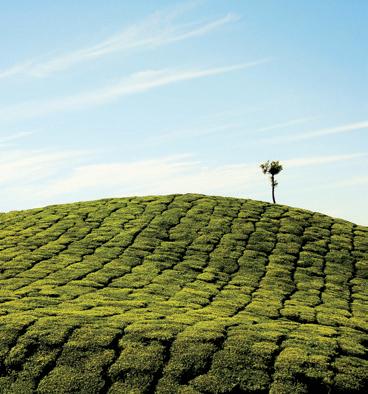
66
Domestic tourism
The Indian traveller is eager to visit new destinations and return to tested favourites.


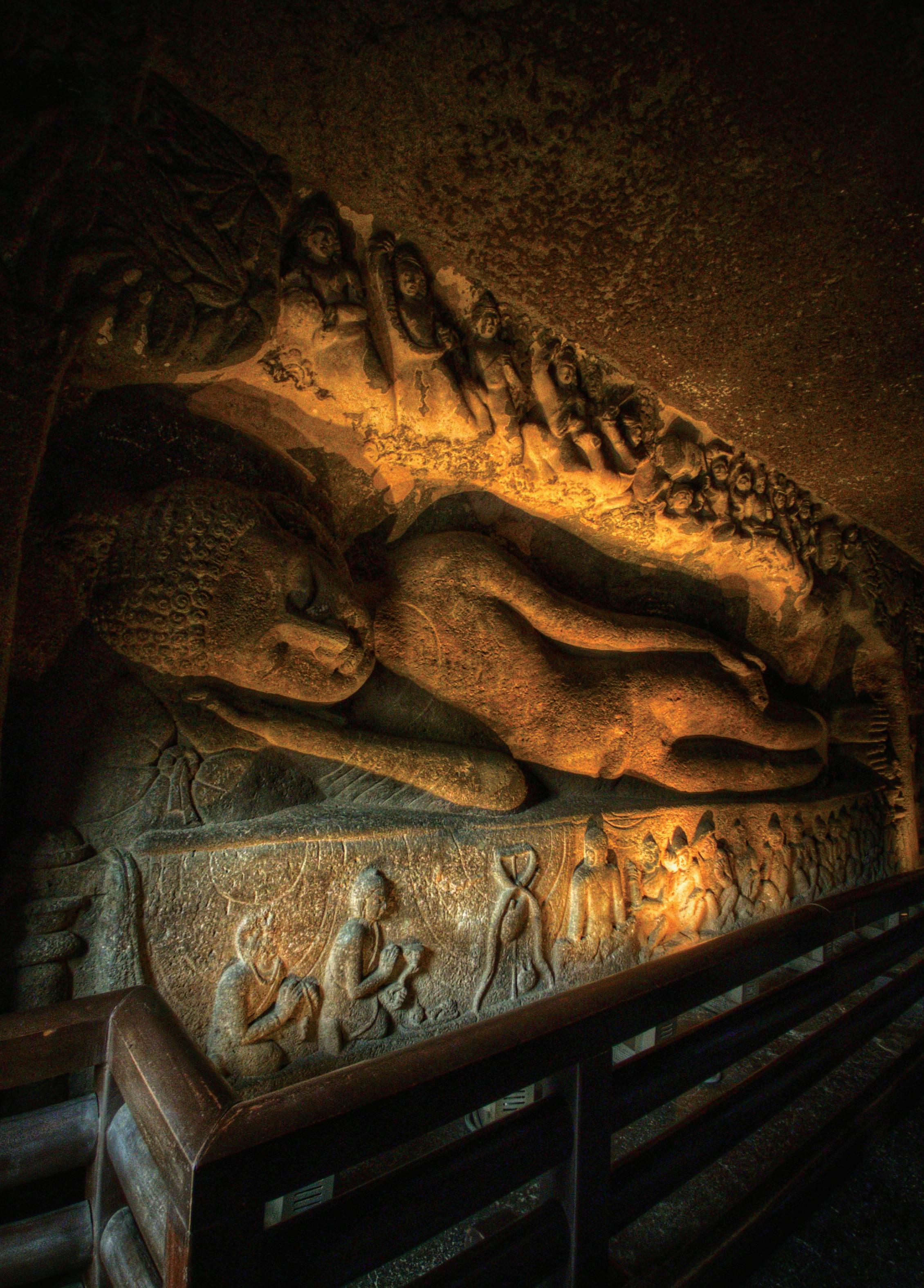
Even while Fly 91 makes it affordable for people to explore the country's smaller destinations, Indigo is connecting Bengaluru to Lakshadweep. These movements are part of India’s gameplan to create an infrastructure that will connect destinations which are underserved.
DEEPALI NANDWANI
India’s new regional airline, Fly 91 (named after the country code 91, not ninety-one), is set to add more energy to domestic travel by bridging gaps between cities and towns that have often been overlooked in the national aviation network. Founded by Manoj Chacko, Fly 91 aims to spotlight India's smaller and harder-to-reach destinations, enhancing the vibrancy of domestic tourism.
Fly 91’s initial routes include unique destinations such as Agatti in Lakshadweep, the picturesque coastal region of Sindhudurg, Jalgaon and Pune in Maharashtra, as well as popular hubs like Goa, Bengaluru, and Hyderabad. These destinations are part of the government's Regional Connectivity Scheme (RCS), UDAN, which seeks to make air travel accessible to underserved areas.
Chacko, with a background in major brands like Emirates and SOTC, highlights the importance of making air travel accessible: “People from smaller towns are aspirational, and those in big cities want to explore lesser-known locales that are rich in heritage and culture. Ensuring seamless and affordable air travel is key to fulfilling these aspirations.”
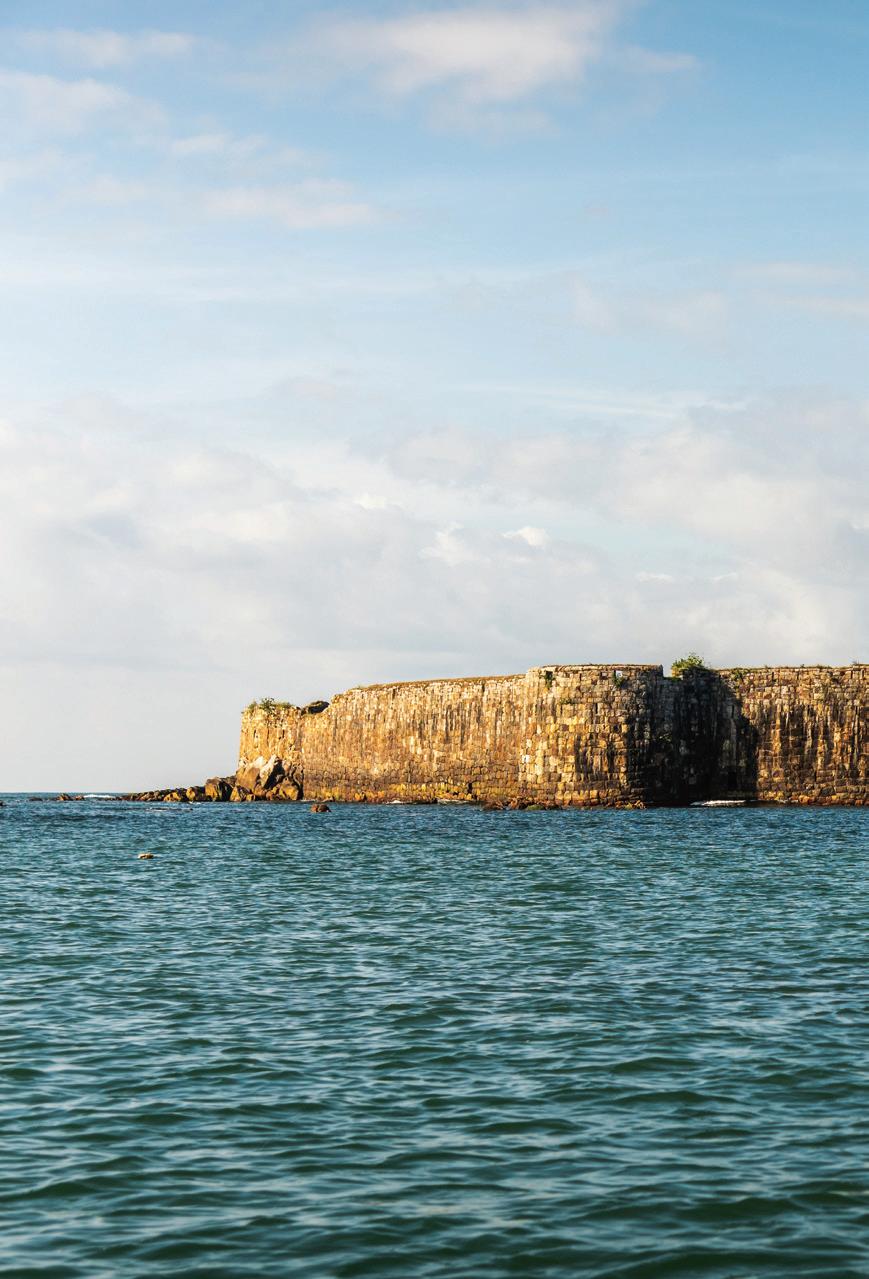


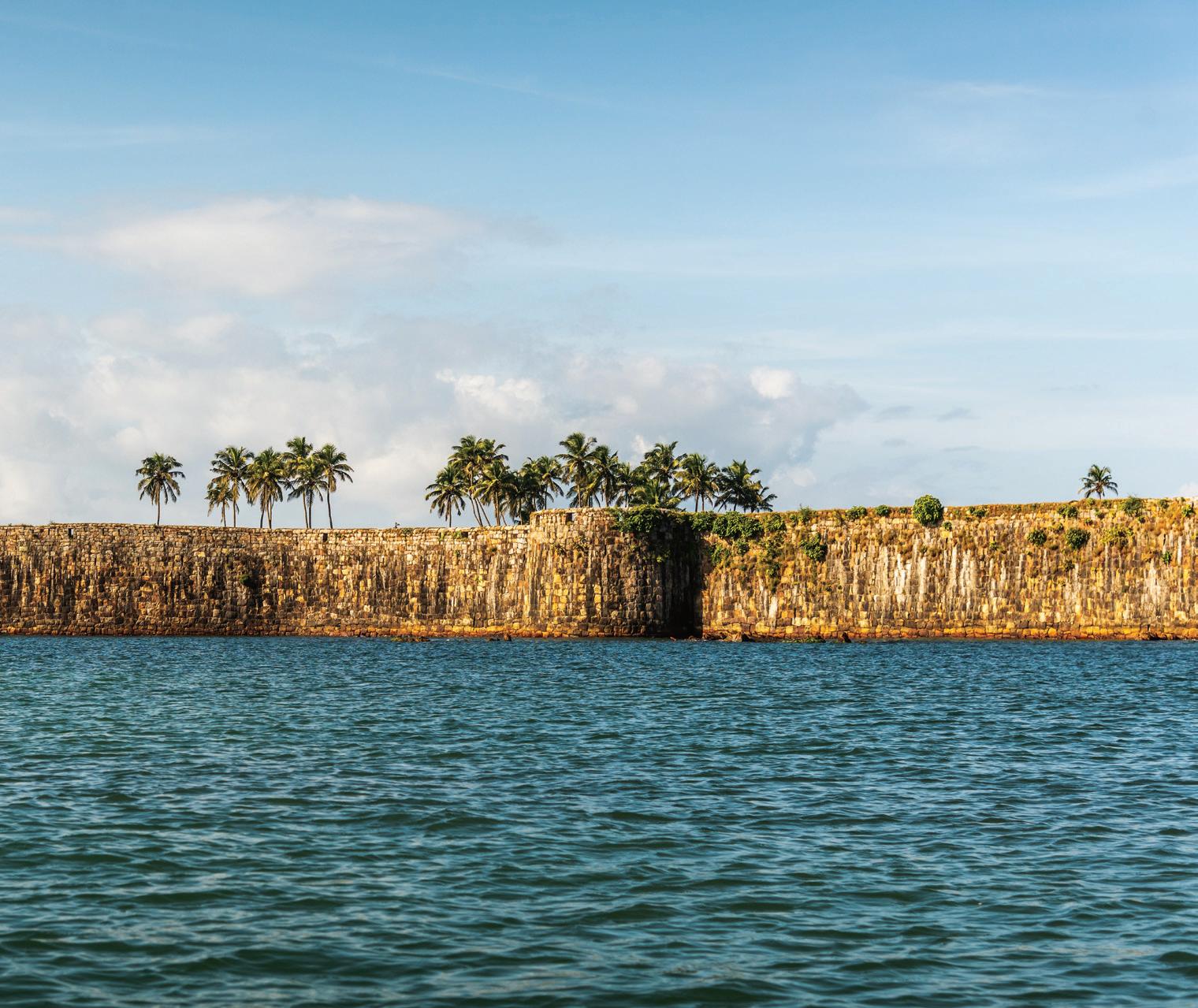
This greenfield airline marks a significant milestone, operating from a greenfield airport and reflecting the increasing number of airports and enhanced quality of life across India.
Even as Fly 19 took flight from Goa, Indigo announced that it would be connecting Bengaluru with Lakshadweep, making it easier to fly to the island cluster. And Alliance Air has also connected Kochi with Lakshadweep's Agatti island. Agatti, at the centre of the aviation transformation, is a 6 km long land surrounded by beautiful lagoons and coral reefs.
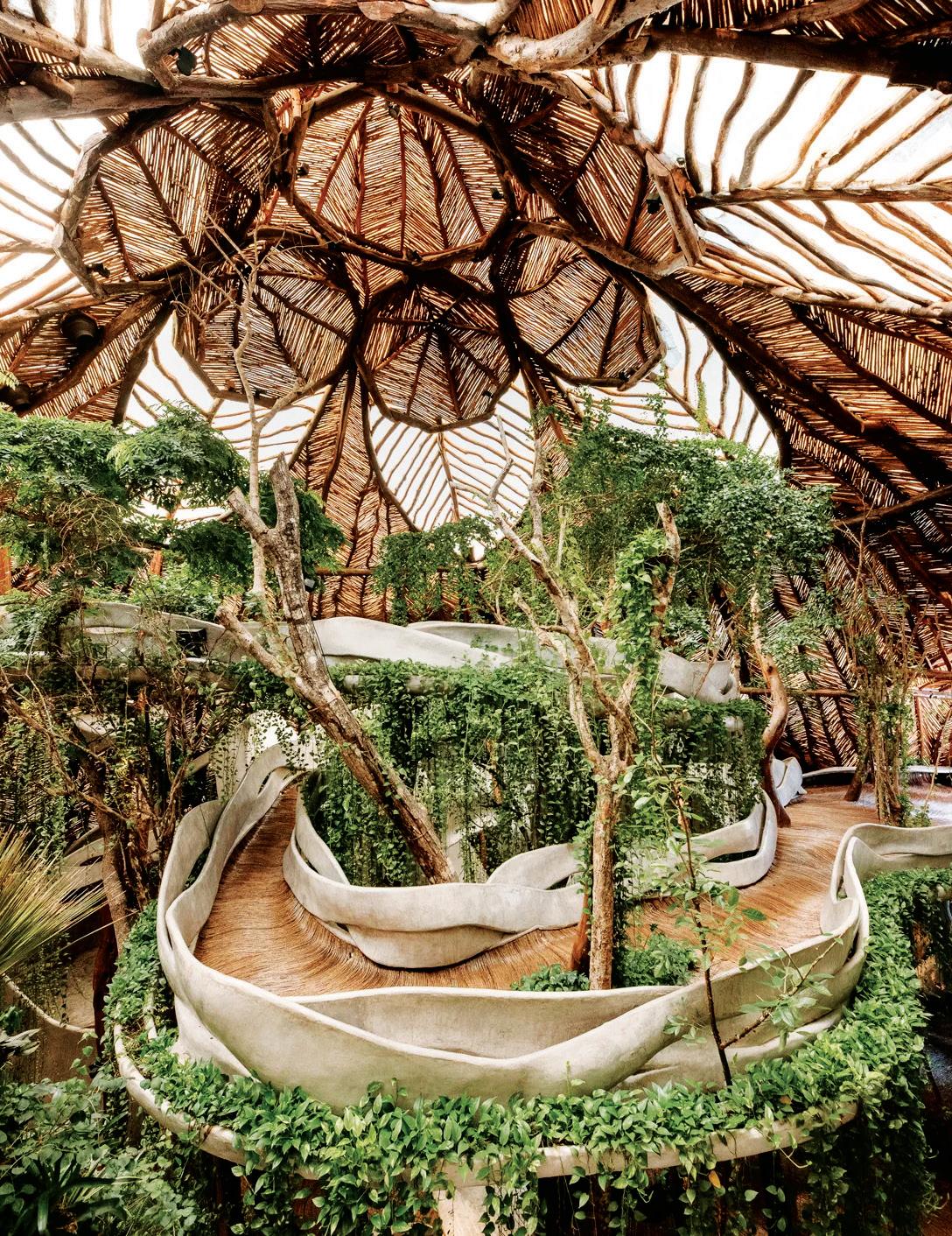
The distinctive feature of Tulum's eco-resort Azulik is an art museum called SFER IK. Azulik's founder, Eduardo Neira worked with local craftsmen and a symphony of materials that immerse guests in an extraordinary art-viewing experience.

As travellers increasingly seek authentic connections with nature, Indian hoteliers must tap into the power of biophilic design to stay ahead.
RUPALI SEBASTIAN
Biophilic interior designs foster a connection to the living world by incorporating elements such as Natural materials and furnishings, living walls, plants, natural lighting, and indoor water bodies.
Human Spaces 2.0: Biophilic Design in Hospitality, a study undertaken by Terrapin Bright Green (a sustainability consulting firm), Interface (a leading flooring company committed to ‘green’ products and practices) and Gensler (a global design and architecture giant active in earth-sensitive initiatives), found that biophilic hotel design and décor is a strong factor in creating a unique and memorable guest experience. Key takeaways include:
36% more guests spent time in biophilic hotel lobbies than in conventional lobbies.
While the websites of both hotel types discuss “experience” the same amount, guest reviews of biophilic hotels mention “experience” twice as often as reviews of conventional hotels.
Hotel guest rooms with a view to water are priced on average 11%-18% higher than rooms without a view.
Price premiums can be up to 12% for hotel guest rooms with views to famous landmarks or nature compared to rooms without a view.
A room facing a garden or a pool. A suite facing the valleys and mountains. We all love a room with a view. In fact, such spaces tend to be priced higher than a ‘normal’ room. Why is that? It's because of humanity’s deep affinity to nature. Summed up in one word—Biophilia, a term which originates from a combination of the ancient Greek words ‘bio’ (life), and ‘philia’ (love).
Studies centred on the impact of biophilic design on humans illuminate a number of physiological and psychological benefits: it can reduce stress, improve cognitive function and creativity, improve our wellbeing, and expedite healing. Hospitality design—which ultimately aims to create targeted, immersive experiences that are memorable and relieve stress—stands to gain a great deal from this nature-oriented spacemaking route.
In more recent years, accelerated by the pandemic and lockdowns, the affinity for this type of design has been steadily increasing as the number of travellers seeking to connect with the natural world rises. Additionally, with both millennials and adults in Gen Z standing out for their high levels of engagement with the issue of climate change, biophilic design becomes particularly important within the context of hospitality interiors while creating relevant and remarkable spaces.
Adopting biophilic design in a hotel can provide several commercial benefits:
Natural elements can create a calming and inviting atmosphere. This enhances the overall guest experience, leading to higher satisfaction and positive reviews.
Nature-oriented spaces attract guests seeking unique and aesthetically pleasing environments. This can lead to higher occupancy rates.
Hotels with biophilic designs can often charge premium rates an enhanced guest experience and unique appeal.
The relaxing and restorative environment can encourage guests to extend their stays.
This kind of design can create a strong brand identity that is sure to appeal to ecoconscious and wellnessoriented travellers.
Natural light and ventilation, can reduce the need for artificial lighting and HVAC systems, leading to lower energy costs.
Biophilic design can lead to employees being likely to be more satisfied and productive in a pleasant working environment.
Incorporating biophilic design can potentially qualify the property for green certifications and awards.
With a positive and memorable experience, guests are more likely to return and recommend the hotel to others, driving repeat business and word-ofmouth referrals.
Anchoring a busy avenue, a lush wall of green plants rises up neatly three storeys to clothe a façade of blackened steel opening profiles and timber panels. This is 1 Hotel Central Park, blanketed by English ivy, some 36,000 in number, working diligently to produce oxygen, absorb greenhouse gases, reduce the building’s surface temperature in the summer, and insulate it in the winter. Designed by AvroKO, this LEED-certified urban oasis is adorned with green clusters, artfully orchestrated against a rich material composition of exposed terracotta block walls, blackened steel columns and door and window frames, and reclaimed timber floor and ceiling elements.
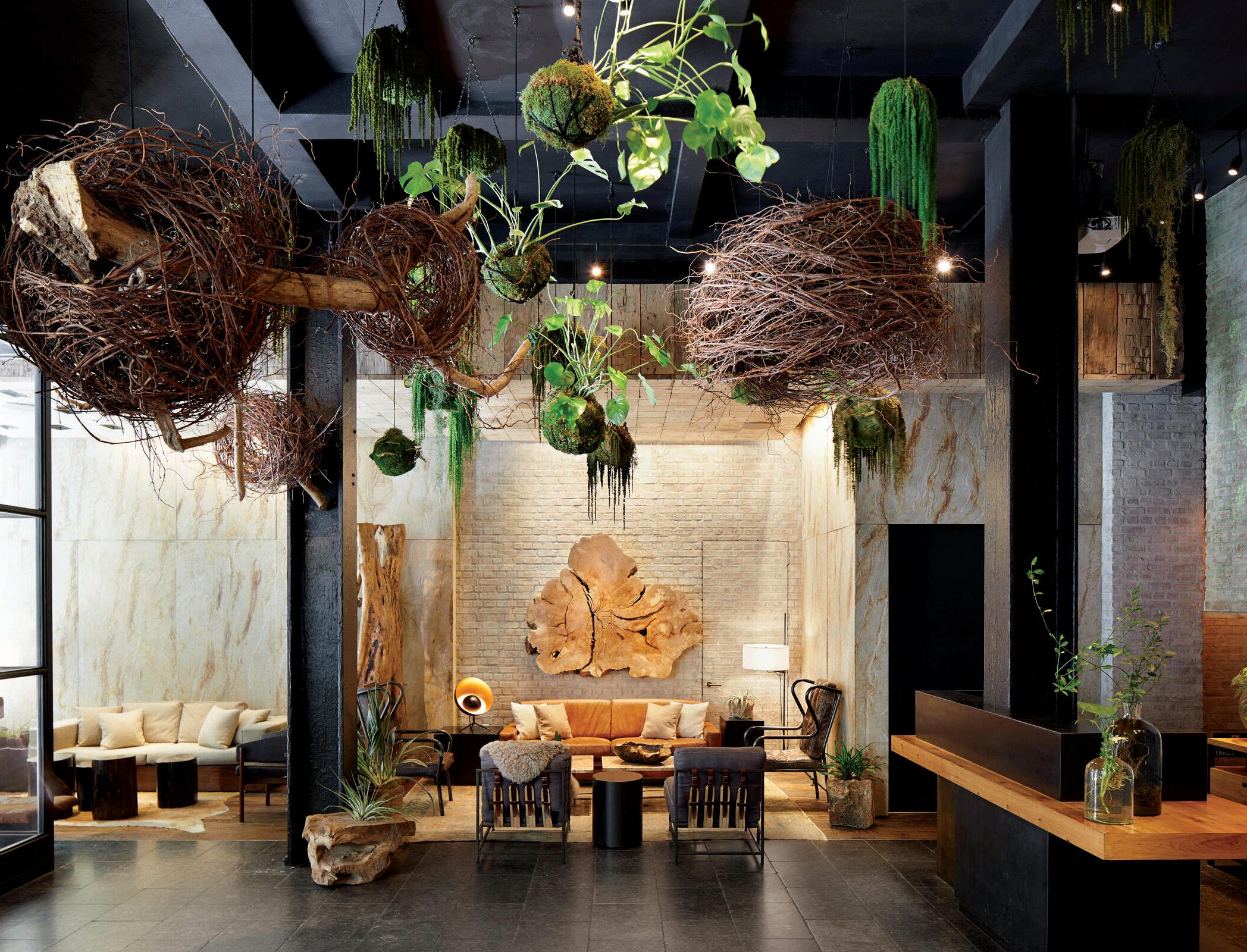
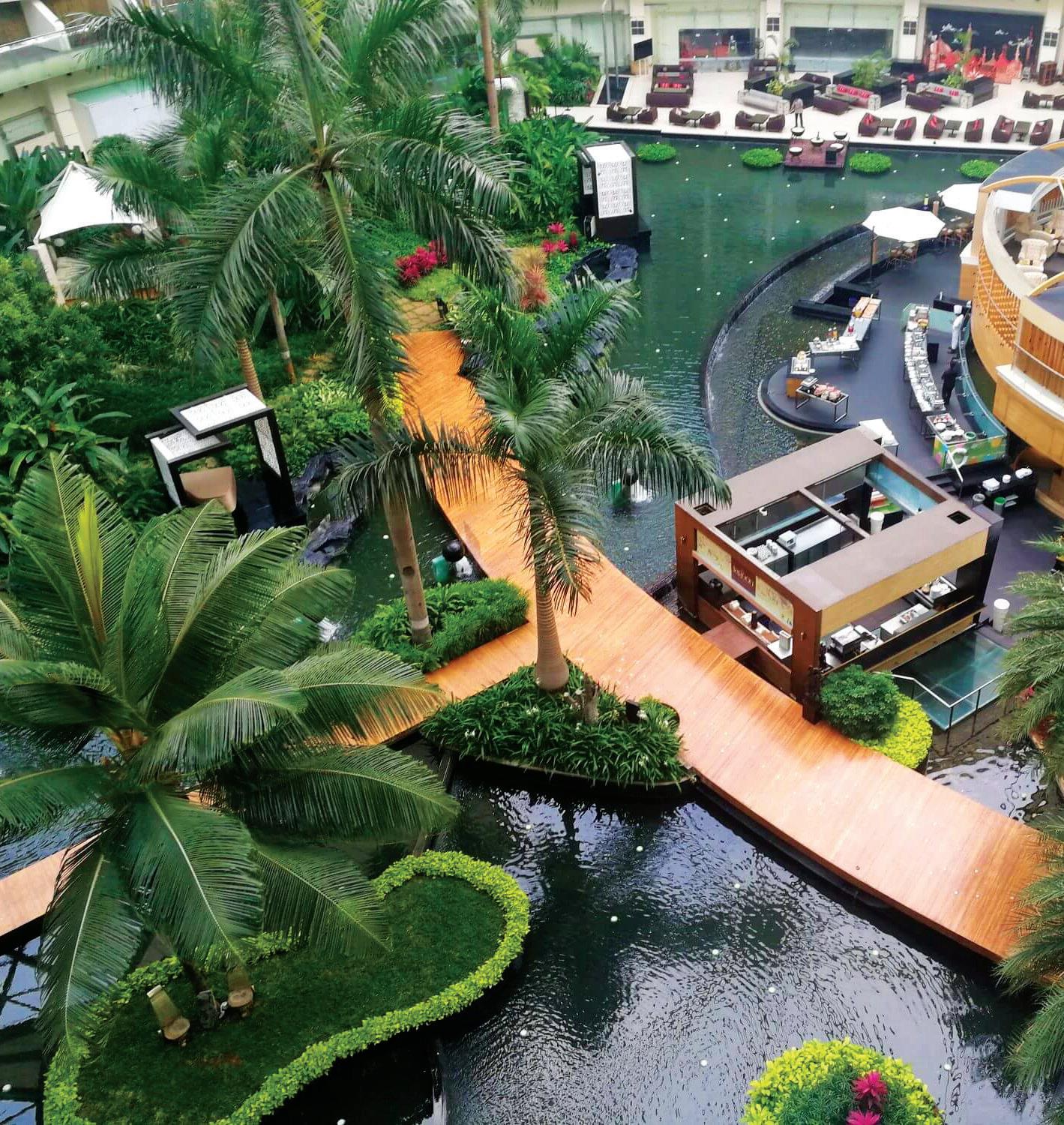
Architect Bobby Mukherji, a leading name in the hospitality design niche, has always endeavoured towards natural elements even before the term ‘biophilic design’ became popular in the Indian sector. Hotel Sahara Star, which he designed in 2005, is articulated as a spaceship-like form. Within this futuristic envelope beats a green heart: a 50,000 sq.ft. central atrium, imagined as a tropical garden complete with waterbodies, water-facing decks, pathways, bridges, a waterfall and vegetation (including Royal Palms retained from an earlier hotel that once stood there). This soothing volume occupies centerstage of the spatial narrative, with rooms, restaurants and other services circling this natural space.


Located within the historic St Pauli Bunker in Hamburg, REVERB by Hard Rock is designed with a commitment to lessen environmental impact. A total of 4,700 shrubs and 16,000 perennials have been planted on the property. Around 10,000 sq.mtr. of green and communal spaces have been created with the help of environmental scientists. The roof garden, which is open to the public, can be reached via a 560-metre-long, rail-lined 'mountain path', which starts at ground level on the north side of the bunker and offers impressive panoramic views as you climb.
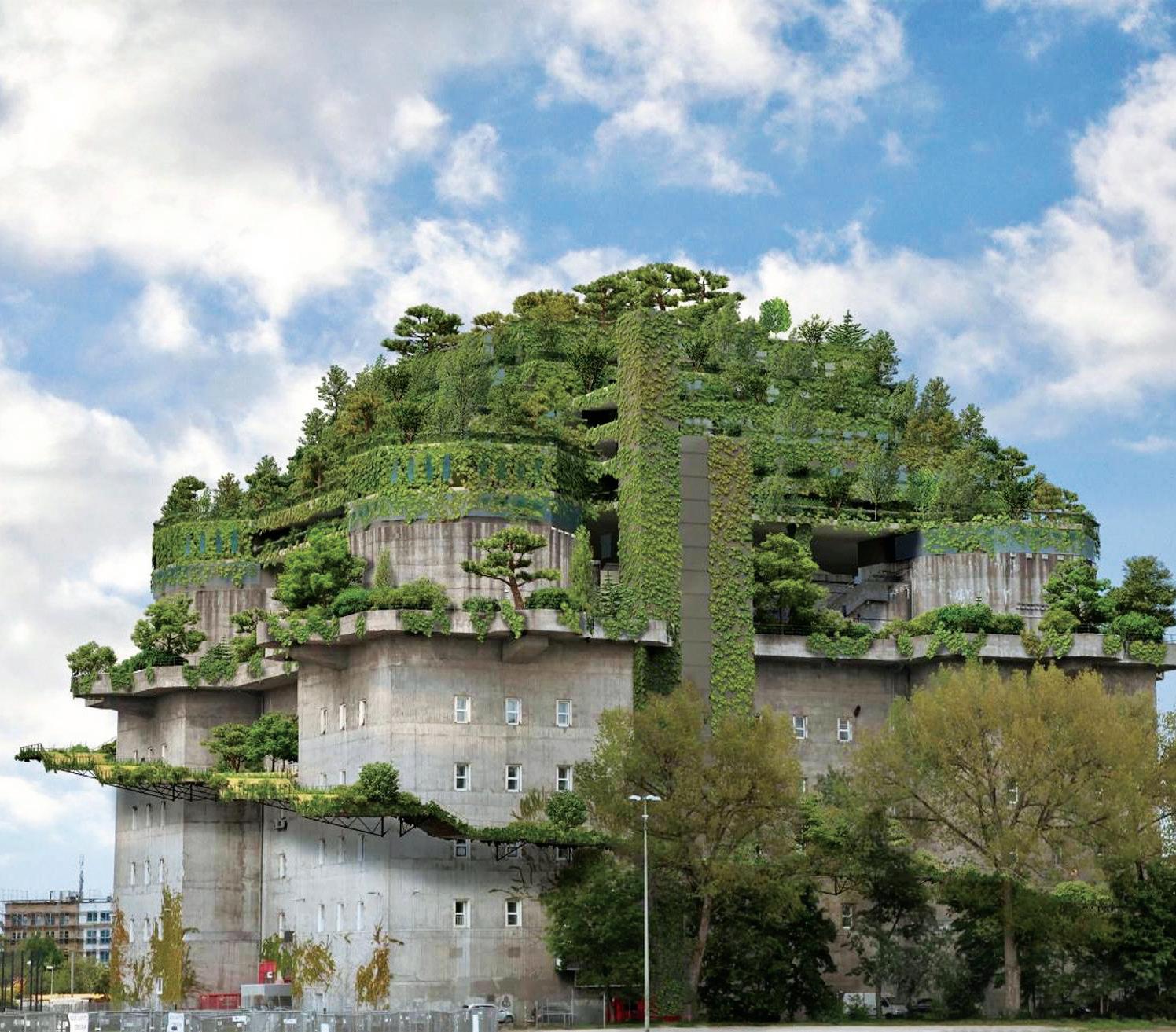
Singapore is the poster child for biophilic design, and one stunning example is the Parkroyal Collection Pickering Hotel, designed by WOHA. Envisioned as a hotel in a garden, the Green Mark Platinumrated building features cascading greenery that’s visible from guest rooms and communal spaces. Corridors, lobbies and common washrooms are designed as garden spaces with stepping stones, planting and water features. This creates an alluring resort ambience with natural light and fresh air. Deep overhangs work together with leafy foliage to screen spaces from the weather and direct sun.
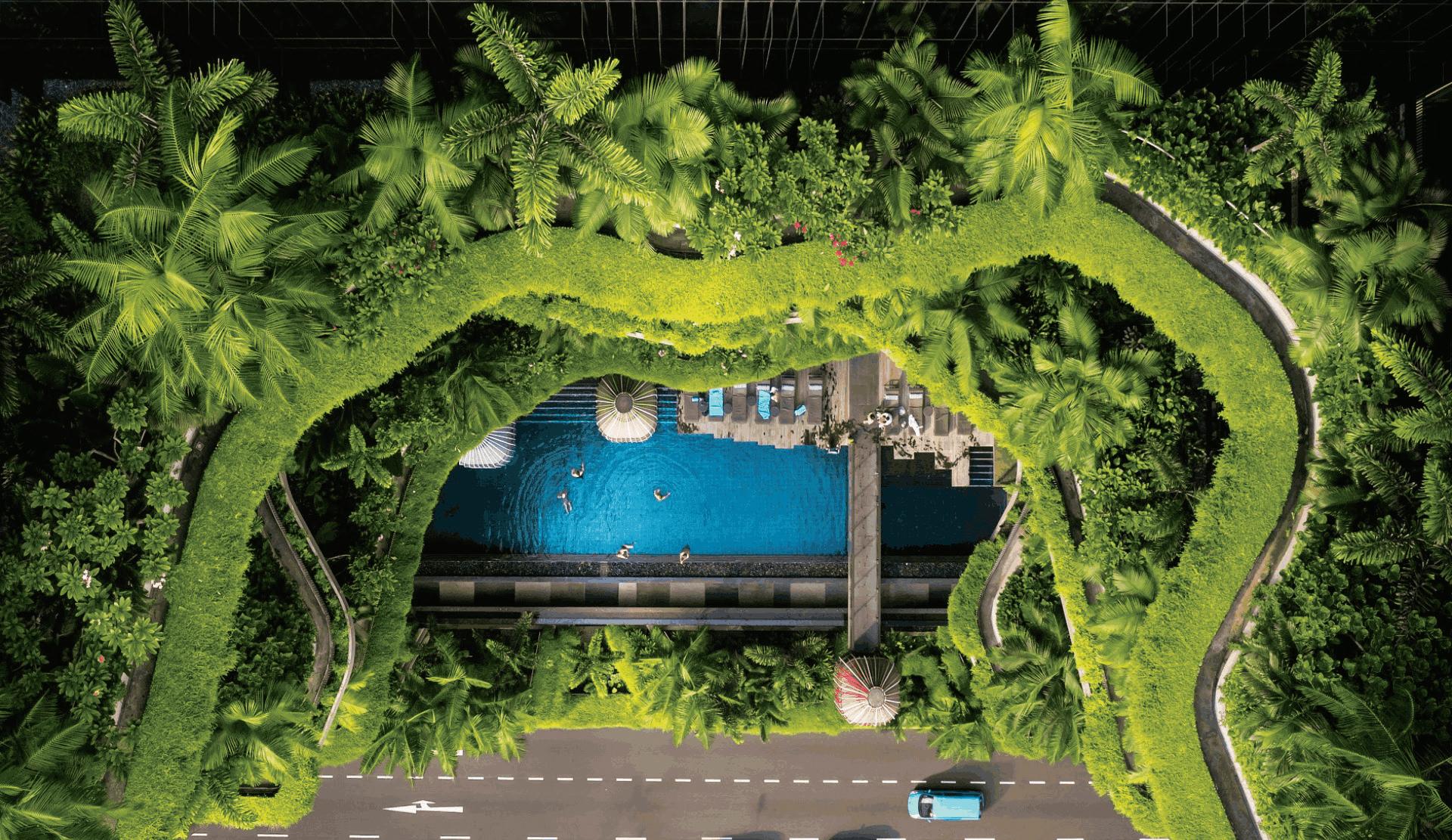

SOH DRINK | THE BARTENDER’S HANDBOOK
Comte de Grasse, founded by an Indianorigin entrepreneur, fuses centuries-old perfumery traditions with innovative technology to craft luxurious spirits that can elevate any high-end bar.
DEEPALI NANDWANI
The fragrant heritage of Grasse, a picturesque town in southeastern France, has shaped the global perfume industry. This scenic region with fields of tuberose, roses, jasmine, and violets, provides the ideal environment for perfumeries crafting fragrances for the world's leading brands. Home to perfume development centres of luxury brands such as Chanel, Dior, and Louis Vuitton, Grasse is where the iconic jasmine for Chanel No. 5 is cultivated.
Bhagath Reddy, a former Bengaluru resident with tech antecedents and a passion for fine spirits, has leveraged Grasse’s perfumery traditions to establish the world’s first liquor-tech company to reinvent the rules of the luxury spirit game.
Comte de Grasse has distilled and launched luxury spirits that meld the best of distilling traditions and Grasse’s fragrance traditions. “We have used technology that pushes the boundaries of flavour extraction in the alco-bev industry,” says Reddy.
BY

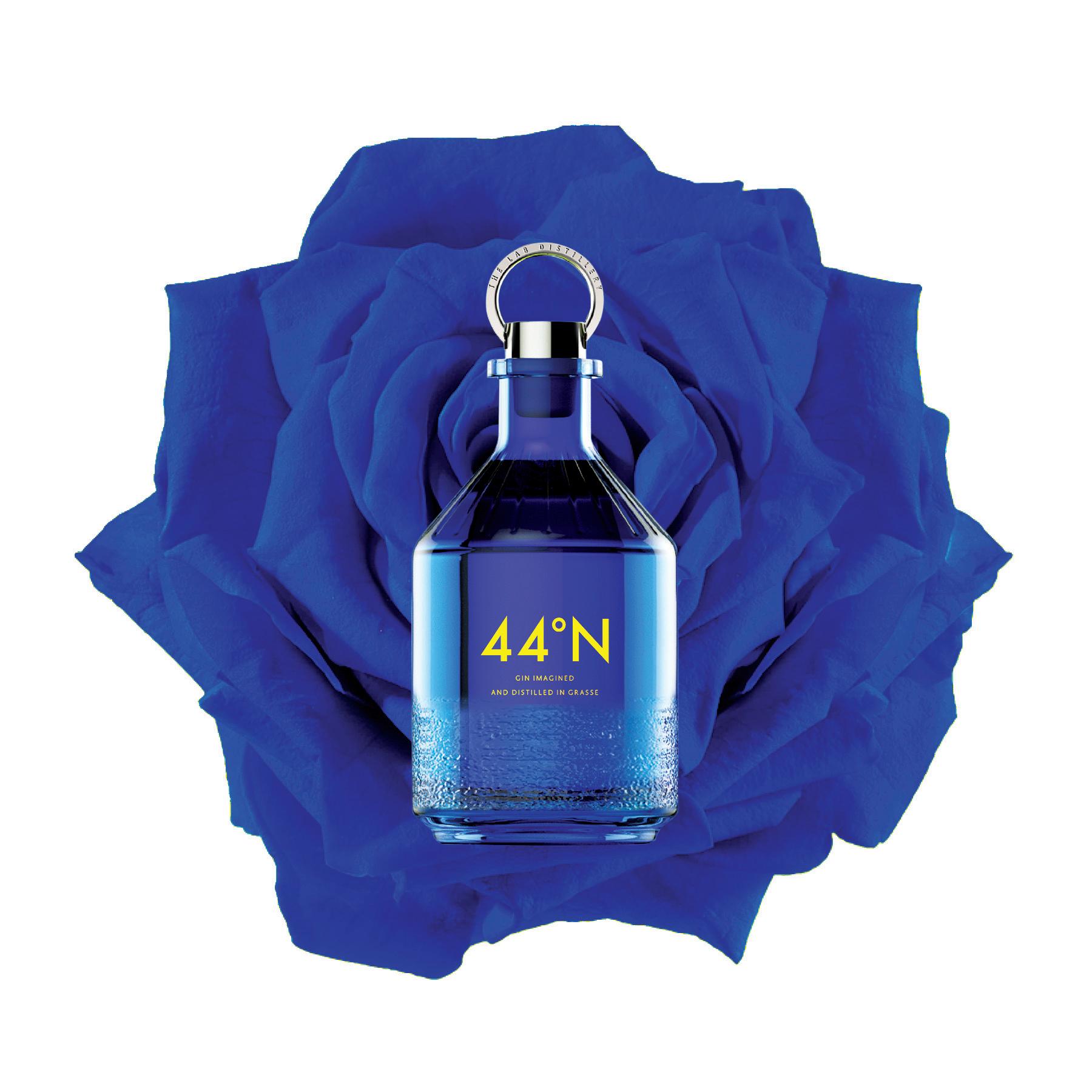
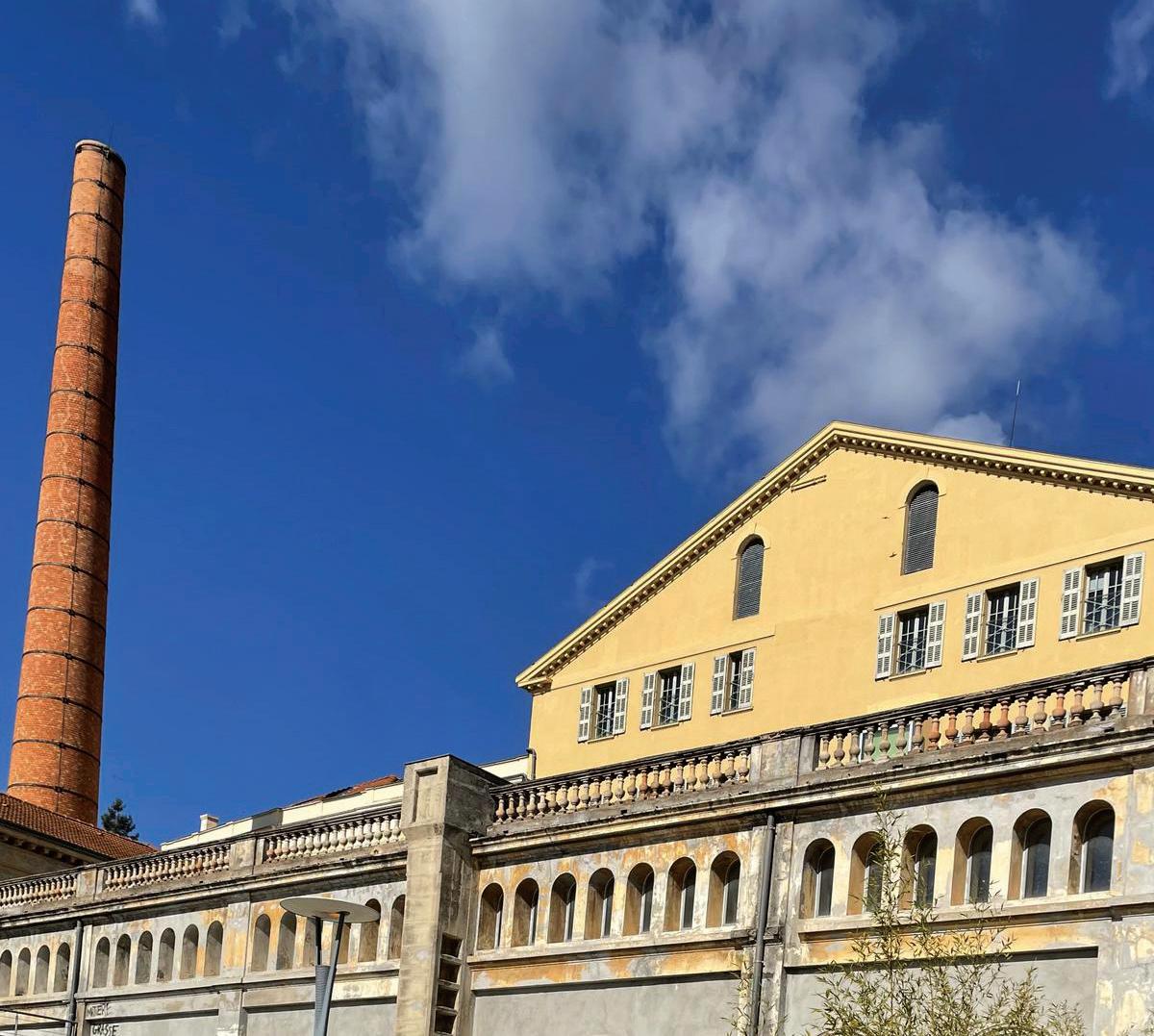
Comte de Grasse's luxury spirits, backed by innovative distillation and unique perfume profiles, can elevate the offerings of any high-end bar. Their flagship 44°N Gin, the first to be distilled on the French Riviera, pays homage to Grasse with 22 botanicals, including local favourites such as verbena, immortelle, and jasmine. They also offer 06, a meticulously crafted 100% French Rosé Vodka, showcasing their mastery over flavour extraction.
Comte de Grasse's state-of-the-art distillery is housed in a repurposed 200-year-old perfume factory in the Provençal landscape. Drawing from perfumery techniques such as ultrasonic maceration and CO2 extraction, they craft 44°N Gin, a spirit capturing "light as a flavour and illumination as a scent," says Reddy. The gin's flavour layering, inspired by fragrance layering, results in a luxurious spirit with distinct notes. For 06, a meticulous liquid-to-liquid extraction
Fuelled by younger consumers and a growing economy, the Indian luxury market, including spirits, is set to triple by 2030. Globally, niche categories such as agave-based spirits and whiskeys are driving the industry, while in urban India, a shift towards "no and lowalcoholic beverages" is evident. In urban India, the consumption of hard spirits has declined by 20-30%.
Comte de Grasse, a brand merging perfumery and distillation, embodies this trend by creating sustainable luxury spirits rooted in history and sensory experience. They utilise innovative technology to challenge traditional notions of quality, offering a modern approach to spirit production.
Says Reddy, “Luxury drinks as a segment have relied heavily on age and tradition as a marker for quality and there has been little innovation other than exalted age claims. At Comte De Grasse, by using science as a disruptor for tradition, we aim to pioneer a more modern approach to sustainable luxury spirit production and create distinctive, qualitative spirits that offer a unique experience.”
B H AGAT H R E D DY FOUNDER, COMTE DE GRASSE
“We have used technology that pushes the boundaries of flavour extraction in the alco-bev industry.”
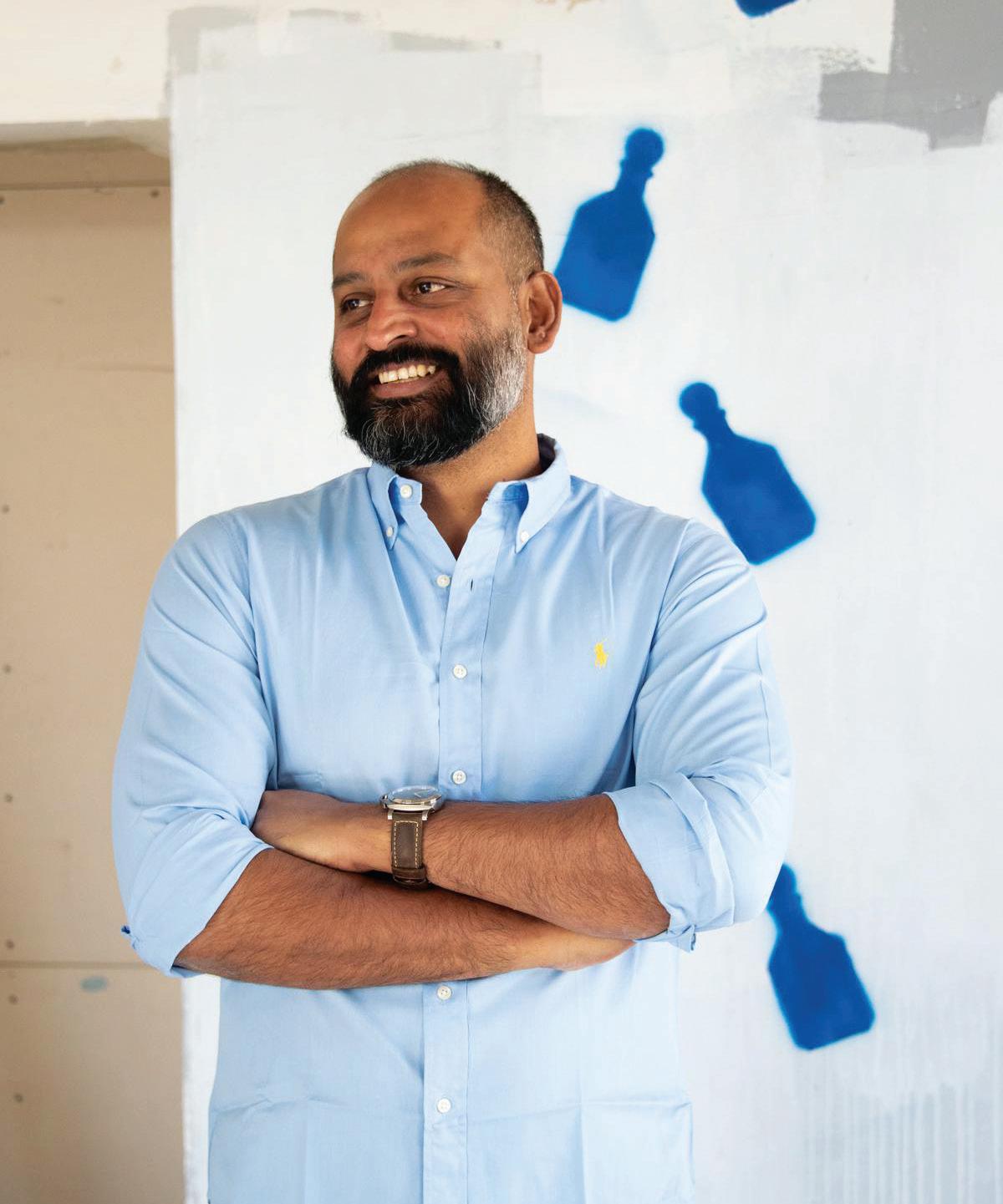

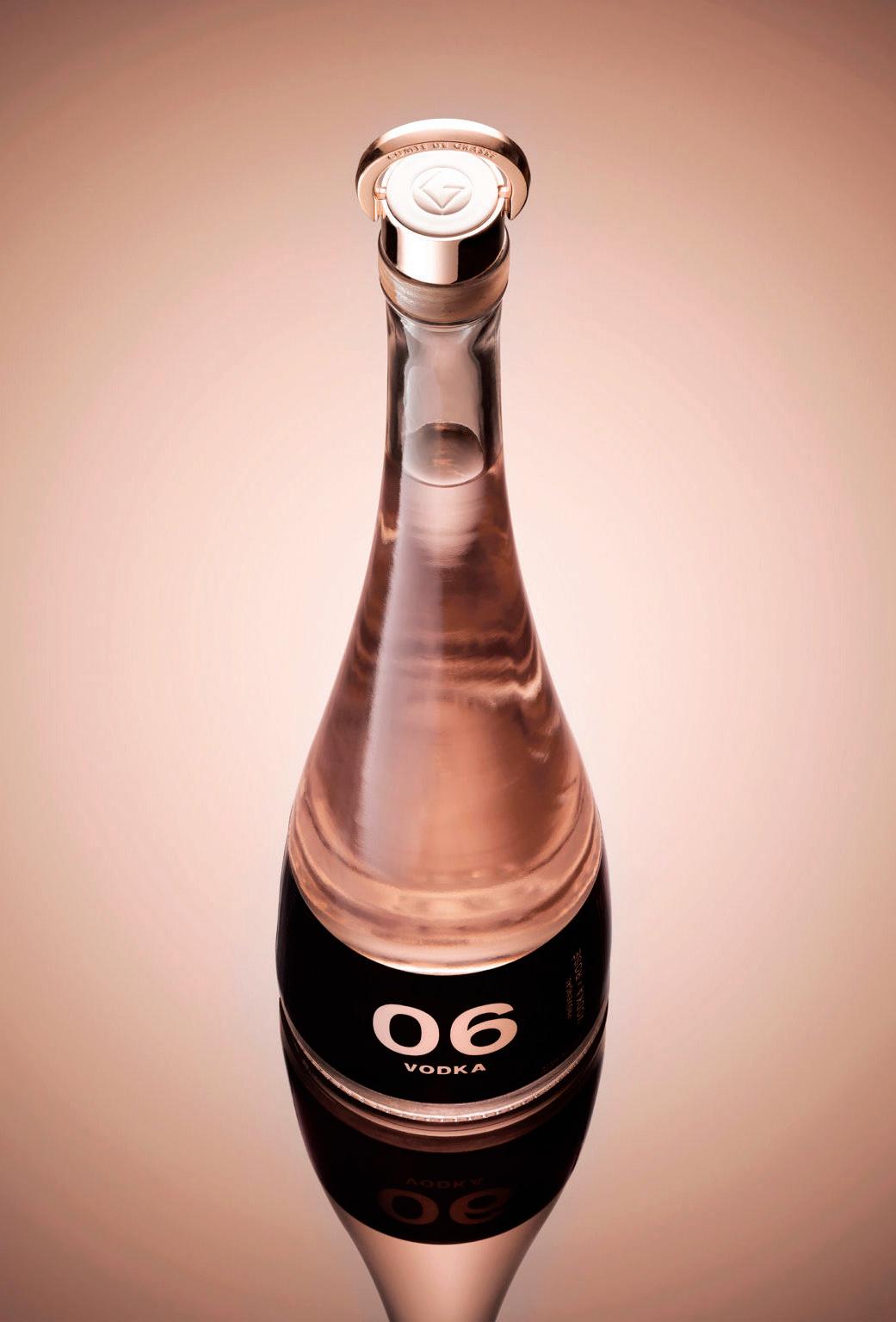
OPPOSITE: Comte de Grasse's distillery is housed in a 200-year-old perfume factory.
LEFT: 06 is concocted by infusing organic rosé wine into French winter wheat vodka.
BELOW: Rose is a popular botanical used in Comte de Grasses's luxury spirits.
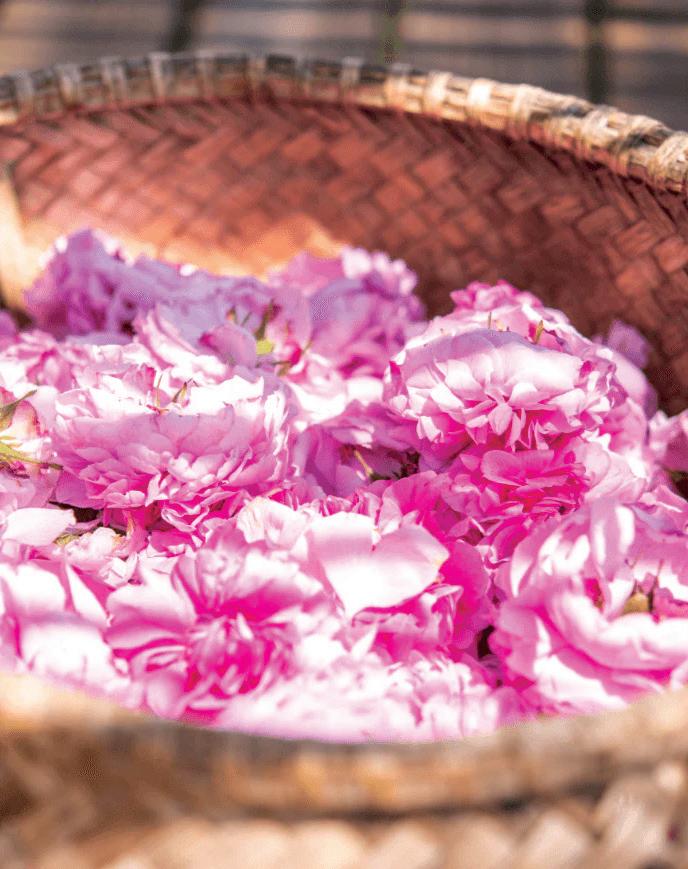


infuses organic rosé wine from Chateau Vert, AOP Côtes de Provence into a velvety base of French winter wheat vodka, creating an elixir reminiscent of the French Riviera.
44°N gin boasts a complex aroma profile, with fresh citrus top notes, evolving into floral and herbaceous mid-notes, and finishing with warm, spicy base notes. Presented in a blue Klein glass bottle inspired by perfume bottles, its design echoes the sun and the Mediterranean Sea.
06 vodka, a delicate pink hue reminiscent of Provençal sunsets, is housed in a sleek bottle. Its aroma opens with floral notes and hints of strawberry, leading to a palate of luscious white peach. Enjoyed neat, with tonic, or in a martini, it offers a refined and complex drinking experience.
As dining trends shift from formal to casual, Japanese izakayas, focusing on seasonality, are becoming popular hangouts for Indians. They present an opportunity for food-forward hotels and standalone outlets to capitalise on the growing interest in this unfussy dining style.


Move aside sushi-sashimi. The duo, which represented the cuisines of Japan in India for almost a couple of decades, is at last getting multiple support acts from a range of other dishes. With about 1,500 Japanese companies registered in India, and about 10,000 Japanese expats residing in the country, it is no wonder that the demand for Japanese restaurants has skyrocketed. However, the popularity of izakayas is not limited to the Japanese in India. Indians, themselves, are experimenting with izakaya-style dining.
Significantly, while the earlier generation of best-known outlets serving Japanese tended to be in premium locations—usually within luxury hotels, such as Wasabi by Morimoto, Megu, San:Qi, Sakura and many others, a newer generation of outlets are more casual in look and feel, taking inspiration from the

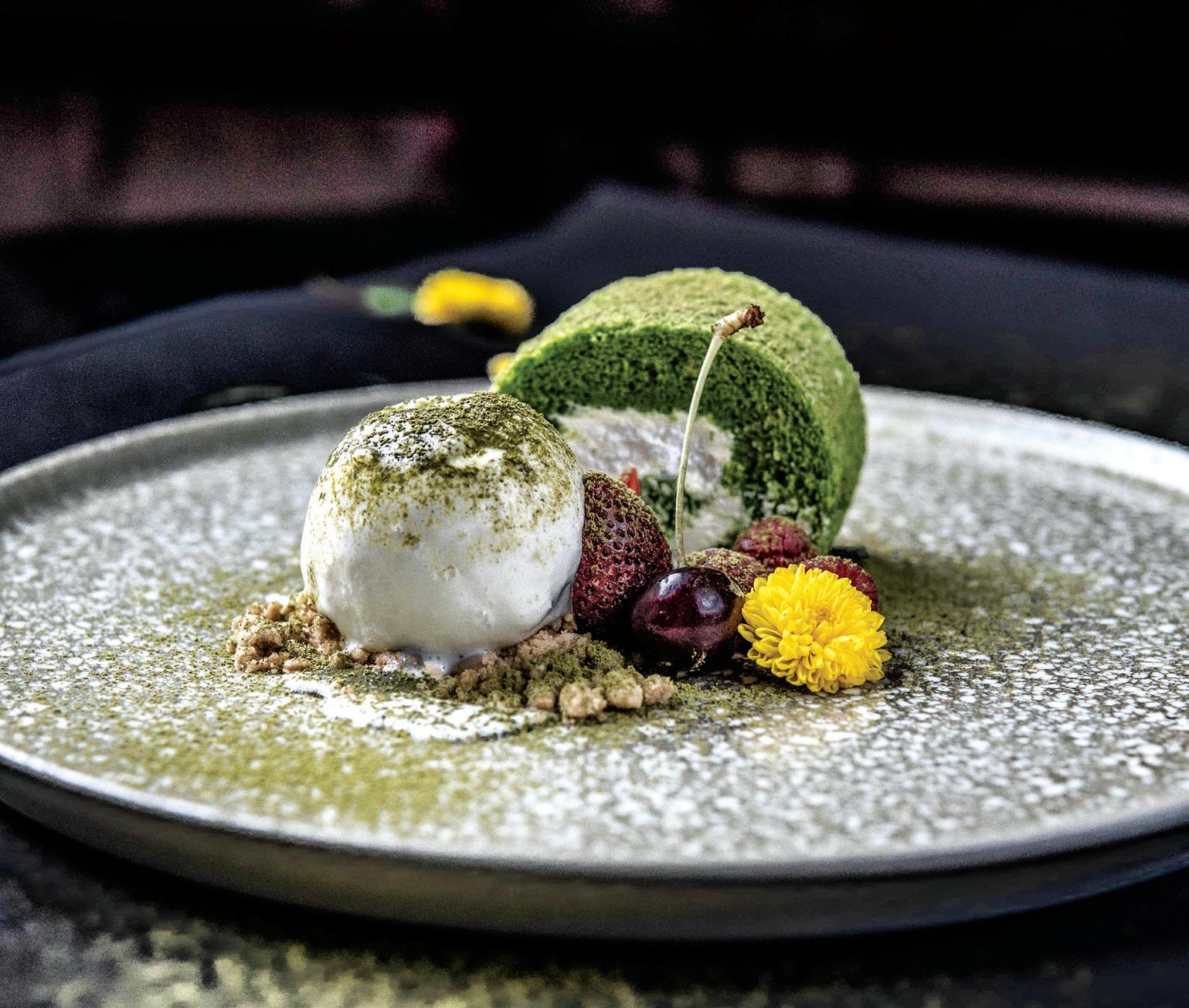
changes in Japan itself. Easily the most popular concept is that of the izakaya, a much more casual informal Japanese bar that is most often compared to an English pub. Comfort, unfussy food, meal bowls, shareable platters, beer… yes, but for geography, the concepts match considerably. In Japanese, izakaya translates to ‘stay-drink-place’ i.e. a place to enjoy a drink, eat a meal, and get comfortable!
One of the latest izakayas to open is Shin’ya at Hyatt Regency, Gurugram, which styles itself as a fresh dining concept set to revolutionise Japanese cuisine in Delhi NCR. It is unmistakably an izakaya but modulated to local preferences. “The restaurant is a place where people can come and unwind,” says Sonale Zagade, General Manager. “The soothing ambience, friendly well-trained staff, and the authentic Japanese gourmet spread heighten the izakaya experience.” Chef Adi

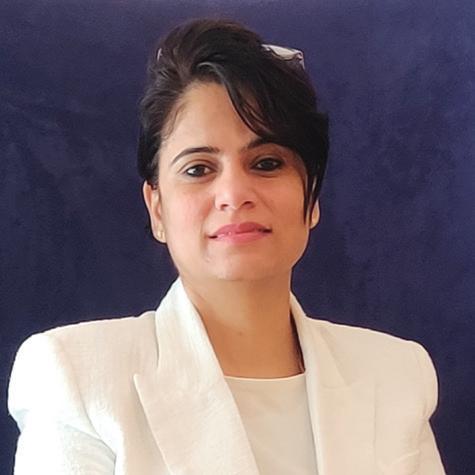
SONALE ZAGADE GENERAL MANAGER, HYATT REGENCY, GURUGRAM
“The soothing ambience, friendly well-trained staff, and the authentic Japanese gourmet spread heighten the izakaya experience.”
Melaz, who helms the outlet, says it is ideal for friends to chill and have some food and drinks after work hours. Indeed, the izakaya is open only from about 6 pm to 10.30 pm after which it converts to a bar. The hotel, which is located in an area where a lot of Japanese expats stay, has an almost captive audience. Despite being inside a premium hotel, it aims to be affordable and has designed its menu accordingly.
Indeed, Delhi, Mumbai and Bengaluru have seen a profusion of izakaya-style restaurants. Chef David Myers opened his Japanese izakaya-style restaurant Adrift Kaya, JW Marriott, Delhi, a couple of years ago, to spread his love of Japanese culture. “I live in Tokyo as well, so I'm immersed in the very best cuisine in Japan, and I eat out almost every night. And that's my inspiration for everything I do here. So, I've experienced all the dishes you see here in some way or the other throughout Japan, and I love them.”
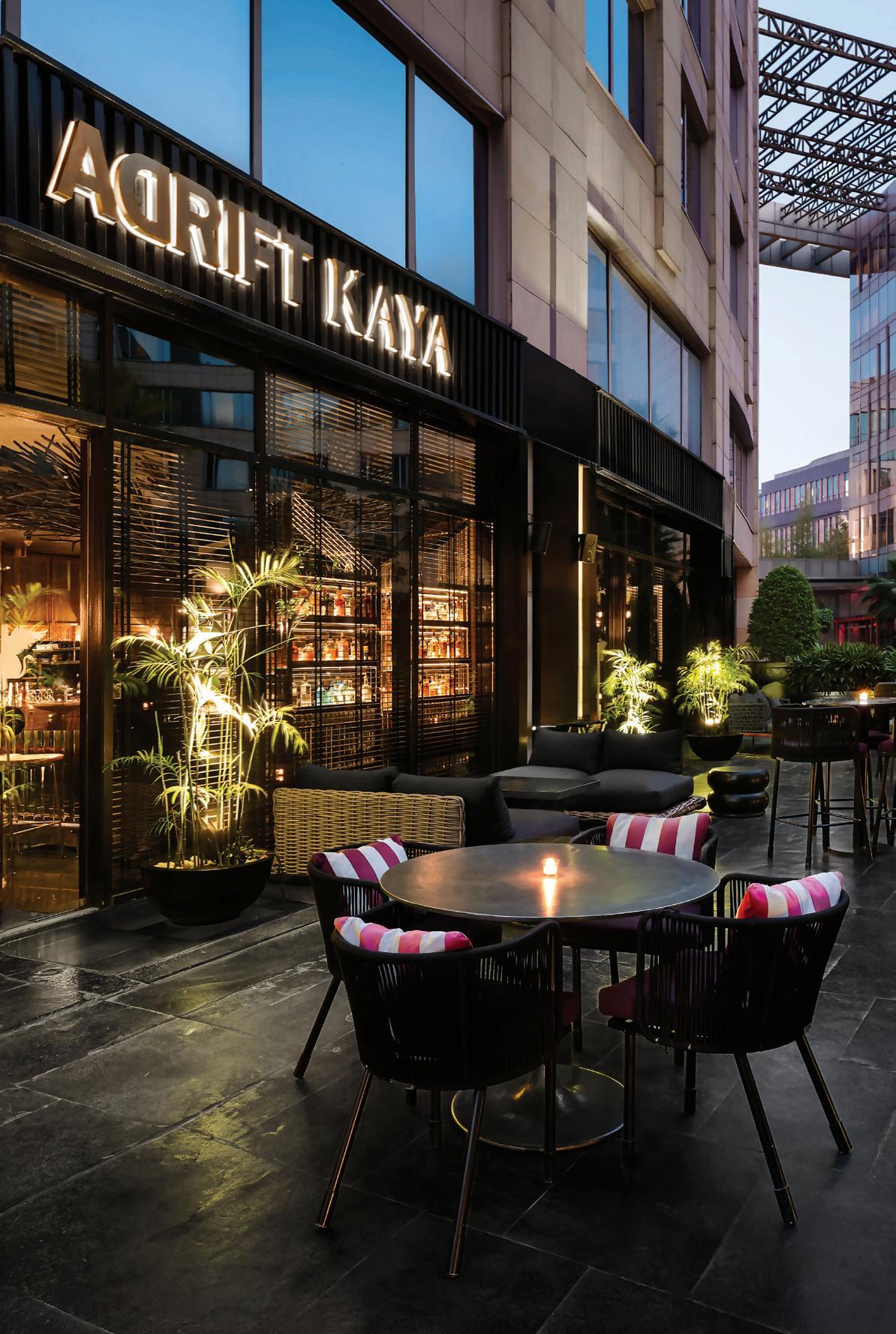
OPPOSITE: Mizu focuses on providing quality at an affordable price;
Myers is conscious that despite being inside a luxury hotel, he wanted to capture the flavour of an izakaya. “People love eating Japanese, and, you know, they appreciate that we're bringing our version of an authentic izakaya to Delhi,” he says. That authenticity also extends to the look and feel, from tatami-style seating to high bars and red lamps. “The need for authentic Japanese cuisine has grown manifold in recent years in India," says Kojiro Honda, Co-Owner & Founder, Kuuraku India. “Most of Kuuraku’s outlet locations cater to areas with significant Japanese presence and aim to offer a more authentic experience, with multiple elements of a typical izakaya woven in."
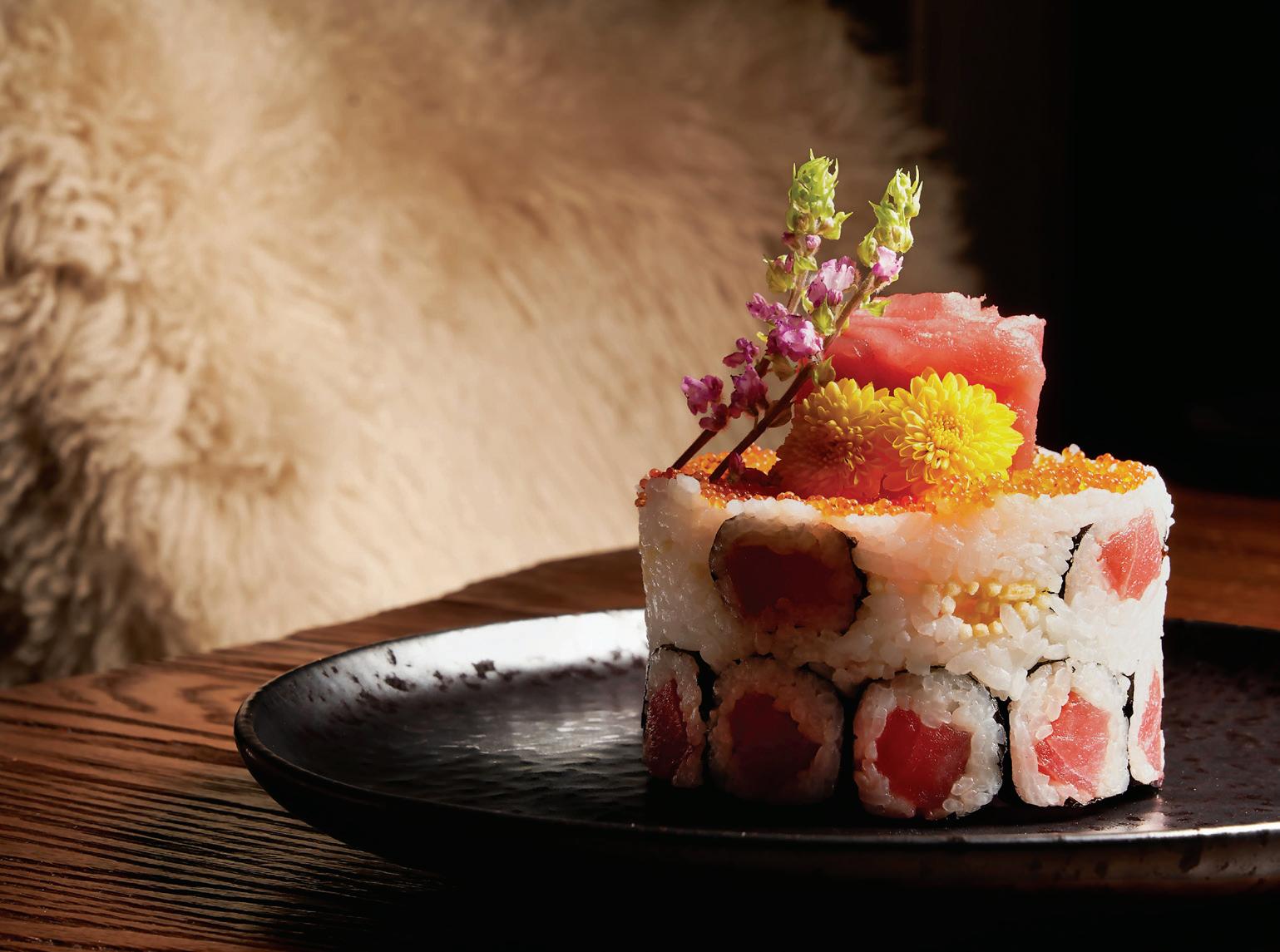

“People just love eating Japanese, and, you know, they appreciate that we're bringing our version of an authentic izakaya to Delhi.”
CHEF DAVID MYERS
ADRIFT KAYA
Perhaps the greatest acceptance and popularity for the concept has come from outlets that have opened outside the luxury environs (though a note of caution here—Japan is one of the richest countries per capita, and just about everything is generally deemed as expensive by outsiders!). The approachability of an izakaya makes it popular; it's an informal space where one comes to unwind after a long day, reiterates Vedant Malik, Director & Founder, Mizu Izakaya, located in Mumbai’s Khar. “Why this model works in India because it simplifies Japanese food, it allows space for tweaking to a particular palate. As an izakaya, we also make sure that prices never intimidate a customer. We want to provide great quality at an approachable price while people can be in their casual attire, enjoying some of the best quality food.”
Malik scotches the idea that the ethos of Japanese cuisine has been only about sushi and sashimi; instead, it focuses on seasonality. “When we speak of classic Japanese cuisine forms, we talk about kaiseki or omakase. The concepts essentially revolve around what is available in season, and what is available around them. The general culture revolves around going to izakayas almost every night, post-work. The menu in most izakayas in Japan features what is available in season. They take those ingredients, grill them on a yakitori grill or put them in a shabu shabu (a hotpot dish). So, that's where the philosophy lies—in being able

Have you had Japanese cheesecake? asked my Delhi-based friend recently while at Harajuku, a modern interpretation of casual Japanese dining, full of cultural and culinary touchpoints. The aforementioned cheesecake, Mochi, Rainbow Cake Slice, Lemon Yuzu tart or indeed the Jiggly Pancake Matcha/ Boba—these are not desserts most Indians unfamiliar with Japan are likely to have come across. Yet, across Japanese restaurants, their popularity is on a rapid rise.
Japanese bakeries and confectionery are getting popular not just in India, but across the world, agrees Lakhan Jethani, Head Chef & Co-founder, Mizu Izakaya. “Some of the popular desserts include the Japanese cheesecake, you know, the light, soufflé, kind of a cheesecake. Also getting famous is the Shokupan bread, essentially Japanese milk bread, as well as ice creams. We love doing Japanese black sesame ice cream or matcha ice cream with azuki bean paste, which is a red bean paste. We serve these ice creams in waffles.”
In Japanese cuisine, traditional sweets are referred to as wagashi and are most often made using ingredients such as red bean paste and mochi. Japan, the land of inventions, has also evolved its desserts to a great extent, often with global influences, leading to ‘neo wagashi’ outlets.
to use what is around you and what is seasonal. It is a more sustainable approach towards food that highlights produce in its eternity. It emphasises season versus trying to create heaps and heaps of flavour by using different ingredients.”
Izakayas, whether in Japan or outside, are no longer sticking to traditional dishes. “Nowadays, when we talk about izakayas, we mean in a modern style, which means both the interiors and the menu,” says Melaz. He explains that often elements of the local flavour palate also seep into the menu, as well as innovative new dishes, along with longstanding favourites such as yakitori, robata grills, etc. “Now I see that in Japan as well, izakayas are becoming fancier.”
Of course, the quality of ingredients is paramount in Japanese cuisine. “We get a great response to our ingredients, which come from Japan,” says Myers. “All of our seafood—our uni that just arrived today, our ramen just came in, I mean, pretty much everything. Some of our fresh vegetables, we have a local farm here in Delhi that grows Japanese ingredients for us, such as some of our microgreens, lettuces, carrots, okra, ... So, that's really cool.”
Malik says there is considerable scope for izakayas in India. “They have a tremendous growth opportunity in India. But they must be done correctly. The aim has to be to create an experience and not just focus on the money the space can generate. You must focus on consistent quality while keeping your prices very tangible. At Mizu, our focus is always on consistency with food and service. We want to provide quality at an affordable price while catering to every palate.”
Add comfort, friends, and some sake—the formula seems guaranteed for success amongst the aspirational Indians. Given the health benefits and alluring flavours on the menu, Indian street corners might well see Harajuku-style modern iterations of izakayas with increasing frequency!
“At Mizu, our focus is always on consistency with food and service. We want to provide quality at an affordable price while catering to every palate.”
CHEF LAKHAN JETHANI AND VEDANT MALIK
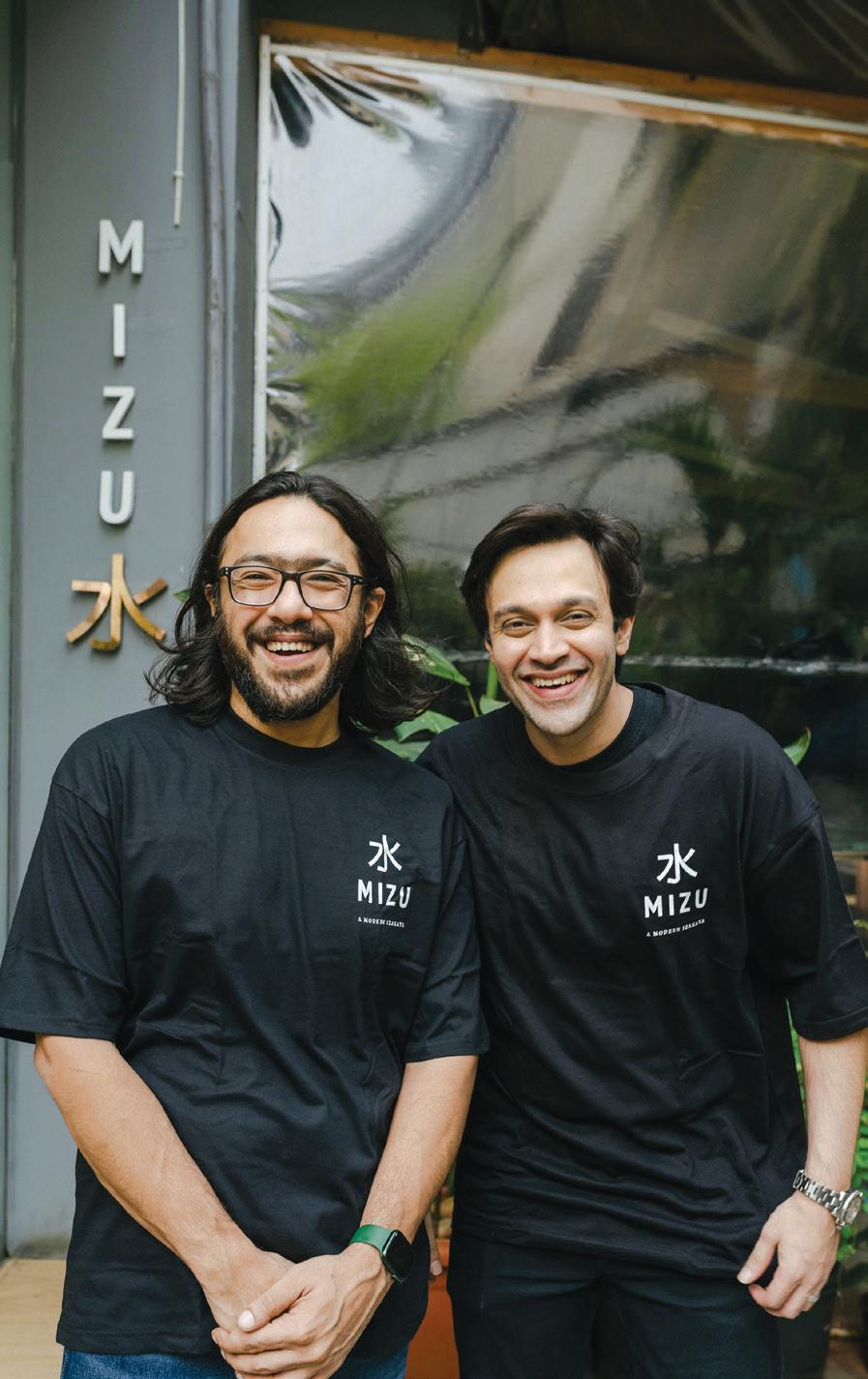

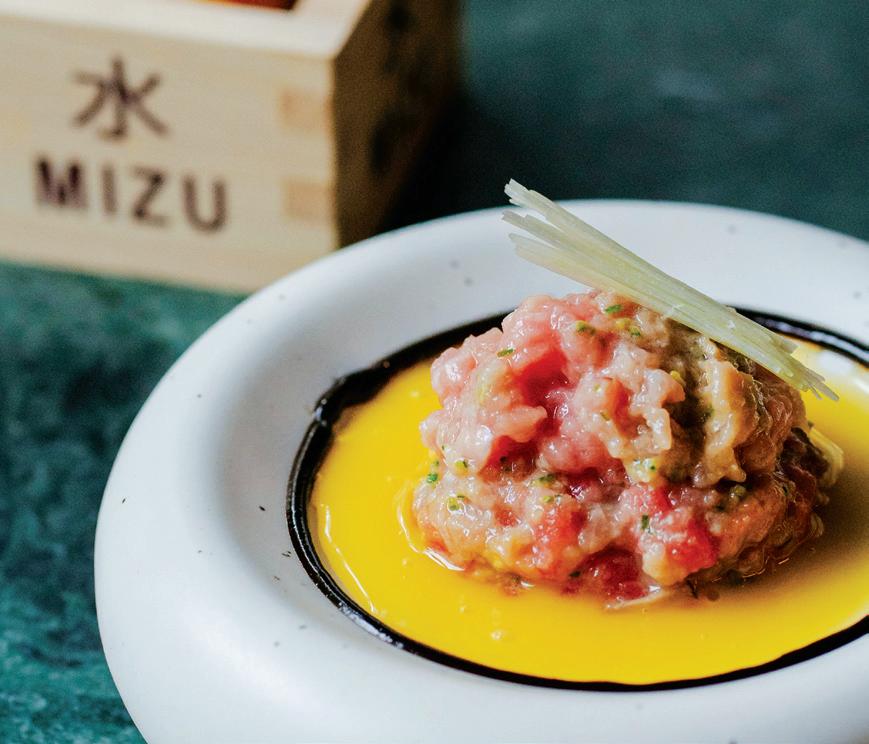

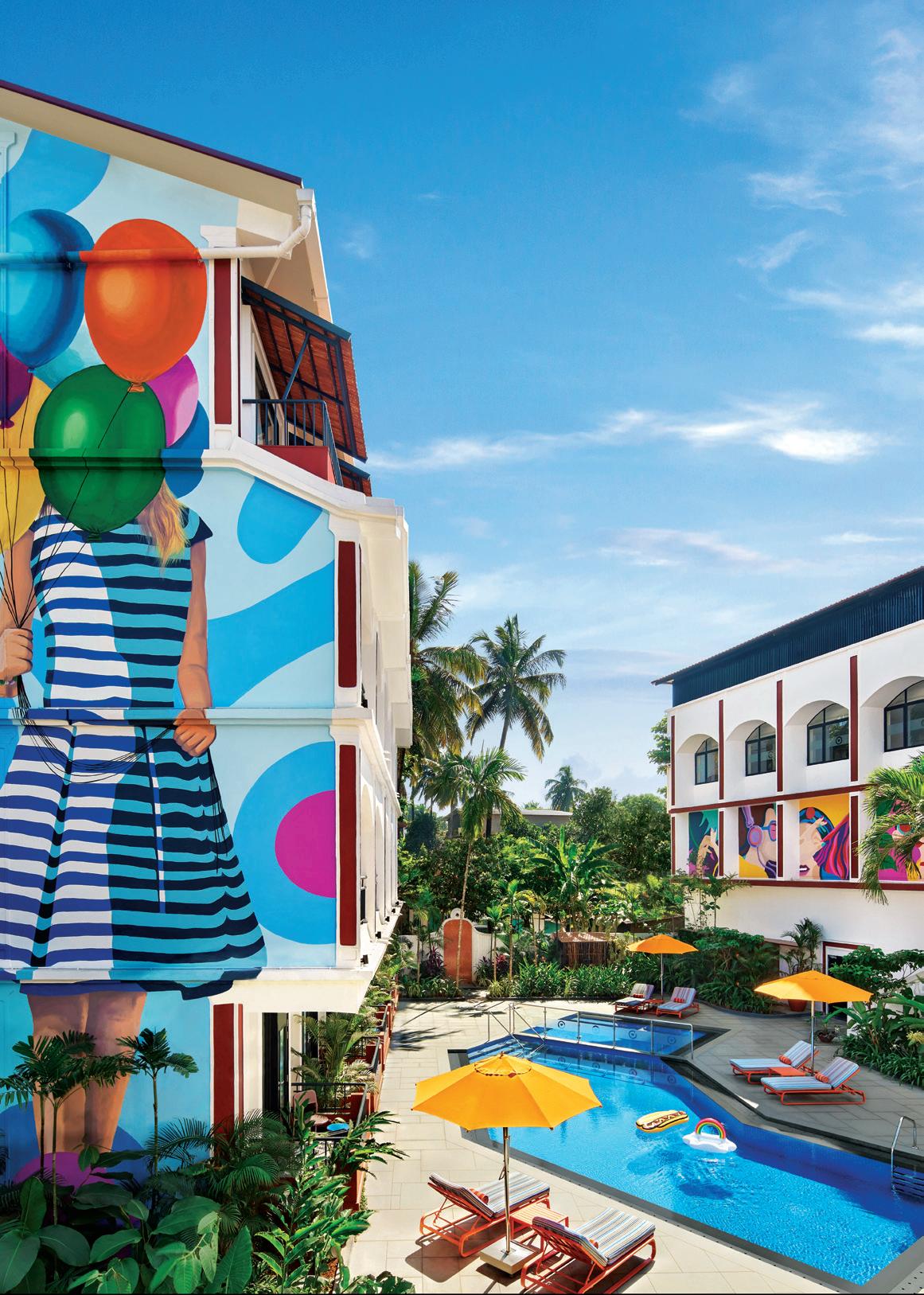

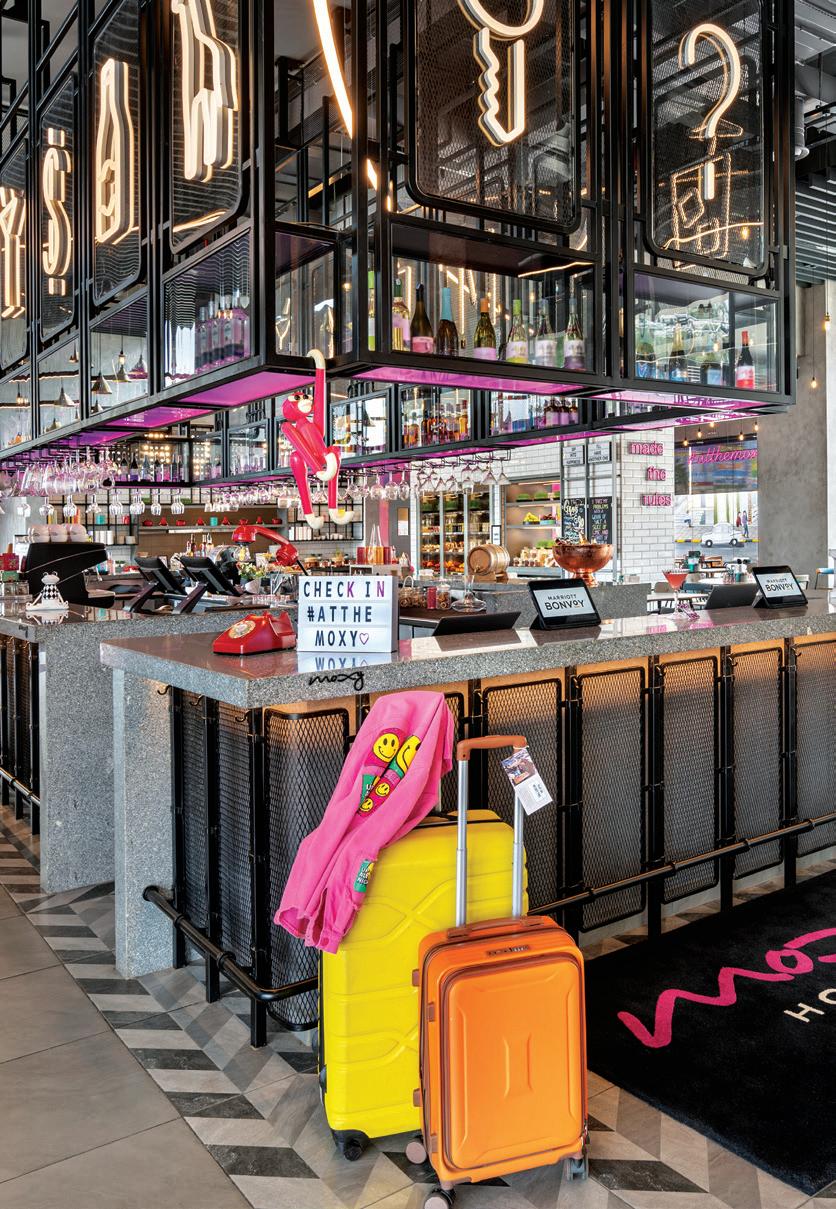
The first fully digital age generation is here, and hospitality is gearing up to cater to their preferences, including launching new brands aimed at this emerging guest.
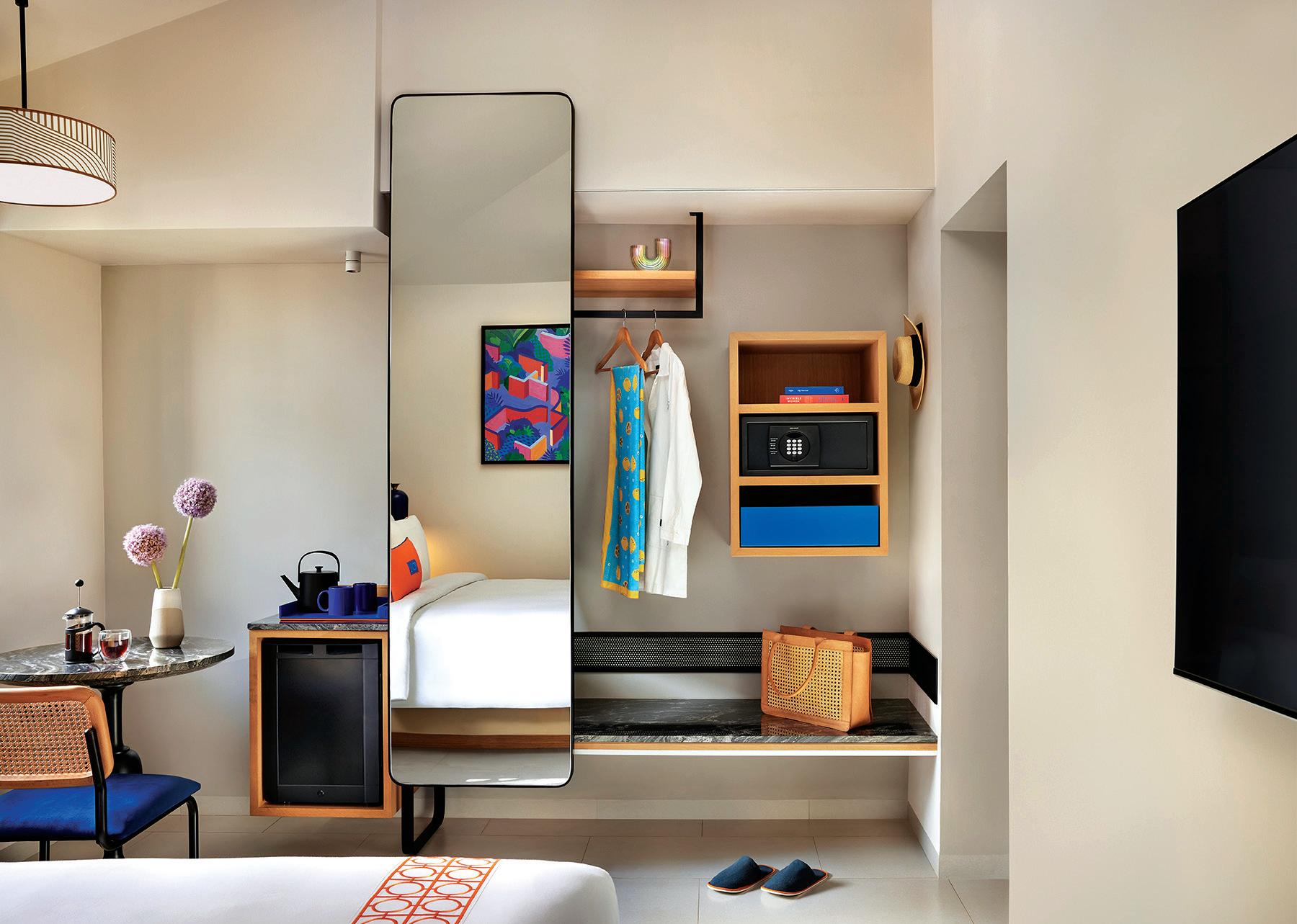
Shot on arrival! Yes, the welcome drink you are greeted with when you enter RONIL Goa —a JdV by Hyatt Hotel, comes in the form of a shot. The hotel’s main bar, Patrao’s, is the first point of engagement, straightaway getting the guest into the Goan vibe— almost akin to a religion for India’s upwardly mobile youth, and a world removed from the traditional, classic, standardised concept of hotels that have dominated modern hospitality since it began.
As the first fully digital generation gets ready to become earning—and paying members of the community, hospitality has been forced to take note of the changed aspirations—nay, demands of a new generation. According to US consulting major, McKinsey, post-millennials (1997-2012) are predicted to make up a third of global spending power by 2035. Meanwhile, millennials (1982-

PRATITI RAJPAL GENERAL MANAGER, JDV BY HYATT
“At Ronil Goa, Part of JdV by Hyatt, we capture the essence of Goa’s vibrant culture and energy, offering a unique experience for guests who are young at heart.”
1996), the preceding generation, roughly accounts for 23% of the world population, and most of the workforce globally today. Even the gap between the millennials and Gen Z seems to have caught the sector unaware, as it scrambles to cater to this new demand.
Gen Z and millennials, soon to reach their peak economic power in the APEC region, will account for the major chunk of the travelling population, according to a travel report commissioned by Marriott International earlier this year, again with huge implications for the sector. John Toomey, Chief Sales and Marketing Officer - APEC (Asia Pacific, excluding China), Marriott International, said that it is important for hotel companies to make sure that they have brands which constantly engage and speak to these emerging segments of the population.
According to the survey, 73% of this population will take at least two trips in the near future and an overwhelming majority of them have more budget to spend than the previous year.
When Accor’s ibis unveiled its New Generation Design at Vikhroli, Mumbai, at the end of 2021, it marked a departure from its established model. Glimpses of the model had been seen at ibis Rajarhat, Kolkata but this one, the 20th ibis in India, is the template for further ibis Hotels in India. As J.B. Singh, President & CEO, InterGlobe Hotels, said during the opening, “We created a new benchmark, not just for ourselves but also for the industry. This is the latest one, aimed at the young emerging Indian traveller.”
In India, approximately twothirds of the population is under age 35. Millennials are around 34%, or about 440 million individuals in absolute terms. Post millennials account for just a shade less. India’s
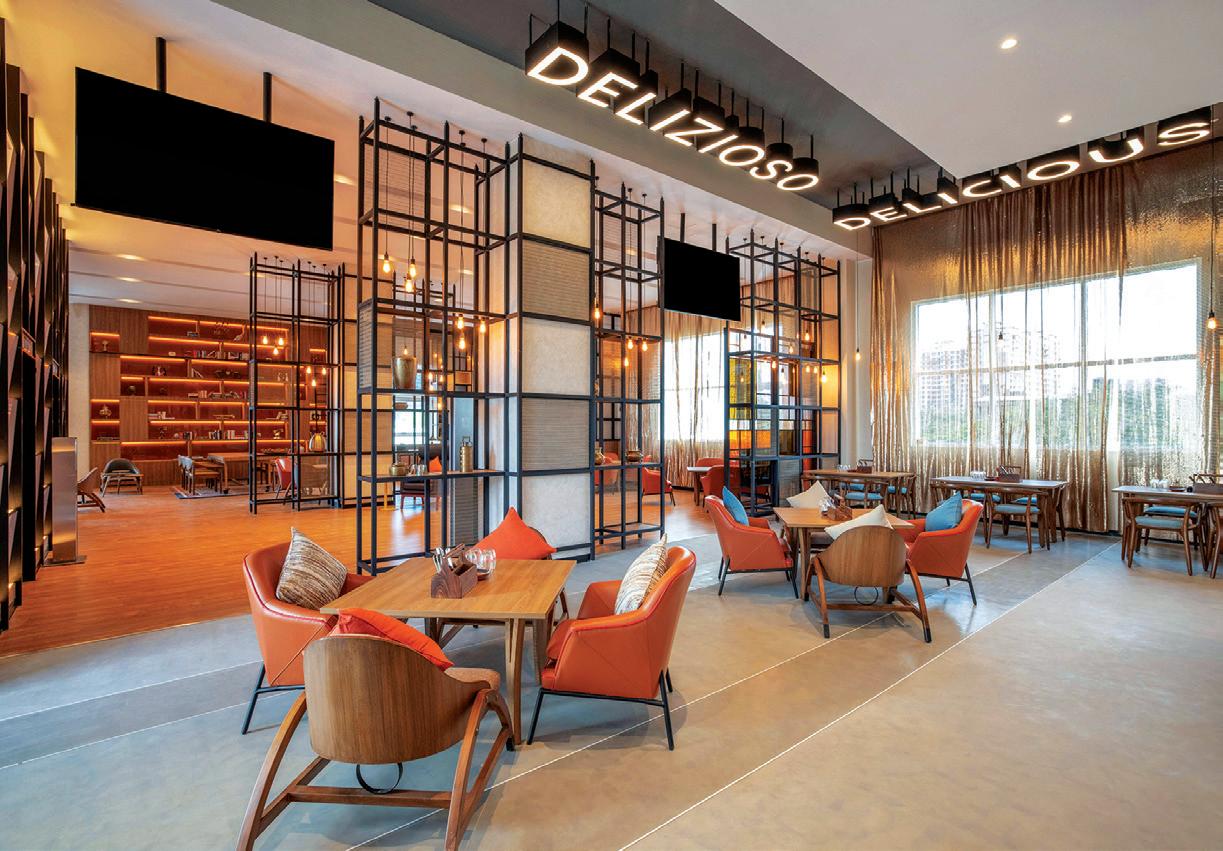
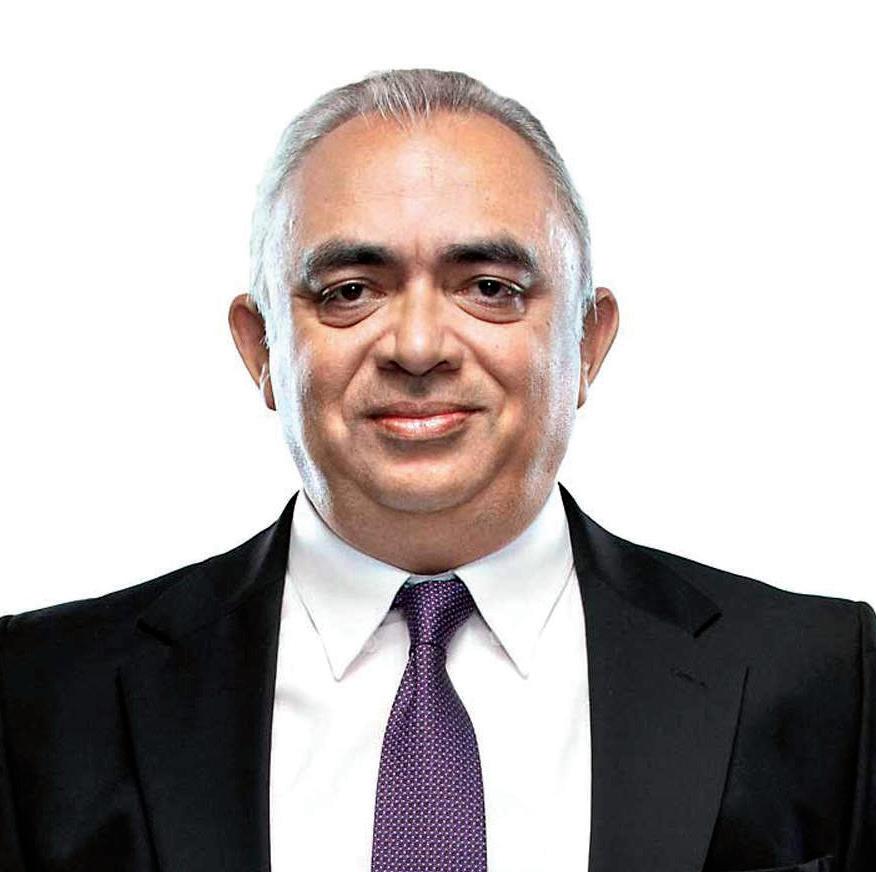
J.B. SINGH PRESIDENT & CEO, INTERGLOBE HOTELS
“We created a new benchmark, not just for ourselves but also for the industry. This is the latest one, aimed at the young emerging Indian traveller.”
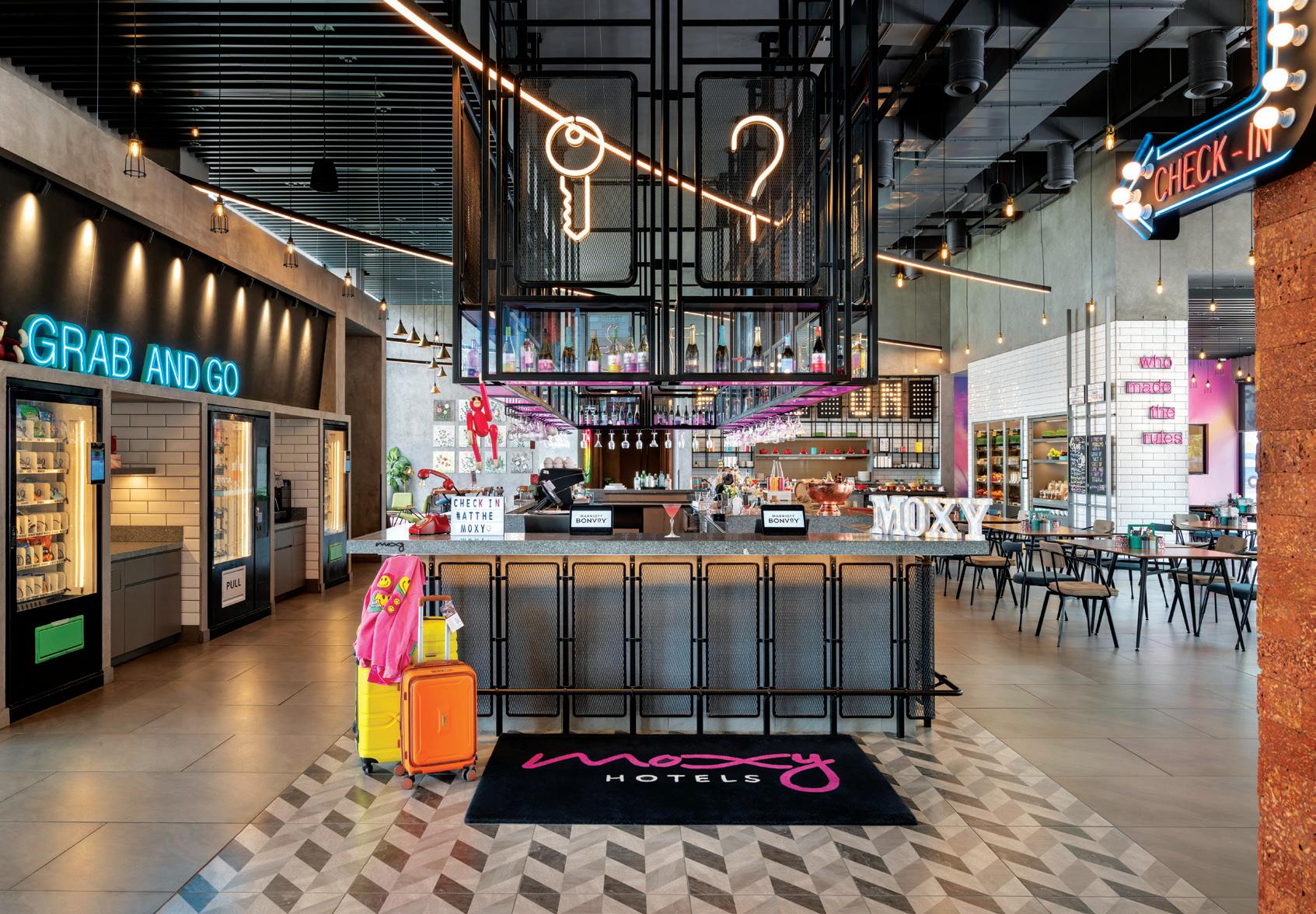
median age is about 28 years. A report on millennials by Noesis, a hotel investment advisory firm, said that due to steady advancement in their professional careers, higher disposable income, and flexible work hours, they have more spending power, clearly bringing out the immense potential for the travel and hospitality industry.
While some experts have noted that the Zoomers may not have considerable spending power at the moment, it is likely to be a very different scenario in the next 10 years. The YouGov Travel & Tourism Report 2022 revealed that 37% of Gen Z travellers consider travel prices to be a hindrance, with the cost of lodging being a major concern.
Nearly all hospitality majors have launched brands specifically designed to cater to this demographic, even if they are often couched in terms of ‘local’,
‘design-led’, and ‘sustainable’. Moxy is a millennial hotel by Marriott, while Hilton has launched Canopy, Tempo and Tru, Accor has launched 25 hrs by Accor, IHG has Indigo and Hyatt has JdV and Caption. Significantly, none of the Indian hospitality brands have yet catered to this category, even as they are all expanding their brand portfolios. Interestingly, almost none of these brands are positioned in the luxury segment, where there already are brands such as W (Marriott) and Andaz (Hyatt).
But it is in the standalone space or new brands that new-age hotels
are making a mark. ‘A hotel that moves as fast as you.’ That’s how Yotel, which claims to offer guests a hotel experience that challenges the status quo, with a promise to deliver a different kind of stay through awesome people, smart design and the creative use of technology, describes itself.
“Our hotels have adapted with the way people travel now— appealing to ‘Generation Go’–digital nomads, who can work remotely but are also culturally curious, and willing to try new types of accommodation. They want to stay in central locations and be in the

JOHN TOOMEY CHIEF SALES AND MARKETING OFFICERAPEC (ASIA PACIFIC, EXCLUDING CHINA), MARRIOTT INTERNATIONAL
“It is important for hotel companies to make sure that they have brands which constantly engage and speak to these emerging segments of the population.”
heart of the action, and so value accommodation offering where they can check in quickly, and then get out and explore,” says a spokesperson.
While there is no Yotel in India yet, it already has staff in the market, which it sees as a crucial one. “India specifically requires its development strategy due to the size of the country and the opportunity. We are looking at opportunities across the region and that strategy includes finding new partners to spark regional growth and expand with them to new cities and countries.”
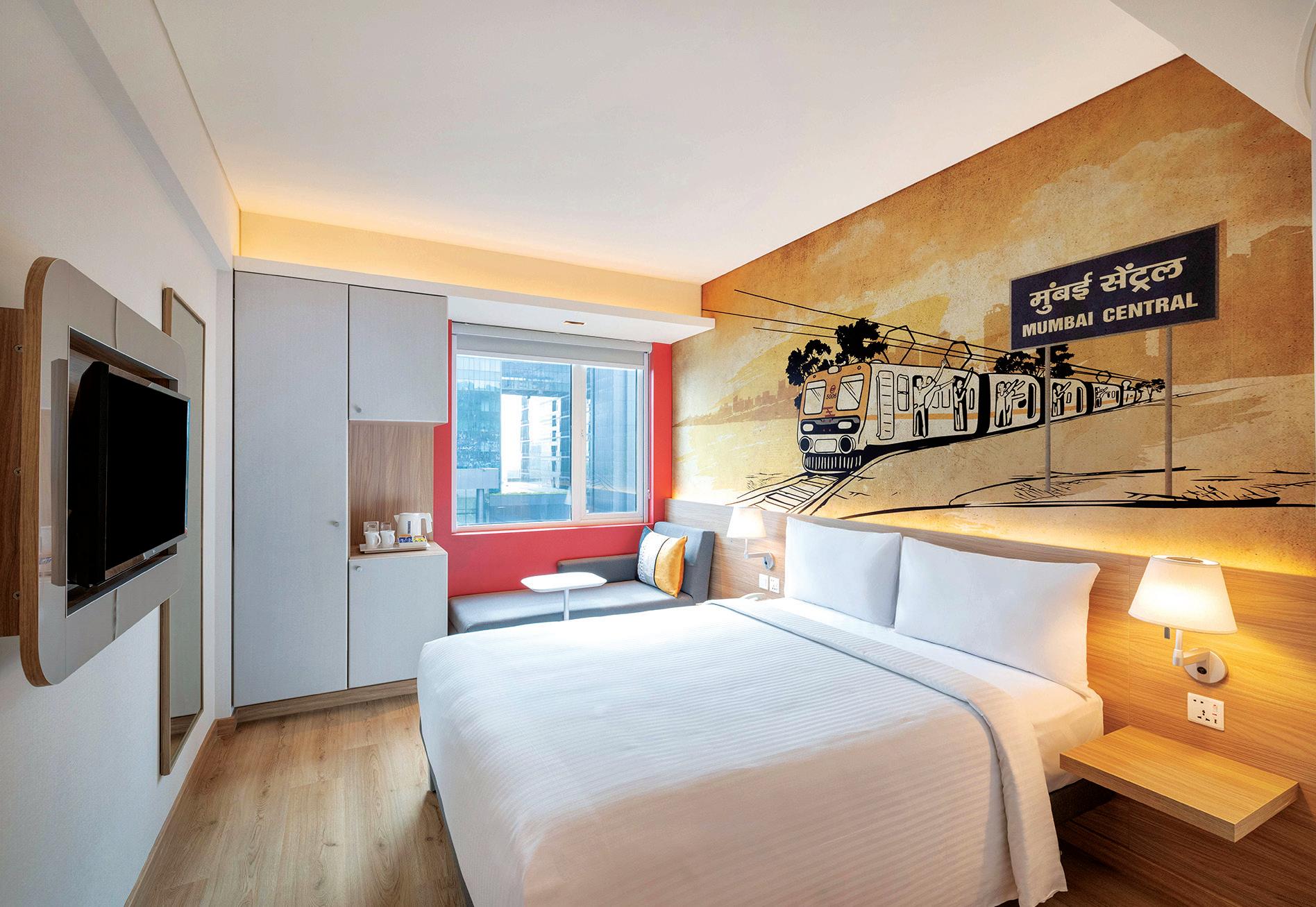
Design is a huge differentiator for hotels aimed at younger guests. Design-led brands, such as JdV, part of Hyatt’s ‘Independent Collection’ of hotels, and Caption are the new brands from the hospitality major with a huge focus on design. The design features art murals by local artists, reflecting the free-spirited and inclusive personality of JdV by Hyatt. Moxy, Marriott’s attempt to catch loyalties young, also embraces bold, contemporary decor infused with whimsy. Colourful

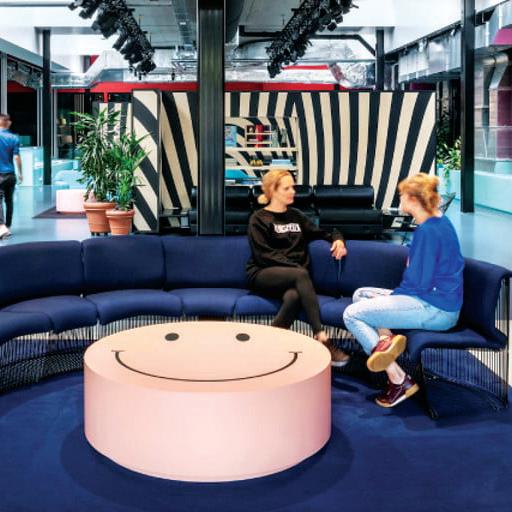
The Social Hub Amsterdam City (formerly The Student Hotel) is a hotel where travellers, locals and students get together to learn, stay, work and play.
Selina, nicknamed the ‘Millennial and Gen Z Hotel’ offer hostels, dormitory-style rooms and CoLiving spaces across the world.


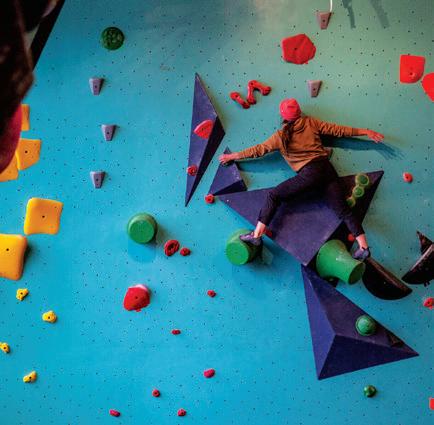
Ion Adventure, Iceland offers attractions of this remote world, plays up its sustainability credentials.
In Japan, Hoshino Resorts recently debuted BEB5 Tsuchiura, a property themed on cycling.
artwork and quirky furnishings create a fun and engaging atmosphere. Moxy’s interiors feature vibrant, edgy decor with an industrial-chic aesthetic, creating a youthful and energetic ambience.
The vibe of ibis Vikhroli represents an urban-influenced design with very accessible technology, style and a social atmosphere to enhance experiences and keep pace with the new-age visitors and guests at the property, says Manoj Agarwal, Head – Asset Management, InterGlobe Hotels.
Five, Dubai is squarely aimed at the party goer, with younger guests making up most of the guests.
Freehand Hotel, Miami, US has rooms that are retro chic, a nod to their 1930s Art Deco roots.
At Curiocity Maboneng, Johannesburg, South Africa, Gen Z can connect with other travellers and locals through a mix of communal lounges and co-working spaces.
“At Ronil Goa, Part of JdV by Hyatt, we capture the essence of Goa’s vibrant culture and energy, offering a unique experience for guests who are young at heart,” says Pratiti Rajpal, General Manager. Even the quickest of glances reveal just how different it is from a regular hotel. JdV has DJ GoaGirl, a resident DJ, who plays music creating an evolving atmosphere from French-inspired morning tunes to high-energy evening beats and, over the course of your stay, will get your musical preferences.
Evo Hotel in Salt Lake City, US is adventurethemed and has a mega climbing wall.
Generator Hostel Washington DC, US is a design-led hostel.
In China, Mini Cooper’s Nomad Hotel offers minimal footprint stay in remote Yunnan.
The Soul Station is a retreat with books, noise-cancellation headphones, customised playlists, and comfortable seating. The merchandise is squarely aimed at the trendy millennial. The bright rooms have no closed closets, while the mini bars are complimentary.
Moxy Hotels cater specifically to younger, millennial, and Gen Z guests, offering an energetic and stylish environment, says Anuradha Venkat, Hotel Captain, Moxy Bengaluru Airport Prestige Tech
Cloud. “Moxy’s lobbies serve as dynamic social hubs, encouraging interaction and socialising. These open-plan areas feature a 24/7 bar, communal tables, and cosy seating, facilitating guest connections.”
According to Toomey, brands such as Moxy have been received well across countries in the APAC region including in India by Gen Z and millennials.
Tech, of course, is crucial for the generation that studies indicate spends more than 10 hours on their gadgets per day, chiefly the smartphone. “Moxy provides highspeed Wi-Fi, multiple power outlets, and smart TVs with streaming capabilities,” points out Venkat. “The streamlined check-in process often includes self-service options, enhancing convenience for techsavvy guests. Mobile check-in, digital keys, and app-based services for convenience are a must. The compact yet stylish rooms are equipped with high-tech amenities like keyless entry, motion-activated LED lights, and flat-screen TVs with streaming capabilities.”
The hotel experience goes well beyond just the food and stay options. Moxy hosts diverse events, from live music performances to art installations and themed parties. These experiences resonate with the interests and lifestyles of millennial and Gen Z travellers, explains Venkat. “Curated guides, local business partnerships, and events showcasing local talent enhance the experience.”
Younger generations prioritise experiences, technology, and sustainability differently than previous generations, says Venkat. “Recognising these shifts allows businesses to tailor their offerings effectively. In a crowded market, differentiated products and services stand out. By understanding emerging customer segments, companies can create unique value
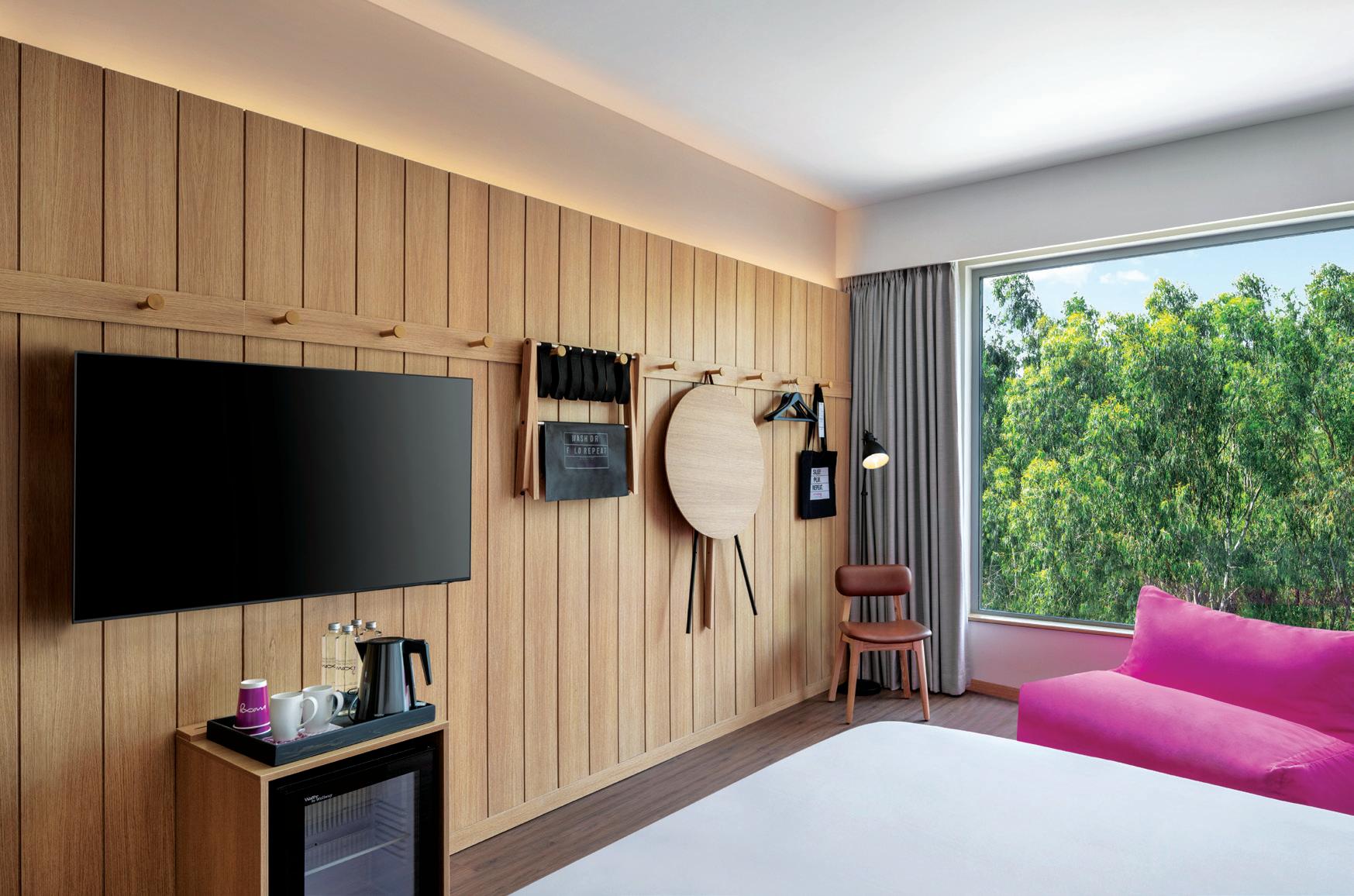

ANURADHA VENKAT GENERAL MANAGER, MOXY HOTELS
“Moxy’s lobbies serve as dynamic social hubs, encouraging interaction and socialising.”
propositions. Instagrammable spaces and unique, shareable experiences are crucial.”
Interestingly, both JdV and Moxy in India seem to employ a staff markedly younger than the average hotel. “We are breaking norms, and it is easier to train younger people who are more open to this new way of interacting with guests,” adds Venkat. Sustainability, at least for Zoomers in the first world, seems to be a priority. According to the Booking.com Destination Z report, this demographic is more likely to
choose eco-friendly and sustainable travel options, with 56% of young travellers indicating they would prefer to stay in green or ecofriendly accommodations, and 60% claiming they are looking for more environmentally friendly means of transportation once they arrive. A report by Skift seems to agree, noting that 54% of Gen Z travellers would pay higher rates to an ecofriendly service provider.
Hospitality majors, through a combination of adaptability and innovation, have placed major bets that future guests, especially those in their teens now, will want these new models.
Generalising Gen Z, most experts agree that the common denominators seem to be a sense of adventure, curiosity, and joy, seeking new experiences and staying engaged with the world.
To what extent Gen Z accepts these new brands remains to be seen, especially where the Indian Zoomer is, in some ways, not homogenous. Chains claim their new brands are doing well even as newer players, including AirBnB, new-age chains such as Yotel, and homestays threaten with their disruptive models.


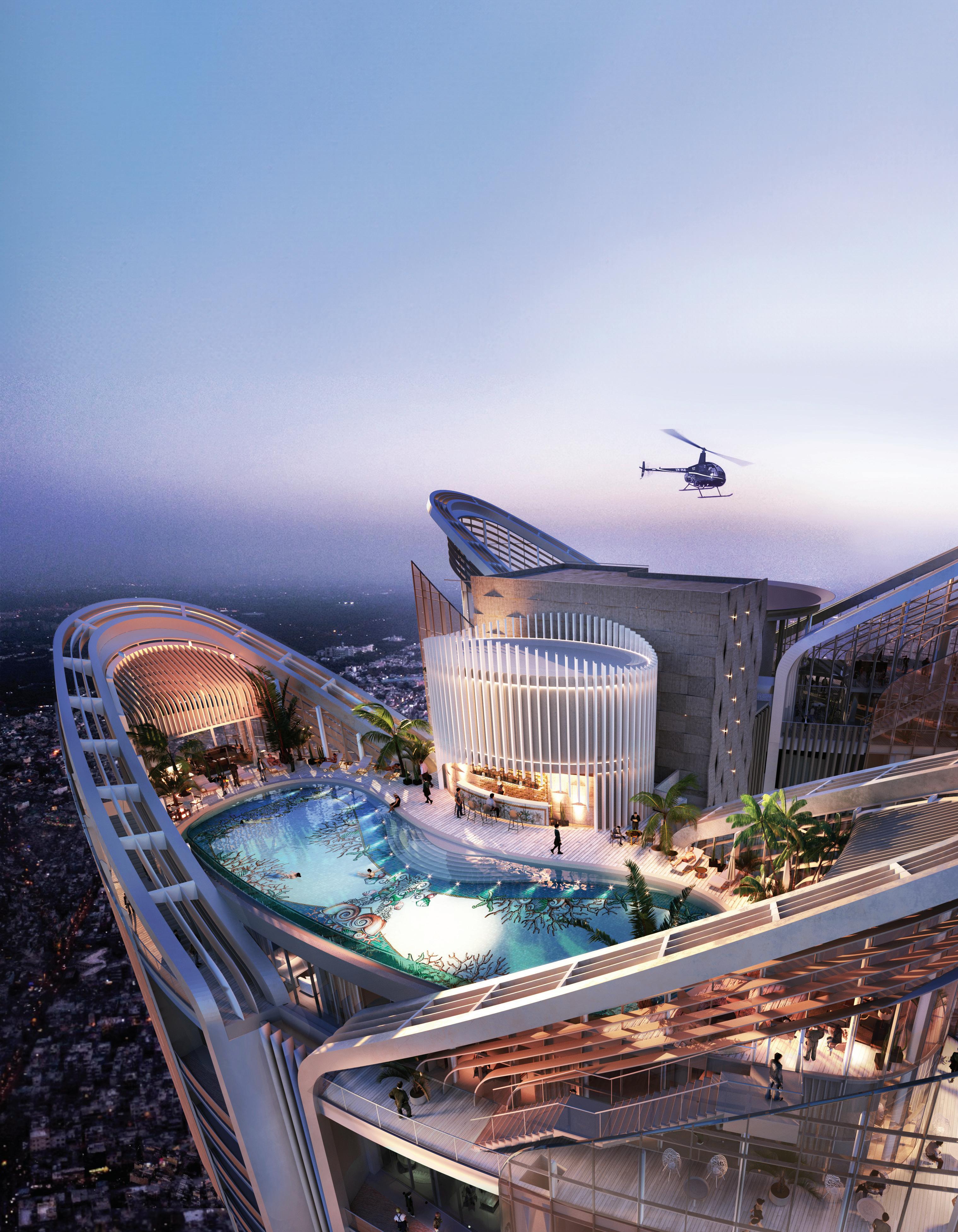


A CAGR growth of 75% for the last five years of individuals with a combined wealth of ₹1,000 crore. A sales record high of 42,731 luxury cars in 2023. Disposable income levels on the rise. Aspiration for finer things in life on the increase. This discerning demographic is eyeing luxury residences, made more covetable by association with a high-end brand, with great interest.
RUPALI SEBASTIAN
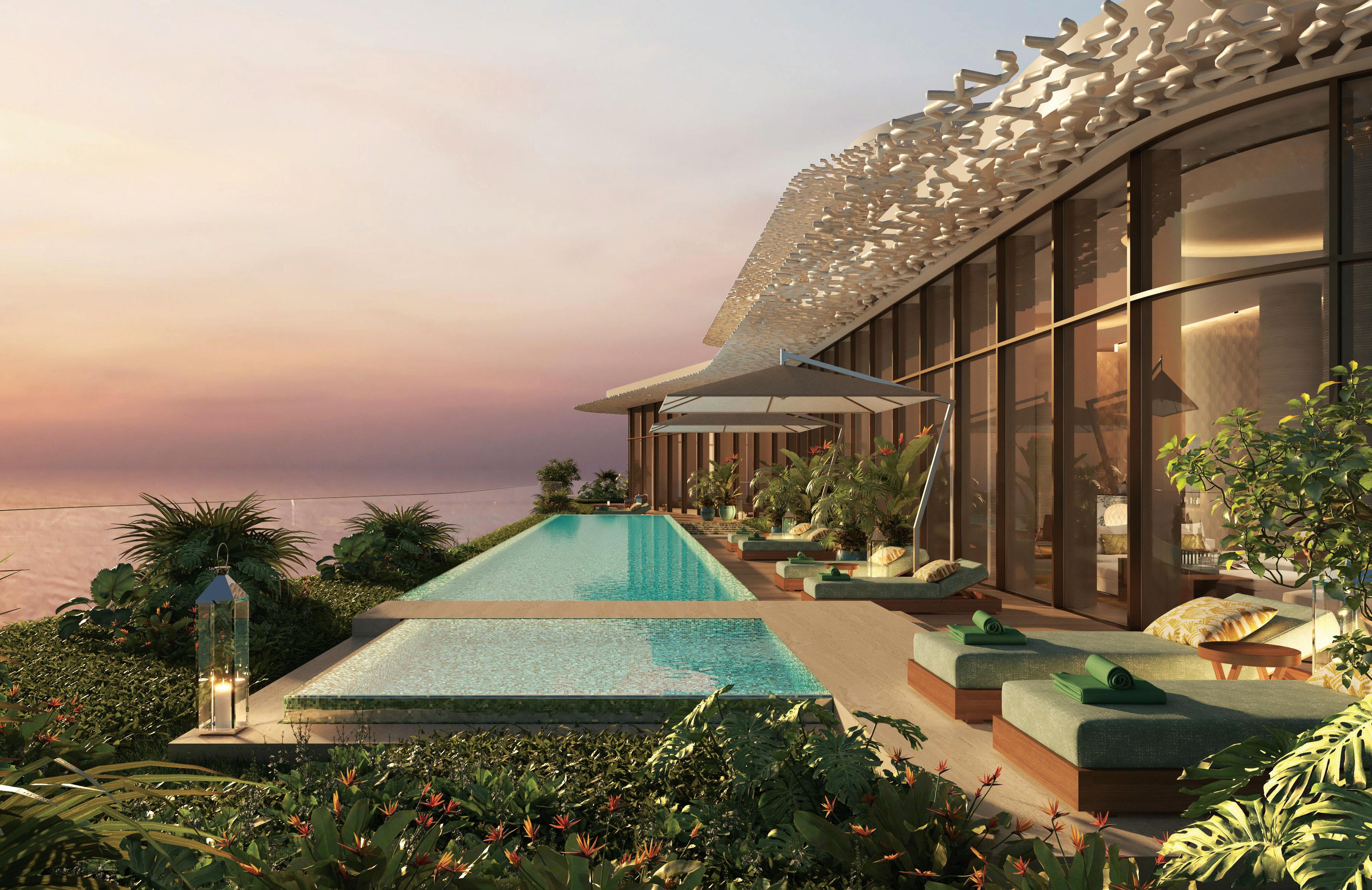
India’s economy is on the rise. Spectacularly. From a GDP of 1856.72 billion USD in 2013, it has burgeoned, in merely 10 years, to 3572 billion USD in 2023 (source: statista.com). This upward trajectory is matched by increase in disposable income and the number of high-net-worthindividuals (HNWIs) and ultra-high-net-worth-individuals (UHNWIs). In their report The Landscape of Branded Residences in India-2024, hotel investment company Noesis points out to India’s rank as the world’s third wealthiest nation, with 271 billionaires. These are discerning buyers, whose views have already been shaped by the traditional outlook of investing in real estate. This approach is now coloured by the aspiration for an opulent, curated and high-quality living experience, tempered with impeccable service and prestige. Branded residences occupy this spot.
Considered at the pinnacle of all luxury residential formats, branded residences are high-end housing projects to which a hospitality chain or other luxury brands lend their 'name'. In case of hospitality brands, the added advantage is that they provide management services, albeit for a fee. Such an association benefits all three stakeholders—that is, the developer, the brand and the buyer. For the developer, it translates to sales price premiums and higher sales velocity; for the brand it means opening up of new income streams and diversification of their offerings; and the buyer stands to reap financial rewards from rental returns, capital appreciation, quality assurance and a more refined lifestyle.
The true desirability of a branded residence lies in the amenities and services offered by this format. This depends on the location and type of
development—whether hotel-led, mixed-use or standalone. Services will include those incorporated into the annual charges, and some which can be availed on-demand. Clubhouse access, security, valet parking and loyalty programmes (in case of hotel-branded residences) can be grouped under the former, while spa, personal trainer sessions and in-room dining fall in the latter.
Historically, the branded residences market has been dominated by hotel brands, which are in a unique position to offer world-class services as well as lend their brand equity for a heightened perception of the development. But residences can and, in fact increasingly are, collaborating with luxury consumer brands from the fashion, automotive and restaurant sectors, as well

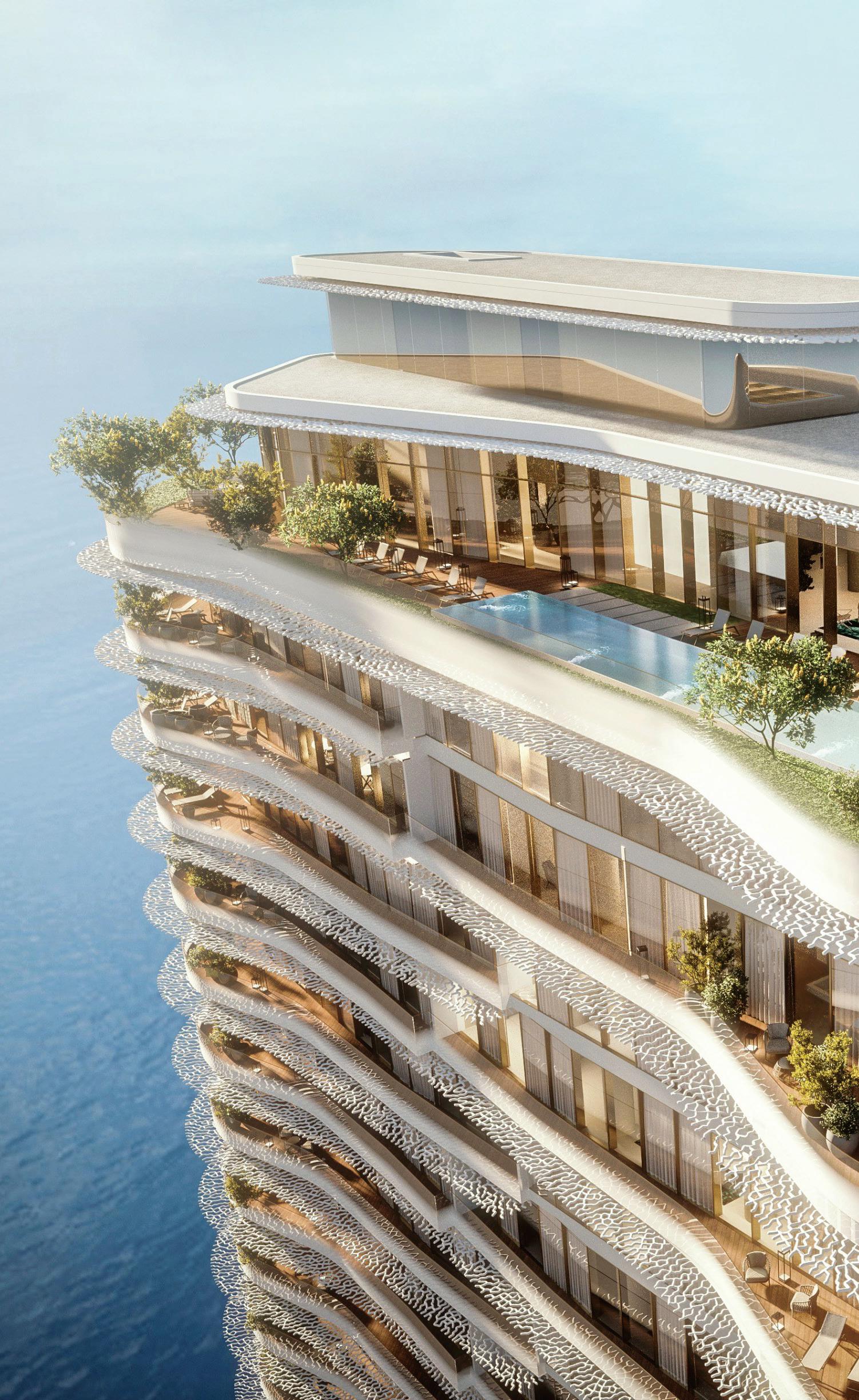
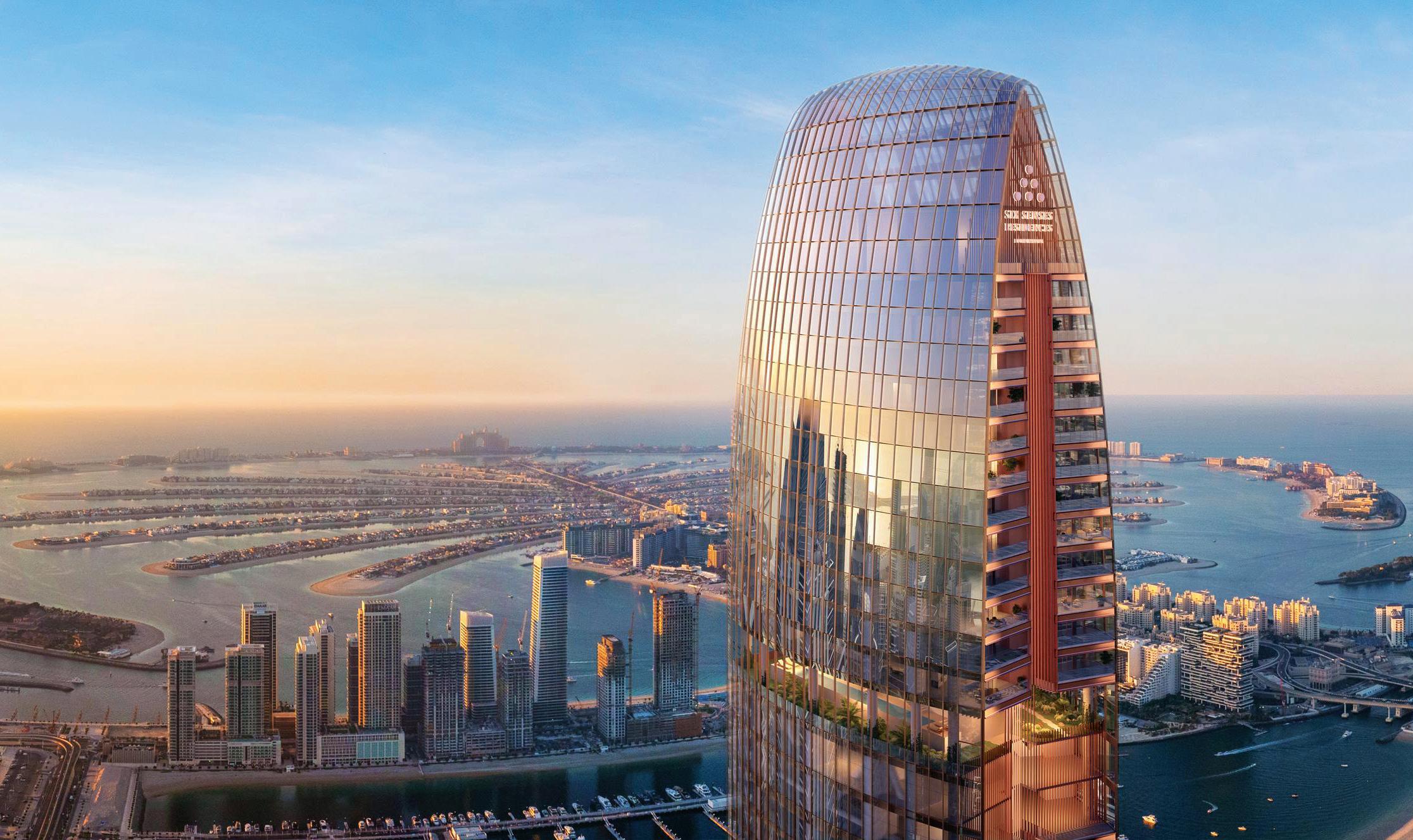
FAR LEFT AND LEFT: Bulgari Lighthouse Dubai reflect's the brand's unrivalled craftsmanship, thoughtful precision, and timeless elegance.
TOP: The Six Senses Residences Dubai Marina will reach a height of 517 mtrs. The offerings include apartments and 'sky mansions' spread over three levels.
BOTTOM: St. Regis Residences, Sunny Isles Beach, Miami, comprise two to five-bedroom condos with no hotel component on-property.

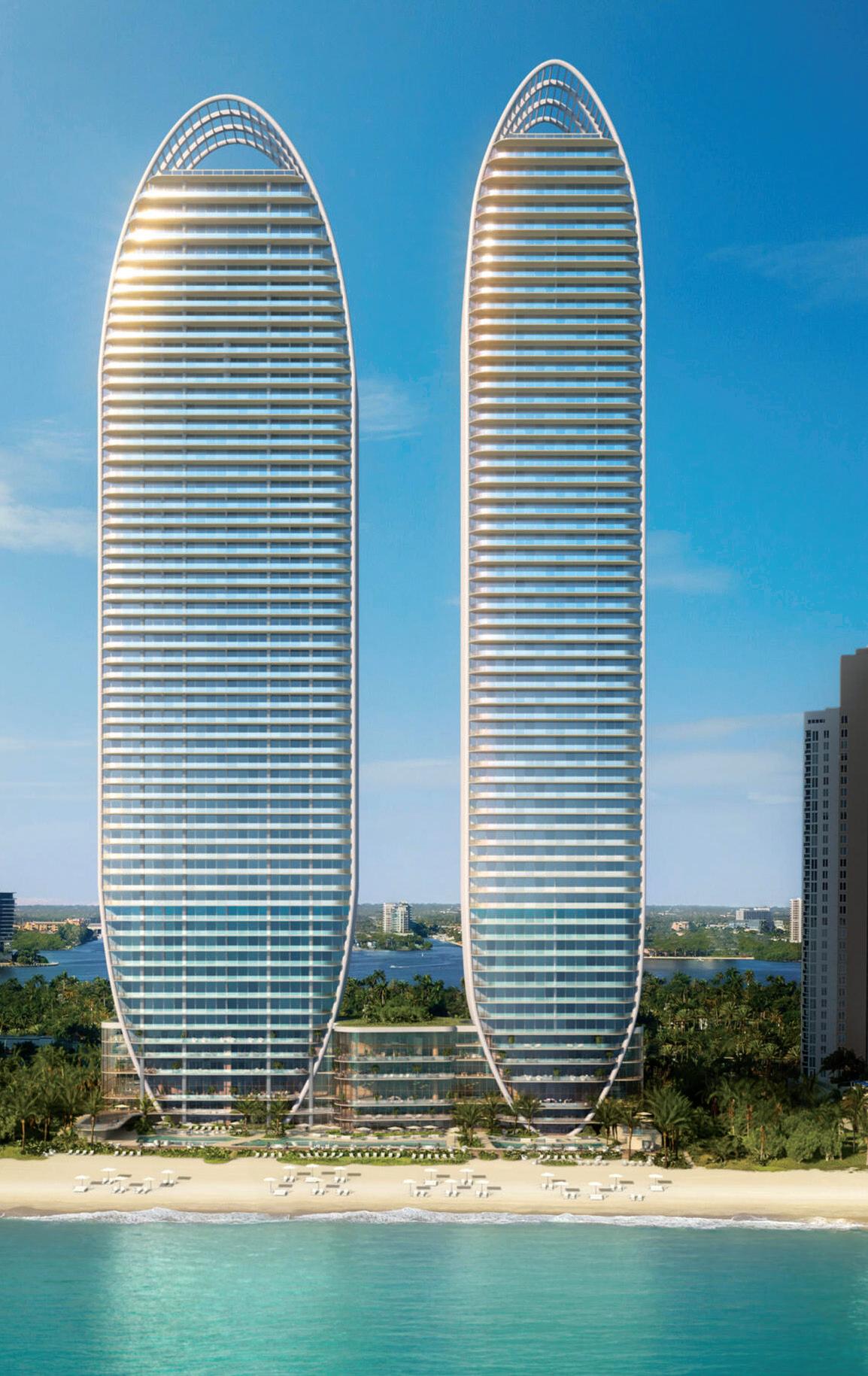
as celebrity architects/interior designers. This, in turn, is fuelling the trend towards standalone branded residences—in other words, residences without a hotel located within the same building or nearby.
In one of the biggest movements in the Indian sector of branded residences, realty firm Whiteland Corporation signed an agreement with Marriott International to bring 'Westin Residences' to Gurugram in early July this year. The development is slated to be India’s largest branded residential project and the first standalone one sans a hotel onsite from the Westin brand. On the occasion of signing the agreement with Marriott International, Pankaj Pal, Managing Director, Whiteland Corporation, said that the development would “redefine premium home ownership with exceptional service and attention to detail, offering a prestigious address that will bring pride and joy to its residents.”
July, again, saw Samarth Bajajfounded Boheim, a global Indian luxury living brand, announcing its debut in the luxury real estate
sphere in India with high-end villas designed by, for starters, interior designer Gauri Khan, and fashion designers Abu Jani & Sandeep Khosla and Kunal Rawal. Unlike a designer space offered as a premium, albeit readymade, product, these ultra-luxurious bespoke homes will be tailor-made for the owner to the last detail. While the initial roll-out will cover Goa, Hyderabad (Bajaj’s hometown) and Alibaug, international markets like Dubai, Africa, Sri Lanka and Thailand are already on Boheim’s radar. “Why did I enlist fashion designers to curate our interior spaces?” rhetorises Bajaj. “The answer lies in their unparalleled mastery of design and luxury. Freed from the constraints of conventional space design education, fashion designers naturally think beyond traditional boundaries, a quality that enhances their exceptional talent in creating bespoke homes for Boheim patrons.”
Does service enjoy an edge or a ‘designer’ space? Harsh Bansal, co-founder, Unity Group, throws light on what prompted them
OPPOSITE: The size of the residential units at Taj Sky View Hotel and Residences, Chennai, ranges from 2,500 sq.ft. to 5,900 sq.ft. Being developed by AMPA Group, the project has created quite a buzz in the Chennai market.
to approach a consumer luxury brand—Versace, in this case—instead of a hotel brand for the branded residences that are part of their The Amaryllis development in Karol Bagh, New Delhi. “A designer brand like Versace or Armani comes with their independent, full-fledged design team and product offerings. Therefore, they not only support you in interior design but also procuring designer products,” he states, adding, “I'm not quite convinced about the value the service angle (of a hotel-branded residence) brings to the individual home, in a country where house help is readily and cheaply available, and will do things your way.”
On the other hand, Mumbai luxury real estate developer Hubtown is actively looking for a hotel as a brand partner for an “enhanced product differentiation” because “high-end marble will only take you so far,” says managing director Vyomesh Shah. “I can speak only for Mumbai, but service is critical in this market. The level of service even in 100-200 crore apartments is still unorganised. And there is a certain expectation people have of service standardisation.”
However, whether a hotelbranded residence is consumed better than its non-hotel counterpart, “is wholly market dependent,” says Anuj Puri, Chairman, Anarock. “In fact, both types are being offered across cities depending on the demand. For instance, in Mumbai we saw developers collaborate with both consumer luxury brands
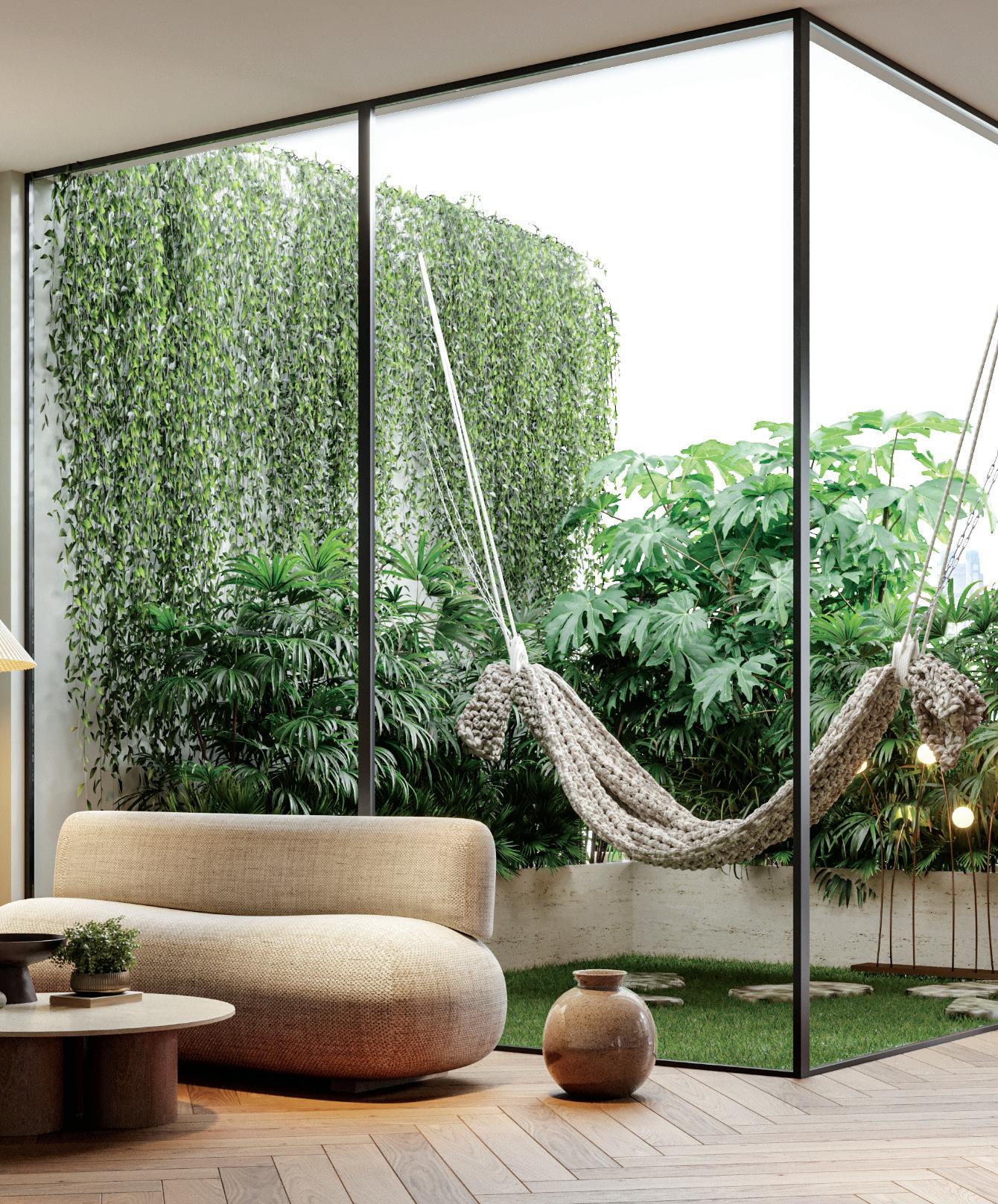
Considered at the pinnacle of all luxury residential formats, branded residences are high-end housing projects to a which hospitality chain or other luxury brands lend their 'name'.
like Armani and hotel chains. In Chennai and Bengaluru, we have seen builders collaborate with hospitality brands (to create) Taj Sky View Hotel & Residences and Leela Residences, respectively.”
An architect's perspective
Architect Bobby Mukherji, who is actively engaged in the luxury residential real estate market as well as several branded residential projects, both in the hotel and luxury brand verticals, enjoys a unique insight into this space from this vantage. “The luxury residential market in India has exploded. Real estate developers have upped the ante in terms of amenities and quality. The benchmarks are incredibly high. Clubs, gyms, salons, valet parking… you name it, a high-end residential complex will have all these and more. This trend is not restricted to metro cities alone. We’re seeing it across India, wherever we’re involved in luxury developments—in Ahmedabad, Surat, Indore, Jaipur, Ludhiana… The Indian home-buyer has never been so aspirational. They have the money, and they have the ambition. In this scenario, the entry of hotels as brand partners has only made the segment more aspirational for the well-travelled, well-heeled Indian consumer. The brand association extends further assurance and commitment vis-a-vis service quality. Customers come to expect a level of professionalism in this regard. ”
Mukherji also has an interesting observation to make about the behavioural trait that differentiates the Indian consumer from his western


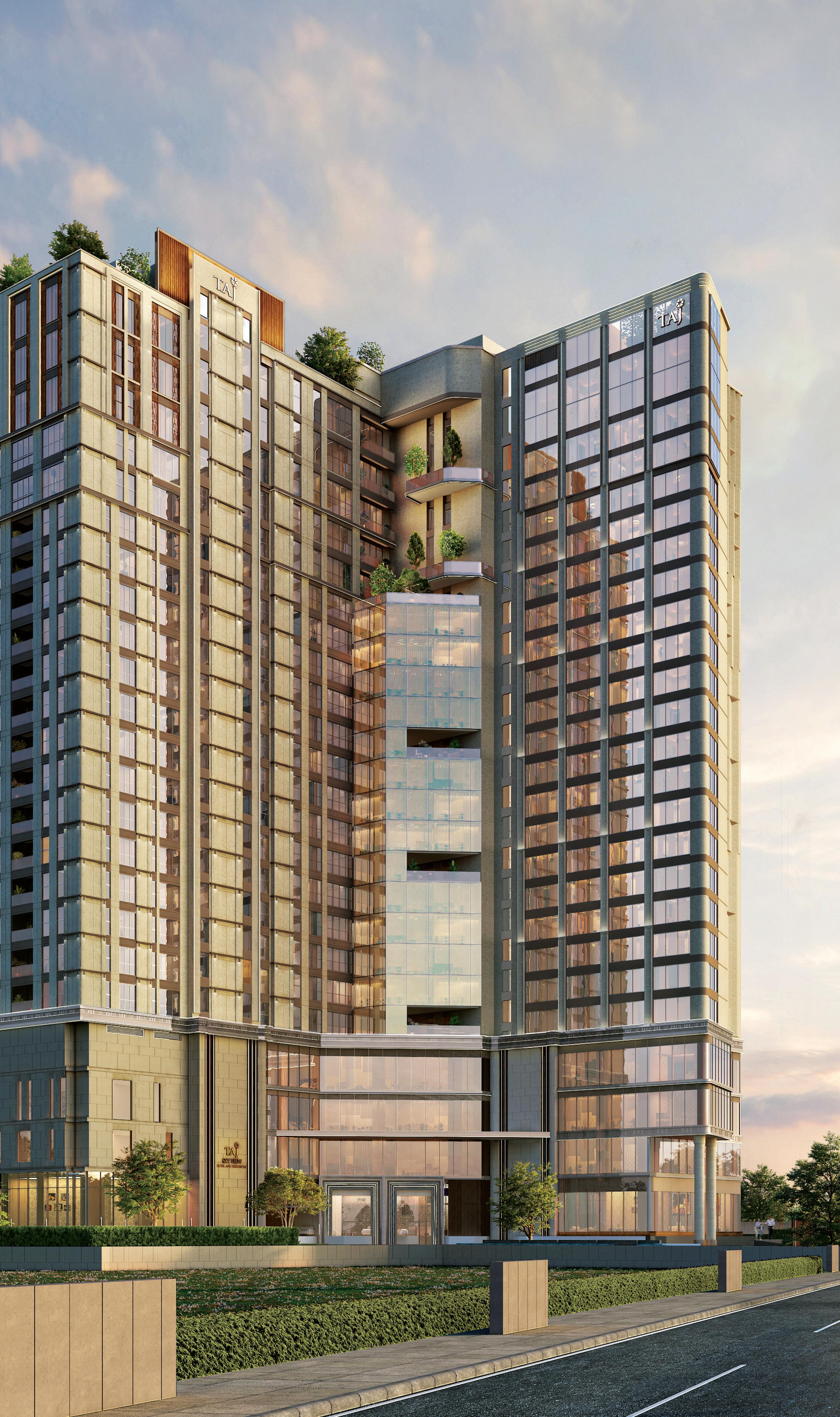
THE SECTOR CONTINUES TO GROW THROUGH SCHEMES AS WELL AS EMERGING LOCATIONS. INTERNATIONAL BRANDS SUCH AS MARRIOTT AND FOUR SEASONS HAVE ALREADY MADE A MARK ON THE INDIAN LANDSCAPE OF BRANDED RESIDENCES. NOW, INDIAN BRANDS HAVE ENTERED THE FRAY
BENGALURU-BASED DEVELOPER PRESTIGE GROUP HAS COLLABORATED WITH 7-STAR HOTEL THE LEELAVENTURE TO BUILD PRESTIGE LEELA RESIDENCES.
THE OBEROI GROUP AND BI GROUP HAVE JOINED HANDS FOR TWO DEVELOPMENTS: TRIDENT RESIDENCES, NEW DELHI AND OBEROI RESIDENCES AT NANDI HILLS, BENGALURU
IHCL RECENTLY ANNOUNCED THEIR TIE-UP WITH AMPA GROUP FOR A NEW HOTEL TAJ SKY VIEW THAT WILL ALSO INCLUDE LUXURY RESIDENCES IN CHENNAI.
ITC HAS MADE ITS INTERNATIONAL DEBUT WITH ITC RATNADIPA, COLOMBO. OF ITS GLITTERING TWO MODERN TOWERS, THE LARGER ONE INCLUDES 123 SAPPHIRE RESIDENCES, HIGH-END HOMES DESIGNED BY YOO INSPIRED BY STARCK
Lamborghini
Aston Martin
Buggatti
Porsche
Mr C
Hard Rock
Casa Tua
Major Food Group
Nobu
Ellie Saab
Armani
Versace
Fashion TV
Roberto Cavalli
Fendi
Baccarat
Bvlgari
Missoni
Ferre
Trump Candy & Candy Related
Berkeley Group
Emaar and Aldar
Source: JLL Hotels & Hospitality Group - Data as of Q1 2024 & The Landscape of Branded Residences in India-2024 by Noesis
counterpart when it comes to such high-value real estate purchases.
“Internationally, a branded residence means everything comes readymade to you: the service, the public spaces and the interiors of your home. But when it comes to India, things are appreciably different when it comes to the last point. The customer will have spent multiple crores on buying a home, and wants things his way when it comes to how it is going to be designed. So the interiors end up being designed by the professional of his choice, obviously at his cost.”
Mariott International
Four Seasons
Accor
Minor Hotels
Hyaat Hotels Corporation
IHG
Hilton Worldwide Aman Resorts
Mandarin Oriental
Hotel Group
Capella Hotel Group
Yoo
Pinafarina
LightArt
Greg Norman
Phillipe Starck
Kelly Hoppen
1508
Yabu
HBA
Tristan Aeur
What determines the success of a branded development for an investor?
Several factors, actually. JLL, in its report The Rise of Branded Residences in Asia Pacific, advises developers/investors to decide whether they would be selling furnished or unfurnished units, and kind of services that would be offered to the buyers. Developers must also take into account the various license costs and fees. These include the residential marketing license fee, which allows developers to use the brand’s name and trademarks in marketing materials. The brand commitment fee ensures ongoing support and brand maintenance throughout the project’s lifecycle. The technical service fee covers design and pre-opening support provided by the brand during the development stage of the property. Additionally, the report points out, there may be homeowners association management fees for maintaining shared spaces and amenities.
The sales price premium advantage
Ampa Palaniappan, Managing Director, AMPA Group, who recently inked
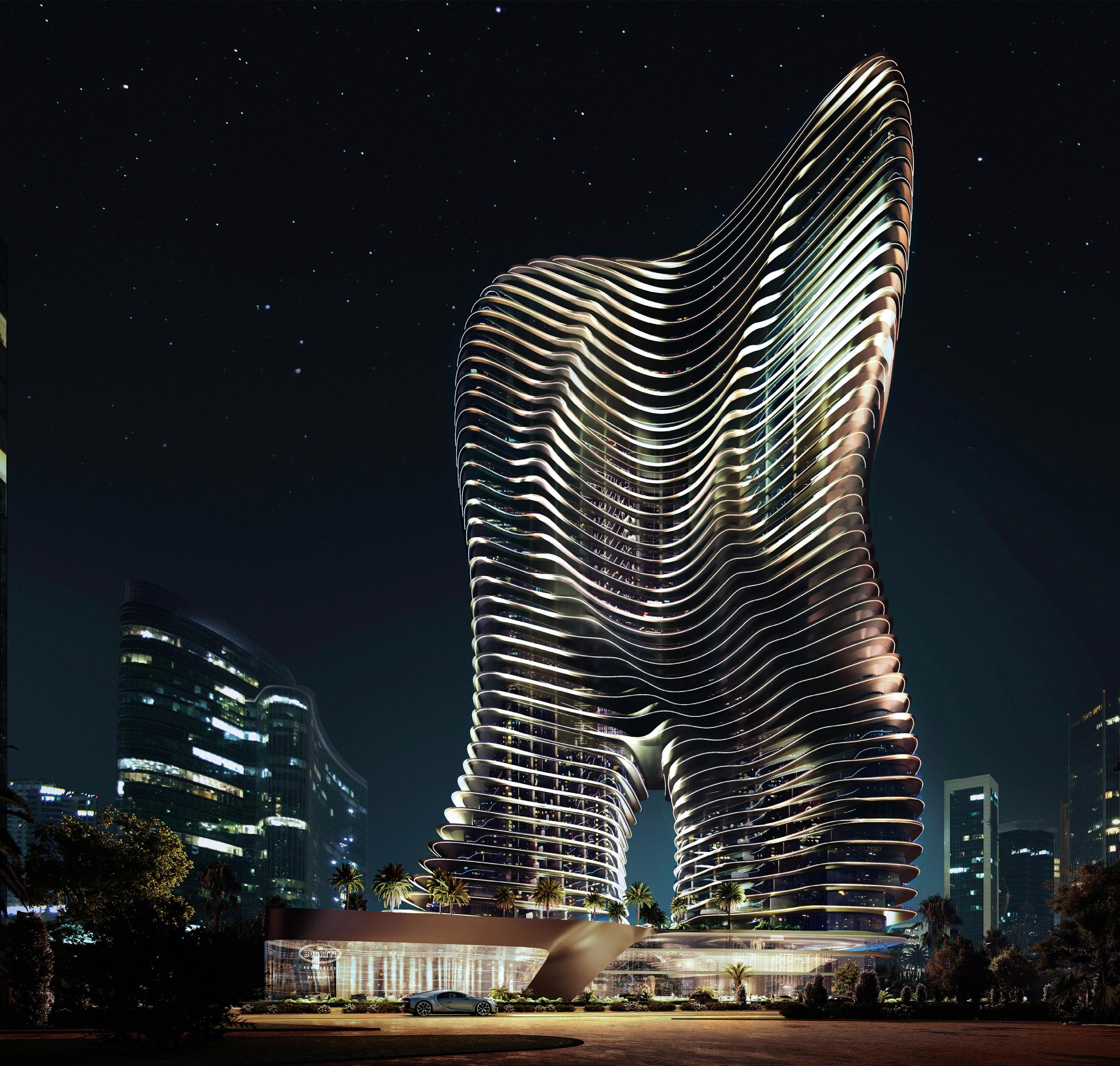
The distinctive façade of Bugatti Residences by Binghatti. With its serene undertones, the hyper-form will juxtapose the city’s bustling energy retreat in the heart of the metropolis.
Source: The Landscape of Branded Residences in India-2024 by Noesis
105,00 BRANDED RESIDENCE UNITS ACROSS 750 PROJECTS WORLDWIDE
OVER 1,200 SCHEMES FORECAST BY 2027.
HOTEL BRANDS DOMINATE WITH A SHARE OF 80% OF THE PROJECTS.
MARRIOTT IS THE LARGEST OPERATOR, FOLLOWED BY ACCOR WITHIN THE HOTEL SEGMENT. YOO IS THE LEADING NON-HOSPITALITY BRAND.
DUBAI IS THE WORLD’S LEADING HOTSPOT FOR BRANDED RESIDENCES FOLLOWED BY SOUTH FLORIDA, NEW YORK, PHUKET AND LONDON
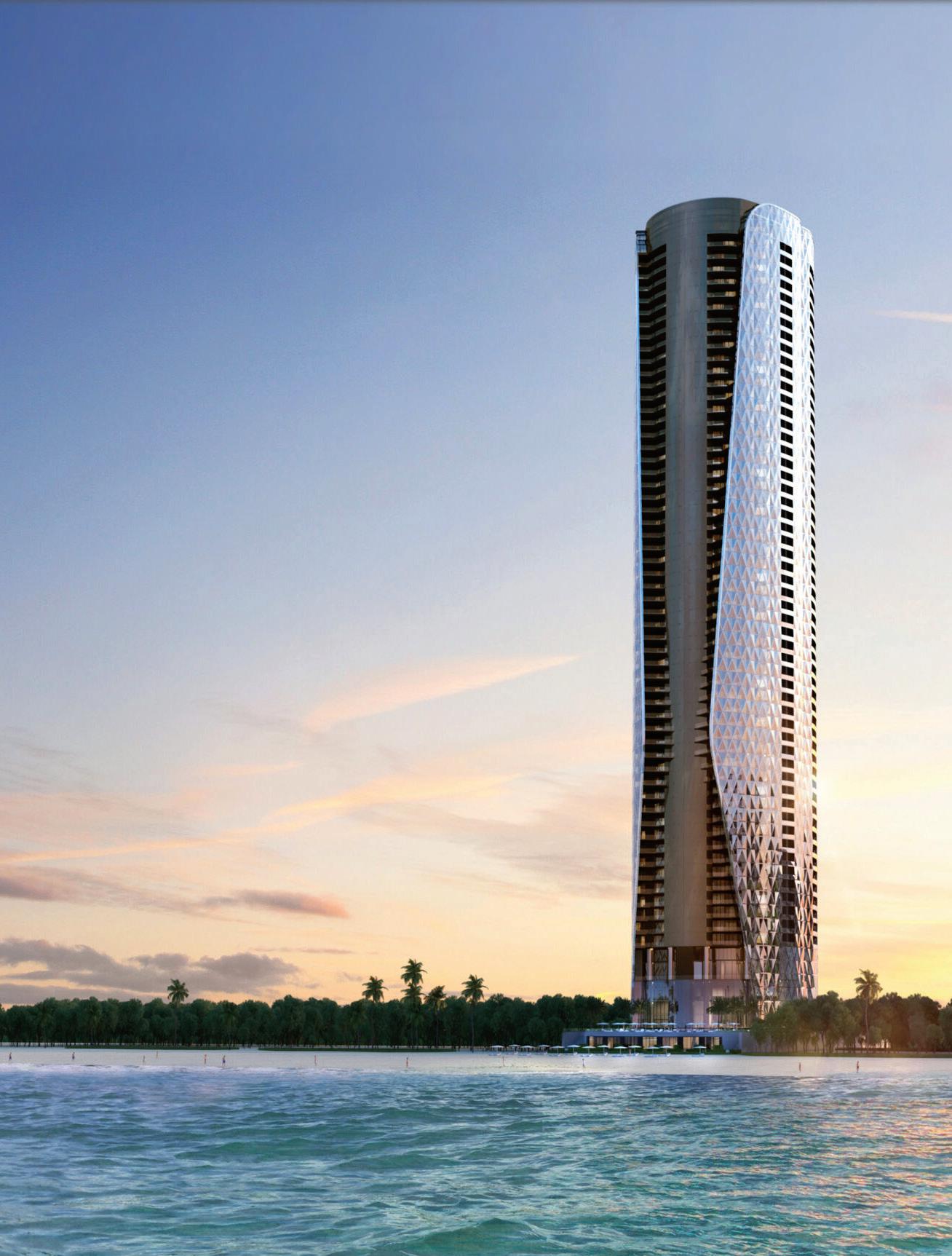
Bentley Residence Miami. The core of the building will house a patented car elevator that will take the residents directly to their home in their car.

ANUJ PURI CHAIRMAN AND FOUNDER, ANAROCK
“(Hotel and non-hotel residences) are being offered across cities... (Consumption) is wholly market dependent.”
JAIDEEP DANG MANAGING DIRECTOR, HOTELS & HOSPITALITY GROUP, JLL
“India-born global hotel operators are exploring opportunities with their luxury hotels being at the heart of such lifestyle-oriented developments.”

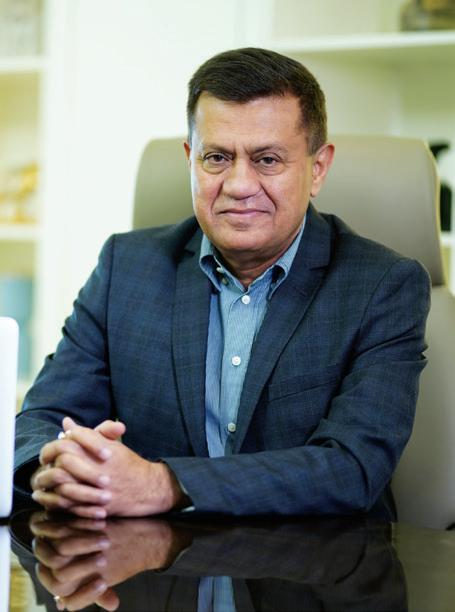
PAL
MANAGING DIRECTOR, WHITELAND CORPORATION
“The Westin Residences Gurugram will redefine premium home ownership with exceptional service and attention to detail.”
VENKATESH EXECUTIVE VICE PRESIDENT, REAL ESTATE & DEVELOPMENT, IHCL
“Mixed use developments, with co-existence of residential and luxury hotels, is a growing format in metro cities.”
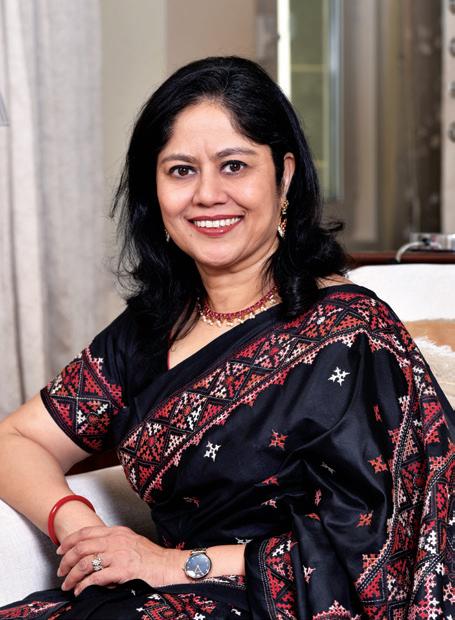

BOBBY MUKHERJI FOUNDER, BOBBY MUKHERRJI ARCHITECTS
“The Indian home-buyer has never been so aspirational. They have the money, and they have the ambition.”
PALANIAPPAN MANAGING DIRECTOR, AMPA GROUP
“Branded residences like the Taj Sky View are usually valued about 30%-40% higher than a regular residence.”
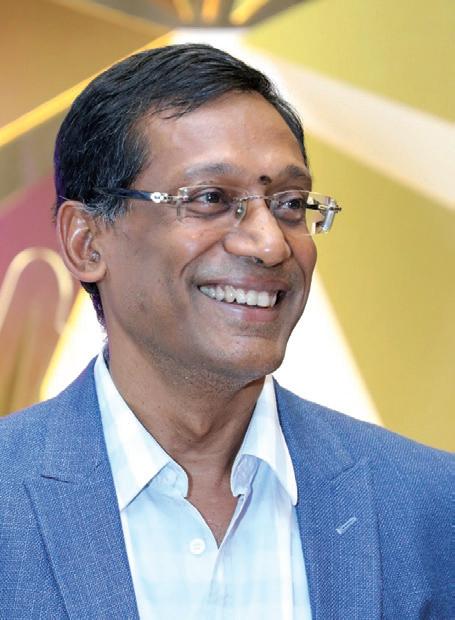

SAMARTH BAJAJ FOUNDER, BOHEIM
“Fashion designers think beyond traditional boundaries, a quality that enhances their exceptional talent in creating bespoke homes for Boheim patrons.”
UNITY GROUP
“I'm not quite convinced about the value the service angle (of a hotel-branded residence) brings to the individual home.”
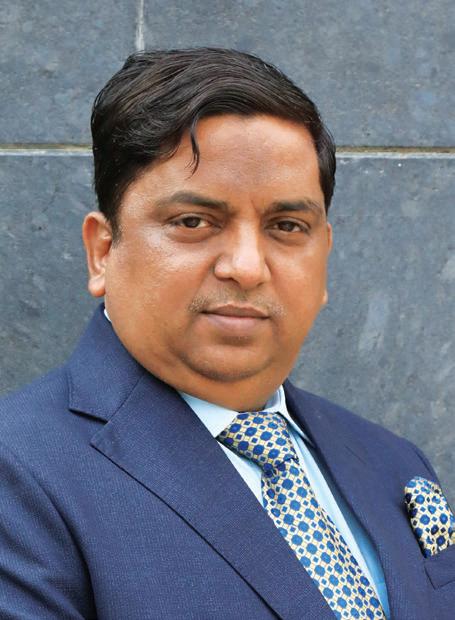
VYOMESH SHAH MANAGING DIRECTOR, HUBTOWN
“The level of service even in 100-200 crore apartments is still unorganised. And there is a certain expectation people have of service standardisation.”
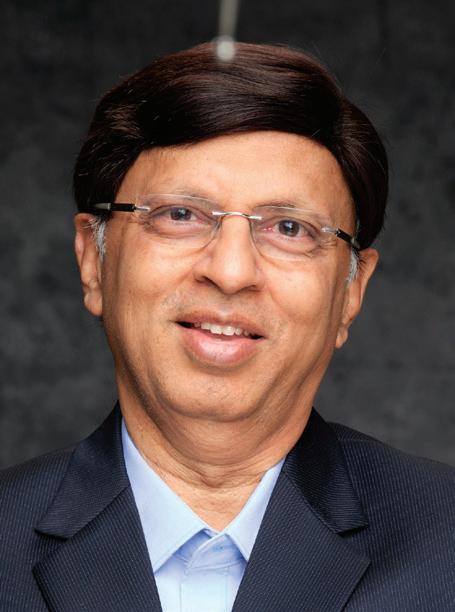

Mumbai
Ashford Chambers, Old Citylight Theatre | Lady Jamshedji Road | 400 016 Mahim, Mumbai 022 2446 7750/51/52/54 | mumbai@pluschliving.com
Bangalore No 37, 4th B Cross, 5th Block | Industrial Layout Koramangala | 560 095 Bengaluru 080 2550 4444 | bengaluru@pluschliving.com
Hyderabad
Plot No, 761, Rd Number 39 | CBI Colony, Jubilee Hills | 500 033 Hyderabad +91 82972 25491 | hyderabad@pluschliving com
Delhi
F 3/1, Okhla Industrial Area | Phase 1, Near Crowne Plaza | 110 020 New Delhi 011-41553333/6789 | delhi@pluschliving.com

a development under management contract with IHCL for Taj Sky View, a hotel and branded residences complex in Chennai, says: “Branded residences like the Taj Sky View are usually valued about 30%-40% higher than a regular residence. Because of their unique service offerings and professional management, real estate valuation of such branded residences experiences higher appreciation over a period of time.” Jaideep Dang, Managing Director, Hotels and Hospitality Group, JLL India, concurs. “On an average, branded residences in the Indian market are priced approximately 30% more than other comparable residential developments in a particular micro market,” he says. Shah prefers to tread on the side of caution. ”We’ve currently not budgeted too much for premium,” he says. “Generally, we allow the market to decide that. But from whatever research we’ve seen, we expect anything from 5 to 15% premium.”
Increasing affluence in urban centres across India translates to demand opportunities for this real estate format. “Mixed use developments with coexistence of commercial, retail, residential and luxury hotels is a growing format in the real estate segment in metro cities,” says Suma Venkatesh,
Source: JLL Hotels & Hospitality Group – Data as of Q1 2024
Executive Vice President, IHCL. India, according to the Noesis report, is expected to mirror the 12% CAGR of the global branded residence market. Major metro cities, it states, indicate an established appetite for luxury lifestyle. Mumbai, DelhiNCR and Bengaluru are witnessing a surge in branded residences. However, emerging cities like Surat, Ahmedabad, Jaipur, Chandigarh and Indore show a promise of infrastructure development, FDI and commercial growth. This, says the report, will also satiate the appetite of investors looking to own a branded residence in the area. Pune, Chennai and Goa are attracting interest from developers and investors as well.
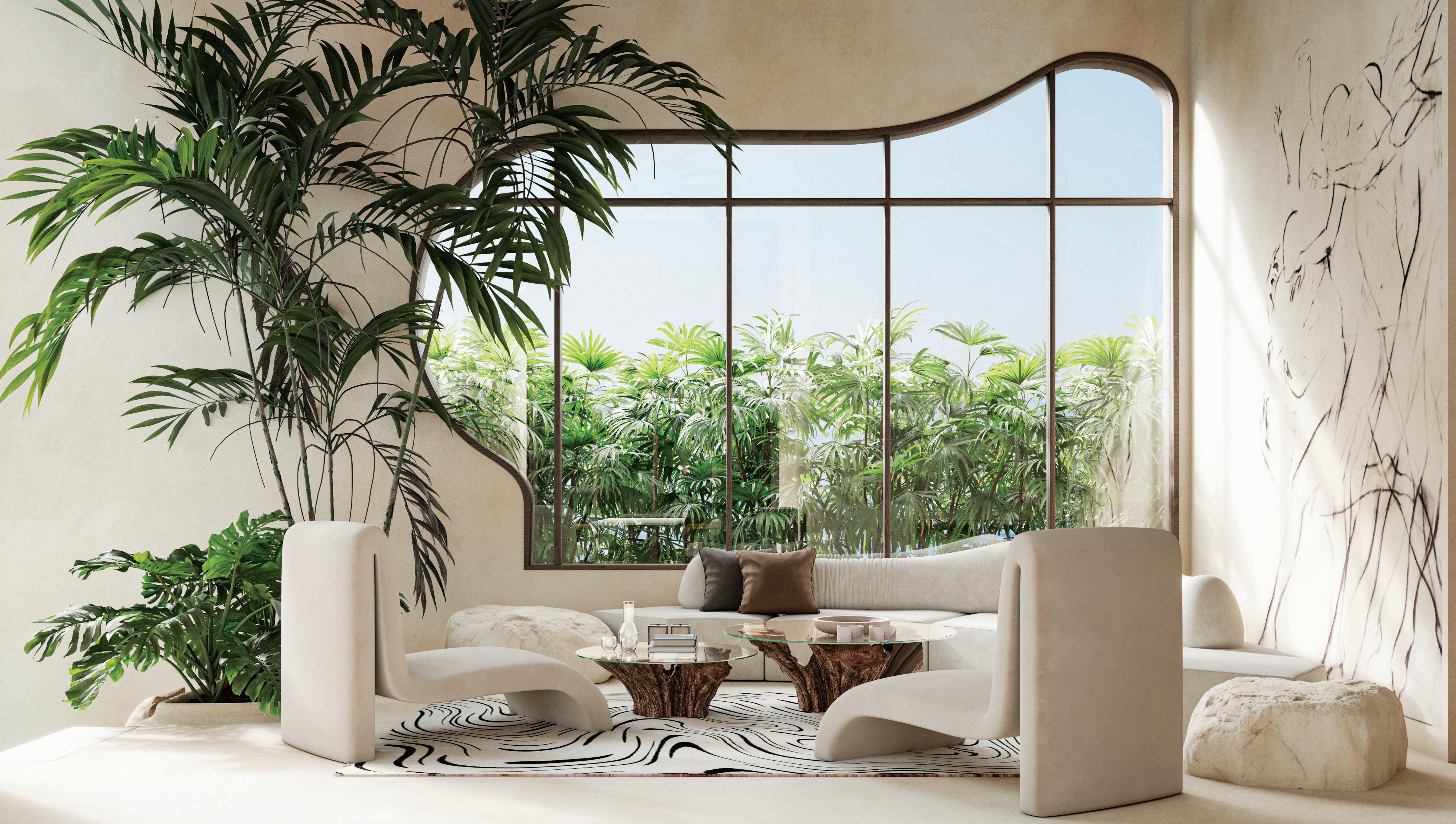
Historically, the branded residences market has been dominated by hotel brands, which are in a unique position to offer world-class services as well as lend their brand equity for a heightened perception of the development.
The evolution of the concept beyond the conventional approach has encouraged developers to explore standalone residences, branded villas and mixeduse developments to cater to diverse buyer preferences. While established metro cities might be suitable for standalone branded residential development, emerging markets would best benefit from the hotel + residences combination whereas in key leisure destinations, a resort + branded villa development would thrive. “The magic is in the mix,” states Dang.
Marriott leads the market. “Not only in the hotel + residences space but also it is amongst the very few companies which has brought its residences-only model to India i.e. without a hotel in the precinct,” discloses Dang. “We are also witnessing other hotel operating companies such as Hilton and IHG, who have successful hotels-cum-residences models overseas, and are exploring prospects in India. Also, other India-born global operators such as IHCL, The Oberoi Group and The Postcard Hotels are exploring opportunities with their luxury hotels being at the heart of such lifestyle-oriented developments.”
While the luxury branded residence vertical is certainly being viewed positively by both developers and brands, hotel operators, not surprisingly, are being extremely careful in their assessment, and all have a strict diligence process of selection. “As a part of our growth strategy, we will evaluate such opportunities with a sharp focus on the project’s design complementing the aesthetics and ethos of the Taj brand including the approach to architecture, landscape, interiors and sustainability,” reveals Ventakesh. Hubtown’s Shah speaks of the alignment of vision and brand on a philosophy level and the ability to complete documentation on a process level, as being pivotal to such partnerships. “What defines luxury? Even within the hotel space it’s different. A JW Marriott is different from a St. Regis. To get aligned on that front is first and foremost critical,” he says. “And then there’s the documentation. We’ve had a couple of instances where everything was aligned, but from a legal standpoint, or process standpoint, or documentation standpoint, we were unable to bridge that (gap).”
Whatever the challenges, the advent of branded residences in India celebrates the successful marriage of India’s favourite asset class with bestin-class hospitality—and this has further strengthened investor commitment to this segment. Looks like branded residences are here to stay!
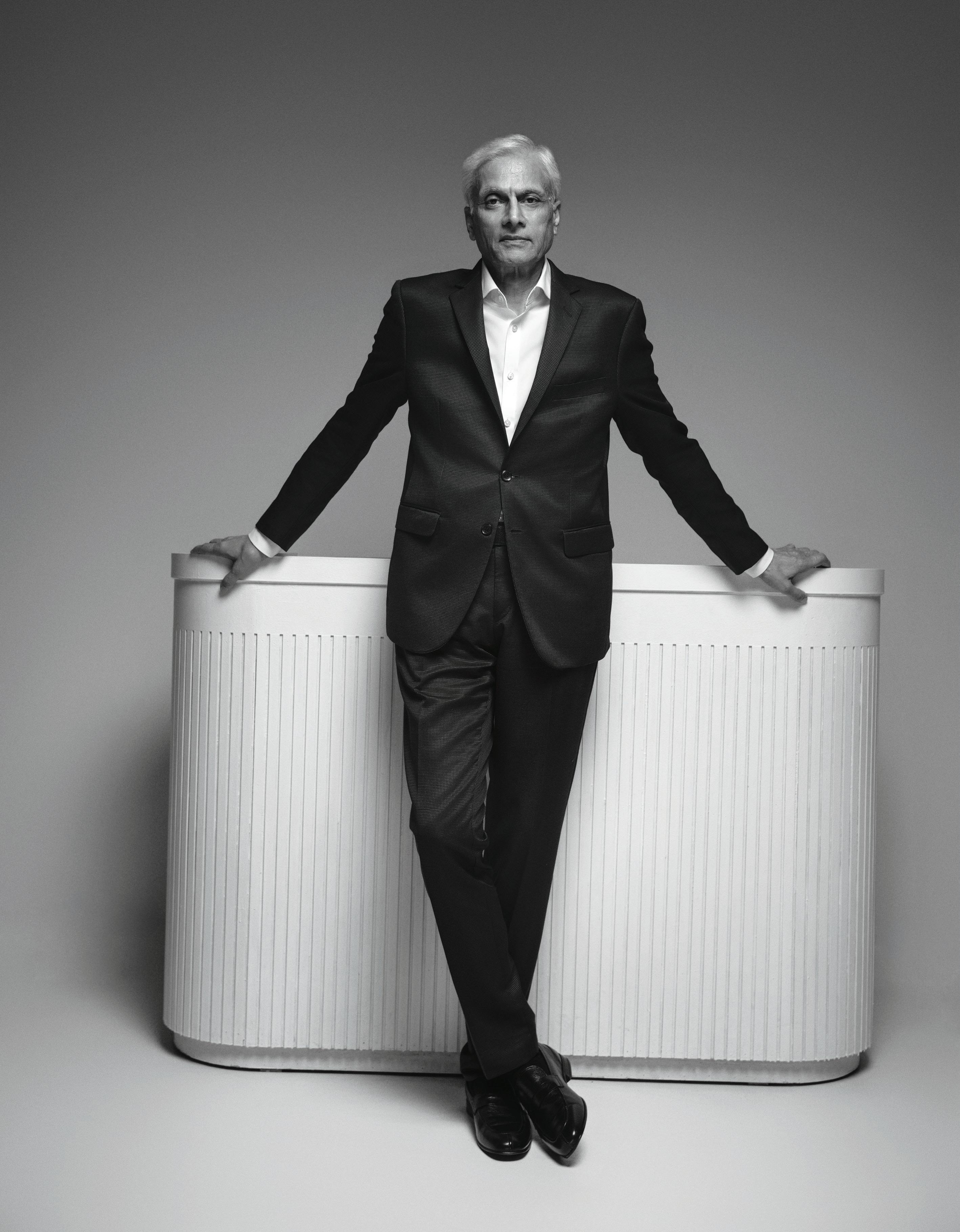

Three decades, 120+ hotels. The remarkable success story of Sarovar Hotels 30 years on, especially in the hitherto oft-ignored midscale segment of Indian hospitality, has transformed the hospitality landscape in India.
CREATIVE DIRECTOR TANVI
PHOTOGRAPHED BY PRIYANKK NANDWANA
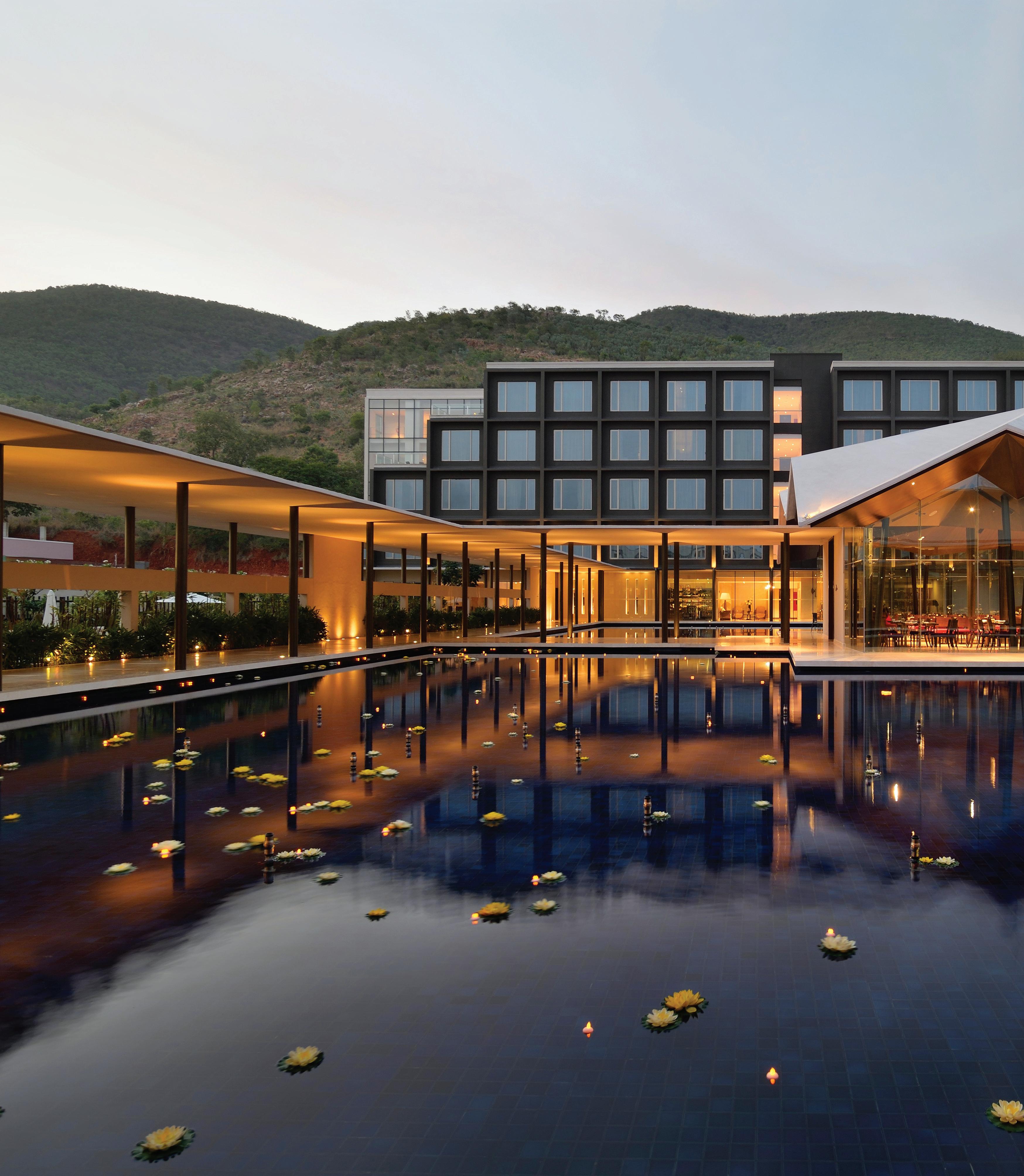

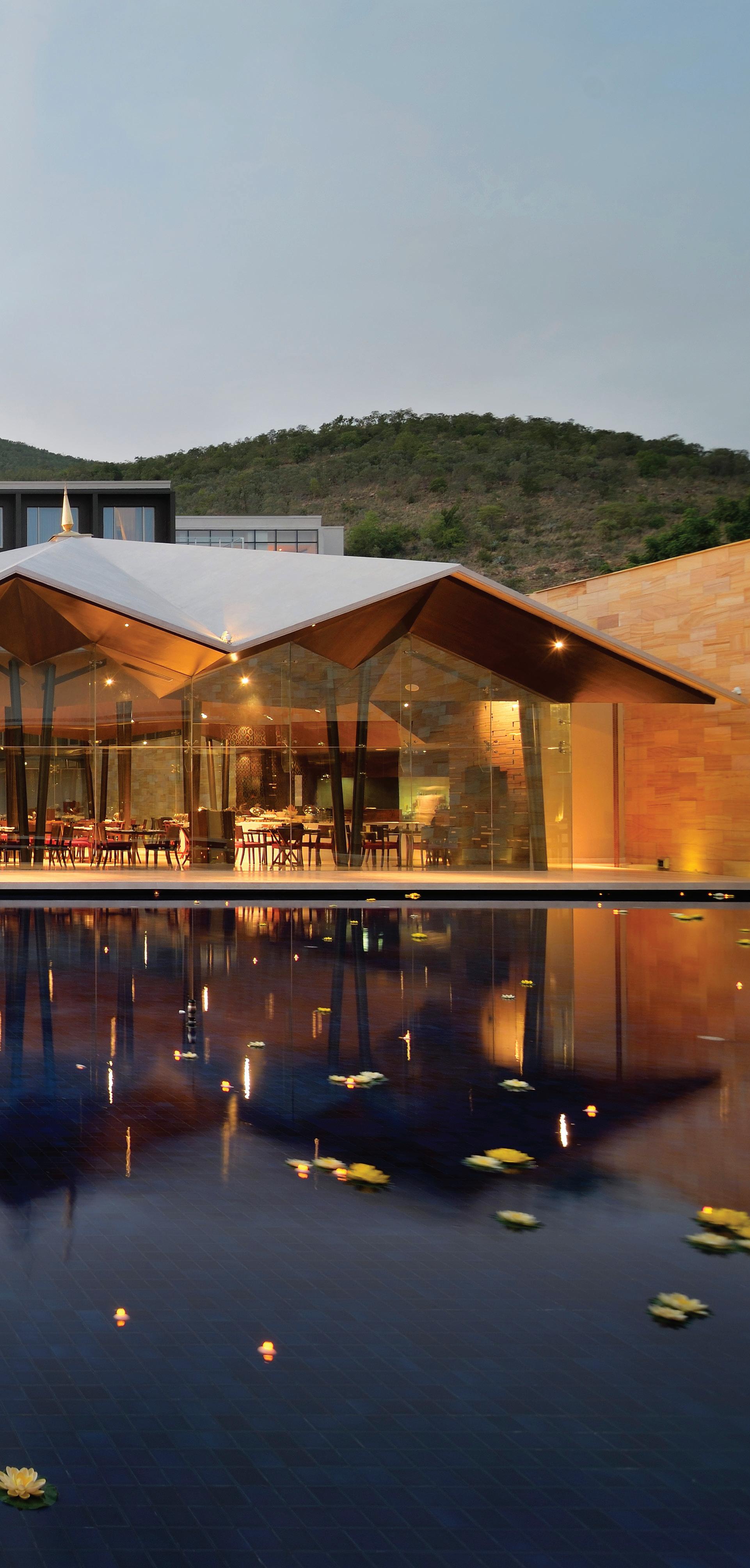
Mid-scale hotels. In 1994, the year Sarovar Hotels began its remarkable journey, they were not a reality in the branded segment. At least not in India. But then relatively young and already with a wealth of experience, two The Oberoi Hotels veterans, Anil Madhok and Ajay Bakaya, joined hands to venture into this hitherto ignored space in Indian hospitality. The fact that they came from a luxury hotels background and created a brand like Sarovar, one of the fastestgrowing hotel brands in India, with a score of openings this year alone, is a feat almost unmatched in the sector.
While the group’s largest presence is in metros such as Delhi NCR (14 hotels) and Bengaluru (10), its success lay in going to Tier II towns, usually becoming the first hotel brand to do so. From Saharanpur to Shravasti, from Siliguri to Somnath, Sasan Gir and Sonipat, the Sarovar flag has been setting benchmarks across the country. As the brand marks its 30th anniversary, SOH looks back at this remarkable journey.
“When we started, we had clarity,” points out Ajay Bakaya, Managing Director, Sarovar Hotels. “I can't claim that we saw things as they are today or as good as they are today. And we were new to the game. None of us had had any successful exposure to being entrepreneurs. Mr Madhok had moved from a very corporate life into Sarovar and he was finding direction. I had one stint as an entrepreneur, which had nothing to do with hotels. When we joined hands we knew our strengths, we knew our competency in terms of running hotels, in terms of being able to sell hotels and doing business to the hotels. We were all expert operators.”
Bakaya also mentions the timing of their decision to go into business. “Liberalisation had happened. The questions to ask were: what are your strengths? What are the competencies? We knew we could run hotels. We knew there was a huge market in India where hotels were not run properly. So, we were there at the right time. The only people

who'd been before us was Choice, and they had gone very largely into a franchise model.” Madhok, who passed away last year, made a similar point in an interview in 2012. “Of course, there was an element of being in the right place at the right time, but I would credit us for figuring out the right approach to business. It was simple—none of the big chains were looking at small hotels. We were virtually the only company to do so.”
Madhok worked with The Oberoi Group for 25 years, with postings in Mumbai, Sri Lanka and Singapore, rising to be vice president of operations. He had been inspired to exit the ‘make-believe world’ of luxury hospitality while in Singapore, and decided to start his own venture. “Due to the liberalisation in 1991, there were a lot of hotels mushrooming everywhere but there was no company to manage them,” he said in the same interview. “So, I started Sarovar Hotels and Resorts in 1994 with ₹50,000 from my personal savings. I believed there was an opportunity to give a burgeoning, amateur hotel industry access to operational expertise, and I could do that.”
Bakaya recollects that Madhok and he were clear on three key factors when they started. “One was building long-term owner relationships. The owner is the king. He’s putting in the money, he is taking the risk. We are providing a service to the owner. And as an entrepreneur, we had to start thinking as an owner or as a true business person would: where is the money coming from? Where is it going? What are the returns? If he is hurting, you need to hurt with him and change and modify and adapt to make sure he hurts as little as possible.”
The other pillar was to bring in key people with strong experiences that the owners could not possibly attract or retain. “So from day one, in our very early stages, when we had the Marine Plaza in Mumbai,
In Indian hospitality, only a select few visionaries have been gamechangers. In that list, Anil Madhok (1945-2023), founder and former managing director, Sarovar Hotels and Resorts, ranks towards the very top. An economics graduate from the University of Delhi, he almost joined the army when fate took him to the hotel management programme offered by The Oberoi School of Hotel Management. And he remained with the group for a quarter of a century! Leaving Oberoi in 1991, he joined the Al Bawadi group for a couple of years before starting Sarovar in 1994. The rest, indeed, was pathbreaking.
we brought in a corporate housekeeper, a corporate chef, and we had a corporate engineer,” recollects Bakaya. “Two of these three were also the executive housekeeper and the executive chef in the hotel. I am the only company in this country that can pitch ourselves against anybody. We have IT training and HR, etc. So we have a huge team.” The Sarovar team is already over a thousand members strong, plus another about 7,000 odd in the hotels.
The third element was the ability to bring business to the hotels. “We started with three sales offices in city centre locations,” says Bakaya. “Today we have 16 sales offices. Sarovar delivers 25% of its business through these offline channels. I offer support services that no other company in this country offers. I have owners who have given me two hotels, three hotels, and four hotels. I have multi-property owners, which means I must be doing something right for those relationships.”
As the group reflects on their journey from one hotel to 120 over the past 30 years, they recognise the need to continuously evolve our operations. Says Jatin Khanna, CEO, Sarovar Hotels, “Each decade has brought transformative changes in our strategies and today, we stand on the brink of another significant shift. We've always been proactive in deploying manpower and over the past year-and-a-half, we've doubled the size of our revenue, marketing and HR teams, as well as expanded our sales offices.”
Paris-based hospitality firm Groupe Du Louvre acquired a majority stake in the group in 2017, and then, as Bakaya says, “the ball got rolling”.
He points to the advantage of being local as a crucial recipe for success. “We click with the owners; we talk in a language that they understand. We give them
SAROVAR PREMIERE OFFERS UPSCALE 5-STAR PROPERTIES THAT ARE DESIGNED TO RESONATE WITH A COSMOPOLITAN VIBE.
SAROVAR PORTICO OFFERS FULL-SERVICE 3 AND 4-STAR HOTELS THAT OFFER ACCESS TO COMMERCIAL AND TOURIST CENTRES.
HOMETEL IS A VALUE BRAND THAT REDEFINES THE CONCEPT OF AN ECONOMY HOTEL
ROYAL TULIP OFFERS LUXURIOUS ACCOMMODATION, FINE DINING, AND MATCHING SERVICES IN ELEGANT SETTINGS.
GOLDEN TULIP CATERS TO THE UPSCALE SEGMENT, OFFERING LUXURY EXPERIENCES.
TULIP INN PROVIDES AFFORDABLE ACCOMMODATION, MODERN AMENITIES, AND WARM HOSPITALITY
THE GROUP ALSO RUNS SEVERAL RADISSON BLU, RADISSON, PARK PLAZA AND PARK INN BY RADISSON BRANDED HOTELS.
THE GROUP HAS A COUPLE OF F&B BRANDS— GEOFFREY’S PUB AND ORIENTAL BLOSSOM. THE ORIENTAL BLOSSOM IS A SPECIALTY CHINESE RESTAURANT CHAIN WHILE GEOFFREY’S, A METRO-CENTRIC PUB CHAIN, IS A CONTEMPORARY INTERPRETATION OF A TYPICAL OLD-WORLD ENGLISH PUB.
THE GROUP ALSO MANAGES LODGING AND CATERING FACILITIES AT VARIOUS INSTITUTIONS IN THE COUNTRY.


continuity that large companies don't give them. For an international company, a guy comes in and then disappears, after which the owner talks to somebody else, and somebody else, and somebody else. With us, there are also cultural gaps to deal with. We don't talk down to our owners. We understand, we empathise, but we are not subservient either. We are on equal footing. We are partners.”
Interestingly, Bakaya claims that at least 70% of his owners are first-time investors for whom this is their only large business. “That is a different dimension altogether, because you are not dealing with people who are used to dealing in millions here and there and could not care if it goes right or wrong one way or the other, or we'll wait three months.”
While today, every hotel brand that desires to scale up is looking at the mid-market opportunity, Sarovar began its journey with this segment and remains focused on the space. “We were very clear we wanted to position ourselves in the mid-market. That's my core. I run deluxe hotels, but they are a small minority. I keep telling my team, luxury feels nice, but that's not our DNA.”
There is very clear clarity on the basic values that are not going to change, underscores Bakaya. “There are things that are changing. Yes, we need to wake up and we need to learn and we need to listen, and we need to treat people differently today than we did earlier on. It's a changing world. But our main narrative is Tier II and Tier III. I think our experience has been phenomenal.
“The markets in these two segments are growing today largely because of people’s aspirations. They are travelling often, and they want similar facilities in their cities. Tier III is not going as fast as it possibly could. Land is equally expensive, of course. Land in Indore or even Kanpur is no less expensive than the bigger cities. That's why the growth is smaller. But our niche is anywhere from a 60-room to 110-
120-room hotel, a space in which there is huge demand. That’s a smaller investment package because we position ourselves in the aspirational middle class.”
Going to an emerging destination also has paid off exceptionally well for Sarovar. “When we went to Lucknow, it was a very small city at that time. Amritsar too. Tier II and III cities give you even more opportunity to showcase your talent and your experience because they just don’t have anything,” says Bakaya. He admits there were considerable challenges in going to smaller cities, especially in the group's early years of operation. “The scale of the opportunity was still small at that time because there weren't a lot of people building opportunities in these destinations. The demand was low, though you were assured of a certain level of success. Your freight connections weren't there, roads were horrible. You went on trains to a lot of these places.”
WE WERE VERY CLEAR WE WANTED TO POSITION OURSELVES IN THE MID-MARKET. THAT'S MY CORE. I RUN DELUXE HOTELS, BUT THEY ARE A SMALL MINORITY. I KEEP TELLING MY TEAM, LUXURY FEELS NICE, BUT THAT'S NOT OUR DNA.” “
1994 Sarovar Hotels was founded. The first hotel was Bogmallo Beach Resort, Goa.
1996 Marine Plaza, Mumbai is refurbished and opens with a Sarovar flag.
1997 The group’s second hotel, Radha Regent Chennai, formerly Radha Park Inn, opens.
1999 Park Plaza, Ludhiana opens.
2000 Muthoot Plaza, Thiruvananthapuram opens.
2005 Sarovar Premiere, Sarovar Portico and Hometel added to the existing Park Plaza and Park Inn hotels. The group’s sub-brand, Hometel, is launched with Radha Hometel in Whitefield, Bengaluru.
2007 Paris-based hospitality firm Groupe Du Louvre enters India with its Golden Tulip brand.
2011 Sarovar opens its 50th hotel.
2012 Sarovar opens The Heron Portico in Nairobi, its first hotel in Africa.
2016 Wyndham was reportedly in talks to acquire Sarovar.
2017 Groupe Du Louvre gets majority stake in Sarovar Hotels, buying out earlier investors. Golden Tulip Hotels is amalgamated into Sarovar Hotels.
2018 Sarovar opens its first hotel in Africa, in Zambia.
2022 The group opens its 100th hotel as it expands rapidly.
2024 The group marks its 30th year and has grown to be one of India’s largest hospitality groups with 120 operational hotels in 77 destinations.
I THINK MY BIGGEST CHALLENGE IS PEOPLE. WE ARE AT A STAGE WHERE I AM VERY DEEPLY CONCERNED THAT I AM NOT ALWAYS DELIVERING WHAT I PROMISED TO MY OWNERS BEFORE THEY SIGNED UP .” “
The essentials for Tier II and Tier III markets
What does a traveller need when he heads to a Tier II or III town or city? Bakaya says the top priority is cleanliness. “Housekeeping was non-negotiable. When you put food on the plate, it should taste good. Forget all the other fancy dramas. As I tell people, your guest in a hotel is like a guest coming to your home. You make sure you take care of him, and he goes out happy.”
Bakaya is confident Sarovar can take on the competition even as hospitality majors such as Taj (Ginger), Marriott (Aloft, Moxy), Accor (ibis), Hyatt (Hyatt Place), ITC (Fortune), Radisson (Park Plaza, Park Inn), Wyndham (Ramada, Days Inn, Microtel, Howard Johnson), Lemon Tree (Red Fox) and others increasingly deepen the foray into the midmarket and economy space.
As for the potential of the midscale segment in India, Bakaya reiterates a point that Dmitri Manikis, President EMEA, Wyndham Hotels and Resorts, made at HICSA earlier this year to
the industry: even going by the most generous estimate, the luxury and premium customer do not make up more than 10% of the market. “The rest is us.”
India is currently experiencing remarkable growth, often referred to as the shining story of this decade. With a burgeoning middle class and supporting data, India stands as the youngest country in the world and will remain so for years to come, says Khanna. “This youthful demographic brings to the table an increasing capacity for spending and a strong inclination towards travel, including holidays and long weekends. Sarovar, as a leading domestic brand in the mid-market and premium segments, is uniquely positioned to cater to this demand, offering unparalleled hotel experiences.”
The group ended 2023 with double-digit growth and the first quarter of 2024 has seen double-digit gains, Bakaya elaborates. “Excluding the election months, which understandably were slower, we see the market as very stable.”
Bakaya admits to the challenge of staffing, which is impacting the entire sector significantly. “I think my biggest challenge today is people. We are at a stage where I am very deeply concerned that I am not always delivering what I promised to my owners before they signed up.” He says that a hotel requires a room-to-staff ratio of 1.2.
“Anybody thinks it can be done in less is cheating you.”
Cultural habits are changing in India. “You have to make sure you are paying more. You have to make sure you're not cutting corners. You have got to ensure that the back of the house in terms of cafeterias and locker facilities is as clean as the front of the house is. And this is not expensive to do. We have started building our army,” Bakaya says.
Sarovar has tied up with the Indian School of Hospitality to train executive staff. “Starting from August 1, we are starting a programme
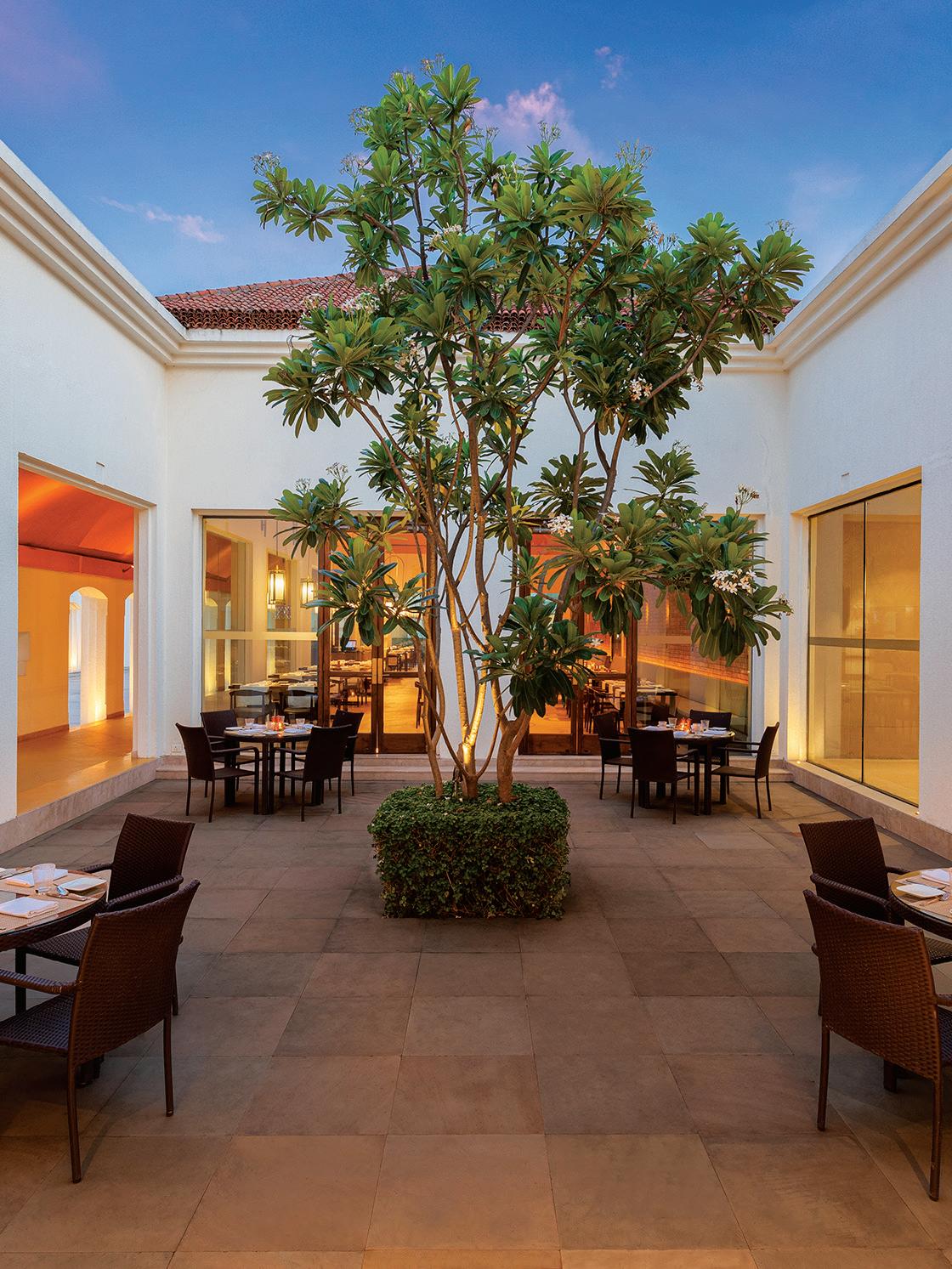
THE GROUP HAS OPENED EIGHT HOTELS ALREADY THIS YEAR AND PLANS TO OPEN A FURTHER 8 TO 12, TAKING THE TOTAL TO 130 PLUS OPERATIONAL HOTELS BY THE END OF 2024
BY THE END OF 2025, THE GROUP IS TARGETING OPENING 150 HOTELS THAT IS AN AVERAGE OF AT LEAST TWO OPENINGS A MONTH—AN IMPRESSIVE NUMBER FOR ANY GROUP.
THE GROUP HAS A PIPELINE OF ABOUT 70-80 HOTELS
WHILE THE COMPANY ITSELF OWNS TWO OF ITS EXISTING HOTELS, A THIRD COMPANY-OWNED HOTEL IS COMING UP IN CHENNAI

LEFT TOP: Marasa Sarovar Premiere, Bodhgaya.
LEFT BOTTOM: Hotel V Sarovar
Portico MI Road Jaipur.
BOTTOM: Located in the heart of Dalhousie, Presidium Sarovar
Premiere offers breathtaking views of snow-covered mountains.
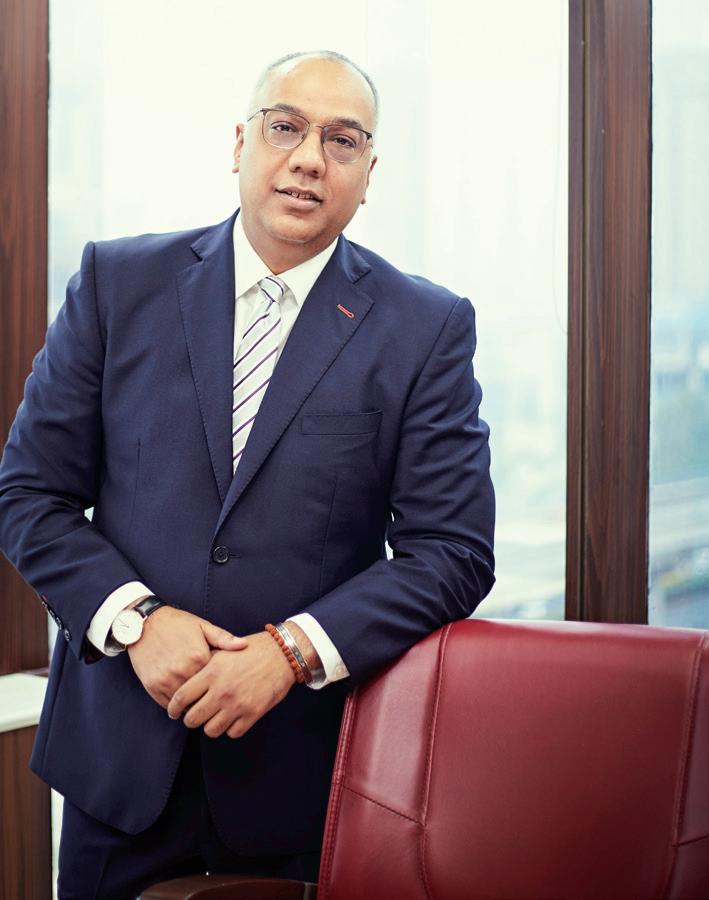
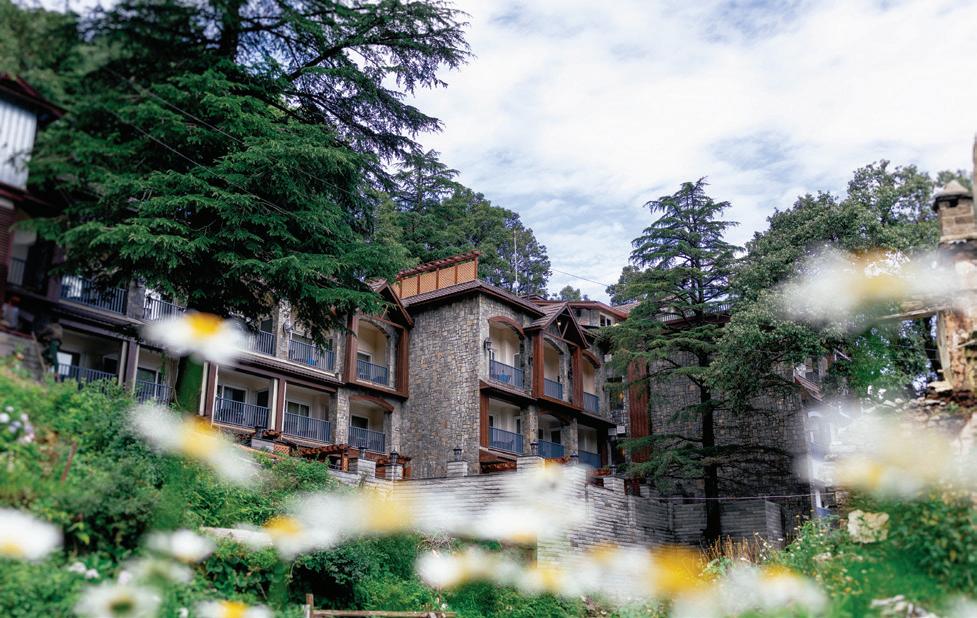
where I will pick up youngsters from hotel schools and for 12 months, I will pay for them. In that year, they will be certified with a proper school. They will be trained either as young assistant managers, young housekeeping executives or young chefs. We are making this investment in people. And hopefully, they will understand our philosophy. Even if half of them remain with us, we are building a certain culture that can multiply over time.”
Bakaya points out that the recent spurt in growth means that he can no longer be in touch with hotels as frequently as earlier. “The systems and the structure that we had in place in these early stages, even in the first 10 or 15 years, don't work anymore. So I can't visit all my hotels, nor can my CEO. I don't necessarily know what's going on. Yes, I look at my reports weekly, and monthly, but I'm not in touch with the hotels, day-to-day. We are now developing a system, a brand deck that will prompt me which hotel has gone down in say the last four days, or which hotel is performing subpar. We're moving to that level of technology now, which will help us manage things better. We were always hungry, and we remain hungry.”
With the Louvre association, the group has embarked on a technology revolution, “which is way ahead. Currently leading the industry, the company offers systems that allow every employee to access e-learning on a mobile phone, providing the flexibility to train whenever
“It's crucial to establish a culture of openness and transparency right from the start. This means clearly defining expectations, goals, and performance targets. Regular meetings and updates between owners and brand representatives help maintain alignment and quickly address any issues that arise.”
they choose,” says Bakaya. “We are making sure that in India, the translation is available in multiple languages because right now, everything is in English. More recently, we have the advantage of being the only Indian hotel company with a global distribution system and reach through the Louvre systems.”
On the technology front, all Sarovar hotels are integrated into a best-in-class Central Reservation System (CRS), adds Khanna. “We are also aligning our backend technology with that of Louvre Hotels, which operates 1,800 hotels globally. This alignment will enable us to develop new tools, enhance business analysis, and improve product offerings, all from a guest experience perspective.”
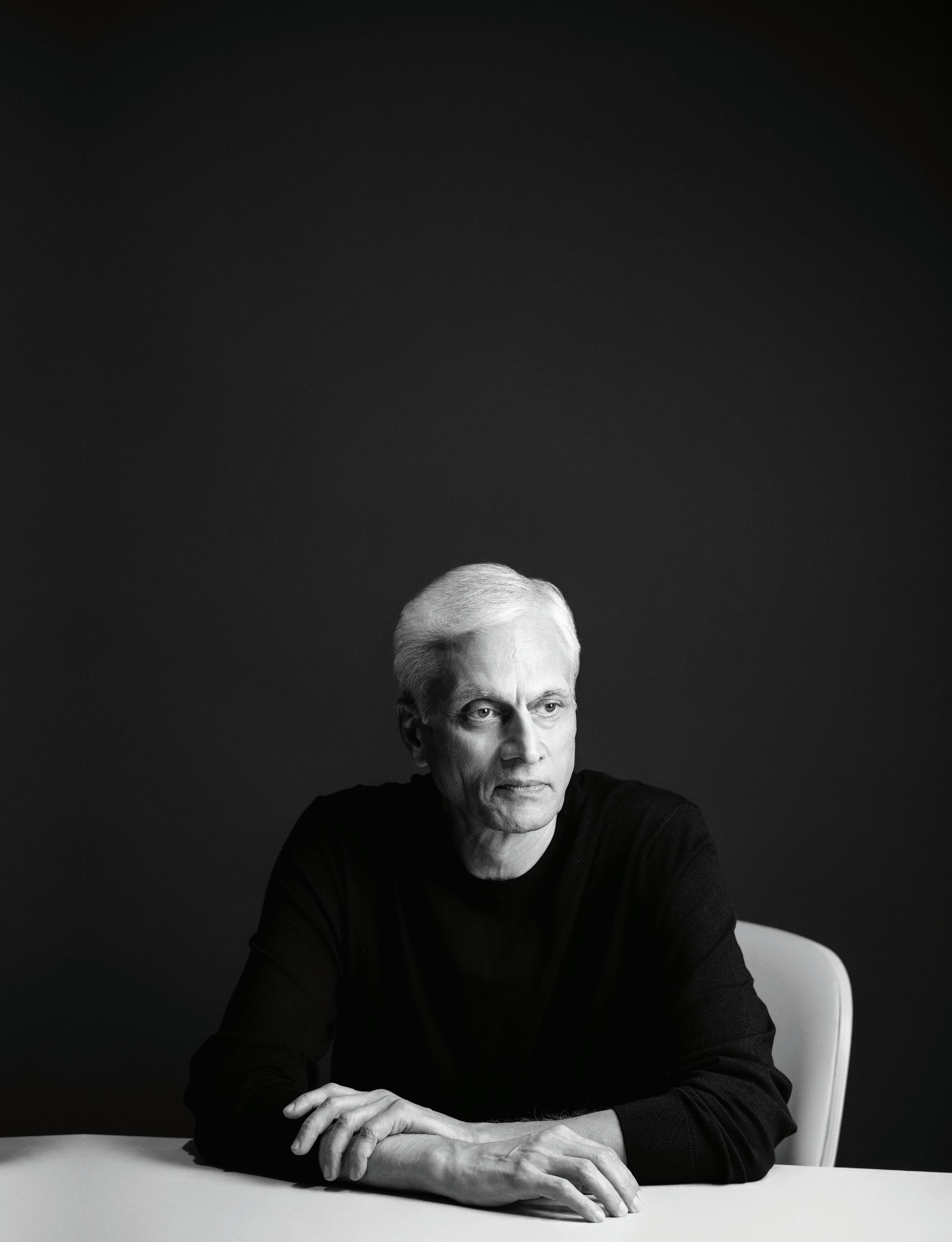
Most in the sector agree that the Sarovar Group brought certain elements to the midscale space, which were conspicuously missing. “We were always ethical and clean,” says Ajay Bakaya. “And we remain ethical and clean. I have hotels that are doing brilliantly. I have hotels that are doing well. I have hotels that are doing below average for whatever reasons. But I doubt very much that you will find an owner, past or present, who will have anything negative to say about Sarovar or its people. We are very clear, we make mistakes. We say we made a mistake and we fix it. We don't invest, but in every other manner, we are partners. We go anywhere and everywhere.”
Bakaya cites an example of the standards the group has set. “I was pursuing hotels in Iraq at one time and Mr Madhok said to me, ‘Are you serious?’ And I said yes. He said no. I said, well, why? I'll go. He said, ‘Look, I am not going to go to Iraq. I forbid you to go to Iraq. It is not safe enough. And if I and you are not going to travel, then the same applies to our people. We are not going to send other people there too.”
SAROVAR IS LOOKING AT OPENING TWO HOTELS IN AFRICA, IN KAMPALA (UGANDA) AND HARGEISA (SOMALILAND) IN 2024. IT ALREADY HAS THREE HOTELS IN AFRICA—TWO IN NAIROBI (KENYA) AND ONE IN LUSAKA (ZAMBIA). ALSO IN THE PIPELINE ARE HOTELS IN ETHIOPIA, TANZANIA (A RESORT IN ZANZIBAR) AND ZIMBABWE
THE GROUP WILL OPEN ITS FIRST HOTEL IN NEPAL THIS YEAR.
SAROVAR IS SCOUTING HOTELS IN OTHER INTERNATIONAL DESTINATIONS SUCH AS WEST ASIA, SRI LANKA, CENTRAL ASIAN AND CAUCASIAN REGIONS WHILE IT HAS IN THE PAST OPERATED HOTELS IN BANGLADESH AND UAE, THE GROUP SEES MANY OTHER DESTINATIONS AS POTENTIAL FOR EXPANSION, SAYS AJAY BAKAYA.
NOTABLY, THE GROUP AT ONE POINT HAD EIGHT HOTELS IN AFRICA, INCLUDING THE NEW AFRICA HOTEL, DARES-SALAAM, TANZANIA; PANORAMA SAROVAR PORTICO, JUBA, SOUTH SUDAN; SAROVAR PREMIERE, LUSAKA, ZAMBIA; AND SAROVAR PREMIERE, ADDIS ABABA, ETHIOPIA.
- JATIN KHANNA CEO, SAROVAR HOTELS
Sarovar's growth strategy includes quick conversions, points out Khanna. In 2011, Sarovar had 50 hotels. In 2024, the group is in 77 destinations and aims to reach 130 hotels by the year-end. “By the end of 2025, we aim to operate 150 hotels and this number will continue to grow. Currently, we have 80 projects in the pipeline. From a growth perspective, we are on a steady trajectory. Looking at 2019 as a base year and factoring in the impact of COVID-19, we expect to double our company's revenue by 2025. Achieving this in just four years, excluding the two years affected by the pandemic, is a remarkable accomplishment and a testament to both India's growth story and Sarovar's success.”
Innovation, especially with regards to environment, is still the key. One such, which will be an industry first, is the plan to install water dispensers in the rooms, eliminating the need for plastic, or indeed, any bottles. Bakaya points out that clearer the regulations, the easier it is to persuade owners to implement them, such as the use of STPs or environmental procedures. “I am glad these things are happening because the regulation needs to be stronger in this country.”
Khanna is optimistic about the changing travel patterns for younger Indians. “India's young generation is eager to explore new destinations, and Sarovar is committed to adding more locations to our map, resonating with this forward-looking mindset. India is a young nation with a growing appetite for travel, the trend of taking five to six holidays and long weekends annually.”
Sarovar is building steadily on its firm base. At around 120 hotels, it is already vying for the second largest hotel group by number of hotels. And there’s a major celebration just around the corner. “Although our official anniversary was on June 1, we are planning a grand celebration in September during our annual GM conference,” reveals Khanna. “This event will be an extraordinary opportunity to gather all our leaders, senior representatives from Paris, stakeholders, owners, and employees as well as thought leaders from various sectors to commemorate our achievements and look forward to the future. We will also be making a few announcements in the space to recognise all our stakeholders.” Our long-term focus for the next five years is to ensure that whenever a guest, owner, or employee thinks about investing in, staying at, or working with hotels, Sarovar is the top brand that comes to mind.”
Budget 2024-25 has set the stage. With major cash boosts for infrastructure, skills, and tax breaks, India’s tourism game is levelling up. However, the industry still needs additional measures—such as giving hospitality infrastructure status and slashing GST—to go full throttle and become a top global hotspot.
India, known for its rich culture, traditions, and experiences, has become a prominent tourism destination.
In recent years, the country has markedly enhanced its status as a tourism hub, driven by strategic investments in infrastructure development, improved connectivity, and a skilled workforce. These focused efforts have fuelled growing interest in various facets of Indian tourism, including domestic, spiritual, and eco-tourism, among others.
This surge in interest has led to remarkable growth in the industry, with a recent IBEF report forecasting that the tourism sector will contribute $250 billion to the country's GDP by 2030,
generating employment for 137 million individuals.
The Union Budget 2024-25 aims to accelerate this momentum through a comprehensive roadmap for the growth of India's tourism industry. A cornerstone of this plan is the government's continued focus on infrastructure development that promises to enhance connectivity and accessibility, which is crucial for improving the country’s tourism landscape.
Comprehensive plans for the eastern region, the development of temple corridors in Gaya and Bodhgaya, and the identification of Nalanda as a key tourism site,
underscore the government's commitment to leveraging the potential of tourism. Concentrated initiatives focusing on spiritual tourism and cruise tourism and enhancing beach destinations in under-tapped destinations of Bihar and Odisha will help create a robust ecosystem for the tourism sector to thrive.
Substantial investment in capital expenditure, coupled with support for state governments and private investment, is expected to have a strong multiplier effect on the economy. Initiatives such as PMGSY Phase IV, aimed at providing all-weather connectivity, will also play a crucial role in integrating rural areas into the tourism network. The budget’s
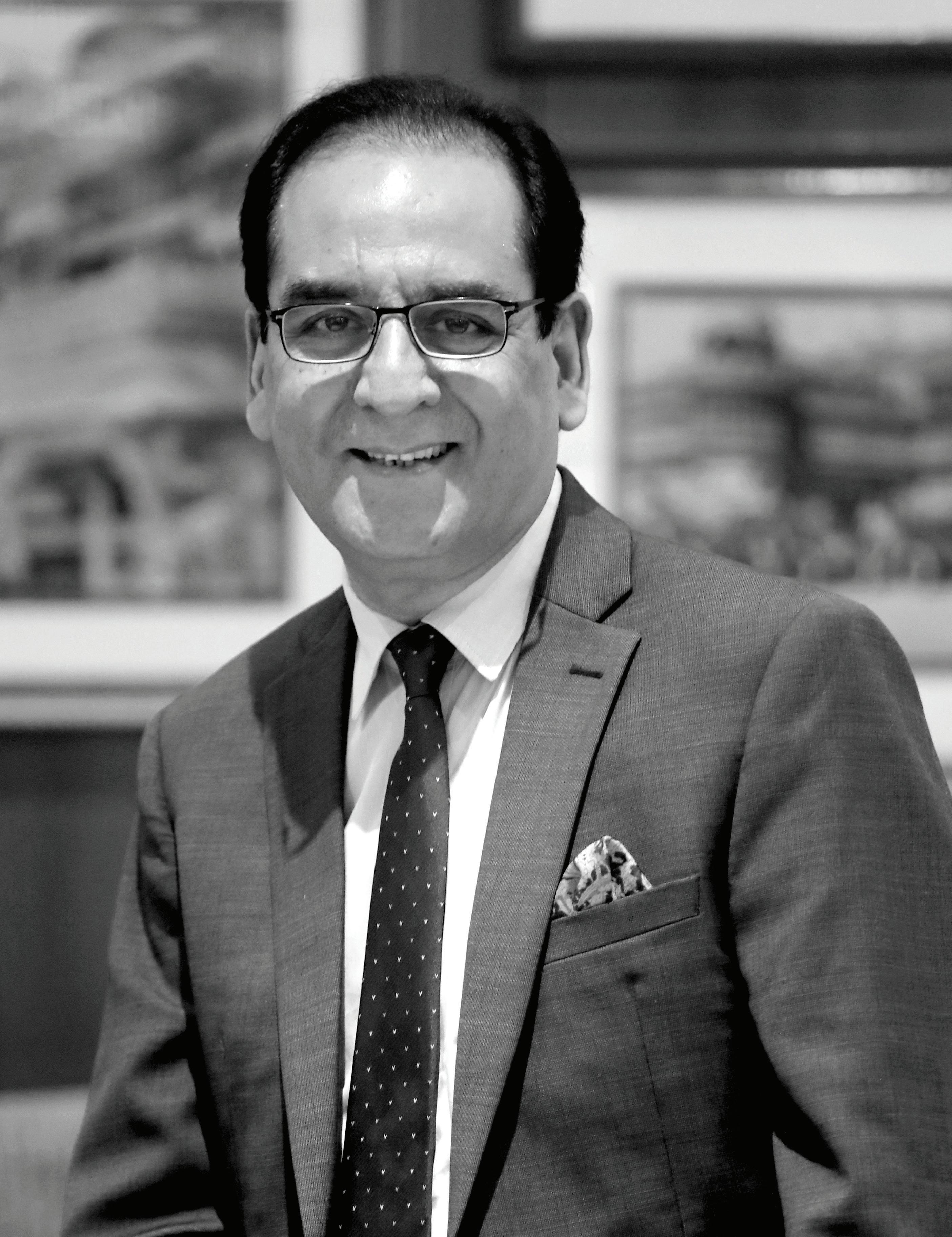


emphasis on road connectivity, including significant road projects and additional bridges, will improve access to tourism destinations, fostering greater tourist inflow.
The tweaks that will turbocharge
However, the needle can move faster if industry-specific requests for tweaking and execution of existing policies are monitored by all stakeholders. The hospitality sector has long sought the rationalisation of taxes and improved access to finance for MSMEs. The restructuring of indirect taxes, especially the reduction of GST on hotel tariffs and restaurant services, has been a significant demand. The
recent simplification of GST and the comprehensive review of the Income Tax Act have offered new hope to the tourism and hospitality sectors. Hopefully, the tax benefits provided to individuals will enhance spending power, further boosting domestic tourism.
Being a people-centric industry with immense potential for job creation, the government's continued investment in skill development will be crucial for the sector's growth, providing direct and indirect employment opportunities. The potential to create 50 million new jobs in the next five to seven years underscores the sector's significance in India's economic
landscape. Focus will be required on incentivising employers to create jobs.
To achieve this, investors need to be identified and motivated to build hospitality infrastructure. The new destinations will only take off, provided hotels and entertainment zones are established. This would be a significant step towards addressing the unemployment issues. Skill development will ensure the delivery of high-quality services and experiences to visitors.
The government has to walk the talk by facilitating Institutional investors to work with state governments to execute investor-


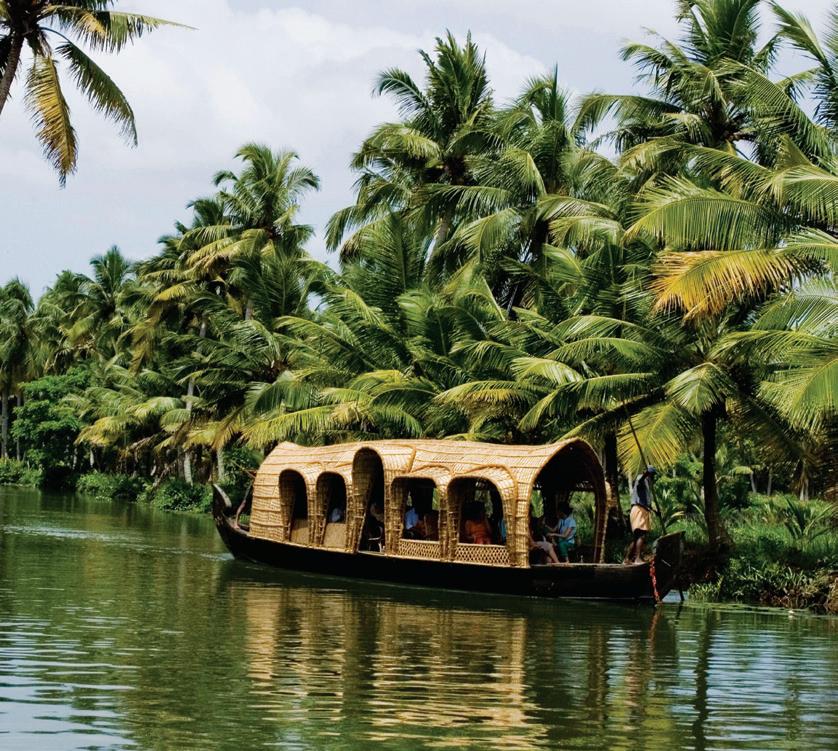
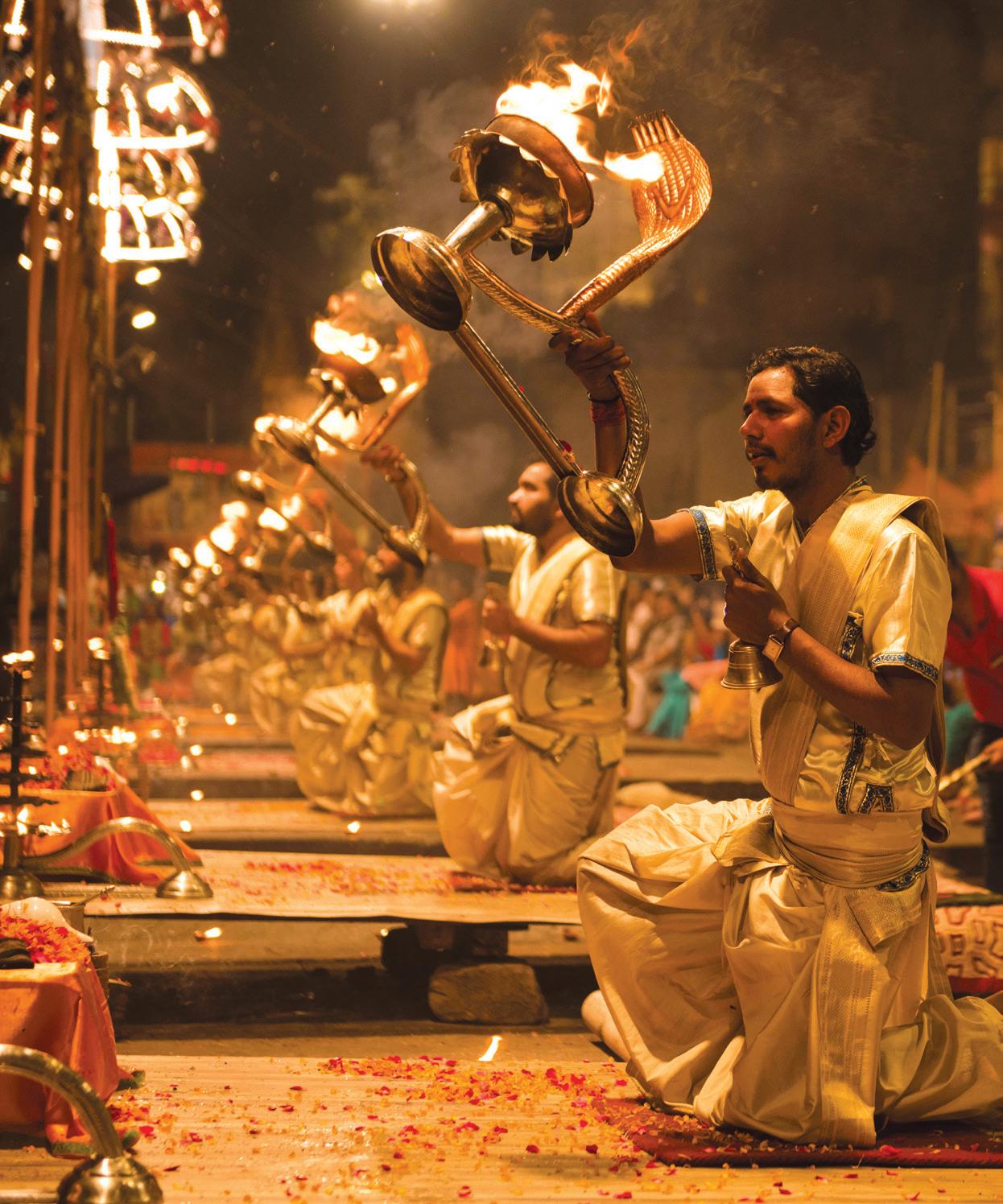
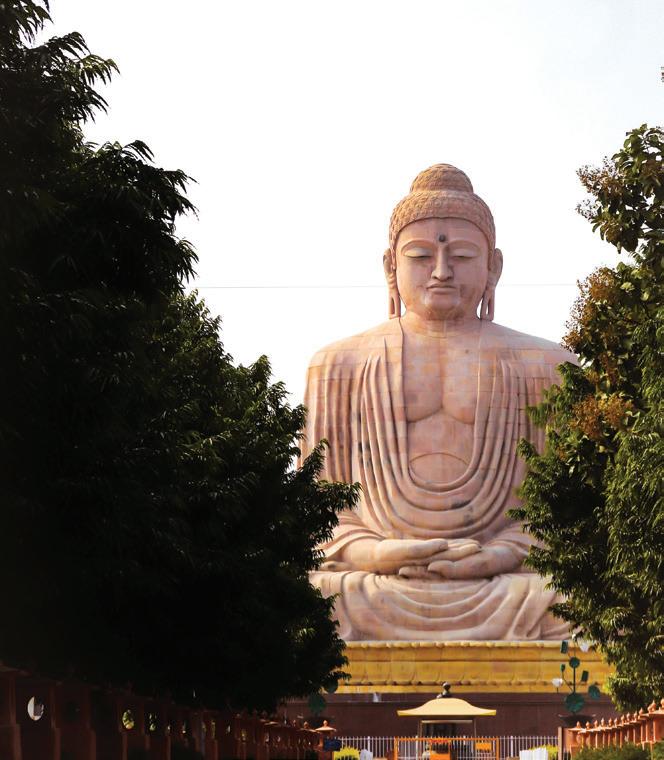
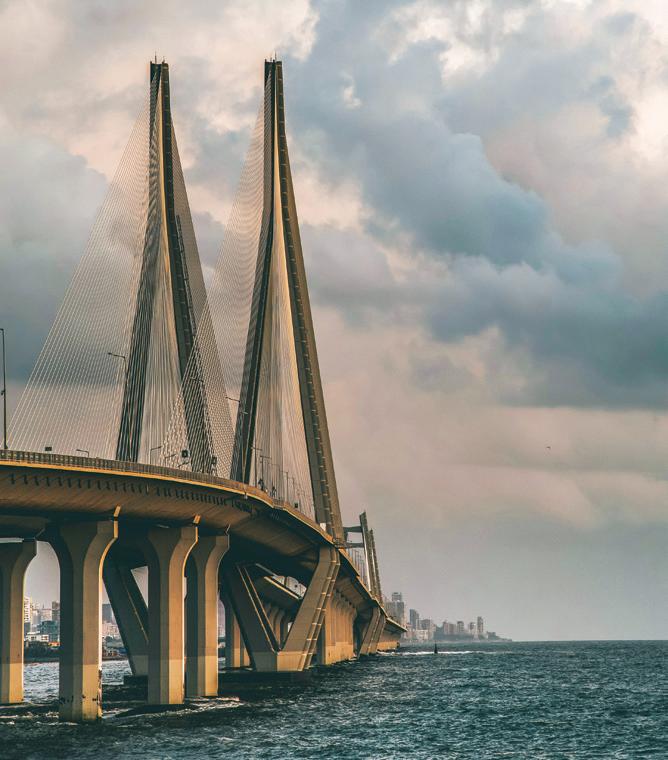
friendly policies. Some states have announced hospitality as an industry, but the results have been rather poor. While there is a great start for identifying new destinations and connectivity efforts in the budget, the industry would continue with its ask for granting infrastructure status for the hospitality sector. Industryrelated benefits by all state governments, adopting best practices and recognising hotels as infrastructure, similar to highways and ports, is essential to fully expedite the growth.
Providing hotel benefits akin to those for manufacturing industries, such as reduced property taxes and easier access to finance, can greatly enhance investment appeal and shorten the development period for hotel projects. Streamlining
the approval process through a single-window system will also boost efficiency and attract investment. Furthermore, the industry anticipates a reduction of the current 18% GST rate to a more globally competitive 12% to improve the global competitiveness of Indian hotels.
The potential of inbound international tourism is immense but requires strategic focus.
Complementing the above developments, India needs a wellcurated marketing and promotion plan in key source markets, particularly in the Asia Pacific region, given that international travel is becoming more regional. Incentivising travel through hasslefree and complimentary visas,
similar to strategies employed by other countries wooing Indian travellers, could help position India as an attractive, cost-effective destination in the eyes of regional travellers.
With the significant contribution that the tourism industry makes to the country’s GDP, substantial investments and a focused plan are essential to ensure parallel growth. We wish the Union Budget 2024-25 had allocated more money to attract international/ inbound tourism. This would certainly be a progressive step towards making a mark of tourism on the global map along with a definite focus on infrastructure, tax reforms, and skill development.
K.B. Kachru, Chairman, Radisson Hotel Group South Asia & President –Hotel Association of India (HAI)



The burgeoning desi middle class has had its aspirations unleashed and is ready to travel often. Is the sector ready?
SUMAN TARAFDAR
In the autumn of 2021, as COVID-19 was disappearing in our rearview mirror, I was invited to one of India’s top luxury resorts. The hospitality sector had been on its knees for 18-odd months, with fear compounded by travel restrictions almost putting it on a ventilator.
The general manager of this particular resort, part of a global chain, in the process of putting together his budget for the coming year, was particularly harried. He was at a loss about predictions for the coming year. “Before COVID, more than 90% of my guests were inbound—and from the time the resort opened about two decades ago, now 100% are domestic, and I have no idea how the ratio is going to be for the coming year.”
Well, as it turned out, while the share of inbound tourists has re-risen for the resort, it is now equally split between inbound and domestic tourists. A massive increase for a resort whose per-day charges can top a lakh in high season. Yes, the trend spanned the sector—across the price range.

The precipitous drop during Covid was followed by a more than expected recovery for the travel and hospitality industries, globally and in India. Global travel market research provider Phocuswright reported that after nearly collapsing due to COVID-related shutdowns and restrictions in 2020 and 2021, India’s travel market witnessed a strong rebound in 2022, mentioning that gross bookings for the Indian travel market grew 72% to $33.2 billion in 2022, ultimately surpassing pre-pandemic totals.
According to MakeMyTrip’s report on Indian Travel Trends 2023-24, travel sentiment touched an all-time high in November 2022, with seven out of ten planning travel. Booking.com’s insights reinforce this, with 85% of Indian travellers revealing that “they feel more alive and become their best version when on vacation”.
Data platform Statista predicts that domestic expenditure on tourism in the country will reach its highest levels ever in 2024. In the previous decade, even as the absolute tourism pie grew exponentially in India, the share of domestic spending on tourism has only increased, from 80.7% in 2013 to 88.4% in 2022 (In 2021, it even reached 94% but that is a COVID related anomaly).
India is getting closer to the global average of about 80% of travel being domestic (the share for OECD countries is about 75%).
The World Travel and Tourism Council (WTTC) calculated that tourism generated ₹13.2 lakh crore (US$160 billion) or 5.8% of India’s GDP and supported 32.1 million jobs in 2021. Statista predicts the share of domestic tourism to (delete) will reach 90% by 2028 in India. According to Booking.com, Indian domestic tourist spending was $175 billion last year, an increase of 15% from pre-Covid levels.
A report released earlier this year by consulting firm McKinsey and Company predicted that India will become the fourth-largest

domestic travel market in terms of spending by 2030, up from sixth. Whichever way one looks at it, it's a significant pie to stake claim to.
According to Booking.com’s How India Travels report, India’s total travel expenditure across domestic and international trips is projected to grow from $150 billion in 2019 to $410 billion in 2030, highlighting the appetite for travel and exploring domestic destinations. “Driving this rise in domestic travel is a growing middle-class, young population, increasing disposable incomes and shifting preferences among Indian travellers to venture to new and lesser-known destinations and seek deeper connections on their journeys,” says Santosh Kumar, Country Manager for India, Sri Lanka, Maldives, and Indonesia at Booking.com.
Improved flight connectivity, and the launch of new airports across Tier 2 and Tier 3 cities, besides investments in infrastructure and various tourism initiatives by the government, have contributed to making domestic travel even more appealing.
The market shifts
In select markets, the changes have been dramatic. Goa, once a favourite with inbound travellers, is seeing a remarkable shift. While in 2017, 11% of total tourists were inbound or international tourists, in 2023, the share fell to 1%! While visitor numbers in the same period rose from 6.9 million
to 8.2 million, in absolute terms, the number of inbound tourists fell from .89 million to .45 million.
The number of charter flights, once the mainstay of Goa tourism, fell from 1,024 to 356. For better or worse (overtourism is a concern in parts of the destination), unless trends change again, the travel and hospitality sectors in Goa will have to be more in tune with what the domestic traveller wants.
According to Statista, there are 677 million domestic tourists in the country.
“Domestic travel has grown on the back of both leisure and business-related demand,” points out Achin Khanna, Managing

COUNTRY MANAGER FOR INDIA, SRI LANKA, MALDIVES, AND INDONESIA AT BOOKING.COM
“Driving the rise in domestic travel is a growing middleclass, a young population, increasing disposable incomes, and shifting preferences among Indian travellers to venture to new and lesser-known destinations, and seek deeper connections on their journeys.”

Partner, Hotelivate, a hospitality consulting firm. “The macro-economic environment has been robust and business travel has resurged as a result. Equally, the continued growth of India’s upper middle class has boded well for leisure travel. India’s improved connectivity by road has been an additional catalyst.”
Vijay Thacker, Managing Director of Horwath HTL India, says that India, which had a restricted supply of leisure destinations, has begun adding capacity across newer destinations before COVID. “Strong demand at these destinations fructified during the pandemic, with the destinations benefitting strongly because of the COVID-induced demand when people could not go abroad. Also, the development of quality supply has been one of the factors why these newer destinations have taken off. Besides weddings, the growth of social travel with people celebrating smaller and greater milestones and achievements has taken off in a big way—this is a gain from an attitudinal change that’s come out of COVID.” Even if Indians return to travelling abroad at pre-COVID levels, he says, “The overall quantum of travellers continues to grow so that occupancy levels will sustain well”.
Hotel-full!
The cyclical nature of Indian hospitality has been evident for decades, but is the era of sustained growth? Just about every major hospitality chain is on a growth path—opening new hotels, record signings, expansion to new destinations—even as rates are at a record high. Earlier this year just about every global hospitality brand leader and their India country heads were at pains to outline their growth path in the country—and how to hasten it further.

MANAGING DIRECTOR OF HORWATH HTL INDIA
“Besides weddings, the growth of social travel with people celebrating smaller and greater milestones and achievements has taken off in a big way—this is a gain from an attitudinal change that’s come out of COVID.”
BY
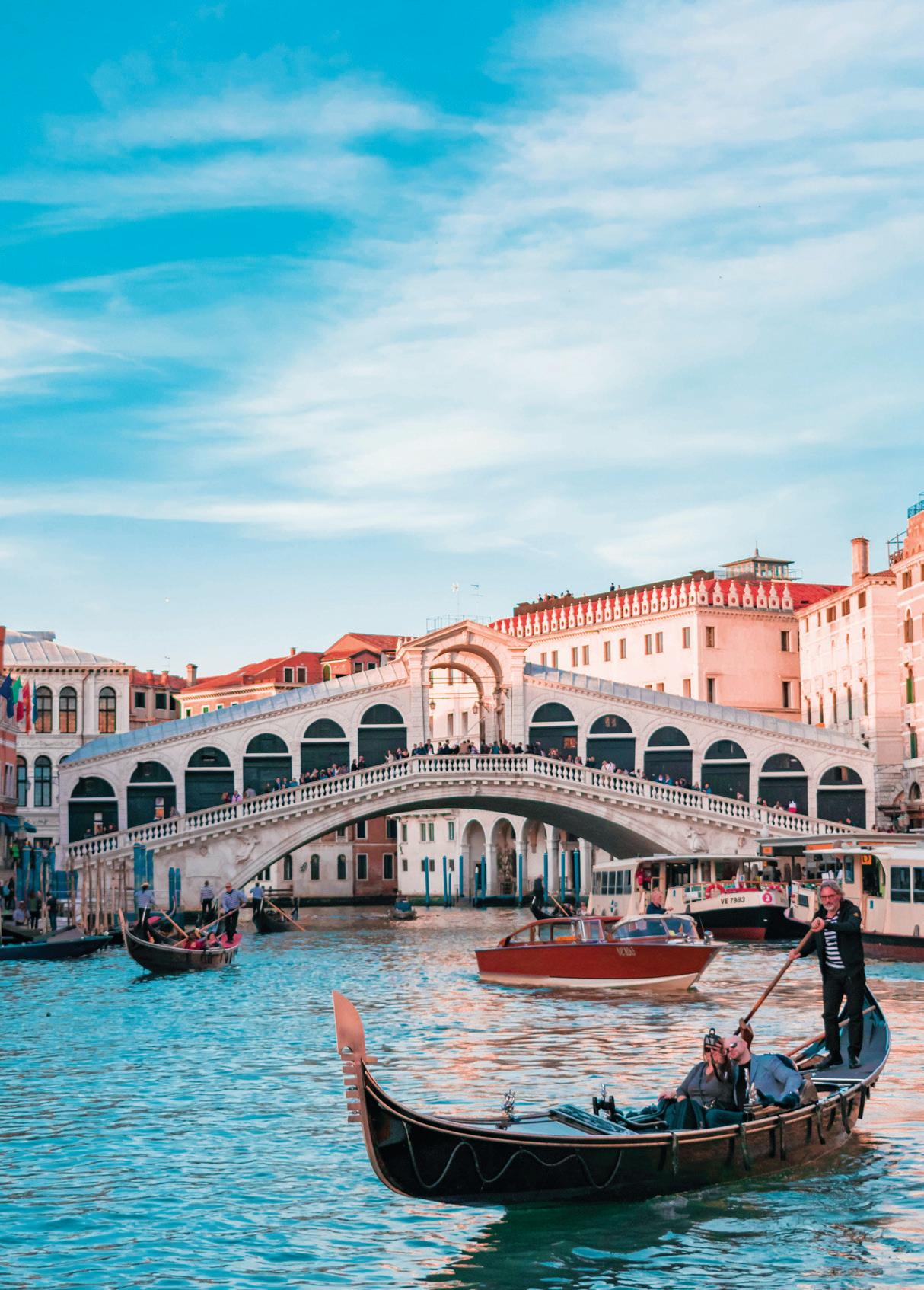
FROM APRIL 25 TO JULY 14, VENICE CHARGED DAYTRIPPERS ACCESS TO THE CITY, A MOVE THAT HAS CAUSED HOWLS OF PROTEST. AROUND 2,800 ANTITOURISM PROTESTERS MARCHED IN BARCELONA ON JULY 6 TO PROTEST AGAINST MASS TOURISM THAILAND CLOSED KOH PHI PHI FOR NEARLY FOUR YEARS FROM 2018, CITING EXTENSIVE DAMAGE TO THE ISLANDS.
NEARER HOME, THE SUPREME COURT HAS REGULARLY RULED ON LAWS REGARDING WILDLIFE TOURISM, INCLUDING ONCE TAKING THE EXTREME STEP OF CLOSING ALL WILDLIFE SANCTUARIES, LEADING TO PROTESTS FROM THE SECTOR. IN APRIL THIS YEAR, THE COURT WARNED OF DANGER TO FORESTS AND WILDLIFE DUE TO ANIMAL-HUMAN CONFLICTS, EMPHASISING THE NEED FOR BALANCE.
BALANCE. THE INDIAN TOURISM SECTOR HAS LARGELY IGNORED THIS CONCEPT OFTEN IN PURSUANCE OF SHORT-TERM PROFITS. “THE BIGGEST NEED IN INDIA AT THE MOMENT IS TO IMPROVE DESTINATION MANAGEMENT,” SAYS VIJAY THACKER, MANAGING DIRECTOR OF HORWATH HTL INDIA THACKER. “OUR PRIME DESTINATIONS ARE GROWING IN AN UNPLANNED MANNER. THE SUPPLY BEING CREATED IS MORE THAN THE CAPACITY OF THOSE DESTINATIONS. BECAUSE OF THAT, THE DESTINATIONS ARE GETTING CROWDED, INFRASTRUCTURE IS FAILING, AND THE ACCESS INFRASTRUCTURE IS STRESSED. IN THE MEDIUM TO LONG TERM, YOU ARE SPOILING THE DESTINATION.”
THACKER POINTS TO GOA AS A PRIME EXAMPLE, WHICH NOTABLY IN ITS LATEST ‘PEAK SEASON’ I.E OCTOBER 2023 TO MARCH 2024, RECORDED LOWER THAN EXPECTED TOURIST NUMBERS AND REVENUE. “LOOK AT GOA? HASN’T IT GONE BEYOND ITS CAPACITY? LOOK AT THE KIND OF PRODUCTS THAT HAVE COME THERE, THE F&B THAT HAS COME THERE, THE KIND OF APPROACH TO IT—HOW MUCH OF ORIGINAL GOA IS LEFT IN TERMS OF THE AMBIENCE, THE ATTITUDE, THE CULTURE? THIS HAS TO BE AVOIDED. AND FOR THAT, THERE HAS TO BE AN ASPECT OF RESPONSIBLE TOURISM. YOU HAVE TO CONSIDER IF YOU ARE BENEFITING OR HARMING THE DESTINATION. THE QUESTION OF CARRYING CAPACITY CANNOT BE ADDRESSED BY JUST THE PRIVATE SECTOR. THE GOVERNMENT SEEMS TO BE ABSENT ON THIS FRONT.”
AHEAD OF IMPLEMENTING THE €5 FEE, VENICE MAYOR LUIGI BRUGNARO HAD SAID, “THE OBJECTIVE IS NOT TO CLOSE THE CITY, BUT NOT LET IT EXPLODE.” WHETHER THE STAKEHOLDERS IN INDIAN TOURISM WILL ESCHEW THE CURRENT LOW-HANGING FRUIT OF RAPID EXPANSION TO BUILD FOR A LONGER TERM IS ANYONE’S GUESS.

EXECUTIVE VICE PRESIDENT –COMMERCIAL, IHCL
“Post-pandemic, domestic tourism has driven the recovery for the Indian travel industry, constituting almost 80% of the total demand at our hotels.”

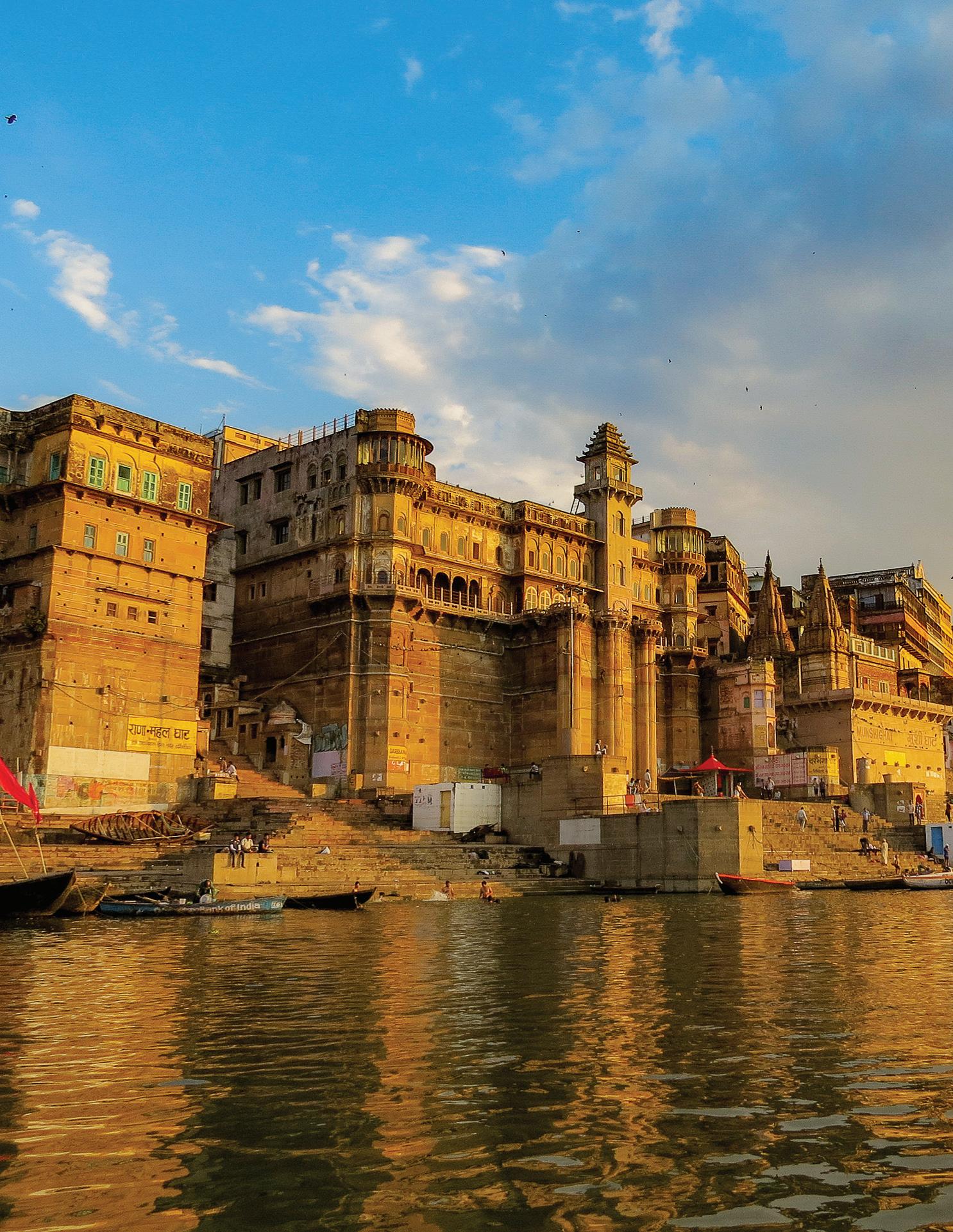
The Indian hospitality sector’s unexpectedly rapid recovery has seen the mood turn from despondence to confidence. “Post-pandemic, domestic tourism has driven the recovery for the travel industry, constituting almost 80% of the total demand at our hotels,” points out Parveen Chander Kumar, Executive Vice President – Commercial, IHCL. “This growth is fuelled by a rapidly expanding middle class leading to a significant increase in domestic air passenger traffic.”
Hotels are gearing up to deal with the demands of domestic tourists. “Our hotels across the country deliver authentic experiences through local cuisines, architecture and decor, and specialised staff are trained to ensure culturally sensitive and high-quality service,” says Nikhil Sharma, Managing Director and Area Senior Vice President – South Asia, Radisson Hotel Group. “We are strategically expanding our presence every four hours of drivable distance. The aim is to reduce this to two hours by penetrating deeper into Tier 3 or Tier 4 regions, and our recent signings in cities such as Raipur, Sonamarg, Sonipat, Dera Bassi, Kevadia, Jhansi, Gopalpur, Saputara, and Dhanbad reflect this strategy.” Radisson, one of the fastest-growing hospitality brands in the country already has 180+ hotels in the country, including those under development.
BY

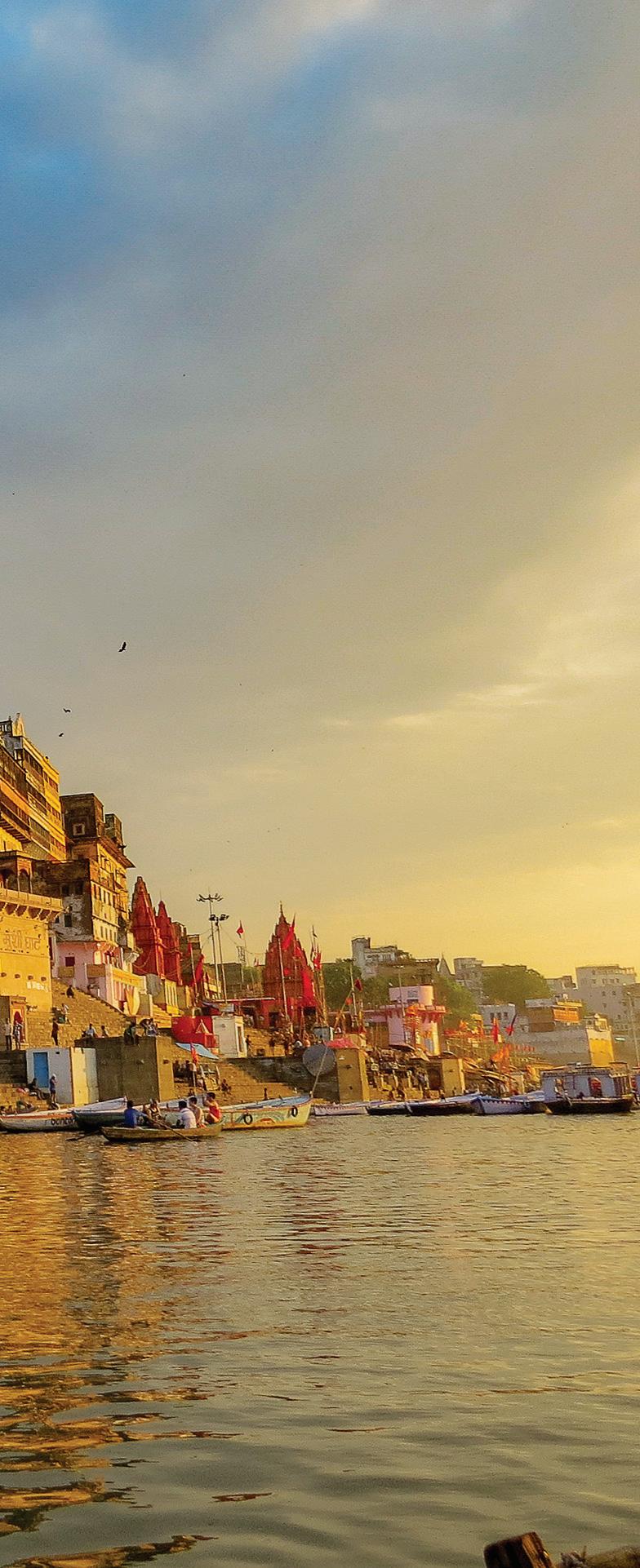
Given the vast size and diversity of the country, it is perhaps not a surprise that almost 9/10ths of travel is domestic. However, hotels, particularly at the luxury end, have long been focused on the inbound traveller. Arguably, earlier this tourist had greater spending capacity and opted for a lot of add-ons that hotels had to offer.
Today, those at the helm of hotels suggest there is a lot for experiential spending by the domestic traveller as well, and destinations that were once just for ‘the season’ are now year-
OPPOSITE BOTTOM: Shanti Stupa, Ladakh, has become a popular tourist attraction as it affords panoramic views of the surrounding landscape.
LEFT: The ghats of Varanasi are the mainstay of the city's religious tourism.
Source: Statista Market Insights
long destinations. Goa and the Himalayas top this trend. Where once an evening stroll down the Baga-Calangute, Goa’s most frequented tourist stretch would have been accompanied by strains of jazz and Western music, today Bollywood numbers dominate. Pre-COVID, Rajasthan’s palace hotels or even that equivalent to The Best Exotic Marigold Hotel prioritised the sahebs and served up pasta, bacon rashers, and eggs benedict over dosas or parathas, the menu is much altered now.
Indian travellers are eager to travel, excited about novelty and willing to see newer, offbeat destinations, points out Kumar. “They have grown more discerning and experimental in what they want from a trip and are willing to try unique, authentic and immersive experiences.”
Hotels have begun to pay far more attention to domestic travellers. “IHCL, with its distinctive range of brands across segments, caters to a wide spectrum of domestic travellers,” explains IHCL’s Kumar. “Focus on offering experiential travel, premiumisation, and heightened brand consciousness helps meet the needs of our discerning clientele. Incorporating local culture and traditions into the guest experience, including regional cuisine, decor, and activities, resonates well with domestic travellers.”
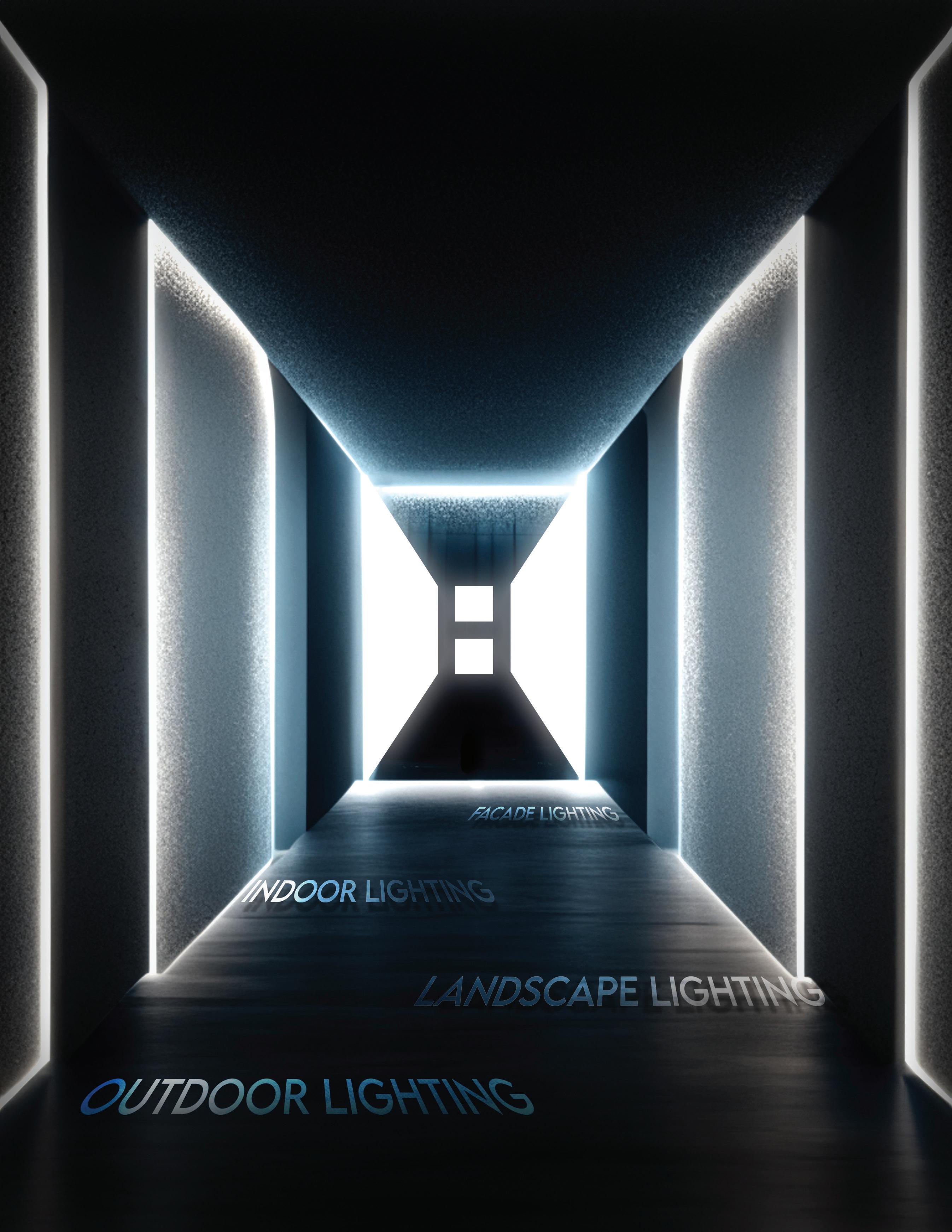
An alternate stay option that has had a growth spurt is staycations (see box). The homestay industry in India has been experiencing significant growth over the years, both on the demand and supply sides, driven by a surge in domestic, outbound and inbound travel,” points out Amanpreet Bajaj, Airbnb’s General Manager for India, Southeast Asia, Hong Kong and Taiwan. “We have supported over 85,000 jobs and contributed over $920M to India’s GDP between April 2022 and March 2023 (Oxford Economics Survey). We are working closely with the government in their vision to make India one of the most soughtafter tourist destinations in the world. We’ve partnered with the Ministry of Tourism and curated a dedicated microsite which spotlights heritage stays across India. We have also partnered with state governments in Goa, Madhya Pradesh, Uttarakhand, and Maharashtra, among others, to promote lesser-known destinations and conduct capacitybuilding workshops.”
A trend that was already visible pre-COVID of some hotels beginning to cater to differentiated
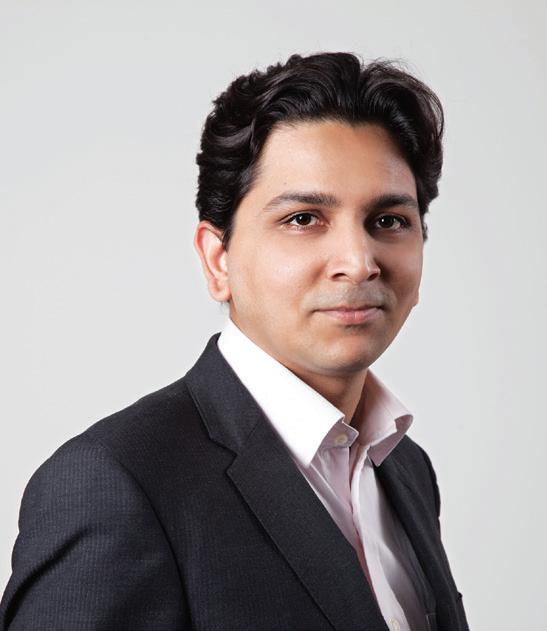
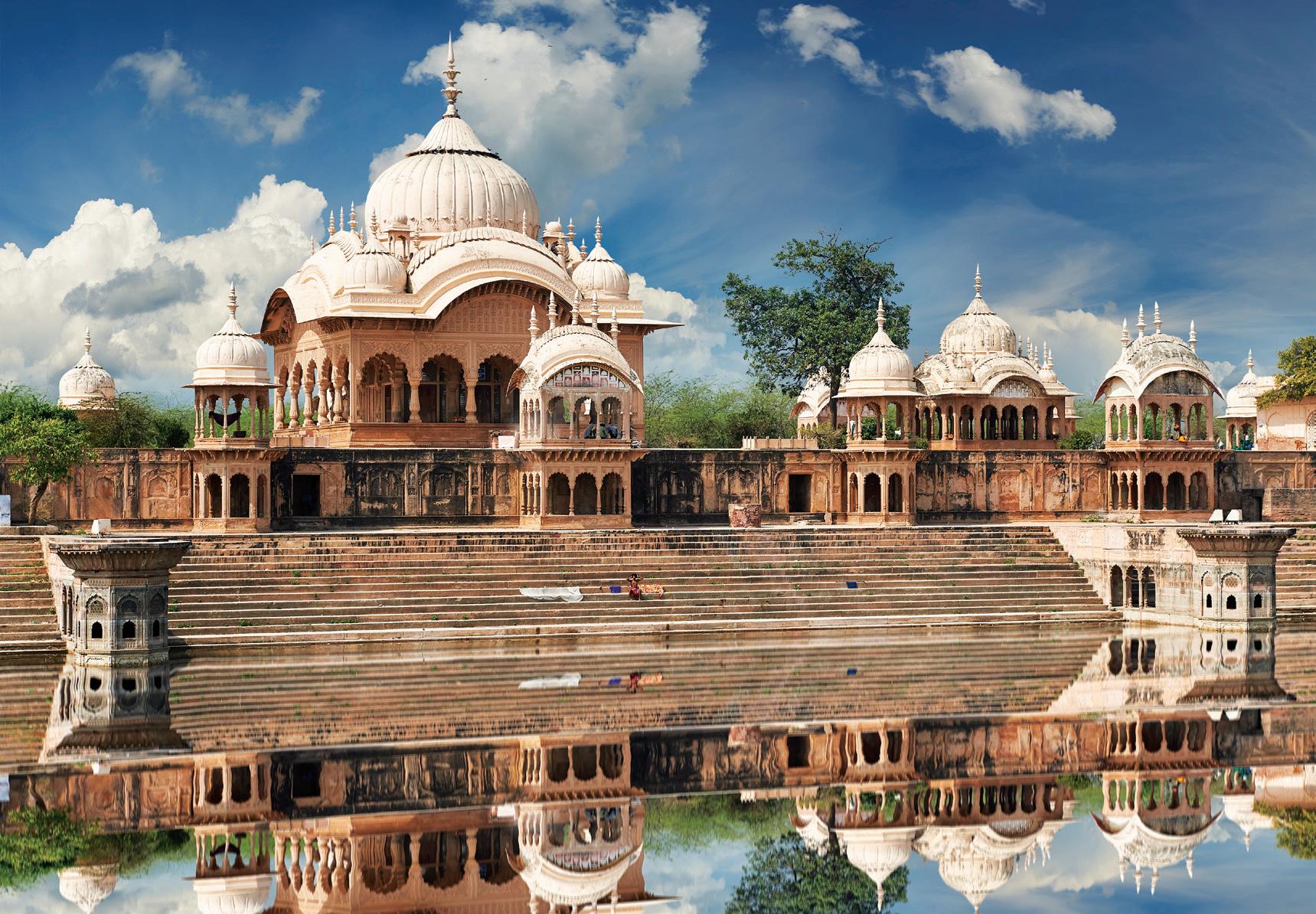
categories of tourists by aligning their services accordingly has only picked up pace.
As hotels experience a lag between the time they are planned and when they open, sometimes the gap sees changes in demand patterns. As business travel has struggled to match its share of tourist numbers, other segments such as leisure tourism, weddings and other social travel, wildlife, adventure, religious and even medical travel have seen a noticeable uptick, according to industry insiders.
“The fastest-growing segment of tourism for domestic tourists in India is leisure tourism,” says IHCL’s Kumar. “The younger generation perceives travel as a lifestyle necessity, driven by an increasing desire for short getaways, staycations, and experiential holidays. Higher disposable incomes and a strong desire to explore India’s cultural and geographical attractions have fuelled this growth. Other segments such as MICE, weddings, spiritual, and medical tourism also contribute significantly to the industry’s expansion.”
Kerala Tourism has also been making diligent efforts to dish out new offerings to cater to the experiential needs of new-age travellers, stresses Sikha Surendran IAS, Directorate of Tourism, Government of Kerala. “The emphasis on sustainable and experiential tourism,
MANAGING PARTNER, HOTELIVATE
“The macro-economic environment has been robust and business travel has resurged as a result. Equally, the continued growth of India’s upper middle class has boded well for leisure travel. India’s improved connectivity by road has been an additional catalyst.”

exploration of little-known places, and adventure-driven activities are the new selling points that are likely to appeal to the wanderlust travellers.” PostCOVID, Kerala has embarked upon new tourism initiatives that would make the state an all-weather welcoming destination catering to the taste and needs of all kinds of visitors, informs Surendran. “Alongside the new projects, the state’s core assets such as beaches, hill stations, houseboats and the famed backwater segment heighten the totality of the visitors’ experience.”
Launched in the post-COVID phase, Kerala’s trendsetting Caravan Tourism project, ‘Keralan
Kerala’, was conceived as a key component in the mix that will help define the future of the state’s fast-growing tourism sector, and is seeing positive traction. The Kerala government has also unveiled a tourism master plan ‘Mission 2030’ aimed at propelling the state’s GDP share from the current 12% to 20%. The plan primarily focuses on the strategic development of the travel and hospitality sectors.
Khanna is optimistic about growth across sectors. “Social MICE look promising. Corporate transient travel is the other large demand generator. Business travel to Tier 2 and Tier 3 destinations is the third major segment of growth. Transient leisure may grow at a slower pace for now. However, linear growth is likely in this segment as well.”
‘Pleisure’. Yes, with a p. That segment has grown rapidly in recent years. Religious tourism is expected to grow at 9 to 10% for the next five to seven years. According to MakeMyTrip’s report, spiritual tourism is leading growth for Tier 2 and Tier 3 cities.
Hitherto, many popular pilgrimage spots which once lacked accommodation above a certain level, have seen branded hotels (IHCL, UTC, Lemon Tree, Sarovar and Radisson have the lead here) open, and the pipeline indicates there is more to come.
“Pilgrim travel is growing materially. People are not going strictly
The size of the residential units at Taj Sky View Hotel and Residences, Chennai, ranges from 2,500 sq.ft. to 5,900 sq.ft. Being developed by Ampa Group, the project has created quite a buzz in the Chennai market.
Source: Statista 2024
RIGHT: A fort in Rajasthan. Their formidable presence is a constant reminder of the state's historic past.
OPPOSITE TOP: The rugged beauty of Leh beckons many a visitor.
OPPOSITE BOTTOM: Nearly 30% of Indian travellers would like to visit a wellness retreat.
for a pilgrimage and back, they are combining pilgrimages and leisure,” points out Thacker. And with the benefit of having a new supply of better standards and quality at the pilgrim destinations, the propensity for pilgrimage-induced travel is starting to grow.” In the first half of this year, we witnessed Indian travellers keen to prioritise their wellbeing by visiting several spiritual and wellness destinations, adds Kumar. “As per our mid-year Travel Trends Insights for 2024, Varanasi topped the list of most searched spiritual destinations in India followed by Rishikesh, Puri, Amritsar and Haridwar.”
“We are focused on addressing the needs of spiritual tourists with hotels in Ayodhya, Jammu, Amritsar, and Varanasi with new openings coming up in Vrindavan and Ujjain,” points out Sharma. Katra, Shirdi and Tirupati have seen brands enter., Ayodhya, which, as per official reports, already gets 10 million visitors annually, has a significant pipeline of hotels.
When viewed from a medium-term lens, infrastructure has steadily been improving across the nation, says Khanna. “Rail, road and air connectivity have shown considerable enhancement in recent years. That being said, global tourist markets in several developed nations continue to outpace our offering significantly. The good news is that we are steadily improving and are in the right direction.”
MakeMyTrip’s report mentions infrastructure improvement and better connectivity have led to 30% growth in 16 emerging tourist destination cities. The number of people taking three trips a year has grown by 25% in 2023 compared to 2019.
The union government has heavily invested in infrastructure to promote tourism; many schemes and initiatives that help increase connectivity, improve access and provide multiple accommodation options across the country have been launched to transform India into an attractive destination, underscores Booking.com’s Kumar. “Moreover, initiatives such as DigiYatra have eased travel for citizens and allowed authorities to manage traveller volumes more efficiently. There is a growing interest among international travellers for experiences that combine leisure travel, religious exploration, wellness and immersive local experiences.”
However, India has some way to go to establish a world-class tourism infrastructure. The World Economic Forum’s Travel and Tourism Development Index 2024 ranked India 39th globally. Thacker wants a greater focus on infrastructure. “I think we need much more infrastructure, whether it’s our airports and their capacity, the facilities at the airports, local transportation, whether it’s renewable energy, adequacy of water or treatment of water.”
Then there’s the intangible aspect of travel that needs attention. Improving social infrastructure that involves educating people about how to deal with destinations is very important. For instance, Indians
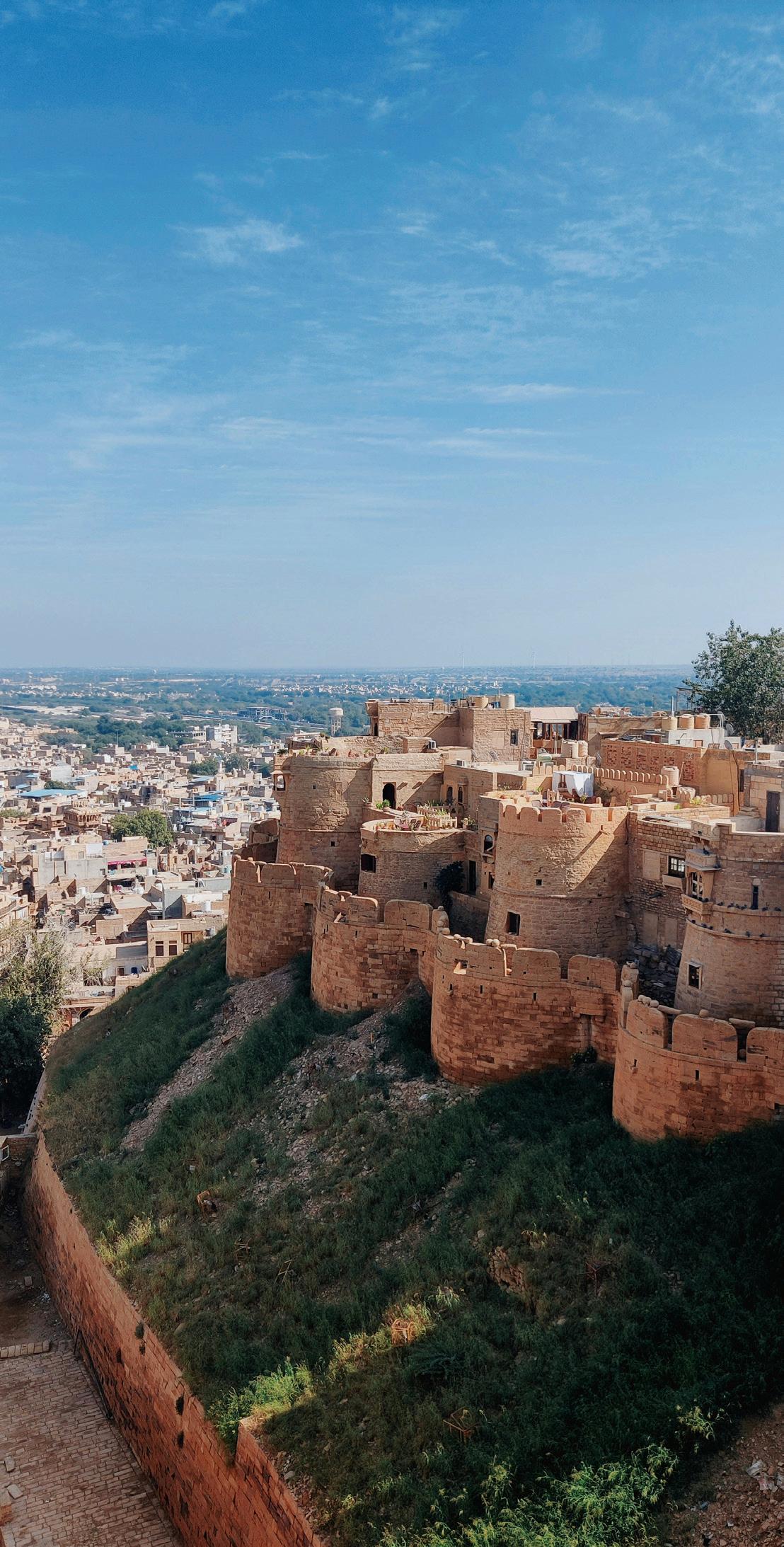
can’t step out of the house without wanting to eat something, and often eat when they are travelling to a destination, at the destination or on the way back. “We need to create a garbage collection and disposal infrastructure to deal with this. There can’t be just one or two wastebins when you are expecting 600 people. As a people, we are not conscious of respecting destinations, monuments, and even heritage. We need to tackle these tangible intangibles in a planned way rather than considering it to be somebody else’s problem.”


MANAGING DIRECTOR AND AREA
SENIOR VICE PRESIDENT – SOUTH ASIA, RADISSON HOTEL GROUP
“We are dedicated to meeting the growing interest in exploring domestic destinations by strategically expanding our presence every four hours of drivable distance.”
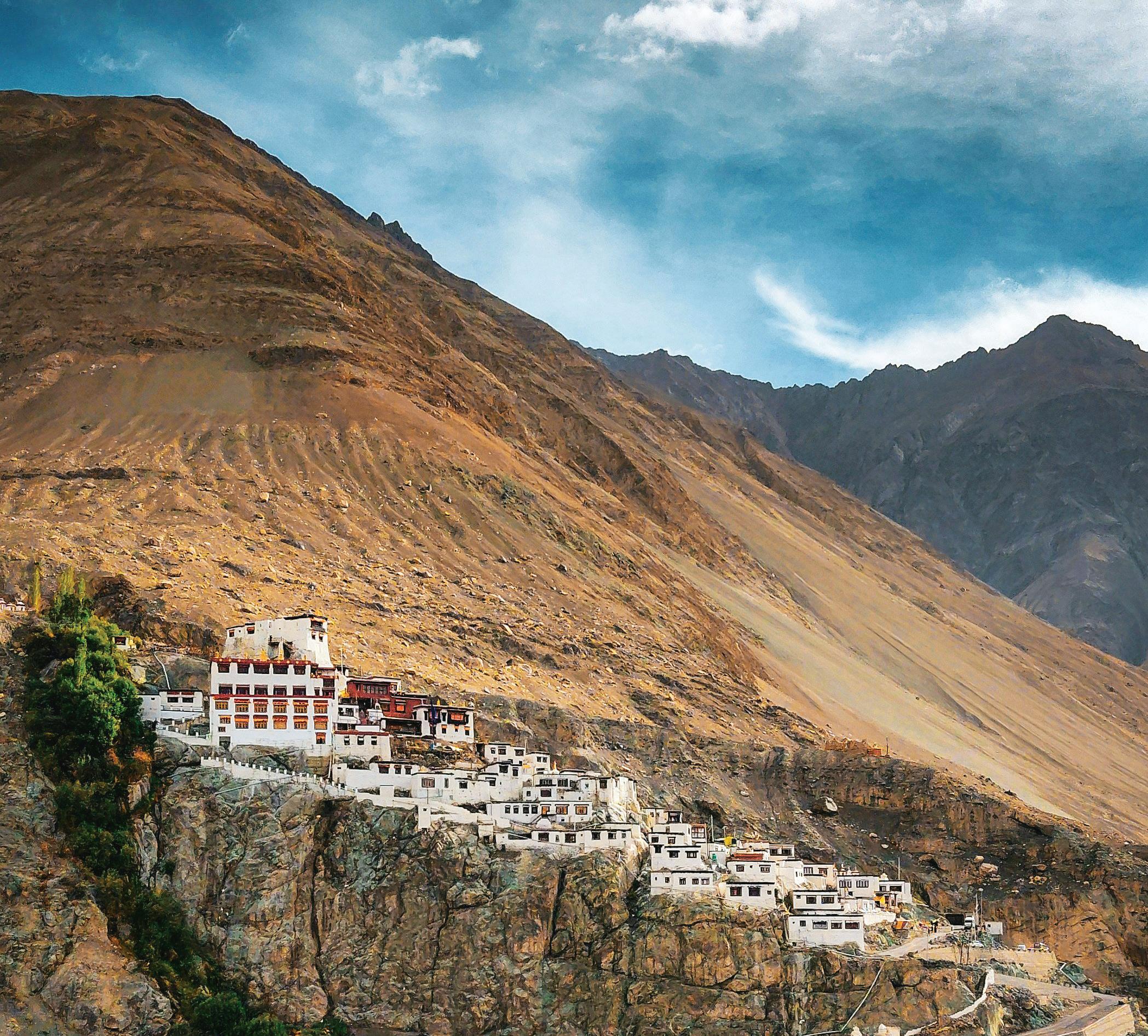
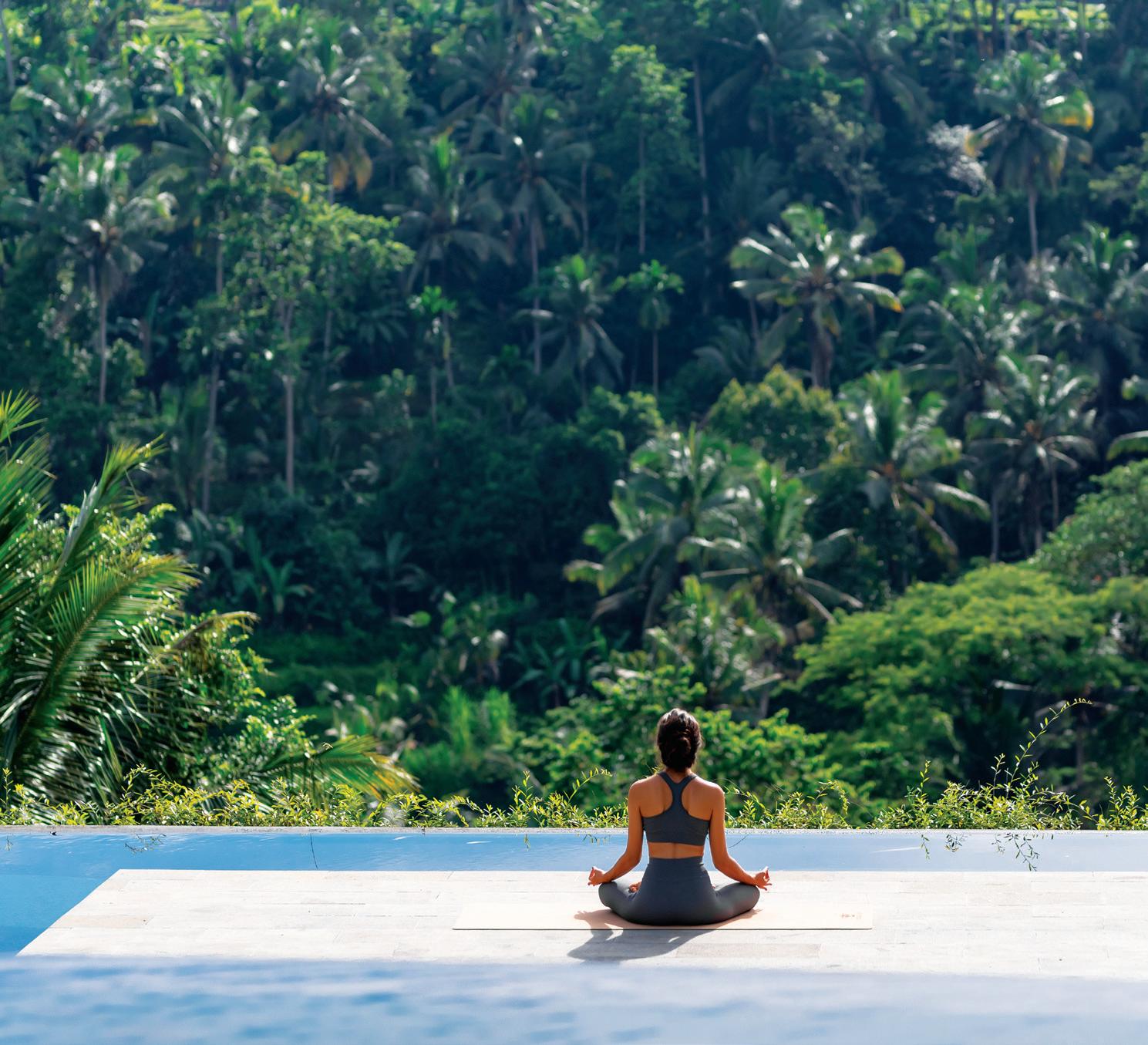
PERHAPS NOWHERE WITHIN THE TOURISM SECTOR DID THE CONTRADICTORY PULLS OF DESIRING TO TRAVEL AND THE NEED TO ISOLATE LEAD TO FASTER GROWTH THAN ONE SEGMENT—THE HOMESTAY SECTOR. STATISTA POINTS TO THE INCREASE IN STAYCATION AND WORKCATION TRENDS IN THE COUNTRY. ACCORDING TO MAKEMYTRIP’S REPORT, STAYCATIONS HAVE BECOME AN ACCEPTED WAY OF TAKING IMPULSE BREAKS. ALTERNATE ACCOMMODATIONS WITNESSED 24% GROWTH IN SEARCHES, THE REPORT SAID.
“THE HOMESTAY INDUSTRY IN INDIA HAS BEEN EXPERIENCING SIGNIFICANT GROWTH OVER THE YEARS ON THE DEMAND AND SUPPLY SIDES, DRIVEN BY A SURGE IN DOMESTIC, OUTBOUND AND INBOUND TRAVEL,” SAYS AMANPREET BAJAJ, Airbnb’s GENERAL MANAGER FOR INDIA. “IN 2023, Airbnb SAW A 30% YEAR-ON-YEAR GROWTH IN GROSS NIGHTS BOOKED IN INDIA COMPARED TO 2022. THIS GROWTH UNDERSCORES THE INCREASING POPULARITY OF HOMESTAY ACCOMMODATIONS AMONG INDIAN TRAVELLERS.”
CONTD ON THE NEXT PAGE
“WITH INDIA BEING THE YOUNGEST COUNTRY IN THE WORLD, BOASTING A MEDIAN AGE OF 29 YEARS, THERE IS A STRONG DEMAND FROM GEN ZS AND MILLENNIALS FOR UNIQUE AND PERSONALISED TRAVEL EXPERIENCES,” HE ELABORATES. “THIS DEMOGRAPHIC PREFERS TRAVEL OPTIONS THAT ALLOW THEM TO CONNECT DEEPLY WITH DESTINATIONS, WHETHER THEY ARE TRAVELLING WITH FAMILY OR FRIENDS. LEANING INTO THE TREND OF IMMERSIVE TRAVEL, PEOPLE ARE OPTING FOR ACCOMMODATIONS THAT ENABLE THEM TO BLEND IN WITH THE LOCAL CULTURE, AND NATURE. THEY ARE LOOKING BEYOND JUST AMENITIES AND ‘ROOM WITH A VIEW’ TO DISTINCTIVE SPACES AND ONE-OF-A-KIND STAYS SUCH AS TREEHOUSES, HOUSEBOATS AND FARM STAYS.”
BAJAJ POINTS OUT THAT COMMUNITYMINDED TRAVEL IS BEING FUELLED BY A TREND TOWARDS LESS EXPLORED DESTINATIONS AND THE EMERGENCE OF HOSTING-DRIVEN ENTREPRENEURSHIP IN REMOTE AREAS. ACCORDING TO THE RESEARCH COMMISSIONED BY Airbnb, AN OVERWHELMING 79% OF INDIAN TRAVELLERS EXPRESSED A DESIRE TO TRAVEL IN WAYS THAT POSITIVELY IMPACT LOCAL COMMUNITIES ECONOMICALLY AND SOCIALLY. “MORE THAN TWO-THIRDS OF THE INDIAN RESPONDENTS FEEL THAT CREATING A POSITIVE IMPACT ON THE LOCALS IS ESSENTIAL,” SAYS BAJAJ. “NOTABLY, OVER 60% OF INDIANS ARE CONSCIOUS OF THE NEED FOR ECONOMIC RECOVERY IN COMMUNITIES AND FACTOR THIS INTO THEIR TRAVEL DECISIONS AND SPENDING HABITS.”

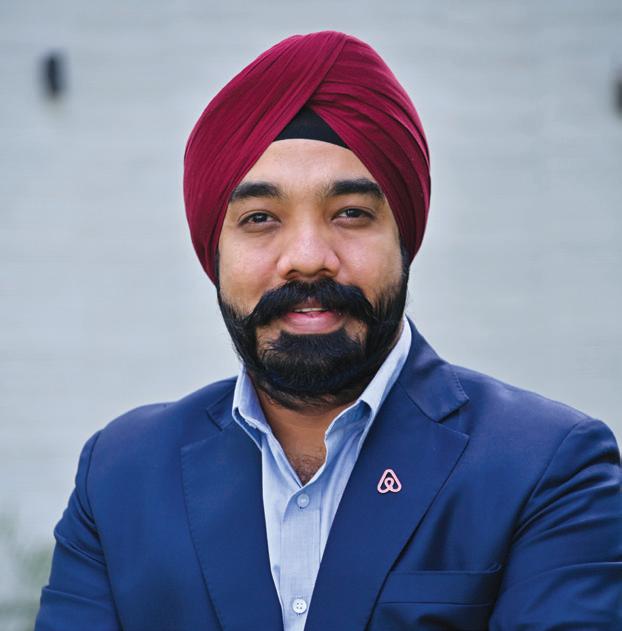
Airbnb’s GENERAL MANAGER FOR INDIA, SOUTHEAST ASIA, HONG KONG AND TAIWAN
Just how predictable the 2024-25 period will be remains a matter of conjecture, especially as hotel rates went through the roof. Thacker claims that rates will no longer rise at the pace they did in that period. “Rates have already grown substantially at the upper tier. They will largely hold and grow modestly for some time. Importantly, the vastly increased base level is very much here to stay. We are never going to go back to the old rates. There is demand strength across segments. The sector is also gaining from the fact that there are new destinations opening up and supply going outside the main markets, with people happy to go to the newer destinations.”
Domestic travel is likely to continue witnessing robust growth in the short to medium term, says Khanna. “The Indian economy is doing well and it is one of the few global big economies that are offering promise.
“The
homestay industry in India has been experiencing significant growth over the years, both on the demand and supply sides, driven by a surge in domestic, outbound and inbound travel.”

THIS SPREAD: While India’s beaches have been popular with domestic tourists, there is an increased demand for wildlife tourism.

IAS, DIRECTORATE OF TOURISM, GOVERNMENT OF KERALA
“The emphasis on sustainable and experiential tourism, exploration of little-known places, and adventure-driven activities are the new selling points that are likely to appeal to the wanderlust travellers.”
Leisure and MICE tourism is also likely to grow, albeit in a paced fashion.” MakeMyTrip’s report points out that Indians are investing more discretionary income on travel.
For Booking.com’s Kumar, growth drivers include the rise of spiritual tourism, destination weddings, resurgent MICE tourism, and expanding wildlife tourism, all contributing to new destinations and travel circuits. “Indians are increasingly seeking journeys to

self-improvement or a path leading them back to the life that they truly desire,” he says. “Nearly one-third (30%) of Indian travellers will like to visit a wellness retreat during their leisure travel or are looking to take a spiritual trip this year. Whether it’s finding solace (79%) or seeking an indigenous lifestyle (68%), Indian travellers are seeking immersive experiences that go beyond sightseeing to connect with their inner self.”
That Indians are travelling outside India more frequently is not a deterrent to the growth of domestic tourism. Khanna says that the lifting of travel restrictions is likely to see “some loss of opportunity. However, there is a significant amount of domestic tourism that continues to offer promise. While a few prominent leisure destinations will have to contend with this challenge, the overall pie is large enough to compensate for any such erosion”. Booking.com expects that by 2030, Indians will spend an impressive $410 billion, making the country the fourth largest global spender, with domestic travel accounting for 65% of these spends. “With a rising middle class (projected 6x growth in household income by 2030), 99% of trips booked by Indians are for domestic destinations, as a result of initiatives by the Indian Government to boost domestic travel, increased air connectivity and the rise of spiritual travel amongst others,” says Booking.com’s Kumar.
Atithi devo bhava with some better planning, then?
Tourism, whether domestic or inbound, for leisure or business, to beaches or jungles, in a group or solo—is a prime mover of society. India's tourism sector has shown buoyancy, but pre-pandemic levels remain elusive.
SUMAN TARAFDAR
India's tourism industry saw a significant resurgence in 2023, with foreign tourist arrivals (FTAs) surging 64% compared to the previous year. The trend continues in 2024. However, the industry is still not out of the woods, as the FTA figures remain 15.5% below pre-pandemic levels recorded in 2019. The data reveals Bangladesh as the top source of FTAs for most of 2023, with the US taking the lead in December. Delhi remained the most popular airport of entry, followed by Mumbai and Chennai.
Despite the ongoing recovery from the pandemic, India's travel and tourism market is projected to experience robust growth in the coming years. The figures paint an optimistic picture of India's travel and tourism industry's future, showcasing its potential to become a major economic powerhouse.
(in millions)
Source: Ministry of Tourism, GoI
TOP DOMESTIC TOURISM STATES IN INDIA
(in millions)
2022/23
Source: Ministry of Tourism, GoI
TOP INBOUND TOURISM STATES IN INDIA
(in millions)
Source: Ministry of Tourism, GoI
Despite the ongoing recovery from the pandemic, India's travel and tourism market is projected to experience robust growth in the coming years.
Here are some data points:
Foreign tourist arrivals (FTAs) in 2023 surged by 64% compared to 2022. This translates to 92,36,108 visitors between January and December 2023, compared to 64,37,467 in the same period of the previous year.
However, the number of FTAs remains 15.5% below pre-pandemic levels recorded in 2019.
Bangladesh was the top FTA source between January and November 2023, while the US occupied the top spot in December 2023.
Bangladesh, the US, UK, Australia and Canada were the top five source nations for FTAs to India in 2023.
Delhi was the most used airport of entry into the country in December 2023 with 30.29% of arrivals, followed by Mumbai (15.08%), Chennai (8.34%), Bengaluru (6.2%), and Hyderabad (6.2%).
PATA (Pacific Asia Travel Association) in its Asia Pacific Destination Forecasts 2022-2024: India report estimates FTAs in India to reach 13.34 million in 2024.
The travel & tourism market in India is expected to generate a revenue of $23.72bn in 2024.
(in millions)
Source: Bureau of Immigration, GoI
The projected annual growth rate (CAGR 2024-2028) of 9.62% is expected to result in a market volume of $34.25bn by 2028.
In WTTC’s Economic Impact 2023 report, India’s Travel and Tourism GDP contribution grew by 5.9%.
In 2021, the travel & tourism industry’s contribution to the GDP was US$ 178 billion; this is expected to reach US$ 512 billion by 2028, according to WTTC. By 2029, it is likely to account for about 53 million jobs. In India, the industry’s direct contribution to the GDP is expected to record an annual growth rate of 7-9% between 2019 and 2030.
The largest market in India is the package holidays market, which is expected to reach a market volume of $10.48bn in 2024.
By 2028, the number of users in the package holiday market is expected to amount to 64.74m users.
By 2028, online sales are expected to generate 60% of the total revenue in the travel & tourism market in India.
The travel market in India is projected to reach US$ 125 billion by FY27 from an estimated US$ 75 billion in FY20.
SOURCE: Ministry of Tourism, GoI; STATISTA; PATA; WTTC; IBEF
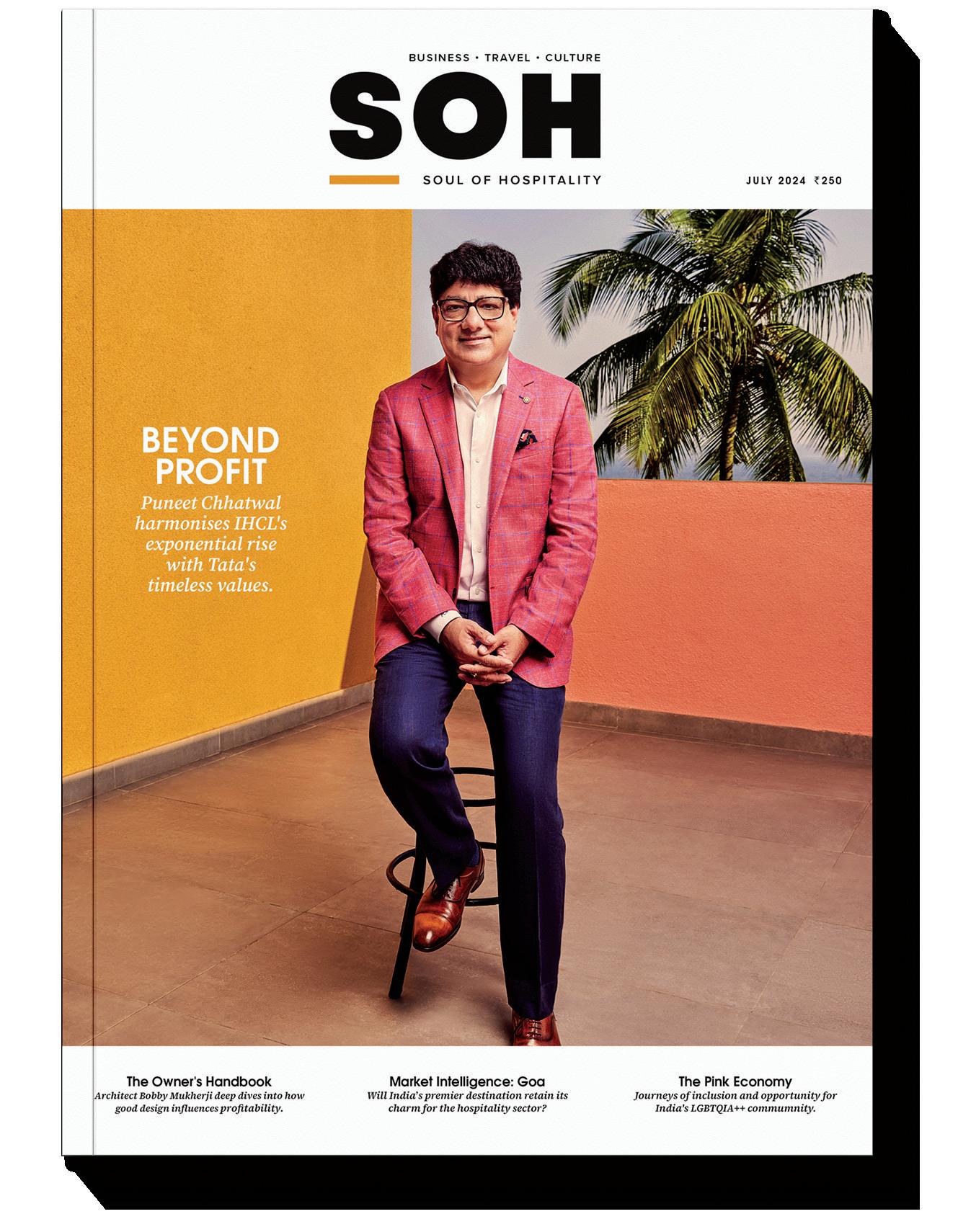

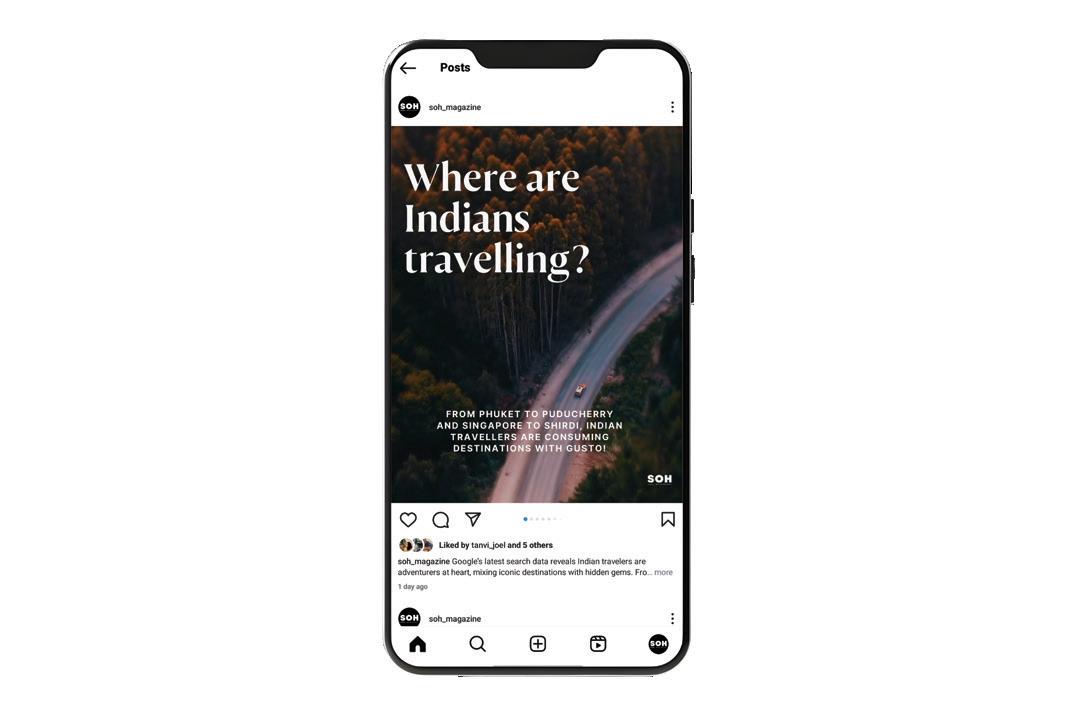

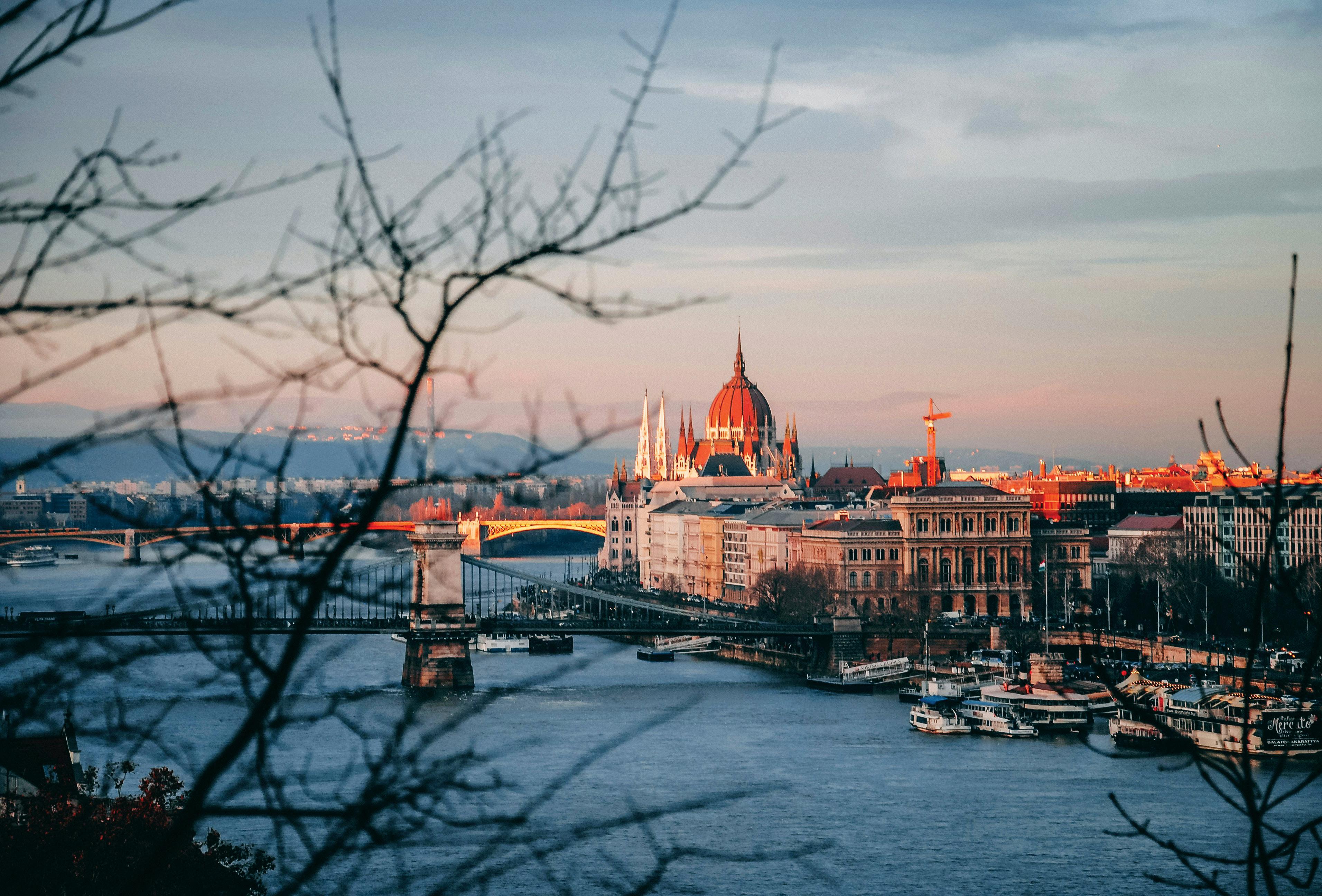
Fashion designer Manish Malhotra’s journey through global inspiration and cultural immersion takes him to striking international and Indian destinations.
AS TOLD TO DEEPALI NANDWANI

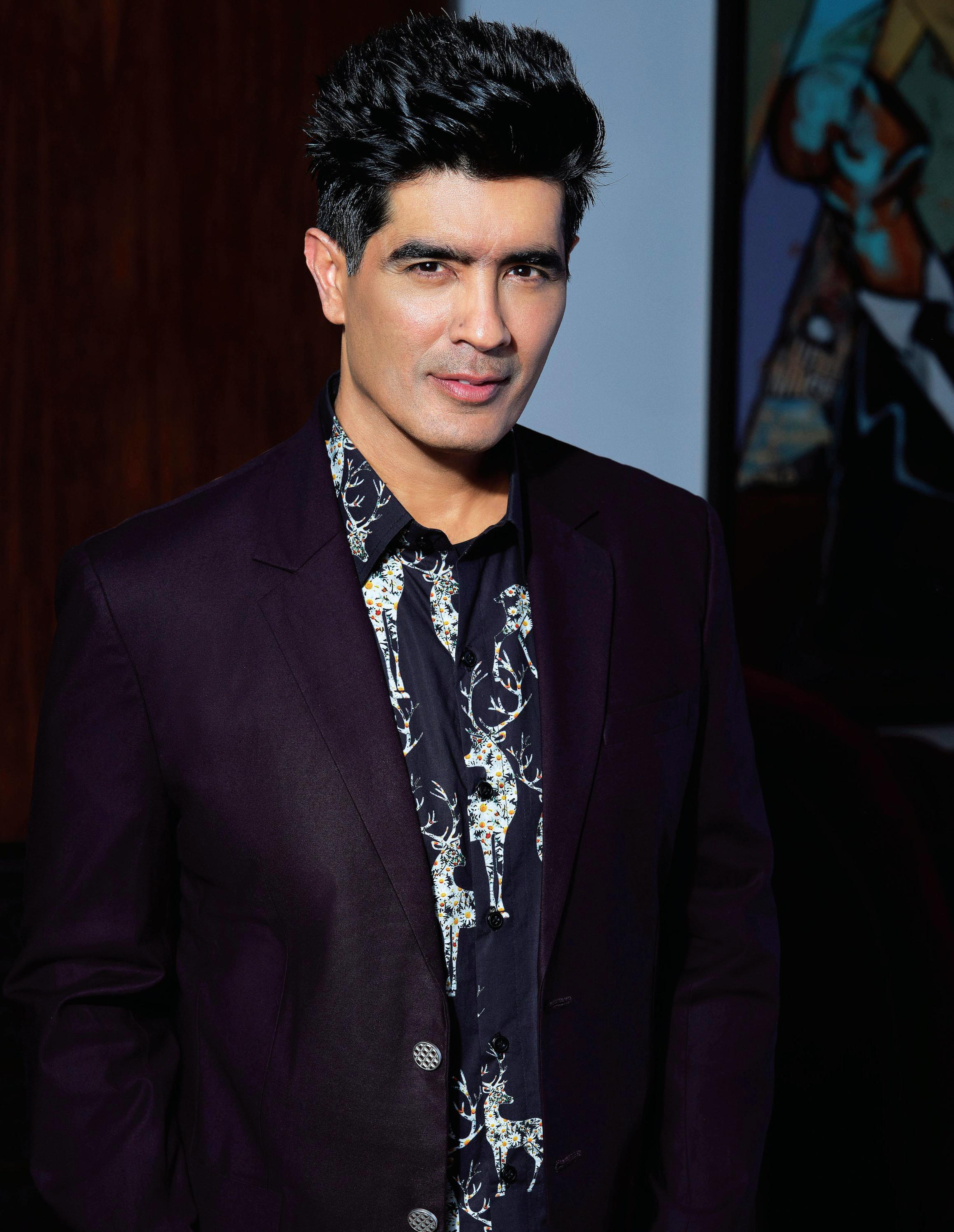
Destination weddings are all the rage, and I’ve crafted several in exotic locations: it’s not just Paris and Tuscany, it’s Budapest and Marrakech and Phuket. What’s an additional short flight when you’re creating a once-in-lifetime extravaganza? I also shot a bridal fashion spread for Vogue at the renowned Le Bristol hotel in Paris, which even hosted attendees of the Paris Olympics. The always buzzing Le Bristol is a 200-year fashion-forward hotel, which features Epicure, a 3-Michelin Star hotel.
I love morning flights; I feel the most alive when flying out early mornings. I am a keen observer. Inspiration is everywhere—in nature, architecture, people going about their lives, a piece of art, an intricately decorated home, from my travels abroad or across our country.
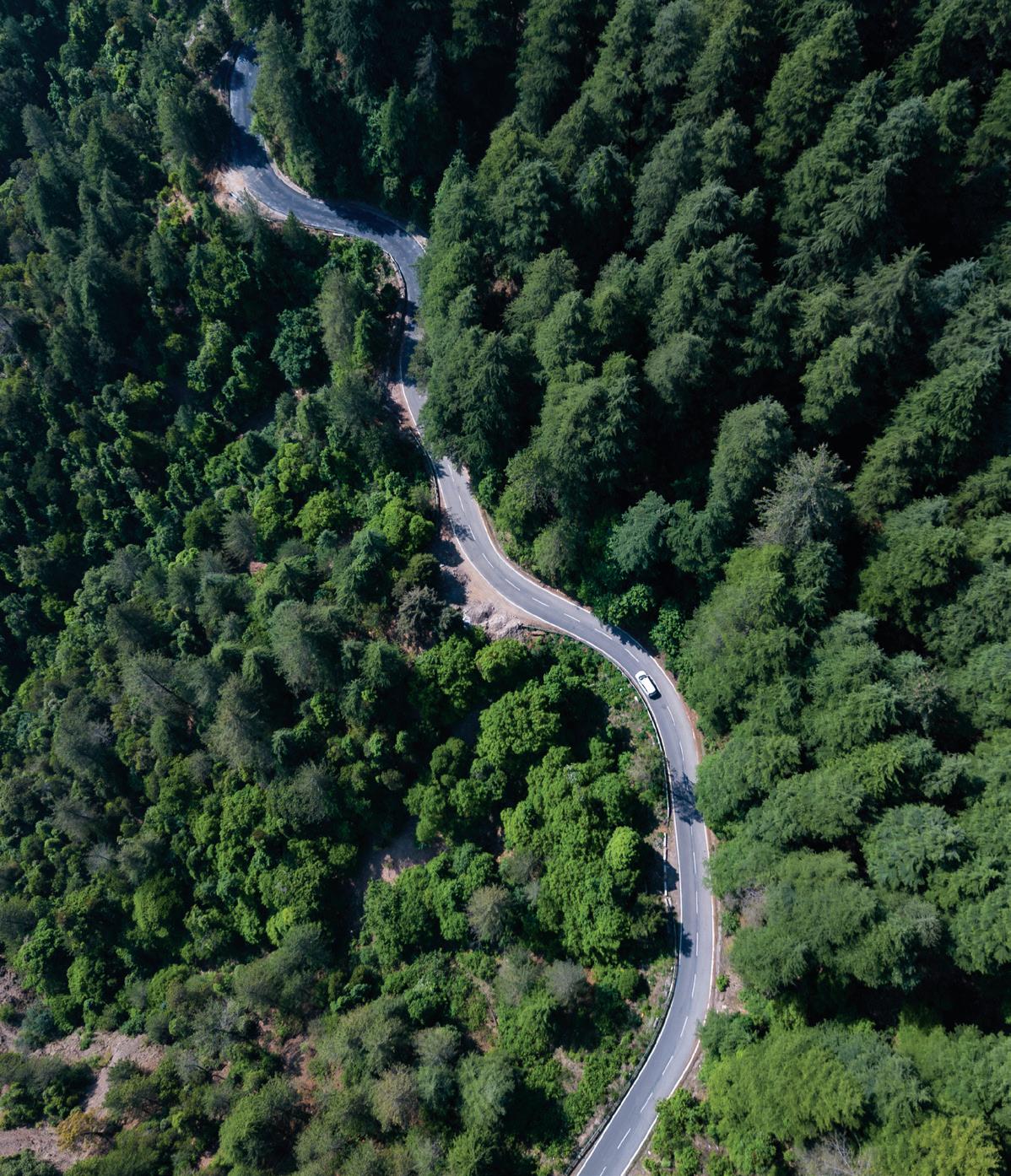
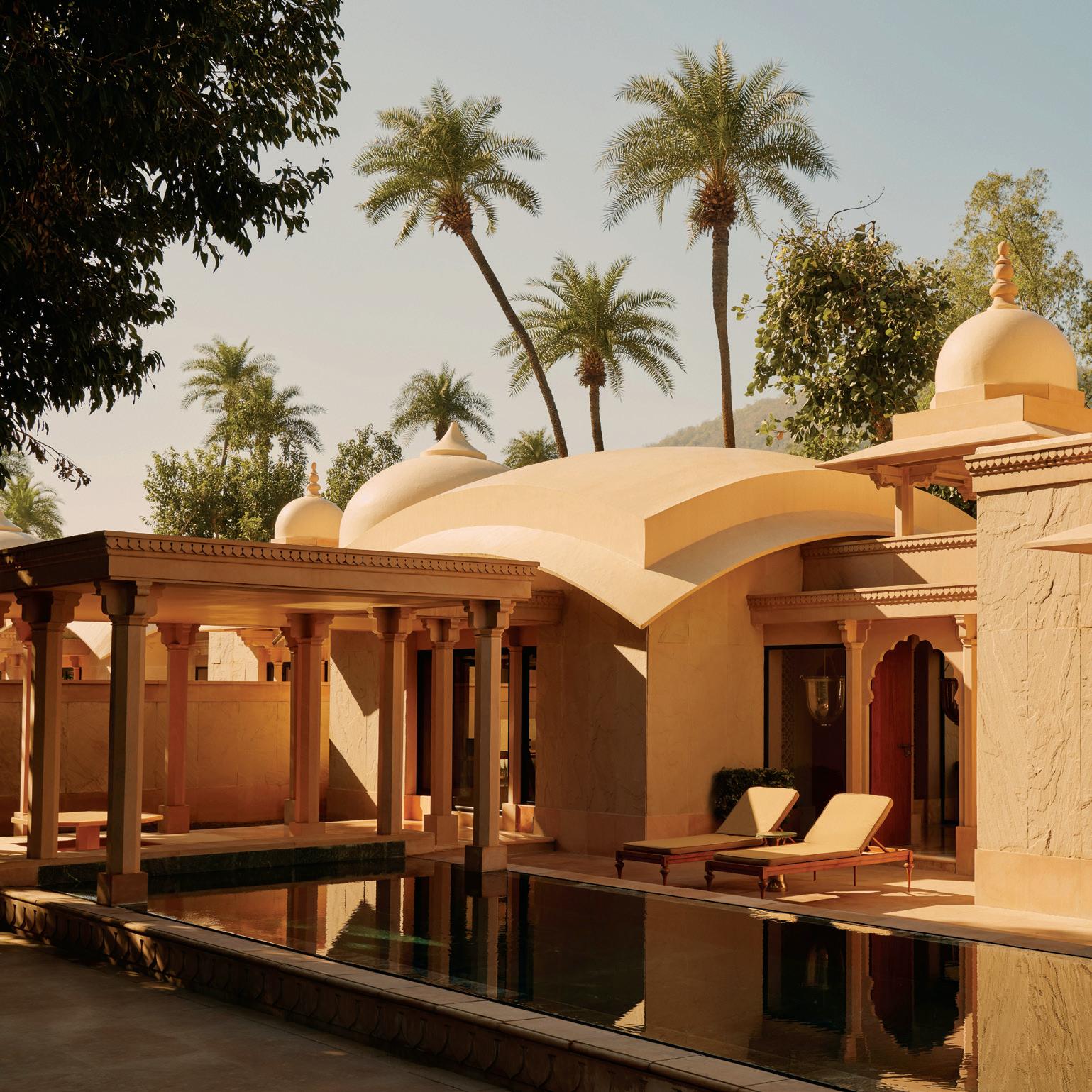
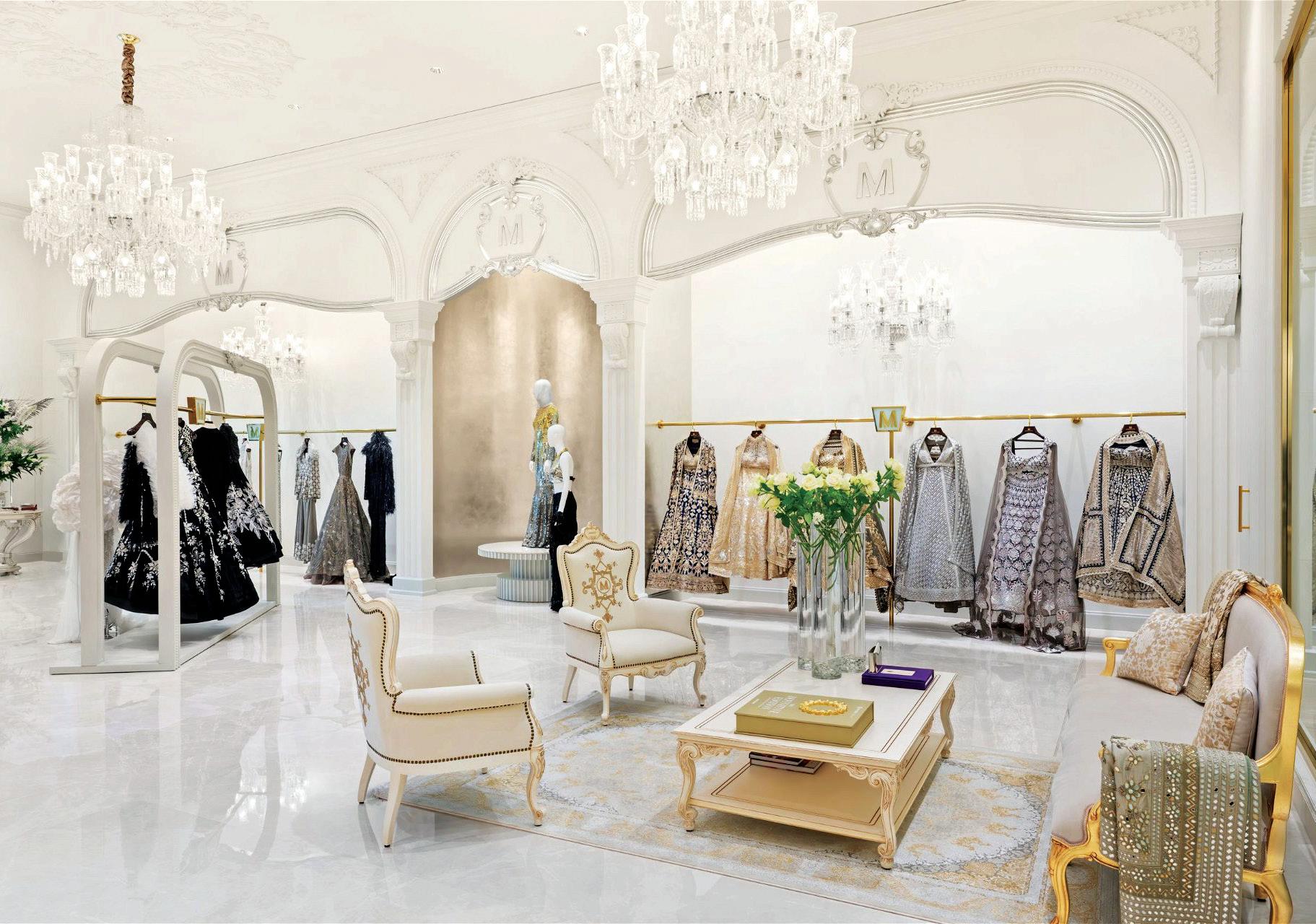
For the 2020 Ruhaaniyat show, I delved into the rich culture and archives of Awadhi heritage. This was a deeply personal journey originating in Lucknow, the heart of Awadhi culture and cuisine.”
My recent family trip to Amanbagh in Rajasthan was an unforgettable experience. India's beauty lies in its diverse cultures and traditions, each city possessing a unique charm, much like individual love stories.
In our increasingly technology-driven and globalised world, traditional crafts are overshadowed by innovation, causing Indian artisans and their art to lose their foothold. I often embark on journeys to explore and celebrate the rich tapestry of Indian artisanal traditions and craft culture.
Luxury to me is thoughtful, valuable, and slow. Every moment in the embrace of luxury should be celebrated and savoured. For the good and better, the perception of luxury has changed due to pandemic-driven
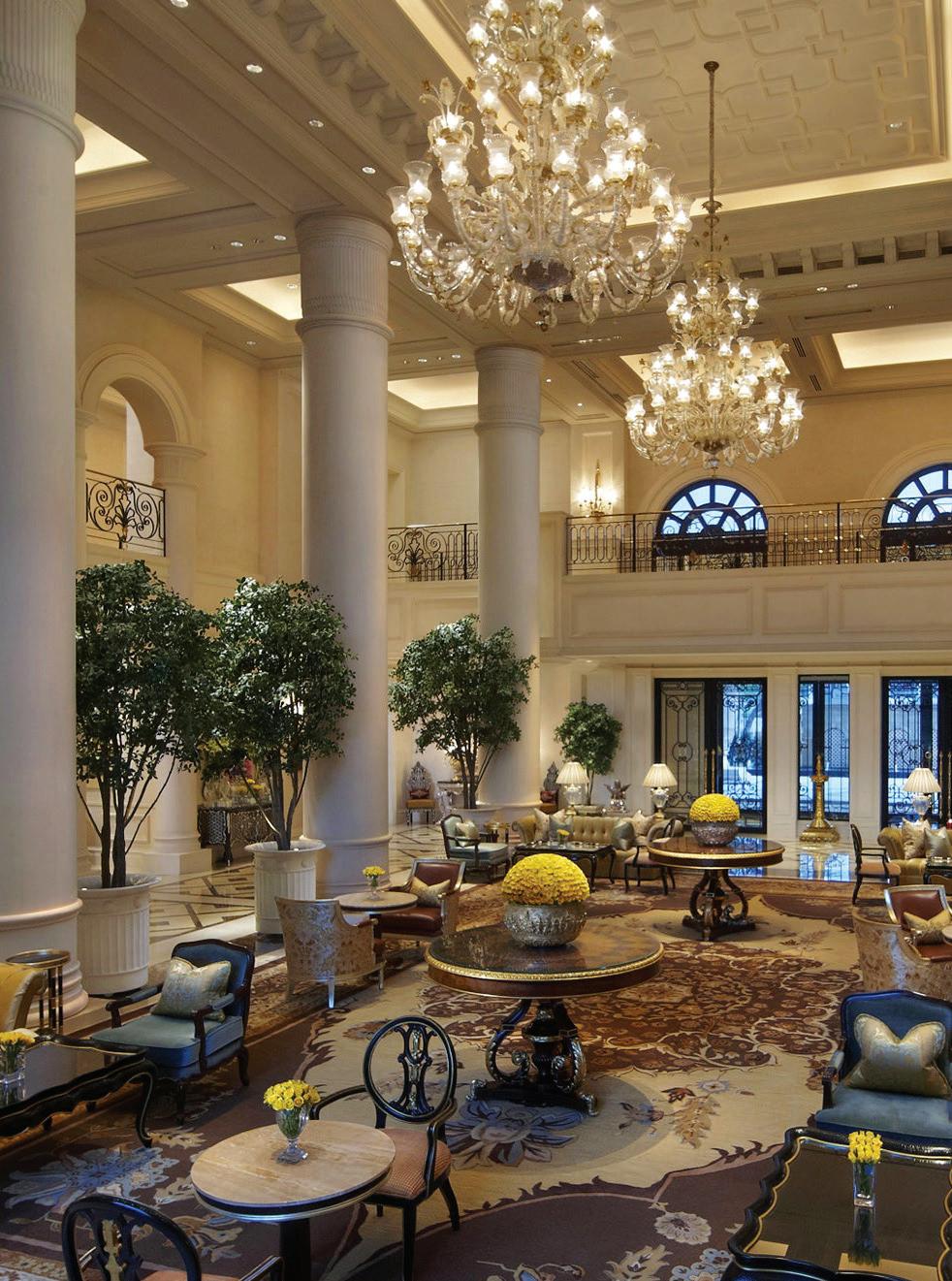
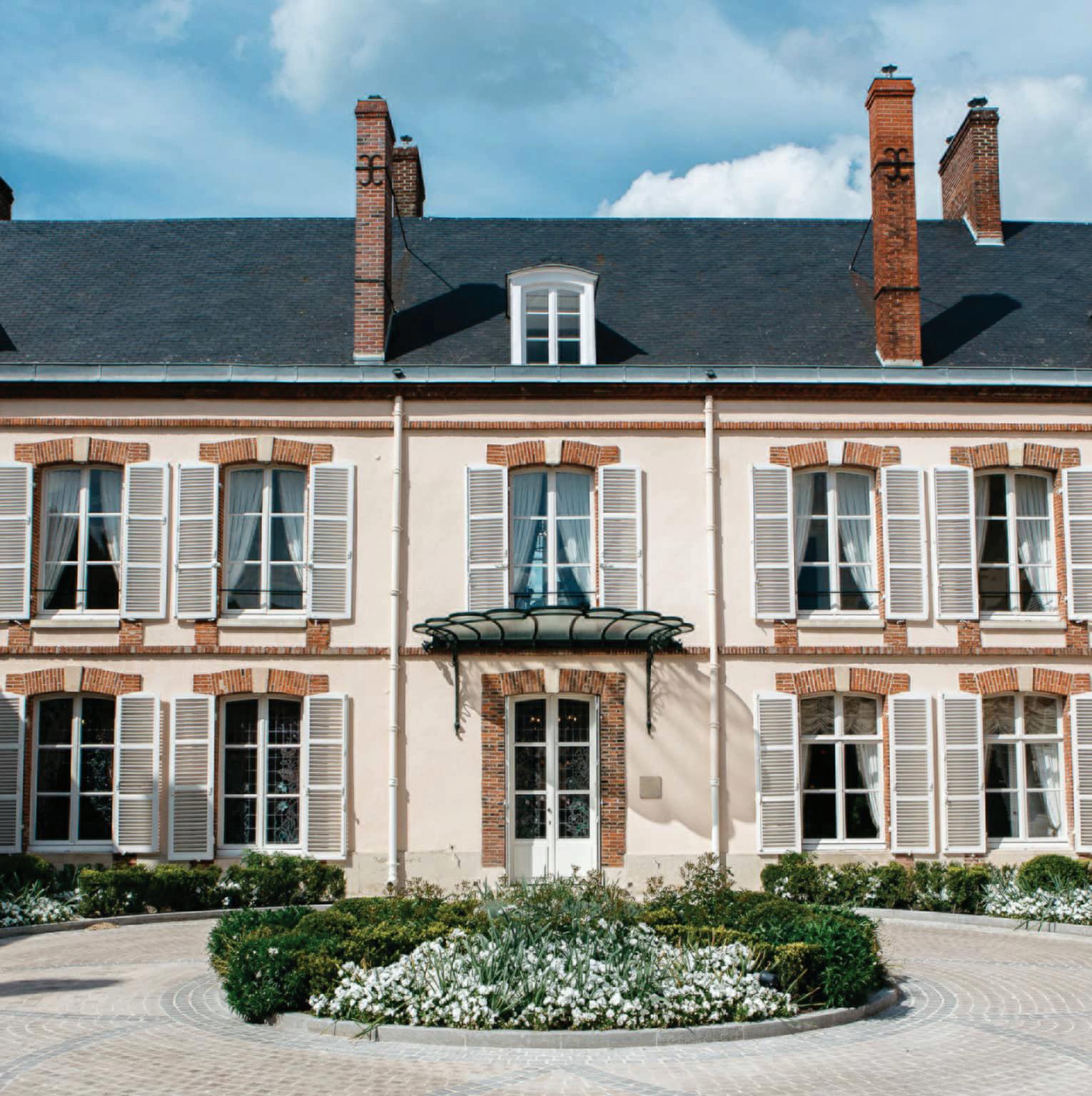
this personal transformation is reflected in my work.
Among my top destinations are: Varanasi is my top Indian destination, cherished for its spiritual essence and beauty.
Rishikesh also holds a special place in my heart for similar reasons. I love the mountains and have ventured into lesser-known areas around Mussoorie to connect with nature and explore its colonial heritage and religious sites. In India, Jodhpur and Udaipur exude grandeur and a mystical charm. Rajasthan truly embodies royalty.
transitions. Fulfilling experiences has become a top priority. Travellers look forward to thoughtful, valuable, and feel-good experiences.
I cherish all my travel memories; travel is one of my passions, and I rarely find fault with any place I visit.
Travel fuels my life. My work has taken me around the globe—from Bangkok and Singapore to New York and Switzerland, and beyond. I'm deeply grateful for these experiences, as they've enriched my growth as a designer, a creative, and a person.
Travel exposes you to diverse cultures, people, and ways of thinking. For someone like me who hasn't formally studied fashion, travel has been an invaluable teacher. It has broadened my mind and heart, and
For the 2020 Ruhaaniyat show, I delved into the rich culture and archives of Awadhi heritage. This was a deeply personal journey originating in Lucknow, the heart of Awadhi culture and cuisine. Awadh derives from Ayodhya, the ancient capital of the Kosala Kingdom, and the region became part of the Mughal Empire in the 16th century. While the Nawabs have left an indelible mark on Awadhi culture, there's more to it, including culinary influences around Ayodhya.
Internationally, Dubai embodies the future; it's constantly evolving in every way, aligning with our
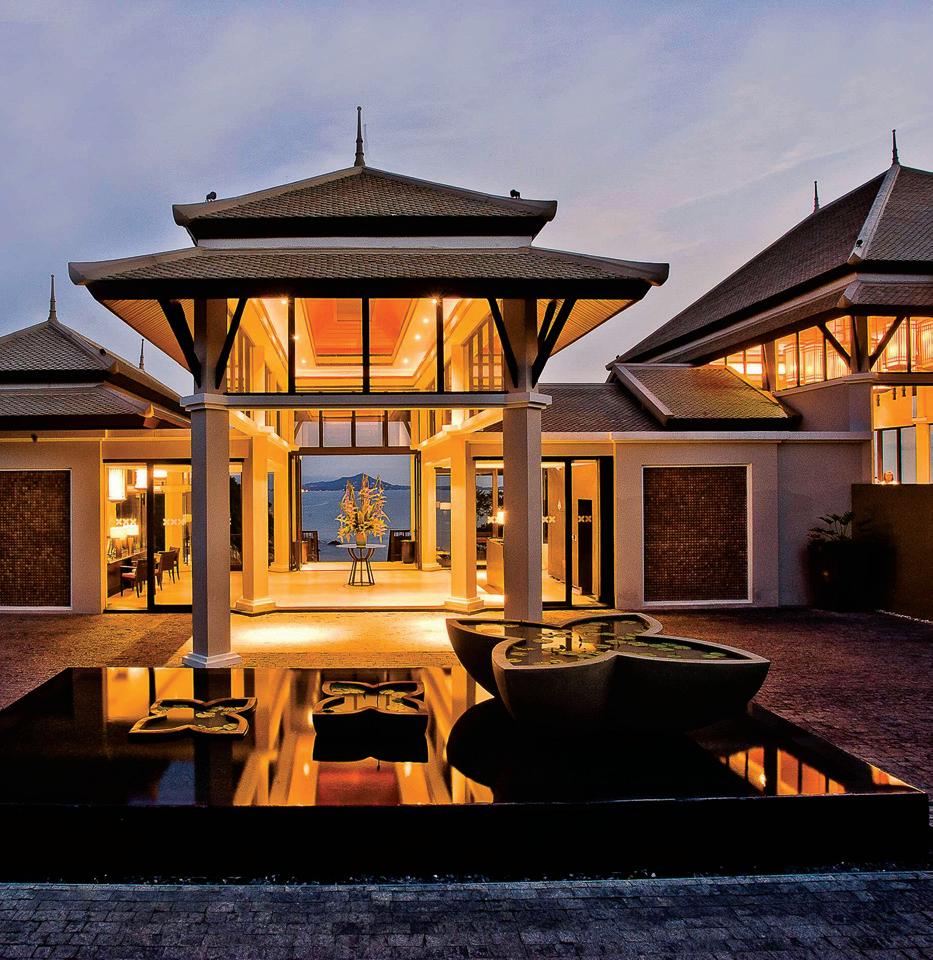
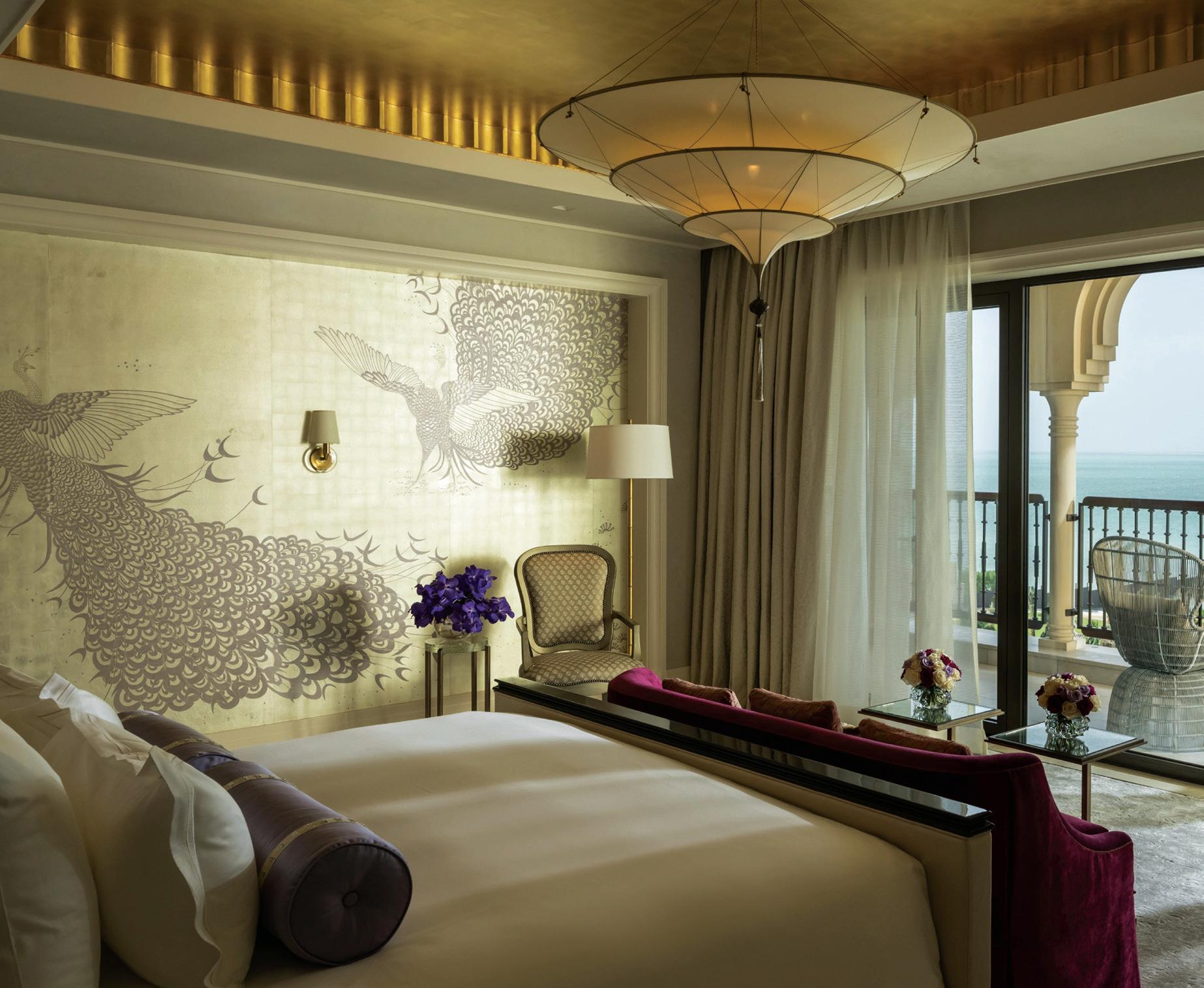
brand's vision. Dubai is my second home. I first visited in 1999 for wedding shopping and later opened my store, Studio 8, on Jumeirah Beach Road in 2005. I envisioned a modern, luxurious space with an Indian palace feel, featuring carvings and chandeliers. My dear friend Gauri Khan understood my vision perfectly, and we collaborated seamlessly on the store. I have a longstanding connection with Dubai. Each visit inspires me, as there's always something new and fabulous to discover.
I also like London for its earthy and vintage feel.
Another international destination I enjoy is Hua Hin. Just two hours from Bangkok, it's a beautiful location, especially for weddings and other celebrations.
I love New York. It's a liberating city, and my friends joke that I should get
“ What does travel mean to me? Rest. Sometimes, I even completely disconnect from the world to spend time with myself. While doing no work is part of a holiday, I often feel guilty indulging in it.”
an award for how often I visit. Although it's primarily for work, I appreciate the city's vibrant energy.
Paris holds countless memories for me, and each trip adds to this treasure trove. The city is vibrant, rich, and full of life. It's also home to one of my favourite hotels, the Four Seasons, with its indulgent luxury.
I have a penchant for interesting hotels. One of my favourites is the Four Seasons Resort Dubai at Jumeirah Beach. It boasts stunning Arabic touches and quintessential Dubai glamour, with an unbeatable location offering direct access to Jumeirah Beach.
My fond memories of The Banyan Tree Samui, Koh Samui date back to when we were shooting Student of The Year on the island. The villas are the epitome of luxury, with infinity pools that seem to float in mid-air and invilla dining options, so you never have to leave!
The Four Seasons Hotel George V in Paris is a bright, charming property boasting the most exquisite floral arrangements I've ever seen. It also houses one of my favourite hotel spas, where the signature George V massage is the perfect remedy for a tiring day.


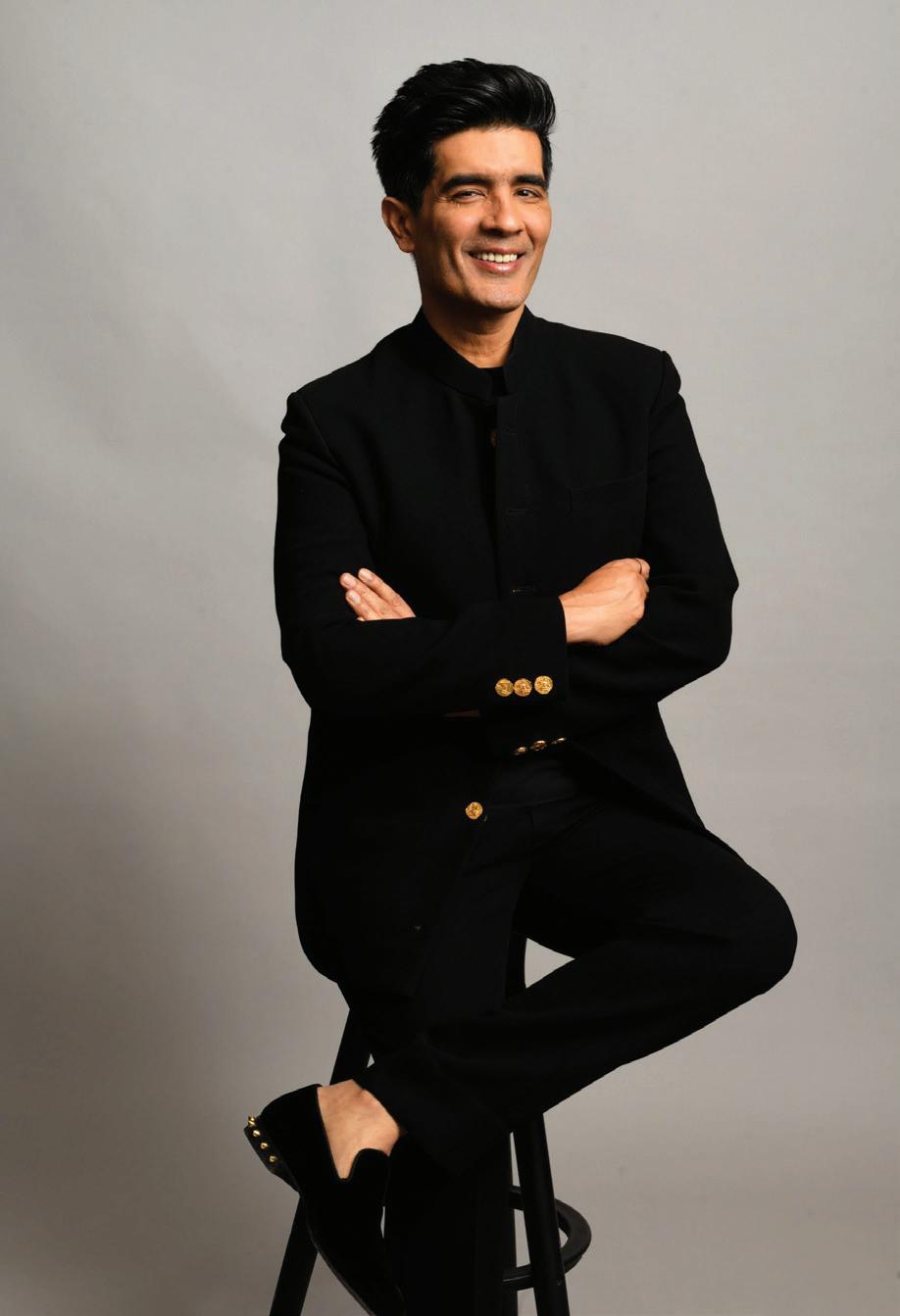
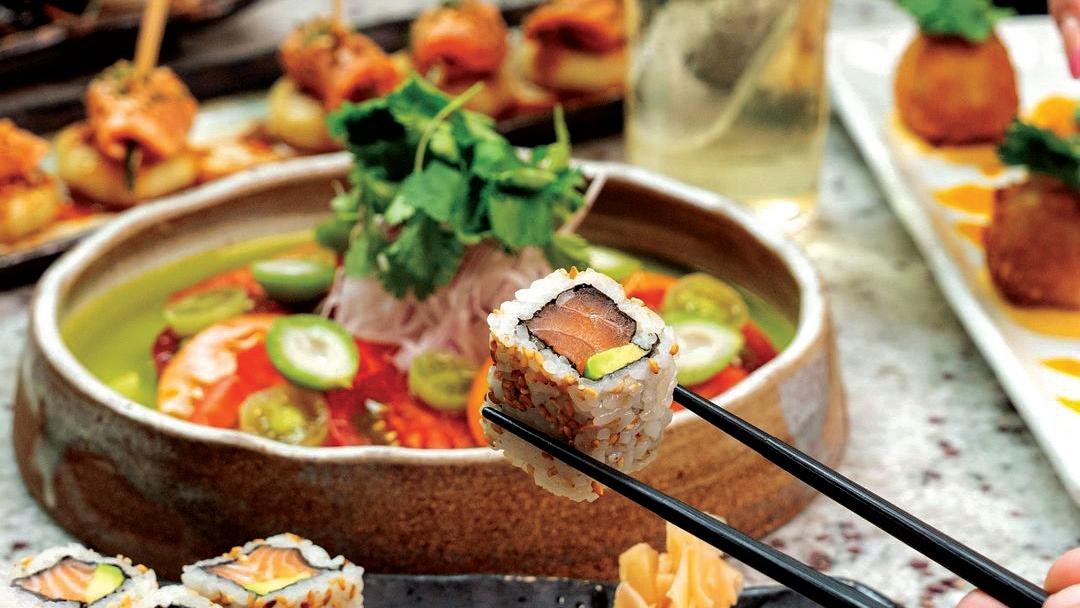
I adore the old-world British charm and delightful high tea at The Promenade at The Dorchester in London. Its prime location near Hyde Park and Mayfair is a bonus.
The Leela Palace in New Delhi is my sanctuary away from home. The warm lighting and exquisite floral décor always soothe me after a long day. The staff anticipates my needs, and I enjoy special privileges like ordering Megu's sushi at the bar!
I pack meticulously for travel, prioritising comfort and versatility: my most comfortable shoes, athleisure wear for easy movement, a scarf, perfumes (my signature scent travels with me), and hair gel. Athleisure is key. Opt for comfortable sneakers for summer walking, a lightweight white jacket, and sunglasses.
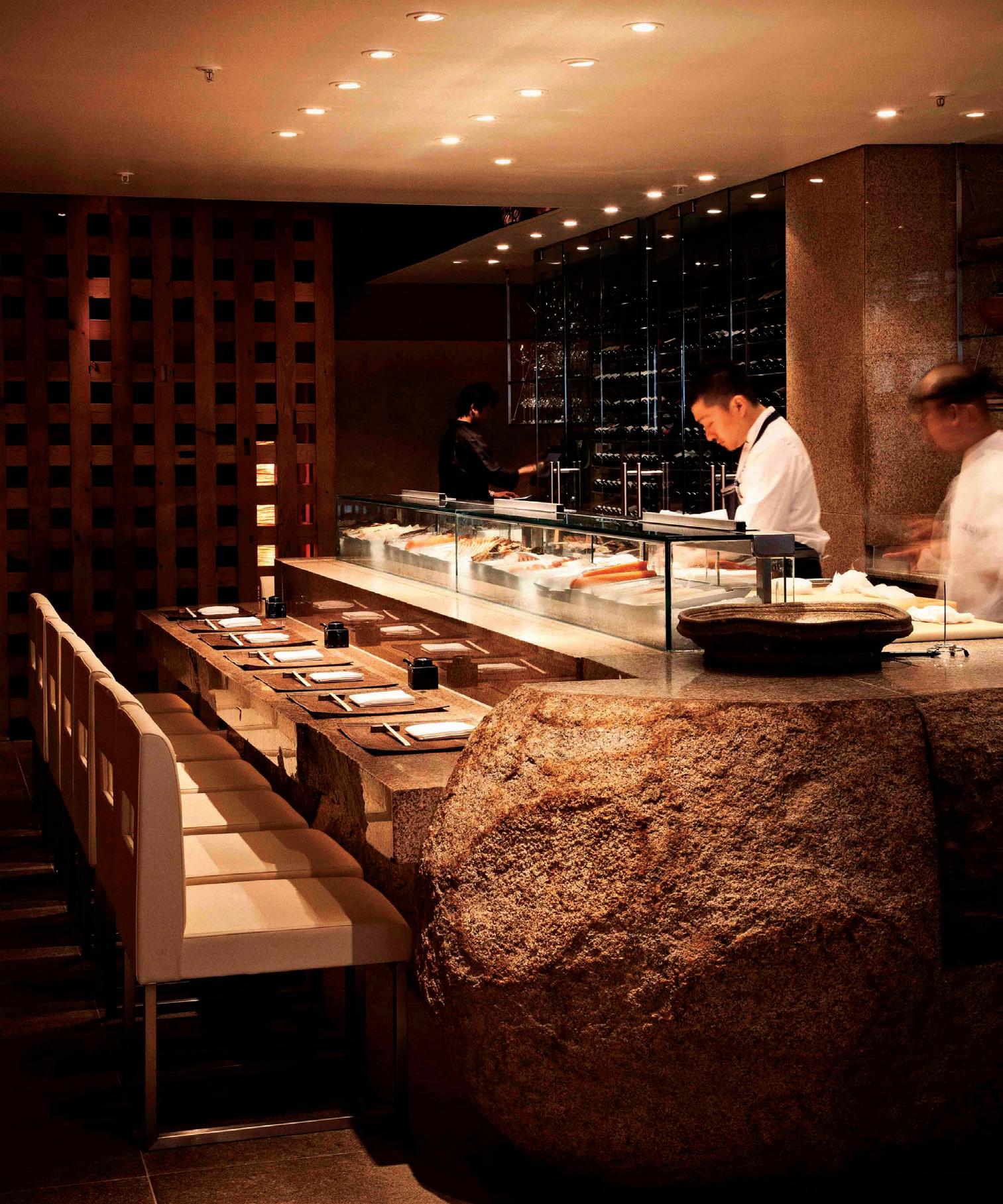
What does travel mean to me? Rest. Sometimes, I even completely disconnect from the world to spend time with myself. While doing no work is part of a holiday, I often feel guilty indulging in it.
I relish shopping and exploring, mostly on foot, as I find walking is the best way to uncover hidden gems. I often stumble upon the most charming shops and stores filled with unique treasures.
Disorganised travel is my pet peeve. Everything must be meticulously planned and run like clockwork. I need all my paperwork, not just tickets and passports, but also maps and directions, often printed for easy reference.
On my travel wishlist are immersive experiences in destinations like Alaska, Shanghai, and Venice. I'm not interested in brief visits; I want to spend at least a month in each, fully immersing myself in their unique cultures and landscapes.
My favourite restaurant is Le Petite Maison in Dubai. This French establishment is Dubai's go-to spot for power lunches. Nobu and Zuma in London are also high on my list.
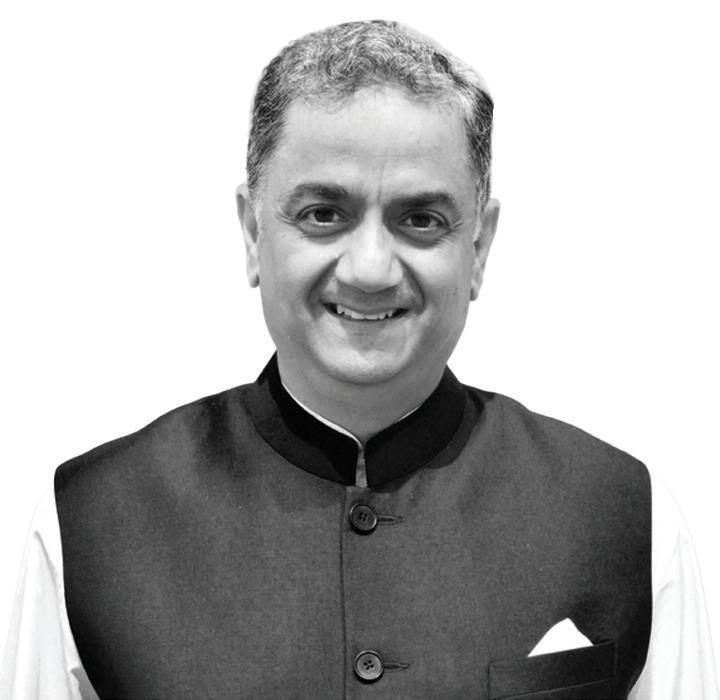
The hospitality industry currently boasts 2.48 million rooms, employing 2.3 million people. Projections indicate significant expansion in both accommodation and employment by 2029, ensuring a vibrant future for the sector.
The hospitality industry has gone through an almost cinematic fall and resurgence in the last few years. Global projections were turned on their heads by geopolitical crises and the pandemic taking centre stage. Amidst this uncertainty, Hotelivate looked at the size of the hotel market in terms of supply and the number of employees within it.
Historically, we have tracked this since 1995 but only focussed on the branded hotel segment. However, the branded hotel segment represents only a fractional portion of all accommodation, and it is important to understand the larger picture so that all stakeholders, including the government, investors, consultants and others can have a better understanding of the larger picture.
The latest analysis reveals a robust count of 2.48 million lodging rooms
currently operational in India as of June 2024. When discussing the total inventory of accommodations in the country, the picture appears quite hazy. Recognising this gap, Hotelivate undertook a comprehensive market sizing exercise with inputs from well-known OTAs and industry experts. After estimating the total number of rooms across the country, our next natural step was to gauge the industry's potential employment impact. Using this dual lens helped us understand the industry's economic contribution, and chart where we will be in the hospitality landscape a decade from now.
The latest figures reveal that India's hospitality industry supports a formidable workforce of 2.3 million as of June 2024, translating to 0.94 employees per lodging room nationwide.
The supply story
Hotelivate's latest analysis reveals a robust count of 2.48 million lodging rooms operational in India as of June 2024. This figure spans a diverse spectrum, encompassing branded hotels, aggregator giants such as OYO, FabHotels, and Treebo, independent establishments, and various alternative accommodations such as guesthouses and homestays.
Projections indicate a steady ascent, with the room count expected to climb to 3.1 million by 2029 and surge further to 4.1 million by 2034. Initially poised to reach 3.3 million by 2024 based on pre-pandemic forecasts, the hospitality sector encountered setbacks during the COVID-19 crisis, notably impacting unbranded and aggregator segments, where closures approximated 15% of room capacity. Despite these challenges, the branded sector demonstrated resilience in the last two years, marked by a resurgence in new signings and openings. With tourism on the rebound and market dynamics improving, the industry anticipates not only a swift recovery to prepandemic levels by 2025 but also sustained growth throughout the coming decade.
Unbranded hotels currently make up more than two-thirds of the country's total lodging supply and are projected to maintain this dominant position for the next decade.
The independent/unbranded segment possesses a commanding 68% share of India's lodging landscape, underscoring its dominant presence. Meanwhile, the branded hotels sector has swiftly emerged as the second largest, buoyed by increasing investments and heightened interest from domestic and international brands, particularly in Tier II and Tier III cities.
Simultaneously, the alternate accommodation sector, bolstered by the rising popularity of homestays alongside a
Projections indicate a steady ascent, with the room count expected to climb to 3.1 million by 2029 and surge further to 4.1 million by 2034.
OF ACCOMMODATION ROOMS (IN ’000s)
Branded
Unbranded
Aggregators
Alternate accommodation
NUMBER OF PEOPLE EMPLOYED (IN ’000s)
Branded hotels
Unbranded hotels
Aggregators
Alternate accommodation
robust base of guesthouses, has solidified its position as a significant player in the market. Notably, aggregator chains have maintained a stable market share over the past half-decade, with new openings counterbalancing closures incurred during the tumultuous pandemic period.
Hotelivate's latest figures reveal that India's hospitality industry supports a formidable workforce of 2.3 million as of June 2024, translating to 0.94 employees per lodging room nationwide. Despite pandemic disruptions in 2019, when the sector sustained 2.4 million jobs, the industry remains a vital contributor to India's employment landscape. WTTC underscores
this impact, noting that India's broader travel & tourism sector directly employed 37.21 million people in 2023, with hotels accounting for a substantial 6.21%.
We anticipate robust growth with employment climbing to three million by 2029, and further to 3.9 million by 2034, with unbranded hotels leading the charge due to their sheer number despite the low employee-to-room ratio.
We believe this is a conservative estimate as the industry will employ more people for ancillary facilities such as clubs, restaurants, dhabas, clubhouses, banquet halls, and various other infrastructure that is being established in large volumes across the country. Although the current projected growth in employment is 1.5
Source: Hotelivate Research
million jobs, the actual number added may be much higher.
Hotelivate's latest analysis reveals India's hospitality industry is bouncing back strongly as of mid-2024. With investments surging and a resurgence in new openings, the industry can expect sustained growth in the decade ahead. This sets the stage for a thriving hospitality sector poised to capitalise on growing tourism and solidify its essential role in the Indian economic landscape.
Manav Thadani is Founder-Chairman, Hotelivate. He is also a hotel owner, restaurant partner, food critic, uncensored speaker and occasional stage performer. Harinya Sreenivas, Analyst, Hotelievate, collaborated in the research and analysis.
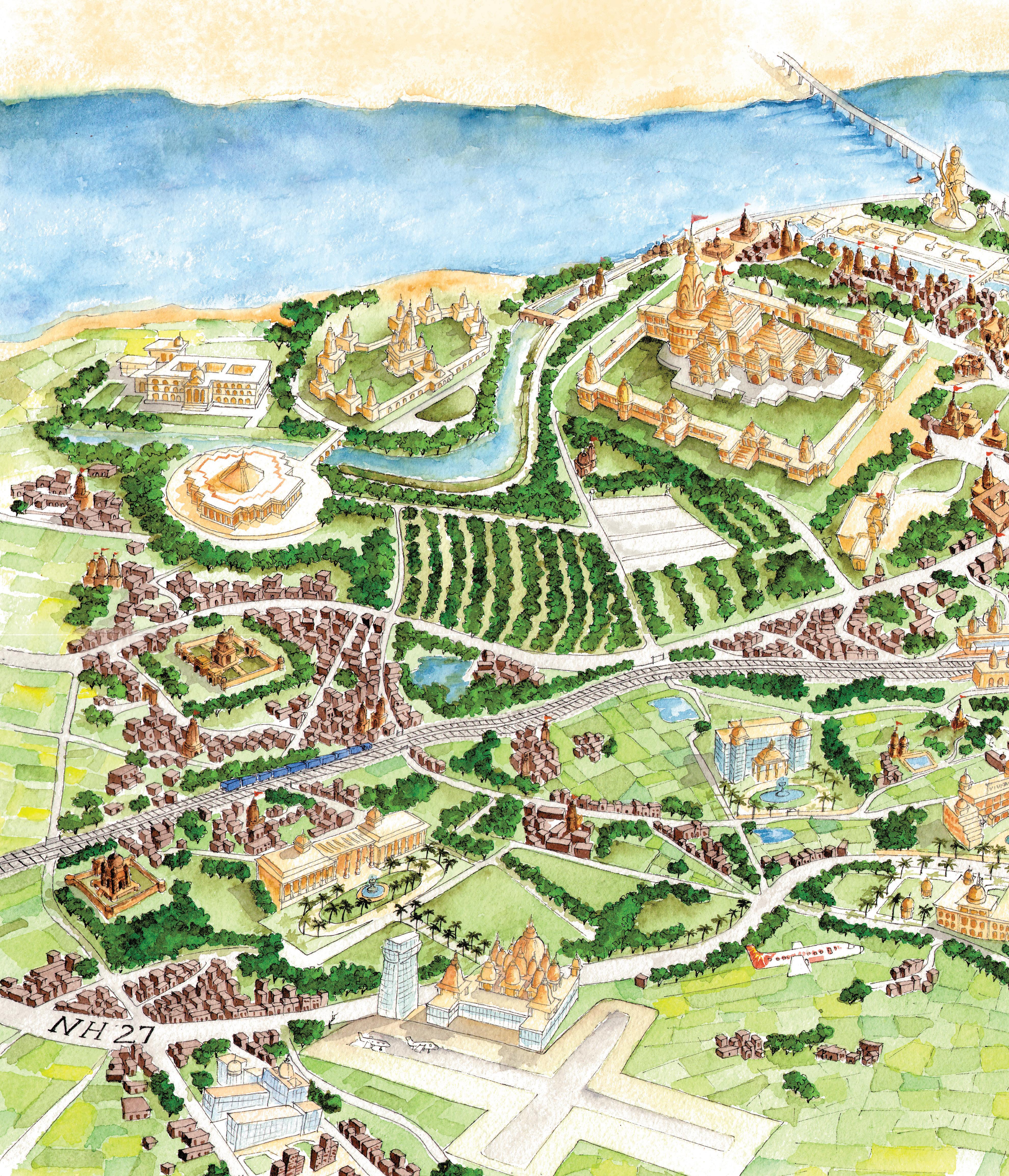

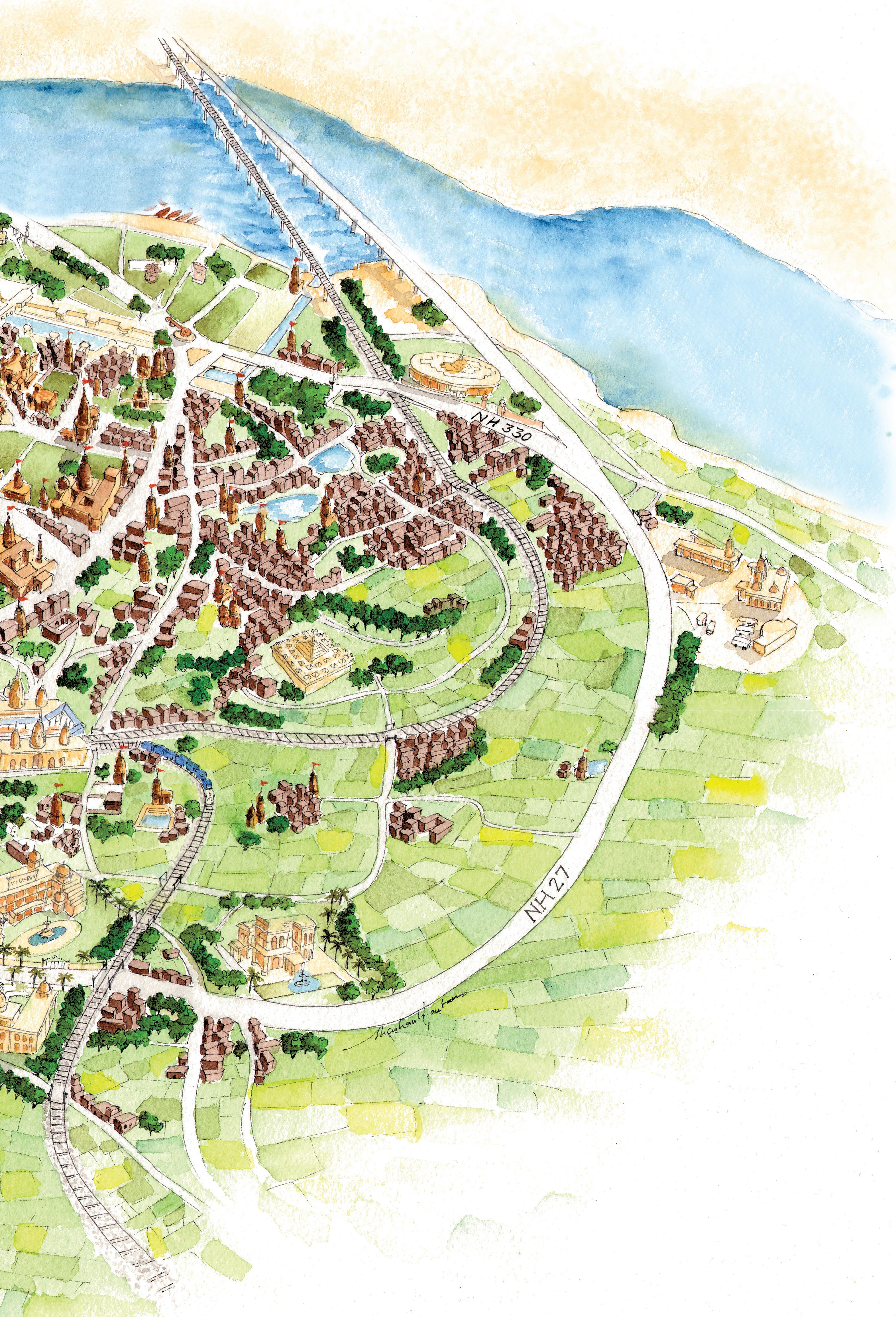
A combined public and private sector push is seeing Ayodhya emerge as the fastest-growing tourism destination in India. What opportunities does the destination offer to the hotel and travel industries?
A convention centre, art and culture centre
A hospitality management and training centre
SUMAN TARAFDAR
20. Sugriv Qila
21. Shri Ram Janmabhoomi Teerth Kshetra
22. Dashrath Mahal, Sita Rasoi and Kanak Bhawan
23. Hanuman Garhi
24. Rajdwar Mandir
25. Lata Chowk
26. NayaGhat
27. Ghaghra/Saryu River
Just about anyone will attest to this—Ayodhya is arguably the fastest-growing spiritual and religious tourist destination. Unprecedented attention by the federal and Uttar Pradesh governments has been lavished on what was once the legendary capital of the Ikshvaku dynasty, with the deity Lord Ram at its cultural and spiritual core. The transformation has been impressive. What was till recently a sleepy town twinned with neighbouring Faizabad, the first capital of the nawabs of Awadh, is now being posited as one that, in the not-so-distant future, would occupy a space similar to the Vatican, Mecca or Bodhgaya, which rank high on the religious tourism marquee.
The newly built temple, inaugurated by Prime Minister Narendra Modi, has ushered in an uptick in interest in the city, and both the public and private sectors are rushing to build infrastructure to meet a sharp increase in tourism. There are also plans to build a Tourism Facility Centre at Nayaghat as well as an international museum at an estimated cost of ₹200 crore.
Tata Sons is planning to construct a Museum of Temples at an estimated cost of ₹650 crores, dedicated to showcasing India's rich heritage and temple architecture. The UP Tourism Department will provide land for the museum on a 90-year lease. Additionally, Tata
Sons will invest another ₹100 crores to improve Ayodhya's infrastructure and enhance its appeal to tourists.
The federal and state governments have launched several initiatives to make Ayodhya a major centre of religious tourism. This includes the Ayodhya Mahayojana 2031 plan, announced by the Uttar Pradesh government, covering an area of 133.67 sq.km. It is expected that by 2031, more than 40 million tourists will visit Ayodhya, double the number from today’s visitor count estimates. American financial services firm Jefferies Group LLC has estimated that Ayodhya will witness a $10 billion makeover with hotels increasing capacity five times, and attracting food, travel, and transport businesses.
For the second stage of the town’s redevelopment, Vadodarabased urban planner Gopaldas Shah, part of the Masterplan team, has proposed the city’s layout on the ‘Dhanush’ plan, based on Vastushastra, according to reports. The document has a list of 27 projects which are all a part of the master plan. Part of these efforts includes the redevelopment of Ayodhya's outskirts under the Amrit Yojana-2 programme, with a budget of ₹351.40 crores.
While these initiatives have been announced, they are still in the preliminary stages, and it will take some time before we see progress and set deadlines for their completion.
The speed of air connectivity has been even more impressive. Construction on the Maharishi Valmiki International Airport began in February 2022 with an allocated budget of `5 billion, while flight operations began on 10 January, 2024.
While the legendary city of Ayodhya is associated with Lord Ram, the historical city finds extensive references in ancient texts of the region. Here are some lesser-known aspects of the city, once one of the largest in the subcontinent:
The word Ayodhya is derived from yudh or war and would more aptly translate to mean invincible.
Ayodhya has an earlier name—Saketa, its name ascribed to the Sanskrit words saha (with) and aketen (houses or buildings). The city is referred to in ancient Sanskrit, Jain, Buddhist, Greek and Chinese sources as Saketa.
The name Ayodhya is used from the Gupta era onwards, when Skandagupta moved his capital to Saketa and renamed it. Kalidasa’s Raghuvamsha mentions Ayodhya as an alternate name for Saketa.
Both Gautama Buddha and Mahavira are said to have visited and lived in the city.
Ancient scholars such as Panini and Patanjali mention the city in their works.
Ayodhya was stated to be the capital of the Kosala kingdom in the period of the Mahajanpadas (ca. 6th century BC).
The city’s importance grew as it lay on the intersecting trade routes of the Ganga valley in the ancient period—the ShravastiPratishthana north–south road, and the RajagrihaVaranasi-Shravasti-Taxila east–west road.
Even after the decline of the Guptas, the town continued to flourish, as evidenced by Chinese traveller Xuanzang, who mentioned it during his travels in the 7th century.
As a part of the Ayodhya Mahayojana 2031 plan, the city will see revamped infrastructure. UP governmentʼs Vision Document for Ayodhya envisages a grand new Ayodhya across river Saryu, straddling the adjoining districts of Gonda and Basti.
airport,
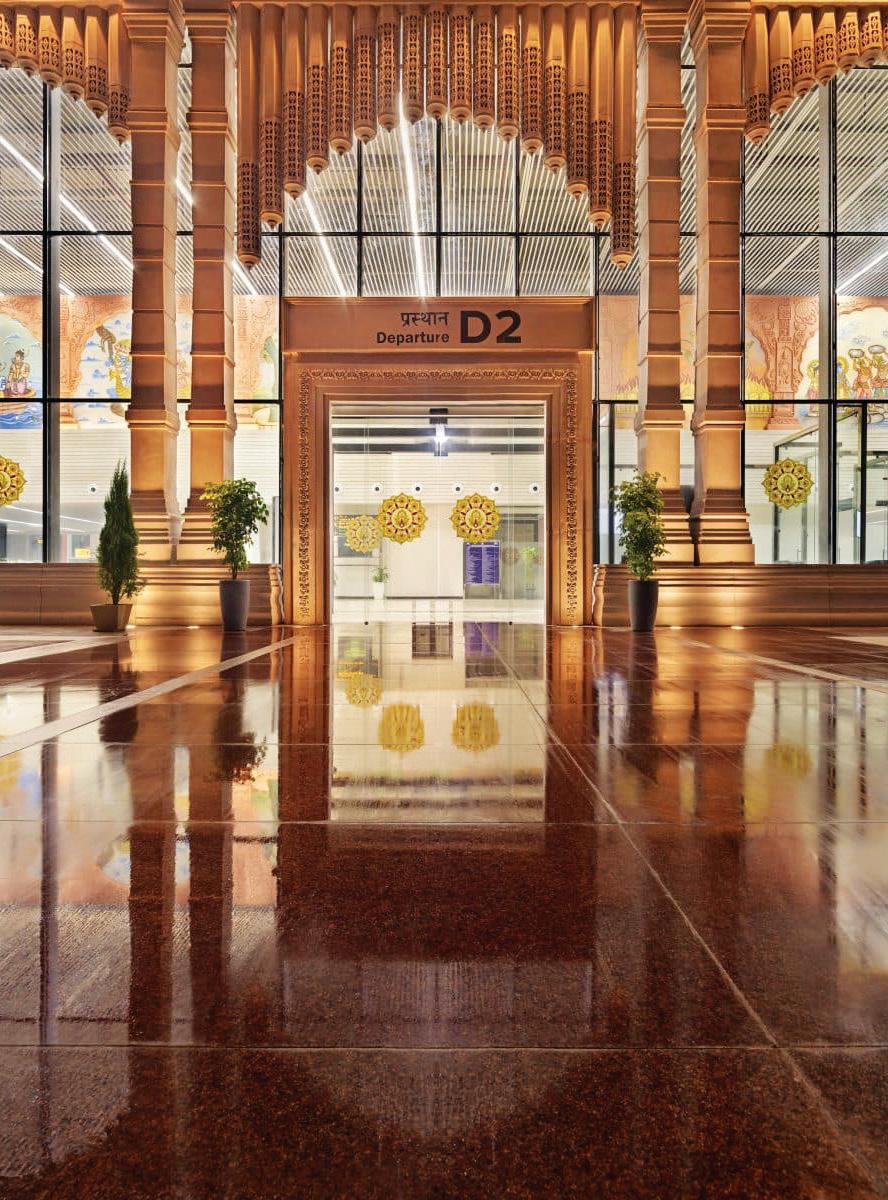
Ayodhya Dham Station (Phase-1): `241 crore
Spine Road till Nayaghat: `845 crore
Rajarshi Dashrath Autonomous State Medical College: `245 crore
Rail Overbridge: `68.04 crore
Maharishi Valmiki Airport: `1,463 crore
Ram ki Pauri renovation: `105.65 crore
Source:
an airport project in the country. Several airlines are flying to Ayodhya already, including Air India Express (Bengaluru, Delhi, Gwalior, Kolkata), Akasa Air (Delhi, Pune), IndiGo (Ahmedabad, Delhi, Mumbai), SpiceJet (Ahmedabad, Bengaluru, Chennai, Darbhanga, Delhi, Jaipur, Mumbai, Patna) and Zoom Air (Delhi).
The travel and hospitality sectors are rushing in to fill the gap. A slew of projects have been announced. In the past few years, the government has boosted railway connectivity, even launching special ‘Ramayana Circuit’ trains to facilitate pilgrims visiting the city.
MakeMyTrip earlier announced an Ayodhya charter train package. Palace on Wheels, India’s first luxury train, is reported to be planning a religious circuit that includes Ayodhya, Varanasi, Prayagraj, Mathura and Vrindavan. Amongst the planned highlights of this religious trip, expected to run twice a month, are only vegetarian cuisine on board, no alcohol, and the playing of devotional songs along the entire route.
The National Highways Authority of India (NHAI) has undertaken a project to construct a 65-km ring road around town, from Sugriva Fort to Ram Mandir, at an estimated cost of `2,588 crore. Also on the anvil is a 1,200-acre Vedic Township with ashrams, hotels and other institutions.
The speed of air connectivity has been even more impressive. Construction on the Maharishi Valmiki International Airport began in February 2022, with an allocated budget of `5 billion, and was inaugurated on 30 December 2023, while flight operations began on 10 January 2024—easily the fastest implementations of
According to Aloke Singh, Managing Director, Air India Express, “We inaugurated our Ayodhya-Delhi flight on the very day of Ayodhya airport’s opening. Within a few weeks, we extended our connectivity to this sacred city, now linking Ayodhya with two additional metro cities: Kolkata and Bengaluru. This strategic expansion will provide pilgrims with convenient one-stop itineraries to Ayodhya and enhance connectivity to 16 other destinations on our network. The swift expansion of services in Ayodhya underscores our commitment to expanding both domestically and internationally, driven by a growing fleet.”
As a part of the Ayodhya Mahayojana 2031 plan, the city will see revamped infrastructure. UP government’s Vision Document for Ayodhya envisages a grand new Ayodhya across the river Saryu, straddling the adjoining districts of Gonda and Basti.
To cater to the increased number of tourists, the plan is to have about 25,000 hotel rooms across categories, up from 592 (in 2023) and 70 dharamshalas, according to the Masterplan report. The speed with which a slew of hotel projects have been announced is notable. Projects worth ₹4,233 crore, budgeted for the construction of at least 100 hotels, including luxury ones, are in the pipeline.
Hospitality consultancy firm Hotelivate, in its report Ayodhya’s Gold Rush: Hospitality Boom in the
Offing, estimates, “Assuming that about 5% of the total footfall would opt to stay in branded hotels with an average guest density of 2.2 people per room and a length of stay of one night, we project that the market will require an inventory of 8,500-12,500 branded keys to cater to this demand. Owing to the inherent seasonality, an assumption of 65% marketwide occupancy has been taken.”
Real estate consultancy JLL estimates about ₹350 crore worth of investments in hotel development. The UP Housing and Development Board invited interested parties to participate in an e-auction of hotel plots in Ayodhya. According to a report in the Hindustan Times, two mega hotels with a capacity of 200 rooms each, 20 hotels with a capacity of 100-175 rooms, 47 hotels with 50-99 rooms each, and 65 hotels with less than 50 rooms each will come up in Ayodhya.
The projected data is based on the potential of the destination as a spiritual tourism getaway rather
than actual arrivals, so how it shapes up ultimately needs to be tracked over the next few years. There is no taking away from the fact that the possible potential has enthused businesses, among them the hospitality industry.
Among the leading hotel groups that have signed projects are Indian Hotels Company Limited (IHCL), Marriott, Sarovar Hotels & Resorts, Fortune Hotels, and Wyndham Hotels & Resorts. The projects are expected to be realised in the next few years. Others such as ITC are said to be actively exploring opportunities.
Dikshu Kukreja, Managing Principal, CP Kukreja Architects, estimates that about 30,000 rooms across different categories will be needed to cater to the visitors.
Vijay Naraayanan, Co-Founder & CEO, AweSpace Ventures Private Limited, has said that the leading real estate transaction advisory firm in diversified investments in ultraluxurious properties has drawn ambitious plans to develop bespoke residential retreats.
IHCL has announced the signing of two new hotels in Ayodhya. Both Vivanta and Ginger branded hotels are greenfield
Ayodhya will require 8,500-12,500 branded keys to cater to this demand. Owing to the inherent seasonality, an assumption of 65% marketwide occupancy has been taken.
- AYODHYA’S GOLD RUSH: HOSPITALITY BOOM IN THE OFFING, BY HOTELIVATE.
Source:
projects. “These signings are in line with IHCL’s vision to strengthen its presence across spiritual centres in India,” Suma Venkatesh, Executive Vice President - Real Estate & Development, IHCL says. “Ayodhya is an important pilgrimage site and receives a very high footfall throughout the year. We are extremely delighted to partner with Bhardwaj Global Infraventures Private Limited for these two hotels.”
Ajay K Bakaya, Managing Director of Sarovar Hotels & Resorts, says that hotel chains are in discussions or have already committed to establishing hotels in Ayodhya. Interestingly, hotel infrastructure may develop even beyond the core temple area. Hotelivate’s report puts it in perspective when it states, “For hotel developers and brands exploring the Ayodhya opportunity, it is important to note that the Chaurasi Kosi perimeter, delineated around the temple, imposes specific restrictions on hospitality establishments, mandating vegetarian offerings and an alcohol-free environment. In contrast, surrounding areas, including the Ayodhya Cantonment area and the Gonda district, north of the river Saryu, do not have such restrictions and present alternate options for hotel developers or brands who view these restrictions as challenges.”
International groups such as British conglomerate Trafalgar Square Capital, Hong Kong-based Taushan International Group, RG Group, Austin Consulting Group, Cosis Group and Unicorn Energy from Germany have shown interest in investments in Ayodhya.
The spiritual destination is on the cusp of transformation and it will be interesting to track how India’s religious tourism sector will evolve, based on lessons learnt from the city famous as Lord Ram’s birthplace.
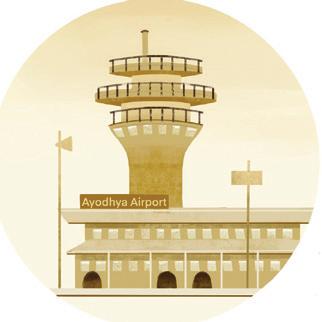
million passengers 1 lakh people per day 1
According to the Airport Authority of India data, the Maharishi Valmiki International Airport has a current capacity of welcoming 1 million travellers per annum, which will go up to six to seven million after Phase II is complete.

85,000 croreN investment
Hotelivate, in its report Ayodhya’s Gold Rush: Hospitality Boom in the Offing, projects that the market will require an inventory of 8,500-12,500 branded keys in the medium to long term to cater to this demand.
The refurbished Ayodhya Dham Railway Station can receive over one lakh people per day.
The Uttar Pradesh government plans to invest over H85,000 crores (US$ 10 billion) over the next decade in the city. As outlined in Ayodhya Mahayojana 2031, this investment is aimed at a multifaceted development, including the upgradation of the infrastructure, the establishment of a spiritual university, greenfield townships (over 1,200 acres to be allotted for the development), urban forests, a convention centre, arts and craft centre and a hospitality management and training centre.
8.5k-12.5k branded keys
Shrikant Wakharkar, Area Vice President - South and Central India, and General Manager, Park Hyatt Hyderabad, on what it takes to be a GM in an evolving world and the right way of balancing the aspirations of the owner and the brand.
SUMAN TARAFDAR
A veteran leader of the hospitality sector with over three decades of experience, Shrikant Wakharkar, Area Vice President - South and Central India, and General Manager of Park Hyatt Hyderabad, brings a wealth of experience and expertise, especially in leadership roles.
From crafting interesting dining experiences as a young restaurant manager to overseeing a symphony of luxury hotels, Wakharkar's career has spanned a variety of roles. His resume lists out stints at properties such as The Westin Chennai, InterContinental Goa, and Marriott Hyderabad before he ascended to the helm of Hyatt's regional operations. This wealth of experience has offered him a unique vantage point to understand the nuances of the Indian market, from the booming domestic travel scene to the challenges of balancing brand standards.
In an exclusive interview with SOH, Wakharkar opens up about the evolving role of a general manager, the importance of technology and sustainability, and the key trends shaping the future of hospitality in India. His insights offer a behind-the-scenes look at what it takes to run a modern hotel and provide a roadmap for aspiring hoteliers looking to make their mark in this dynamic industry. Excerpts.
Can you shed light on how the south and central India markets are different? How do you see the hospitality market evolving in India in the near term?
The outlook for the hospitality sector in south and central India over the next six to nine months appears promising, buoyed by several positive trends and strategic shifts. The key factors expected to shape the industry:
Steady demand and supply dynamics: The demand for hotel accommodations is projected to remain steady, although an
increase in supply may put pressure on pricing.
Domestic travel and corporate travel: Domestic travel continues to be a strong driver, complemented by the resurgence in corporate travel. This is expected to bolster overall demand, particularly in micro markets and major urban areas.
Inbound tourism: With the revival of inbound tourism, the hospitality sector anticipates improved growth.
Event-driven boosts: Although significant events such as the G20 summit and the Cricket World Cup 2023 provided a substantial boost, the sector remains optimistic about sustaining growth through continued domestic demand and smaller-scale events.
Revenue management and technology: Integration of advanced revenue management tools and technology will be crucial for maintaining profitability in the face of rising costs. It spans leveraging AI and data analytics to optimise pricing and operational efficiency.
Challenges: The industry faces several challenges such as high GST rates, talent acquisition, and the need for sustainable business practices. Addressing these issues will be crucial for long-term growth.
Overall, the sector can see a conservative yet promising growth in both room occupancy and average daily rates, driven by strategic investments and a focus on emerging travel trends. The industry is poised to capitalise on opportunities, particularly in smaller towns and cities.
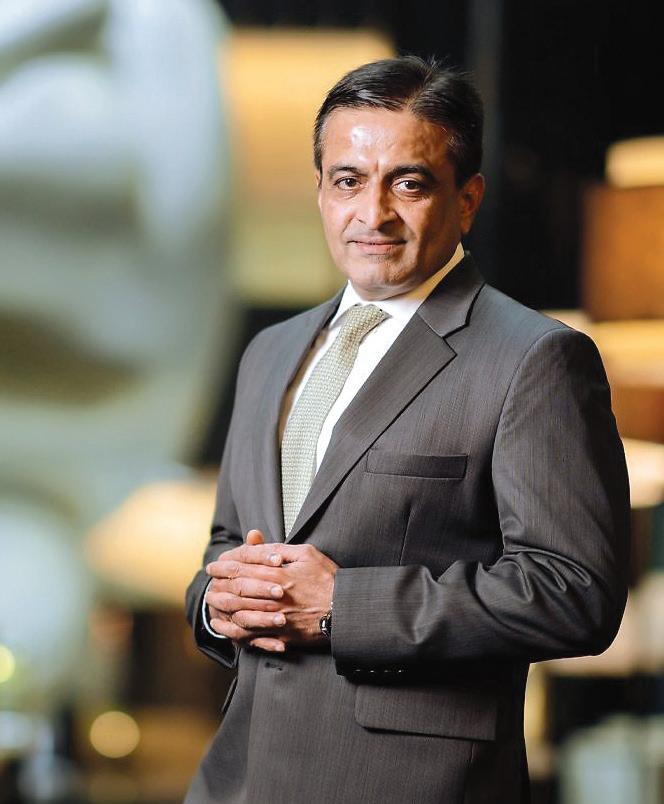
What is the core of being a hotel general manager in today’s transforming hospitality scenario?
In a rapidly transforming hospitality scenario, the focus is on building customer and colleague experience. With new technologies, there is an equal shift in guest expectations and a greater emphasis on sustainability and wellness too. A successful general manager must be agile, innovative and committed to delivering exceptional service while embracing these changes and ensuring that our values of empathy, integrity, and respect are at the heart of every interaction.
Does the role demand any focus areas/tweaks in India when compared to global postings?
In India, the hospitality landscape is unique due to its diverse cultural and regional variations. A general manager in India must possess a deep understanding of local customs and preferences to tailor guest experiences effectively. Also, there is a greater emphasis on fostering strong community relationships and contributing to local economic development, aligning with Hyatt’s value of caring for communities. Balancing these elements would be a key focus, incorporating regional
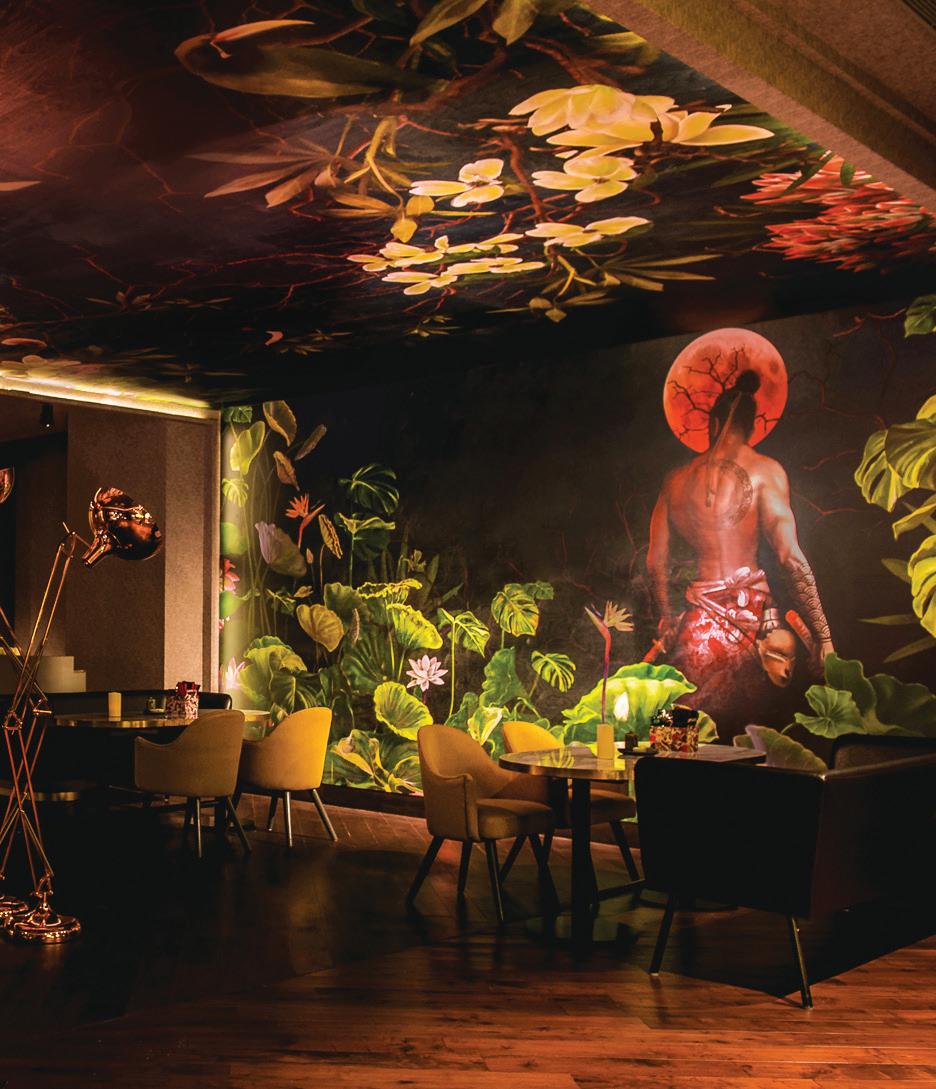
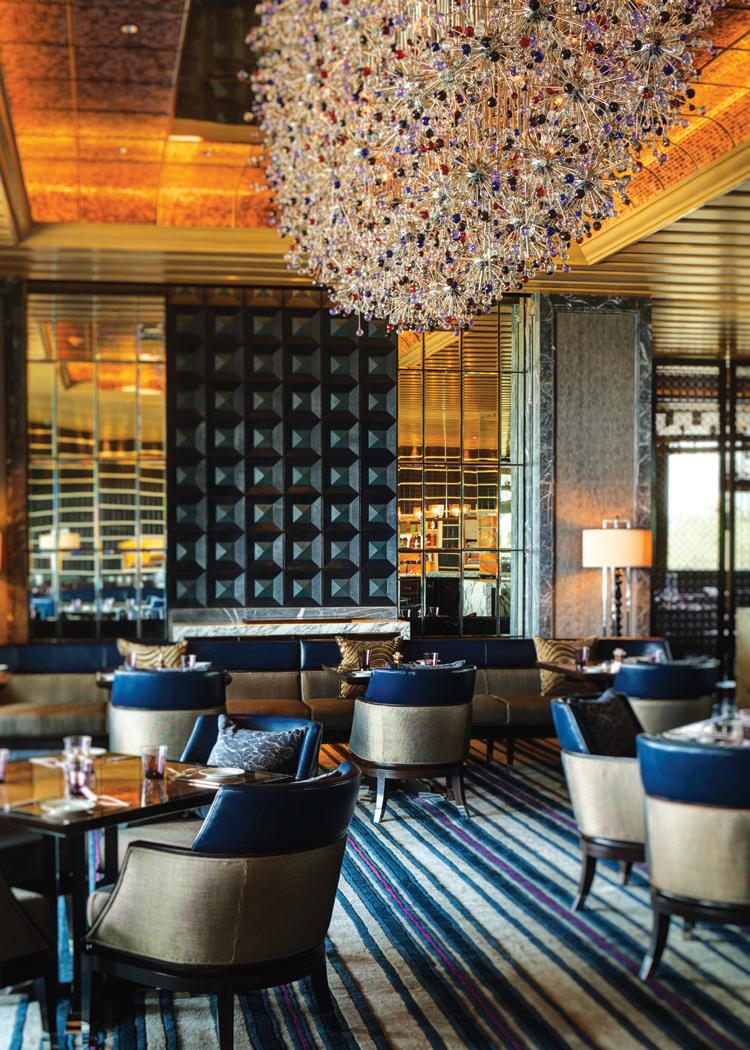
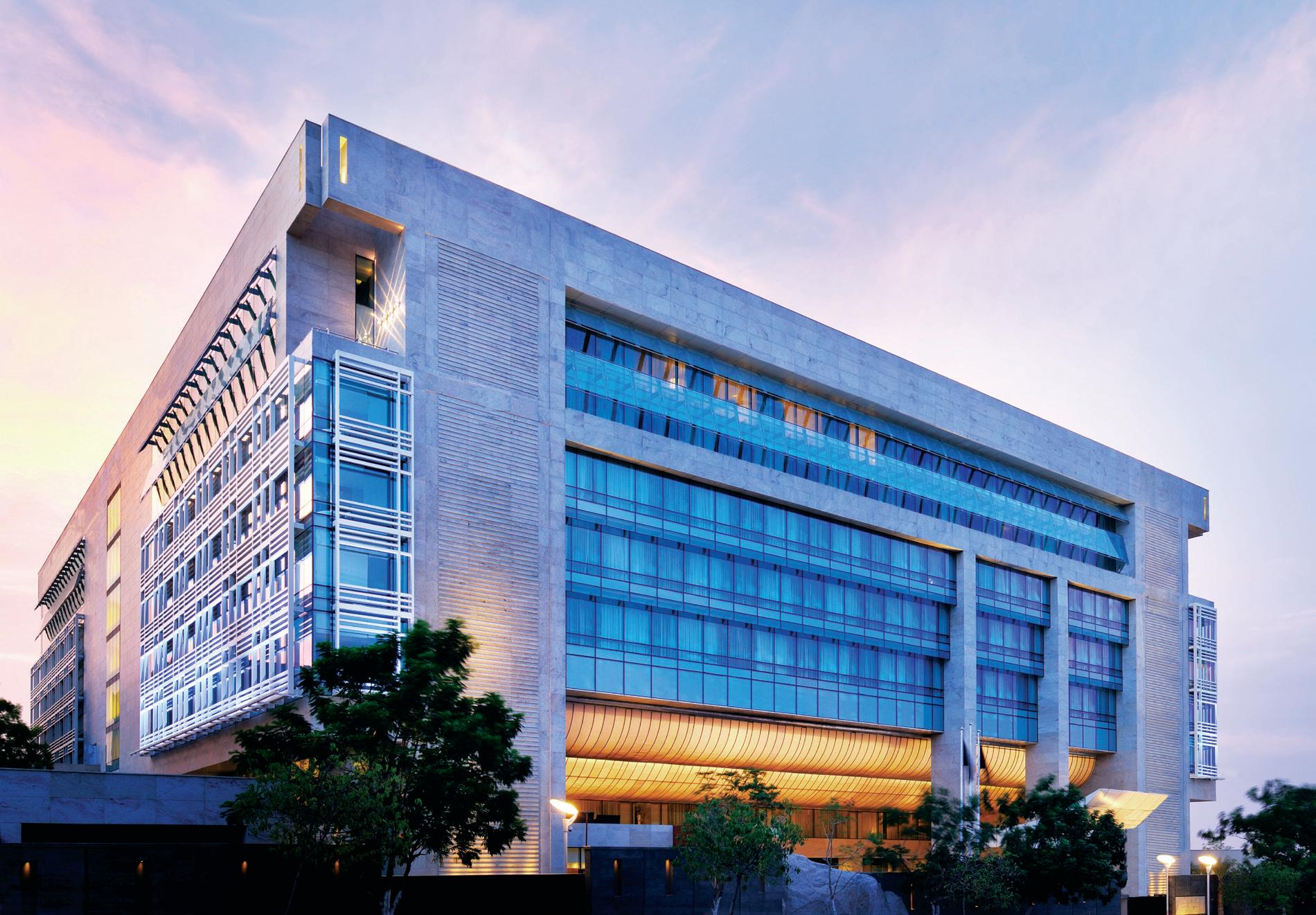
hospitality nuances while maintaining global standards.
How challenging is it to balance the demand of the brand and the aspiration of the owners of a hotel property?
Balancing the demands of the brand and the owners is one of the most intricate aspects of the role. It requires clear communication, transparency, and a deep understanding of both parties' goals. The brand focuses on maintaining its standards and reputation, while owners are often more concerned with financial performance and return on investment. Navigating these priorities requires a general manager to be a skilled negotiator and strategist.
What is the scope of your role, and how has it been evolving? How does it change from managing a single hotel to being an area director?
The scope of a general manager’s role has expanded beyond traditional management to include strategic planning, digital transformation, and sustainability initiatives. As Area Vice President, the role involves overseeing multiple properties, ensuring consistency in service quality and aligning each hotel’s objectives with Hyatt’s overall brand strategy. It also requires a broader perspective and the ability to mentor and guide multiple management teams.
What is the most challenging aspect of the job? Could you give examples of where the role of a general manager becomes crucial in addressing challenges or unforeseen situations?
The most challenging aspect
“The scope of a general manager’s role has expanded beyond traditional management to include strategic planning, digital transformation, and sustainability initiatives.”
of the job is managing crises, such as the COVID-19 pandemic, which drastically affected the hospitality industry. During such times, the general manager’s role is crucial in ensuring the safety of guests and staff, maintaining operational continuity, and implementing recovery strategies. Effective crisis management and clear communication are vital to navigating these challenges successfully.
What are the top attributes necessary to be an effective general manager?
The key attributes must include strong leadership, effective communication skills, adaptability, a keen eye for detail, and a passion for service excellence. An effective general manager must be a visionary, able to foresee trends and adopt strategies accordingly. Building and nurturing relationships with guests, staff, and stakeholders is equally important.
What have been the highlights of your career as a general manager?
Throughout my career, I have led some of the finest hotels and delivered memorable experiences to guests. A significant highlight has been overseeing a property's successful transformation and rebranding, enhancing guest satisfaction, and driving
operational excellence. One memorable achievement was spearheading a sustainability project that reduced our environmental footprint and won community recognition, reflecting Hyatt’s commitment to responsible business practices.
Additionally, I take great pride in fostering a culture of teamwork and professional growth among my colleagues, which has consistently resulted in higher engagement and satisfaction.
What would be your top tips for a new general manager?
I would recommend understanding the unique culture and dynamics of the property, building a strong team, and fostering an environment of open communication and continuous improvement. Stay adaptable, be proactive in problem-solving, and always prioritise the guest experience. It is important to also recognise the importance of community engagement and corporate social responsibility.
A general manager must lead initiatives that contribute positively to the local community and environment, aligning with the broader values of the brand and making a meaningful impact. The role of a hotel general manager is dynamic and multifaceted, requiring a balance of strategic vision, operational expertise, and interpersonal skills.

Managing Director of Horwath HTL - India Vijay Thacker tells SOH how effective risk management is a crucial strategic component that underpins robust governance and operational success. The framework involves not only identifying and mitigating risks but continuously monitoring and evaluating the effectiveness of these measures.

In the increasingly complex world of global business and significantly greater compliance obligations, risk management is an essential element for management and governance. This holds for all companies and professional sectors, including the hotel sector. The principles and practice of risk management have substantial application for the hotel sector, given the sector’s characteristic of frequent separation of ownership and management.
Risk management is mandated for all listed companies and is also required for privately held entities with private equity investments. I would suggest that risk management is essential for any business with variation only in the extent of use, depending on the individual complexity. At the outset, let me clarify that risk management remains entirely relevant for owner-managed hotels (with or without franchise arrangements) in the same manner as it remains relevant for chain-managed hotels—the responsibilities vary. Still, the key risks remain much the same.
Briefly, risk management stands on three legs:
The identification and analysis of various risks.
The design and implementation of risk mitigants.
The monitoring and evaluation of the effectiveness of the designed risk mitigants.
The foundation of risk management is strong support (nay, even insistence) from the board and leadership for a robust risk management platform. The sky is the ceiling, with the effectiveness dependent upon whether the leadership permits an opaque system or evinces strong reliance on the risk management processes. The extent and strength of governance and leadership support to the risk management framework of the entity, will ultimately determine the entity’s success in using risk management as a valuable business and governance mechanism or cause the risk management framework to itself risk failure.
Risks attendant to an entity are diverse— business, financial, operations, structure, people, compliance, environment, technology, fraud, and many others. A Risk Control Matrix (RCM) is the key reference document for an entity’s risk management efforts. Unfortunately, it seldom (or at least inconsistently) covers the third leg of risk management, i.e. the aspect of monitoring and evaluating the effectiveness of risk mitigants that have been adopted.
A simple example is: how many hotels have properly designed SOPs for each aspect of the operations? How many of these have been adapted to the specific business situations of the hotel or market characteristics, as distinct from global
standard practices of hotel chains? What is the degree of monitoring for the actual implementation and effectiveness of the prescribed control processes? How much weightage is attached to these in the context of high attrition levels and staffing controls? In the bargain, how much attention is paid to operational, fraud, and compliance risks when shortcomings in SOP implementations are observed and highlighted?
As a net result, does this render the corporate RCM somewhat theoretical about the on-ground scenario? This is not due to any inappropriate or malicious intent; it is largely the outcome of the lack of sufficient attention to performance evaluation and monitoring of the risk mitigants, and the softness in recognising the impact of
inadequacies and shortcomings. In hotels, the potential to underscore the risk is exacerbated by the limited relative value of individual transactions (or even samples) and thereby an underappreciation of the shortcomings noticed through sample review. Seldom are the results truly projected to the entire relevant data set to reflect the real/potential risk. And more seldom does one see an assessment of the impact of silent or soft tolerance of system or risk mitigant failures on the totality of the framework; the extra slack is cut before reporting failures of design or implementation of risk mitigants. This is different from the risk tolerance levels approved by the entity by the risk committee and board.
SOME OF THE KEY ASPECTS THAT HOTEL OWNERS WILL BE WELL ADVISED TO CONSIDER IN THEIR RISK MANAGEMENT PROCESS INCLUDE:
steps that the owner needs to initiate or implement. This is particularly important because several mitigation measures for the RCM are dependent upon processes and controls at the hotel.
Identifying the risk management responsibilities between owner and operator so that key matters do not fall in between and remain unattended due to differences in perceptions.
Understanding the risk implication of the contracted scope of work and responsibility of hotel operators, particularly in the context of (i) the hotel employees being employees of the owner and (ii) the indemnification provisions under hotel management agreements.
Understanding the risk assessments of the operator and how these compare with the RCM at the ownership entity level—in content, and also in terms of design, implementation, and monitoring of remediation measures. This understanding will also provide greater insight into asset management needs and risk mitigation
Assessing hotel performance not merely from the viewpoint of financial results but also in terms of the attendant risk management factors for the asset, and longterm operations, competitiveness, and profitability.
Clear identification and allocation of responsibilities on compliance matters so that compliance risk aspects are fully and appropriately addressed.
Franchise arrangements are less complex, but need a proper understanding and assessment of risks, risk mitigation responsibilities, and resultant liabilities.
OWNER-MANAGED HOTELS (AND PORTFOLIOS) NEED AN EQUALLY HOLISTIC RISK MANAGEMENT APPROACH AT THE OWNERSHIP LEVEL—THE ASSESSMENT SCOPE SHOULD LARGELY REMAIN THE SAME, BUT THE RESPONSIBILITIES FOR MITIGATION IN ALL ITS ELEMENTS (DESIGN, IMPLEMENTATION, AND EVALUATION) REST ENTIRELY WITH THE OWNING COMPANY.
My experience shows that hotel-owning and operating entities would do well to pay more attention to the following aspects:
The aspect that risk management is an ongoing exercise and not a one-time exercise. Business, and its underlying conditions and competitiveness, are dynamic, and it is therefore necessary to address the subject of risk management regularly—to believe that this is a one-time exercise, with moderately evaluated updates to the RCM in subsequent years, is an approach that is deeply fraught with risk.
Lack of systematic performance evaluation of the identified risk mitigation measures—seldom is there a clear evaluation and assessment of the actual outcome and the ultimate impact, with multiple reasons (mainly resource constraints) explaining away the errors noticed or the lack of implementation or absence of effectiveness of risk mitigants.
Unawareness or substantially inadequate attention to three key risks that have emerged in the current operating environment—third-party risk, cyber risk, and data security risk. These are newage risks but of substantial magnitude and impact. Largely, these risks are not sufficiently understood, identified, addressed, and monitored particularly given the dynamic nature of modern business and its operating structures.
Risk management is an essential element of governance. It does carry a negative fundamental connotation. By its very nature, risk is not a word people like to hear, talk about, or even admit. Yet, risk management is a ‘scrub’ that helps the business and the company in the long term; the more open (and detached) the acceptance and discussion around it, the better the beneficial value. Thus, risk management must be rigorously institutionalised.
The gains from risk management
It helps minimise governance failure, particularly when the company’s system is robust and not considered as a ‘have to do’ for regulatory compliance.
It establishes better standards for the company, its management, and its counterparties.
It helps create larger valuations because smart investors recognise the value of good risk-based governance.


K Raheja Corp’s hospitality gambit, headed by Neel Raheja, has set new grounds by forging strategic partnerships and efficient asset management. While Raheja focuses on company’s strategic expansion, CEO Sanjay Sethi explains the group's recent moves, including acquisitions and expansion.
SUMAN TARAFDAR
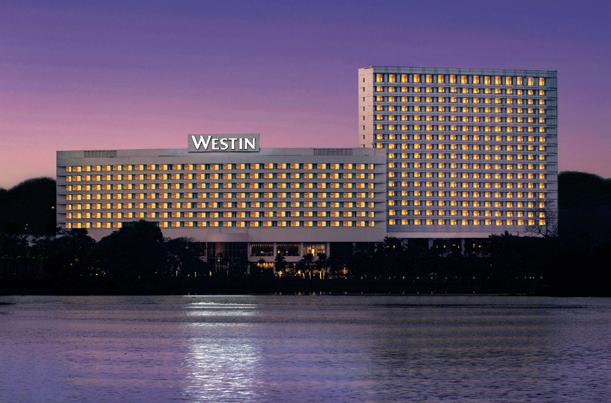

With a hospitality portfolio of over 3,050 hotel keys, over two million square feet of office space, a luxury residential project and a pipeline of new projects in hospitality and real estate, Chalet Hotels Limited is already one of the leading players in the Indian hospitality space. What is even more noteworthy are some relevant numbers—its consolidated net profit rose 121.6% in the fourth quarter of fiscal 2024, which has considerably outpaced competition in Q4 FY’23 in revenue growth and EBITDA margins (including competition such as IHCL, EIH, Lemon Tree).
Right at the helm of the group is Neel Raheja, President, K Raheja Corp, who marries real estate and hospitality in a thriving mixed-use model.
To understand Chalet’s meteoric rise, we have to understand how a real estate company turbocharged its hospitality business. In 2019, Neel Raheja gained attention for leading the launch of the IPO of Chalet Hotels Ltd., the hospitality arm of K Raheja Corp. This marked the first IPO in the hospitality sector for the group, aiming to raise ₹1,641 crore to expand its operations, which required urgent capital infusion.
Since then, Chalet Hotels has emerged as a powerhouse in the industry, reflecting the strategic foresight and innovative spirit of the K Raheja Corp group, which has been a pioneer in India's real estate and hospitality sectors for over four decades.
K Raheja Corp, one of the earliest real estate companies to enter India's hospitality space, boasts over four decades of expertise and is recognised as a leading developer in the country. Raheja highlights the group's impact: “From adaptive workplaces to exquisite residences, skillfully
The Indian hospitality sector has shown a strong recovery postCOVID, presenting significant expansion opportunities, with 2023 reporting significant recoveries, record rates and occupancies. “The primary focus during the pandemic was on preventing virus spread, leading to innovative solutions such as transforming hotels into quarantine centres,” explains Sanjay Sethi. “While this addressed immediate needs, it also brought about changes in hotel design and operations, emphasising social distancing, contact-free systems and automation.”
“With demand growing at 3080% post-COVID, depending on the segment and location, and expected to stabilise at a steady growth rate of over 10%, the industry is poised for sustained growth. While supply growth is projected to remain slower than demand over the next four to five years, it creates a favourable opportunity for institutional developers like ourselves.
“The current demand surge is driven by a genuine need for travel both business and leisure rather than temporary events like the G20 summit or the cricket World Cup. This sustainable travel trend offers a solid foundation for expansion. There is also a strong evolution of new demand drivers from destination weddings to religious travels and Bleisure i.e. combining business travel with leisure. At Chalet Hotels, we see tremendous opportunities in catering to corporate travellers and the meetings, incentives, conferences, and exhibitions (MICE) segment. Our strategic locations in major gateway
cities such as Mumbai, Pune, Hyderabad, and Bengaluru, along with our upcoming hotel at Delhi Airport, position us well to capitalise on this demand.”
Hospitality ownership business is capital intensive and a brick-and-mortar business that can take three to six years, Sethi points out. “The trends that we see are in favour of demand. The Indian hospitality industry is expected to reach $247.31 billion in 2024 and grow at a CAGR of 13.96% to reach $475.37 billion by 2029. This growth is fuelled by an increase in the number of hotel projects. India is set to welcome 481 new hotel projects with 57,879 rooms, as major hotel chains expand their footprint, especially in Tier-2 and Tier-3 cities.
According to the World Travel and Tourism Council, the contribution of travel and tourism to India's GDP is expected to be 6.7% per year, between 2019 and 2029, providing ample opportunities for the hospitality industry, though COVID-led interregnum has made predictions more difficult.
The Indian government has undertaken various initiatives to attract more tourism which is driving the growth in the hospitality sector and, the surge in demand for branded hotels in Tier-2 and Tier-3 cities. Driven by increased travel, improved connectivity, and economic growth, there is a rising demand for branded hotels in smaller cities across India.
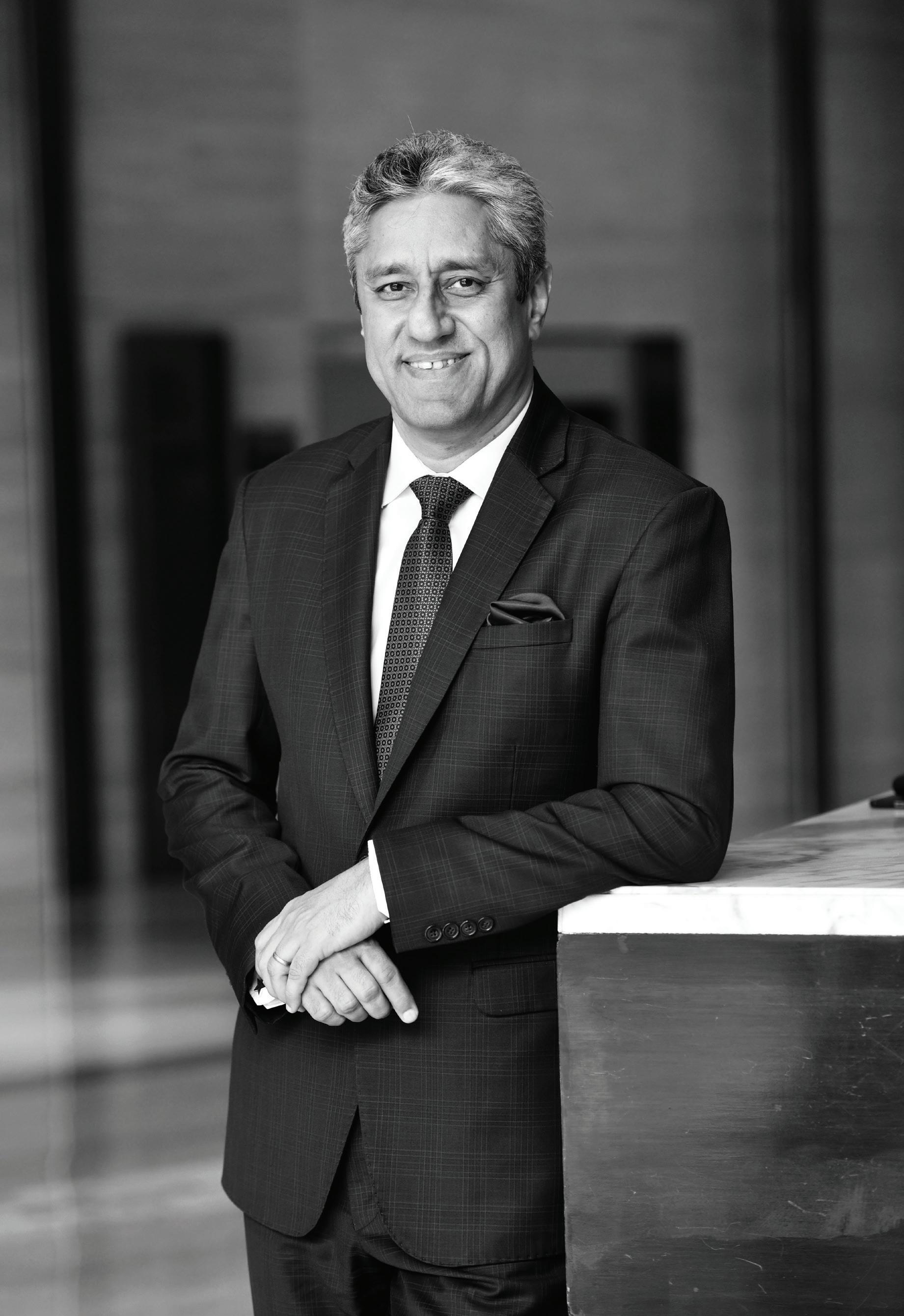
“Chalet Hotels has achieved notable success through strategic initiatives such as selecting prime property locations, right brand partners, optimising operations, diversifying revenue streams, and staying adaptable to market trends.”
designed hotels and convention centres to retail destinations, we have significantly influenced the evolution of modern-day living.”
Educated at Harvard Business School, Neel Raheja learned the business from his father, property tycoon Chandru Raheja. Raheja states, “We have pioneered the development of self-contained townships in the country, continually crafting state-of-the-art spaces to meet the ever-changing demands of consumers. Our diverse business portfolio spans multiple sectors, including commercial real estate through Mindspace Business Parks (REIT), hospitality via Chalet Hotels Ltd., retail with Shoppers Stop Ltd., shopping malls through Inorbit
Mall, and residential projects under K Raheja Corp Homes.”
K Raheja Corp's strategic expansion into hospitality aligns with its broader vision of creating comprehensive mixed-use developments to meet diverse customer needs. Raheja explains, “We ventured into the hospitality sector in 2000 with the launch of the iconic Renaissance Hotel (now The Westin Mumbai Powai Lake) on the banks of Powai Lake in Mumbai. This move responded to a growing demand for luxury accommodations in a market previously underserved by highend hotels.”
Since its modest beginnings, Chalet Hotels Ltd. has evolved into a leading industry player. Today, it

is a prominent owner, developer, asset manager, and operator of high-end hotels. The company’s portfolio spans key metropolitan cities across India, including Mumbai, the National Capital Region, Hyderabad, Bengaluru, and Pune. Raheja asserts, “Chalet Hotels Ltd. is committed to driving business efficiencies and sustainable growth, managing every asset throughout its lifecycle to maximise returns.”
By integrating hospitality into its mixed-use developments, K Raheja Corp has crafted holistic environments catering to modern business needs. Raheja adds, “A prime example is our development in Telangana, which includes the Mindspace Business Park, two
THE GROUP’S PORTFOLIO COMPRISES 10 FULLY OPERATIONAL HOTELS REPRESENTING 3,052 KEYS, ACROSS MAINSTREAM AND LUXURY SEGMENTS, AND COMMERCIAL SPACES, REPRESENTING 2.4MSF NEAR THE HOSPITALITY ASSETS.
THE ANNOUNCED PLANS INCLUDE THE EXPANSION OF MARRIOTT BENGALURU AND DUKES LONAVALA, ALONG WITH TAJ PALACE, NEW DELHI, HYATT REGENCY, AND CIGNUS POWAI TOWER II, MUMBAI
“WE HAVE A DEFINED PIPELINE OF 865 ROOMS TO BE ADDED BY FY’27 THROUGH EXPANSIONS AND TWO NEW HOTEL ADDITIONS IN AIROLI, MUMBAI AND TERMINAL 3 OF DELHI AIRPORT,” SAYS SETHI. “THERE IS ONE NEW COMMERCIAL TOWER OF 0.9MSF UNDER DEVELOPMENT IN POWAI, MUMBAI.”
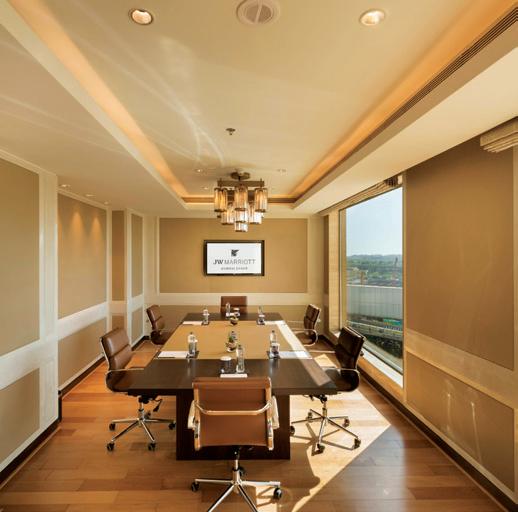
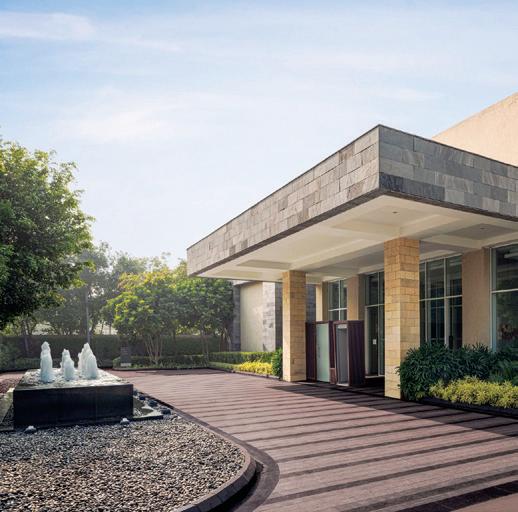
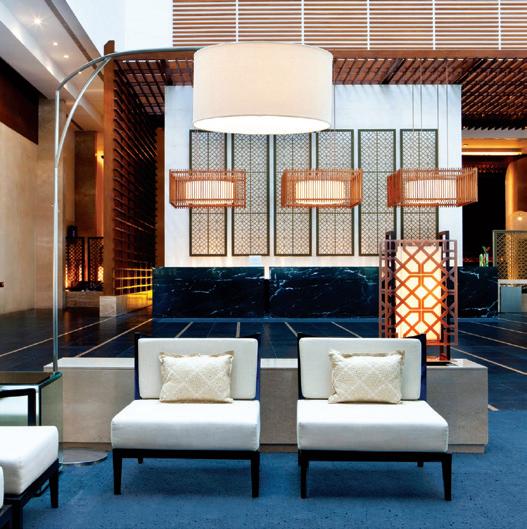
“
To accelerate growth, we plan to enhance our marketing efforts, invest in technology to improve customer experiences and expand our property portfolio in key location.”
Over the years, Chalet Hotels has strategically streamlined its operations by partnering with renowned hospitality chains such as Marriott, Accor, Hyatt, and IHCL. Additionally, Chalet’s innovative approach to design and development, emphasising optimal gross built-up area and development costs, has resulted in high-quality properties that address diverse market needs. “In line with its commitment to create a greener future, the company has integrated aspects of ESG across the value chain into its business model, some of these initiatives include protecting the environment, uplifting our communities, and demonstrating rightful business conduct. Most importantly, strong, people-centric leadership, focus on governance, and a commitment to fostering a positive organisational culture have driven high performance and sustained growth,” says Raheja.
property locations, right brand partners, optimising operations, diversifying revenue streams, and staying adaptable to market trends. “This has enhanced our profitability and competitive stance in the Indian hospitality market. A key part of our strategy is leveraging the demand from nearby office spaces, which helps maintain a strong customer base.”
Chalet Hotels had a robust quarter and year ending March 2024 with several additions to the portfolio. Revenue and operating profits grew by 22% and 20% respectively while PAT had multifold growth during FY’24, though the results seem to have missed some analysts' estimates.
While many in the industry are moving towards a model of reduced asset ownership and focusing on hotel management, Chalet Hotels distinguishes itself by investing in its assets, efficiently expanding its balance sheet and EBITDA. The company's high EBITDA margins result from its design efficiencies, focused asset management and strategic partnerships with various hotel operators. Additionally, its long-term success is rooted in significant investments in largescale, asset-heavy hotels situated in prime locations across major and emerging cities.
‘The Westin Hotels,’ residential offerings, and an Inorbit Mall that also houses a Shoppers Stop. This integrated ecosystem not only showcases our ability to create cohesive environments but also strengthens the potential and success of such mixed-use ventures.”
Managing Director & CEO Sanjay Sethi picks up from where Raheja leaves off. He talks about how Chalet Hotels has achieved notable success through strategic initiatives such as selecting prime
Chalet Hotels has committed a sizable amount of capital to projects in high-growth markets with strong fundamentals and return projections. “These funds have been instrumental in paring down debt, thus strengthening our financial position and providing us with the flexibility to invest in our expansions,” explains Sethi, a Taj Hotels veteran who joined Chalet in 2018, ahead of the company going public in February 2019.
Chalet is well-positioned for growth and success, having recently raised ₹10 billion through



In the global hospitality context, India has been seen as a big laggard in the rate of development. Indeed, within the sector, it is almost a truism that there will be a delay in a hotel opening.
Qualified Institutional Placement (QIP) on April 3, 2024, which has been effectively used to reduce debt, he says. “This financial manoeuvre has strengthened our balance sheet and ensured greater fiscal stability. Additionally, we have expanded our portfolio by acquiring the Courtyard by Marriott Aravali with an enterprise value of ₹3.15 billion, further enhancing our market presence.”
The group has reported an across-the-board rise in occupancies and ARRs in its latest results, which are indicators of a positive response to the group’s strategic initiatives, says Sethi. “To accelerate growth, we plan to enhance our marketing efforts, invest in technology to improve customer experiences and expand our property portfolio in key locations. Additionally, we aim to strengthen our partnerships and explore new revenue streams to drive sustained growth.”
Several factors impact development—capital financing, developmental and operational approvals, operating licenses, availability of land, having the right project executing team, etc., points out Sethi. “We have been working with the government to improve the approval cycles and implementation of single window clearances. A track record of developing hotels for the last 25 years and the umbrella of a larger real estate group leads to a greater understanding of the development cycle and cost management. Strong knowledge about infrastructure movement helps in understanding the next growth location. Chalet's design, development and liasoning teams with expertise in hospitality, support the project.
“Efficiency of design and focused asset management has been a distinguishing factor for Chalet. The group has a unique advantage in understanding the development cycle and cost management. This expertise supports the project and ensures efficiency in design and focused asset management, which has been a distinguishing factor for Chalet.”
The recent acquisition of Courtyard by Marriott, Aravali Hills by Chalet made the sector take notice. The strategic acquisition was driven by the company's long-term vision to diversify its portfolio and capitalise on the growing demand for leisure destinations in the National Capital Region (NCR).
“The acquisition is a strategic fit for Chalet Hotels, given the numerous drivers,

“Efficiency of design and focused asset management has been a distinguishing factor for Chalet.”

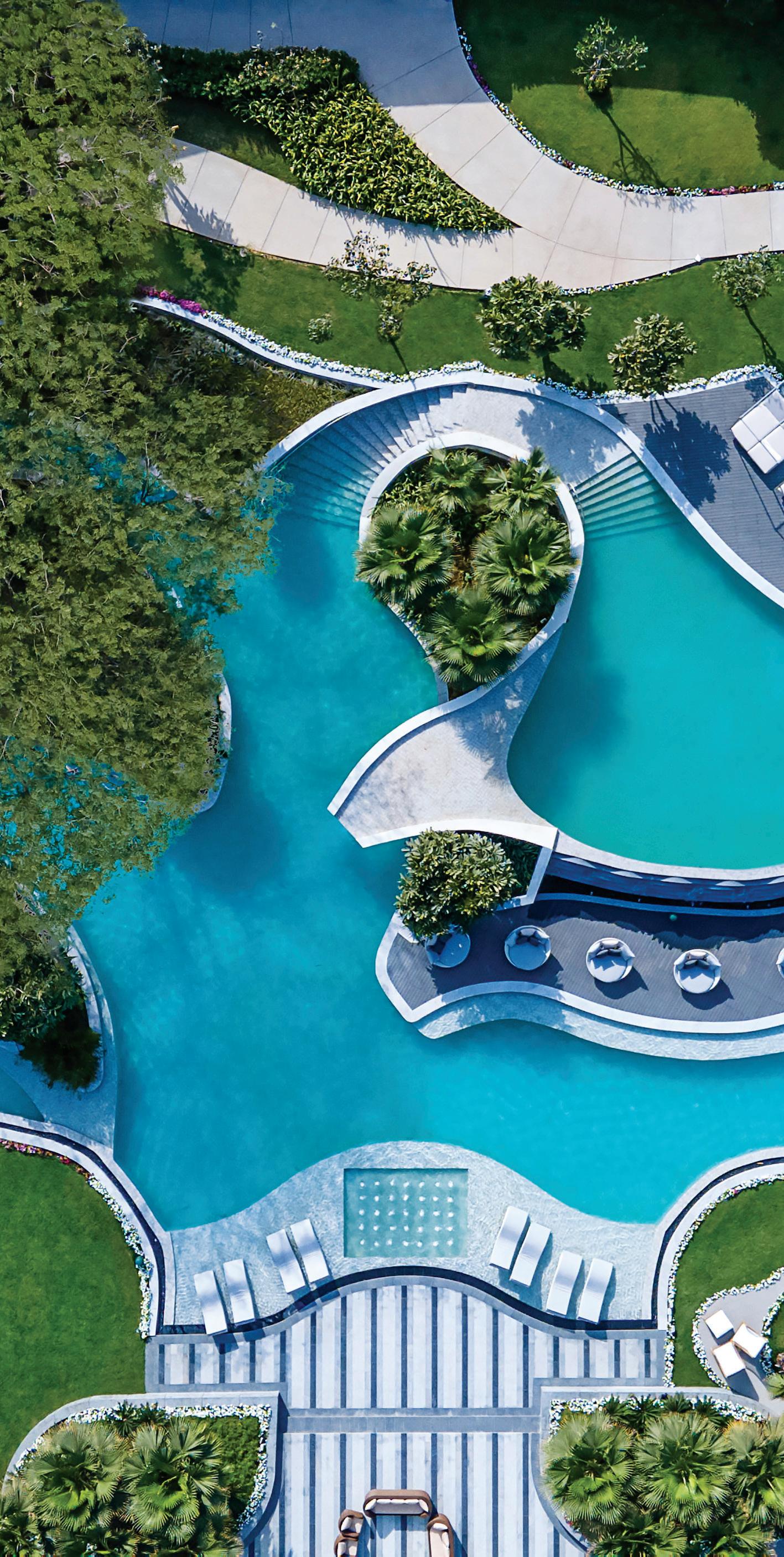
which contribute to the region's popularity,” elaborates Sethi. “These drivers include social events, business conferences, and family getaways, which ensure a consistent stream of guests. The property’s strong performance potential and accretive nature to the company’s portfolio, make it an attractive addition to their portfolio. This strategic move is expected to contribute significantly to the company's growth prospects over the next four to five years, as it capitalises on the supply-demand arbitrage in the country.”
Two factors played a big role: that it is a leisure property, at a driving distance from the National Capital Region. “Drivable distance from NCR is a great market with many drivers—social, MICE, and family getaways. It is a great asset with strong performance potential and is an accretive asset to our portfolio. An additional 6.5 acres of undeveloped land can be leveraged to enhance the property’s offerings and increase its revenue potential.”
Chalet Hotels' commitment to expanding its portfolio through strategic acquisitions is evident in its recent deals, including the acquisition of Dukes Retreat at Lonavala. These moves demonstrate the company’s focus on diversifying its offerings and increasing its presence in key markets.
Chalet Hotels' entry has spurred competition and innovation within the market, says Sethi. “Our strategic investments in prime locations and high-quality properties have set benchmarks for development and service delivery. By attracting international brands and leveraging economies of scale, companies such as Chalet have contributed to the modernisation and expansion of India’s hospitality sector. In essence, the entrance of institutional players such as Chalet Hotels has not only diversified ownership structures but also
elevated the professionalism and competitiveness of the Indian hotel industry, ushering in a new era of growth and development.”
Chalet Hotels has major expansion plans. “Our new room inventory should be close to 4,000 keys by FY’27 on the announced plans from 3,000 today. We are also proud to have launched The Westin Hyderabad HITEC City at Mindspace, featuring 168 rooms and operated by an all-women team, showcasing our commitment to diversity and innovation in our operations,” stresses Sethi. “The increased capacity at Novotel Pune Nagar Road by adding 88 rooms to the current inventory, so that we have 311 rooms, signifies our ongoing efforts to cater to the growing demand. These strategic initiatives position us strongly, though we remain mindful of the challenges such as market volatility and operational costs, which we are prepared to navigate with our robust plans and proactive actions. By reducing our debt and investing in high-potential projects, we are positioning Chalet Hotels for sustainable long-term
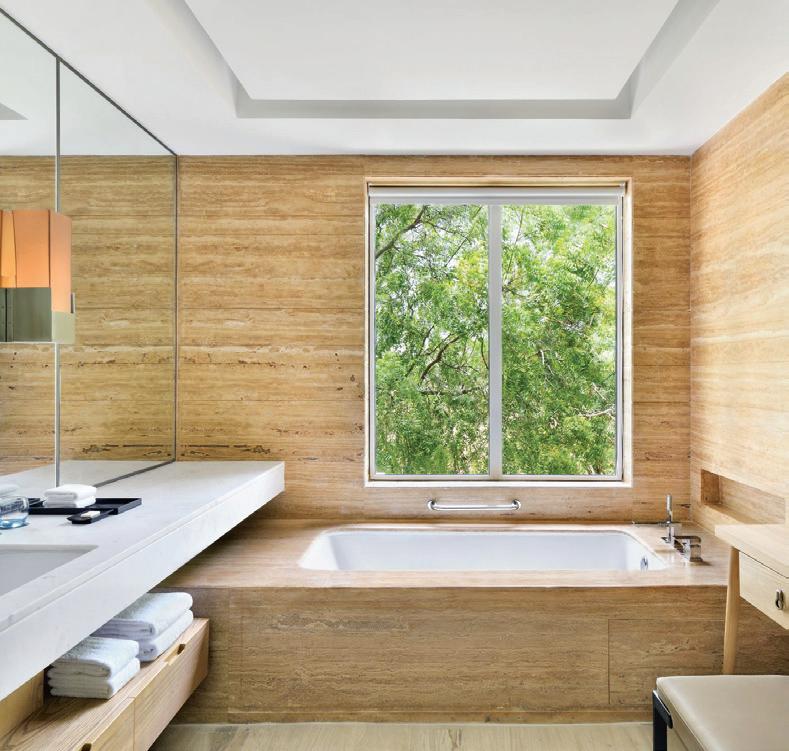
growth and enhanced market presence.”
There has also been speculation that Chalet will operate its brand. Sethi deflects. “Chalet is in a sweet spot with a healthy balance of properties managed by operators and assets that are self-managed by us,” he says. “We have been dabbling with the idea of having our brand for some time. We might have an opportunity to test it out with a couple of unflagged properties that we manage. The company has not made any decision on the same yet.”
With 10 operating hotels, Chalet has developed a strong asset management team capable of managing operations. “As a franchisee, Chalet can focus on its assets and the needs of its guests. Globally, franchising is a more prevalent concept as it offers operators faster growth, and the franchisee is in a better position to manage costs and focus on asset returns.”
Chalet has recently also expanded to office/commercial spaces. Currently, less than 10% of
revenues come from office assets as the company is in the process of leasing a significant portion of the 2.4 million sq.ft. of office assets it owns. “Offices have been a complementary asset in a hotel-led development for Chalet. To seal the development potential of a larger land parcel we have developed high-end office spaces in the central business districts of Mumbai and Bengaluru, where we already have significant hotel rooms. These assets offer a high return on investments as the land is at historical costs and is not separately purchased for commercial development. The offices benefit from the high-quality hotel assets within the complexes and deliver healthy rentals.”
The company has set ambitious sustainability targets, including sourcing 100% of its electricity from renewable sources by 2031, and has implemented various measures across its portfolio to reduce its environmental impact. It is its financial and physical expansion that the sector is going to be tracking more closely though.

Creating a positive partnership between hotel owners and brands requires a balanced approach that aligns interests and maximises mutual benefits. Sanjay Sethi makes three suggestions:
It's crucial to establish a culture of openness and transparency right from the start. This means clearly defining expectations, goals, and performance targets. Regular meetings and updates between owners and brand representatives help maintain alignment and quickly address any issues that arise.
Negotiate agreements that are fair and beneficial for both parties involved. Clearly outline roles, responsibilities, and financial arrangements to prevent misunderstandings. These agreements should motivate both sides to work towards shared goals such as delivering exceptional service, achieving profitability, and enhancing guest satisfaction.
Foster a collaborative approach to decision-making. Involve hotel owners and brand managers in important decisions affecting operations, marketing strategies, and property improvements. This collaborative effort not only builds trust but also allows for leveraging the expertise and insights of both parties to drive innovation and efficiency.
Haresh Manshani speaks about Hybec's journey to becoming a trusted name in lighting.
SOH lists out unique products and services that add value to the hospitality industry and redefine the guest experience.
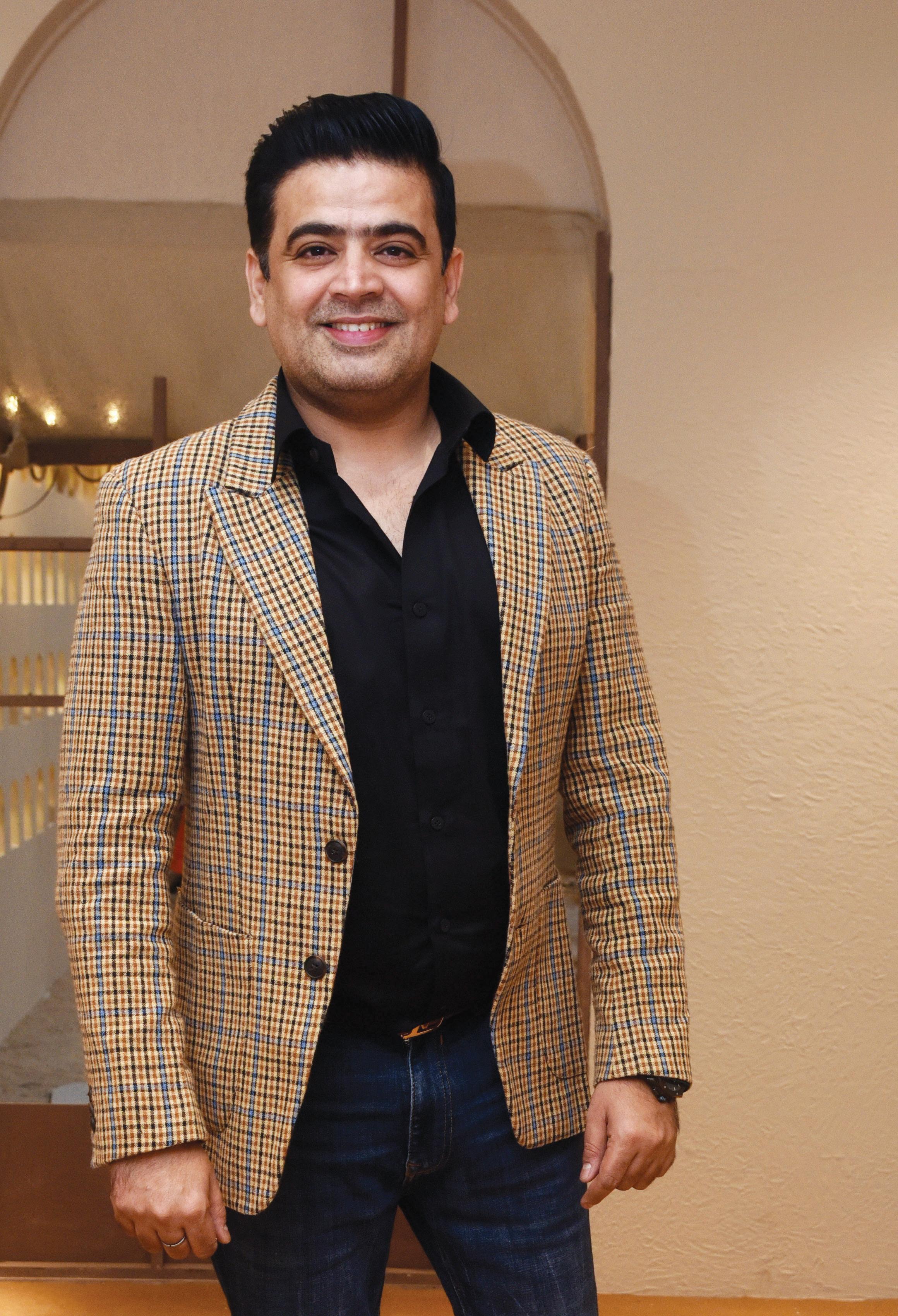
Onis understands the significance of the perfect glass and is committed to the philosophy of elevating the drinking experience of guests. Its newly launched Divergence series in barware embodies the belief that be it cocktail, wine or beer, the right glass enhances the taste, smell and appearance of the drink, and leaves a lasting impression on guests.
Conceived by Belgian designer Dries Vanlerberghe at the Glassology contest, the glassware collection comes with an ergonomic tactile design and art deco aesthetics.
X factor: Durability and versatility.
Available in: Various combinations.
Website: www.ahinternational.in
Contact: Vaibhav Poddar +919351511683
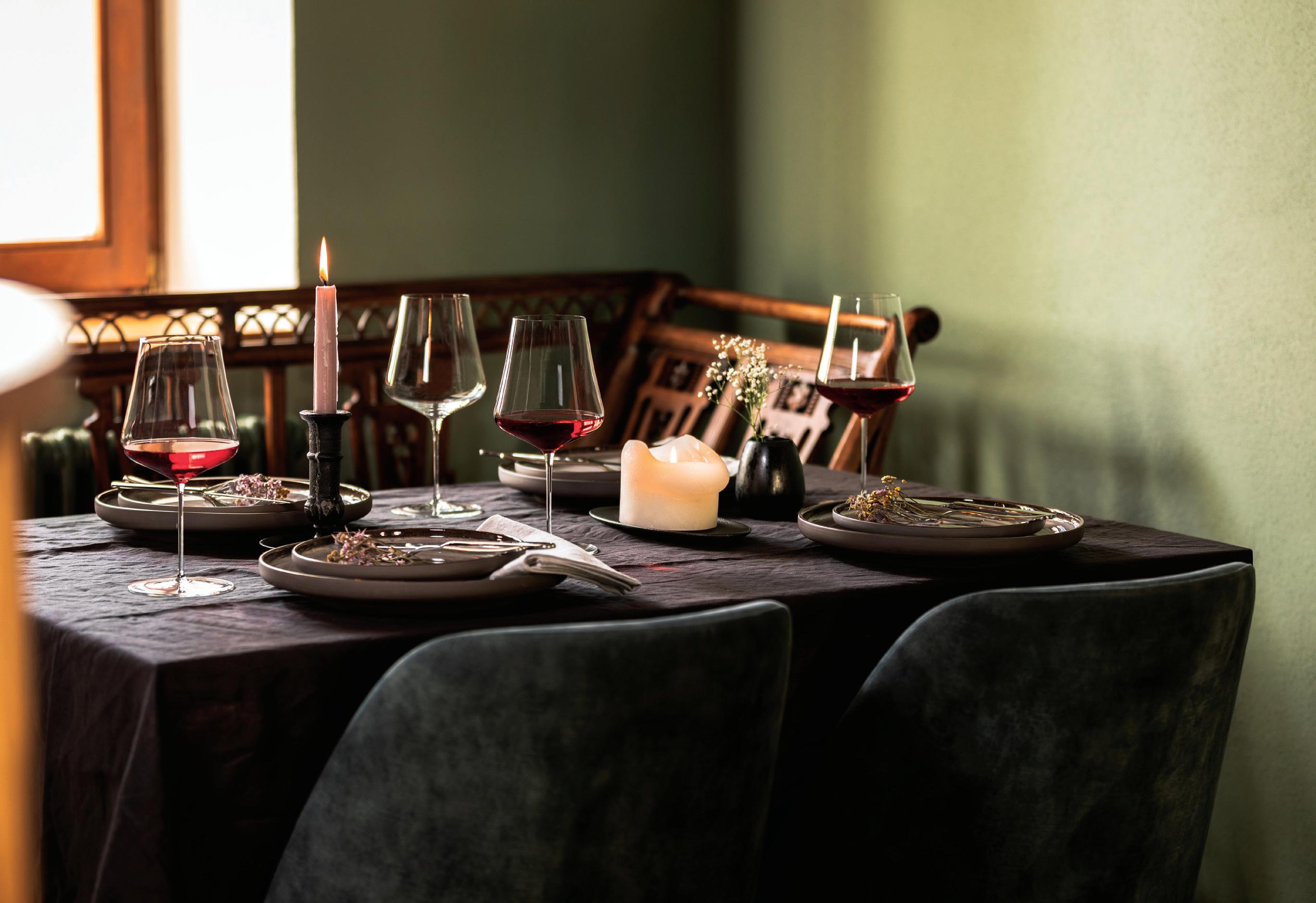

Hands carpets have long been synonymous with ‘art on the floor’—a concept which takes on new meaning with the new collection inspired by the original artworks of Larry Roberts, a visionary colourist from Chicago known for his abstract figurative, expressionist, and impressionist paintings. The collection comprises five trademarked carpet designs, which are made to order and meticulously handcrafted using New Zealand Wool and Mulberry Silk, which bestows the product the innate ability to capture the subtle interplay of light.
X factor: Timeless and luxurious.
Available in: 8 ft x 10 ft.
Website: www.handscarpets.com
Contact: +919313341775



Founded on the principle that great design goes deeper than aesthetics, Carnegie has championed responsible innovation for over 70 years, developing durable and healthy alternatives to PVC. Carnegie Siltech Plus is a premium line of high-performance siliconecoated upholstery fabrics. These fabrics are designed for superior durability and performance, delivering unmatched scratch and tear resistance, along with incredible stain resistance and ease of cleaning. Ideal for hightraffic spaces, Carnegie Siltech Plus provides a robust and sustainable alternative to PVCbased textiles without sacrificing aesthetics or functionality.
X factor: Durability and performance.
Available in: Various collections.
Website: www.carnegiefabrics.com
Contact: +919820500581

hansgrohe's DuoTurn concealed mixer offers high freedom of movement and convenience. A turning mechanism that no longer requires pulling when switching, regulates the water quantity and temperature. The lower handle allows users to adjust the temperature, while the upper one lets them switch from overhead to hand-held shower and control the amount of water with just one turn. DuoTurn is available in matte black, matte white, brushed bronze.
X-factor: Functional and elegant.
Available in: Three surface finishes.
Website: www.hansgrohe.in
Contact: +9102066259500
STAAH’S NEW ‘DAY-USE’ ROOM FEATURE ENABLES HOTELS TO DIVERSIFY REVENUE STREAM
With the ‘Day-use room’, New Zealand-based hospitality solutions provider STAAH has launched a feature that will benefit both travellers and hotels. Day use rooms are designed to cater to the needs of travellers who require a comfortable space for a portion of the day—rather than an overnight stay—to freshen up, catch up on work, and even rest before continuing on their journey. The feature also empowers hotels to attract this new breed of customers and generate an additional revenue stream by capitalising on their room inventory during quieter periods.
X-factor: Empowering and convenient.
Website: www.staah.com
Contact: +919099912083



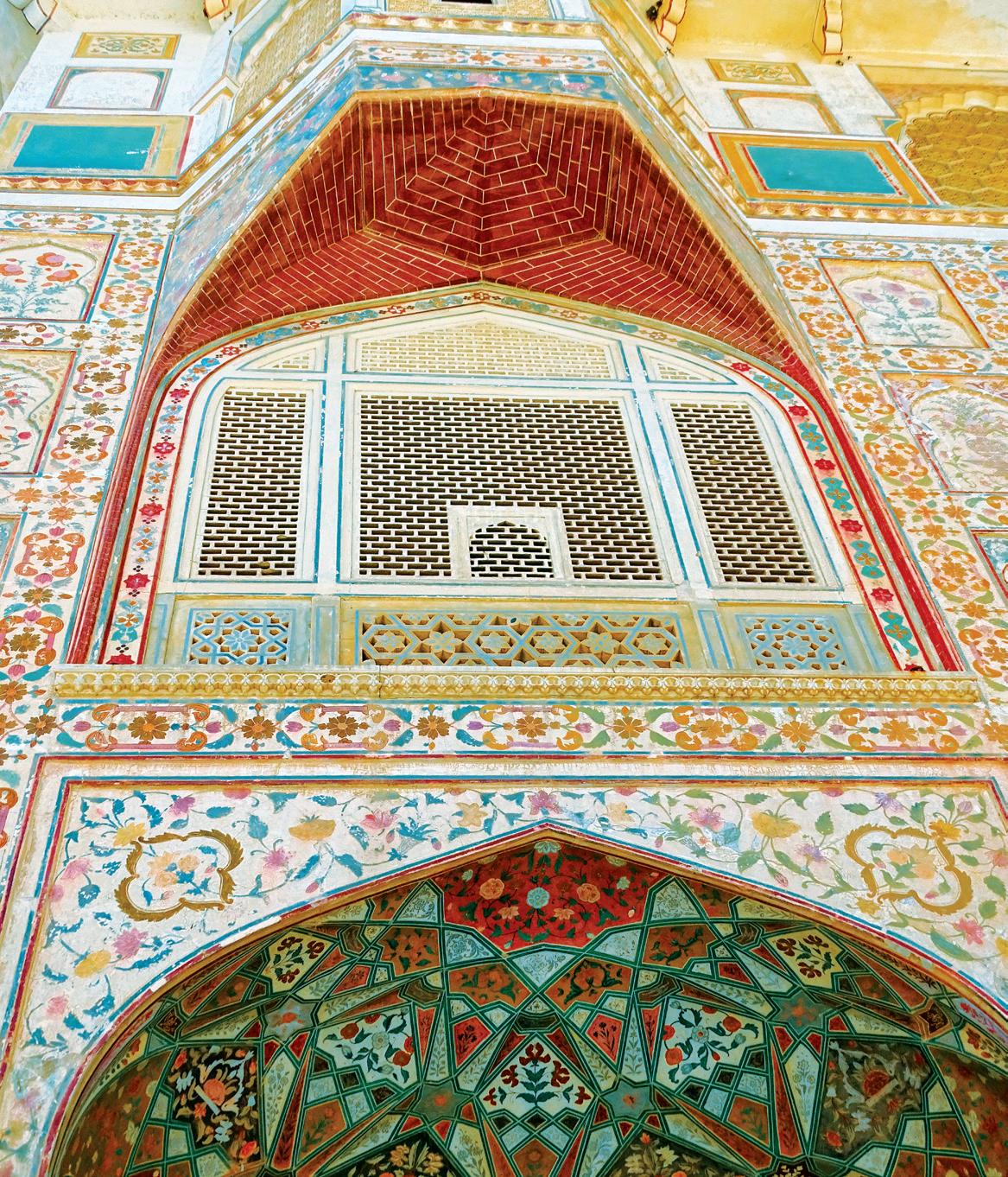
Jaipur's heritage crafts are experiencing a resurgence thanks to innovative brands that blend tradition with technology to cater to the evolving needs of the hospitality industry.
Jaipur boasts a rich history of trade and craftsmanship. In 1727, when Maharaja Sawai Jai Singh shifted his capital from Amber to Jaipur, he envisioned a meticulously planned business city where tradesmen and artisans exchanged ideas.
Today, after centuries of cross-cultural exchanges, Jaipur has fostered a thriving environment for businesses, particularly those relying on skilled artisans who have inherited techniques passed down through generations. Much of this tradition has now been modernised while keeping the soul of craftsmanship alive.
As a tourist hotspot, Jaipur has a booming hotel industry and is home to several brands that uphold the ‘Made in India’ ethos. These brands cater to the diverse needs of the hospitality industry, offering everything from furniture to decor and accessories.
Jaipur-based businesses have made their mark globally in the hospitality industry through commissioned furniture, pottery and art.
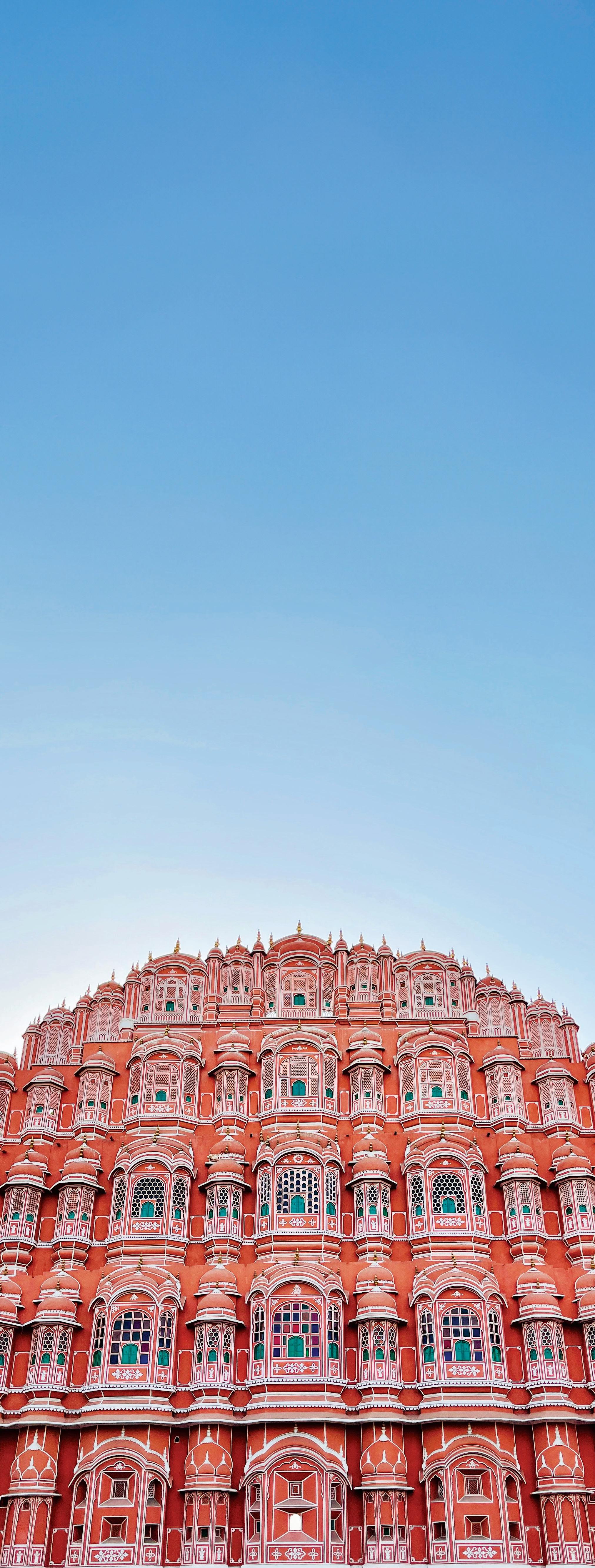


Distinguished by its blue dye, floral patterns, and animal motifs, Jaipur's blue pottery has become synonymous with the city.
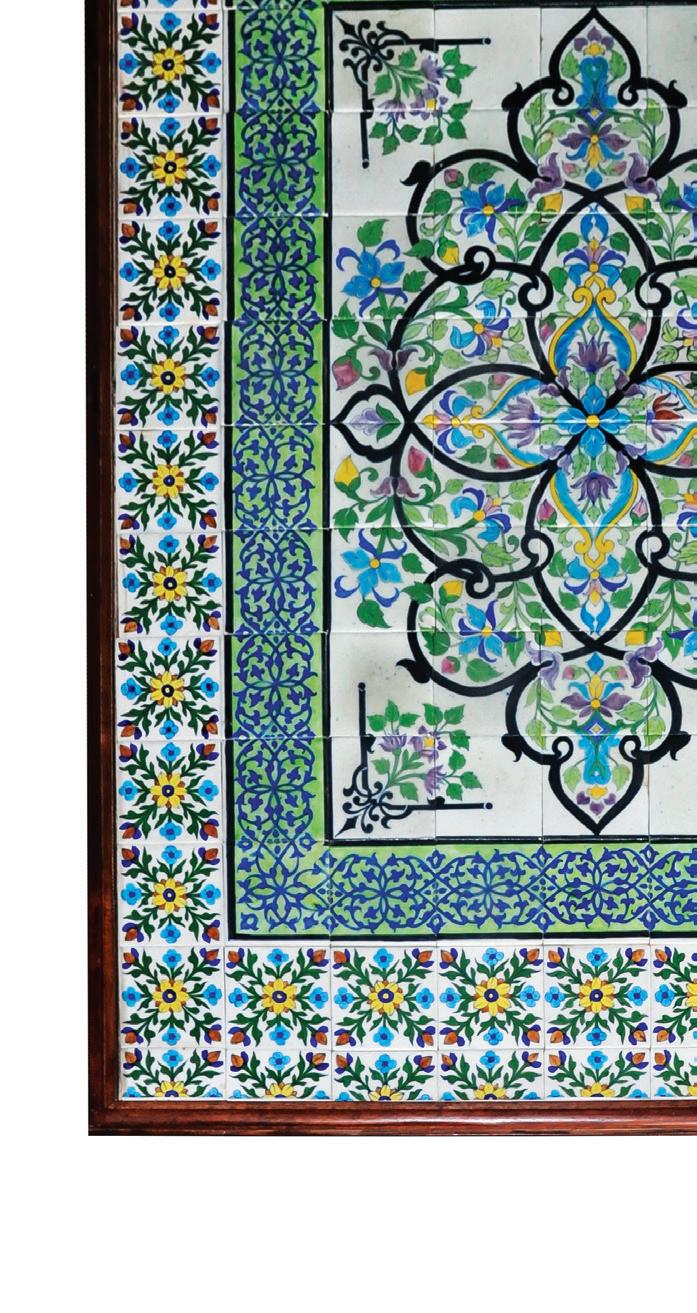

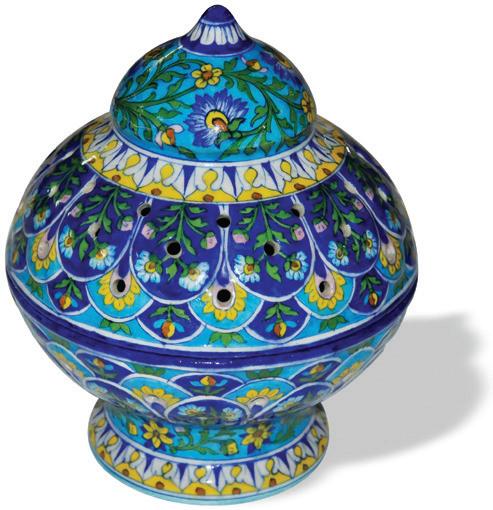


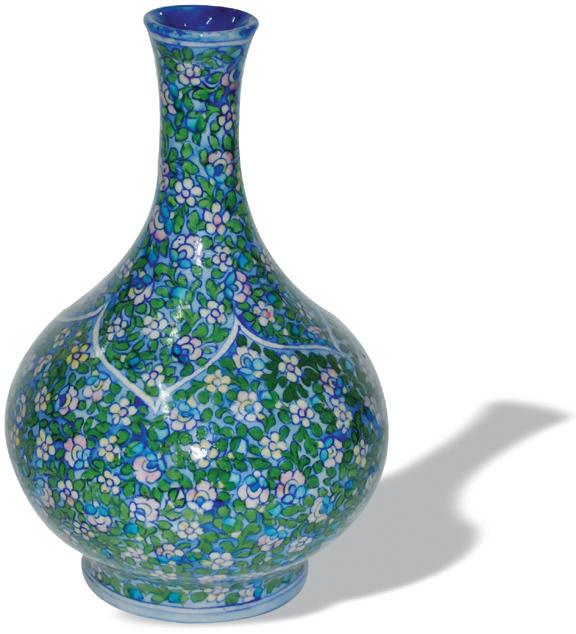
Jaipur Blue Pottery is a unique craft deeply rooted in the city's cultural heritage. Originating in Persia and evolving through Turkish Iznik and Chinese influences, it has become iconic and synonymous with the city. The uniqueness of Jaipur Blue Pottery lies in its blue dye, floral patterns, and intricate animal motifs. It has earned a Geographical Indication (GI) tag, ensuring that only pottery made in Jaipur can be termed as such.
Jaipur-based Neerja International Inc., under the guidance of founder and blue pottery pioneer Leela Bordia, is redefining the intersection of hospitality and traditional craft. As one of the largest manufacturers, the company has not only elevated the status of Jaipur Blue Pottery but has also expanded its applications from decorative items to functional furniture, home decor, and accessories.
“While we constantly explore new designs and applications, the core elements of blue pottery, such as the composition of raw materials, remain sacrosanct,” says Bordia. “Altering these fundamentals would risk diluting the authenticity and charm that defines our craft.”
Neerja International's innovative approach is evident in their unexpected creations such as door knobs, tables, and beaded curtains, pushing the boundaries of pottery's conventional uses. This has made them a sought-after partner for modern hotels aiming to offer guests unique, culturally resonant experiences.
“Understanding the specific design needs of boutique hotels is crucial,” explains Bordia. “A historic hotel might favour traditional floral motifs, while a contemporary one might prefer sleek, abstract patterns. We have the expertise to cater to this diverse clientele.”


For over four decades, the brand has collaborated with architects and designers to create bespoke blue pottery pieces—from vases and wall art to tableware, their creations grace the interiors of prestigious brands such as IHCL, Marriott, The Oberoi, Hyatt, and Four Seasons. Their work is showcased prominently in the Polo Bar fountain at the Taj Rambagh Palace, and the pool and peacock fountain tiles at the The Oberoi Rajvilas, Jaipur. Their craftsmanship is evident in the blue pottery dispensers and planters in The Oberoi Group hotels across India.
X-factor of Jaipur Blue Pottery: Floral patterns and animal motifs.
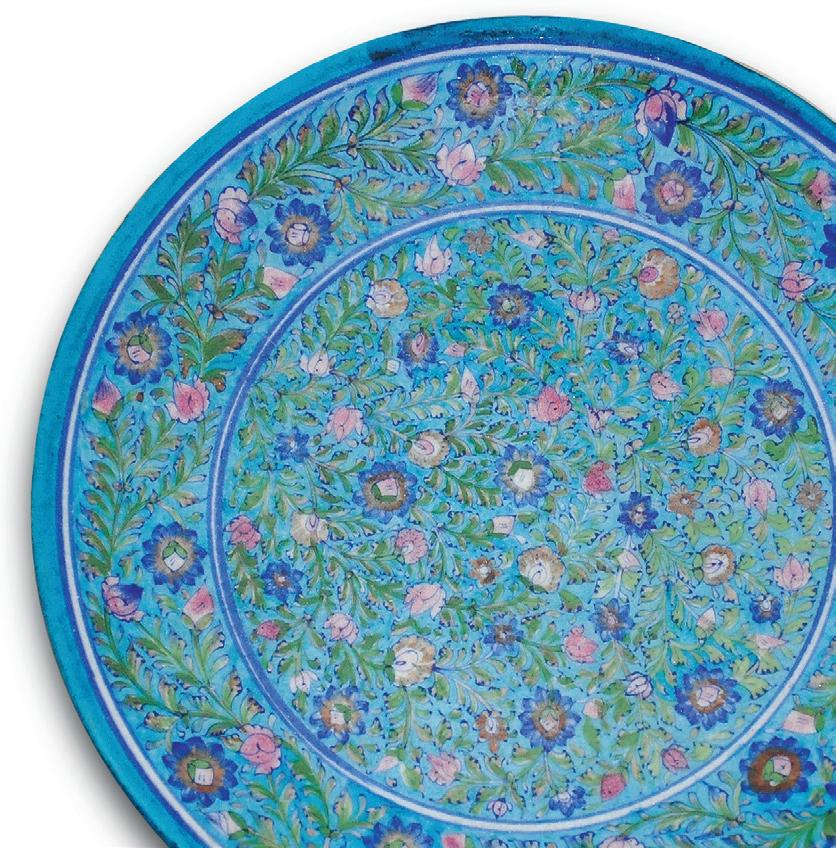
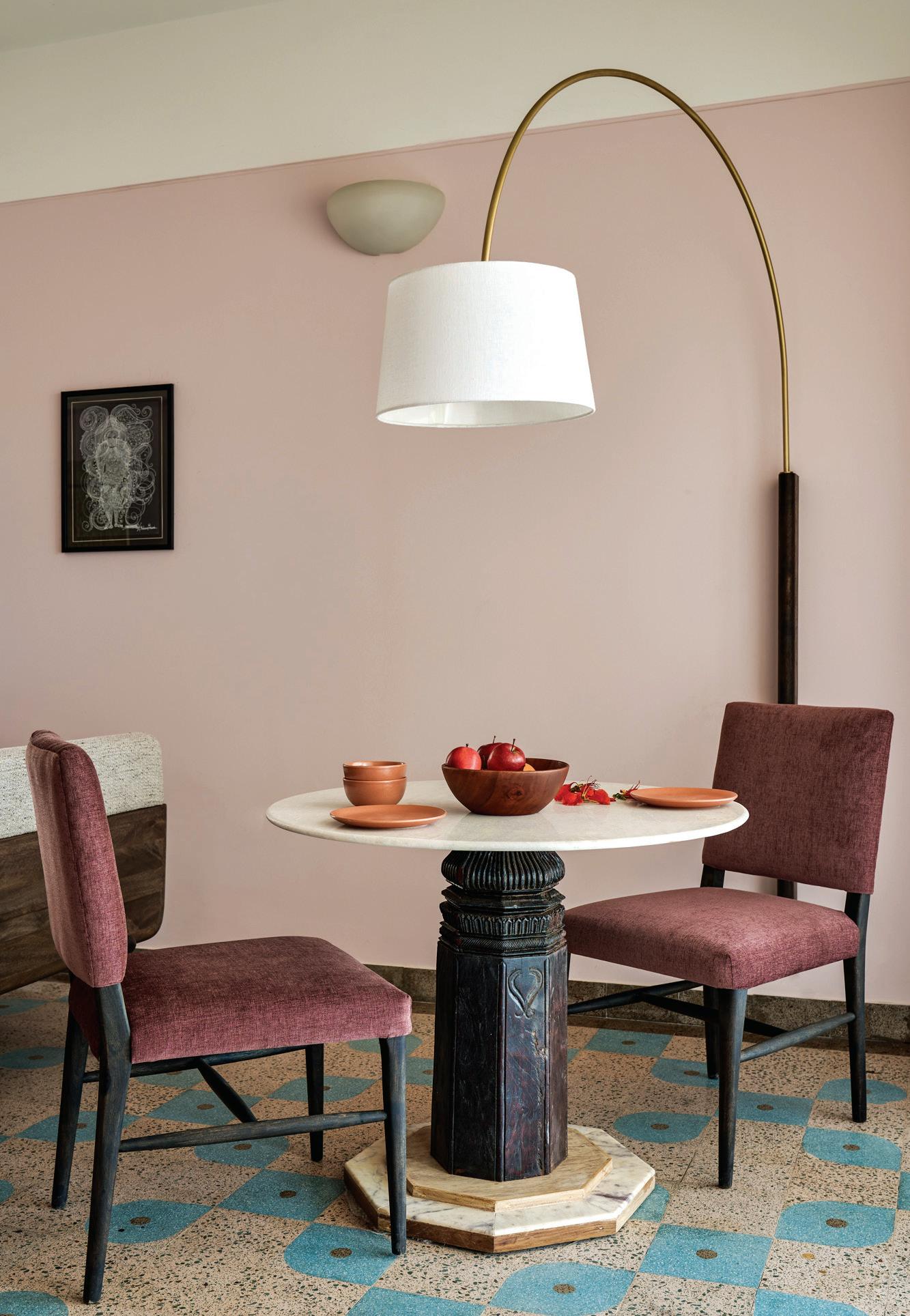
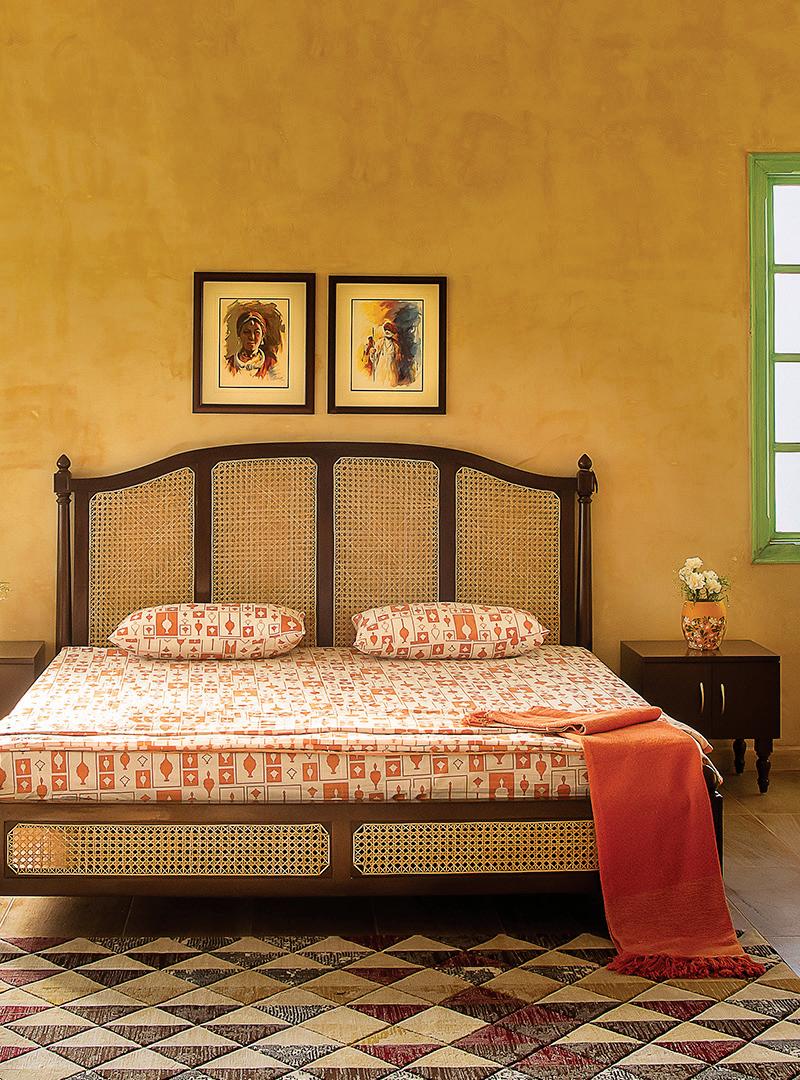
Jaipur has a long history of traditional crafts, with skilled artisans creating exquisite handmade products that reflect the region's vibrant culture. The Pink City's furniture-making traditions date back centuries and are famed for its unique blend of Mughal and Rajput styles. Artisans use fine-quality wood like teak, rosewood, and shisham to create ornate pieces. The furniture is often embellished with intricate floral patterns, geometric designs, and scenes from Hindu mythology. The use of bright colours, gold leaf, and mirror work further enhances the visual appeal of these pieces.
Contemporary Rajasthan-based brands are modernising these ancient furniture-making traditions.
Gulmohar Lane, a leading luxury furniture brand, is leveraging technology to transform the hospitality industry. The company's unique strength lies in its commitment to preserving traditional craftsmanship while embracing modern techniques. For instance, their state-of-the-art facility allows them to apply traditional sanding, staining, and coating processes to hardwood tables, ensuring optimal results and a harmonious blend of heritage and innovation.
“Our focus in hotel hospitality projects is to create a relaxing and luxurious atmosphere while efficiently delivering large quantities of products,” says Shweta Mewara, co-founder and creative director of Gulmohar Lane. “We work closely with architects and interior designers to furnish diverse rooms, whether standardised or individually styled.”
Their portfolio includes luxury safari camps for Sujan, bespoke furniture and decor for The Claridges New Delhi, heritage furniture for Ajit Bhawan in Jodhpur, and striking living spaces for projects like Vianaar Homes in Goa. Their work graces the interiors of hospitality establishments such as Isprava Luxury Villas in Goa, The Postcard Hotel, Hotel Greenpark in Bengaluru, and The Blackbuck Lodge in Gujarat.
AKFD, a design and furniture company marries traditional Rajasthani craftsmanship with modern design to create bespoke pieces for upscale hotels and resorts. “Quality is paramount, whether you are working
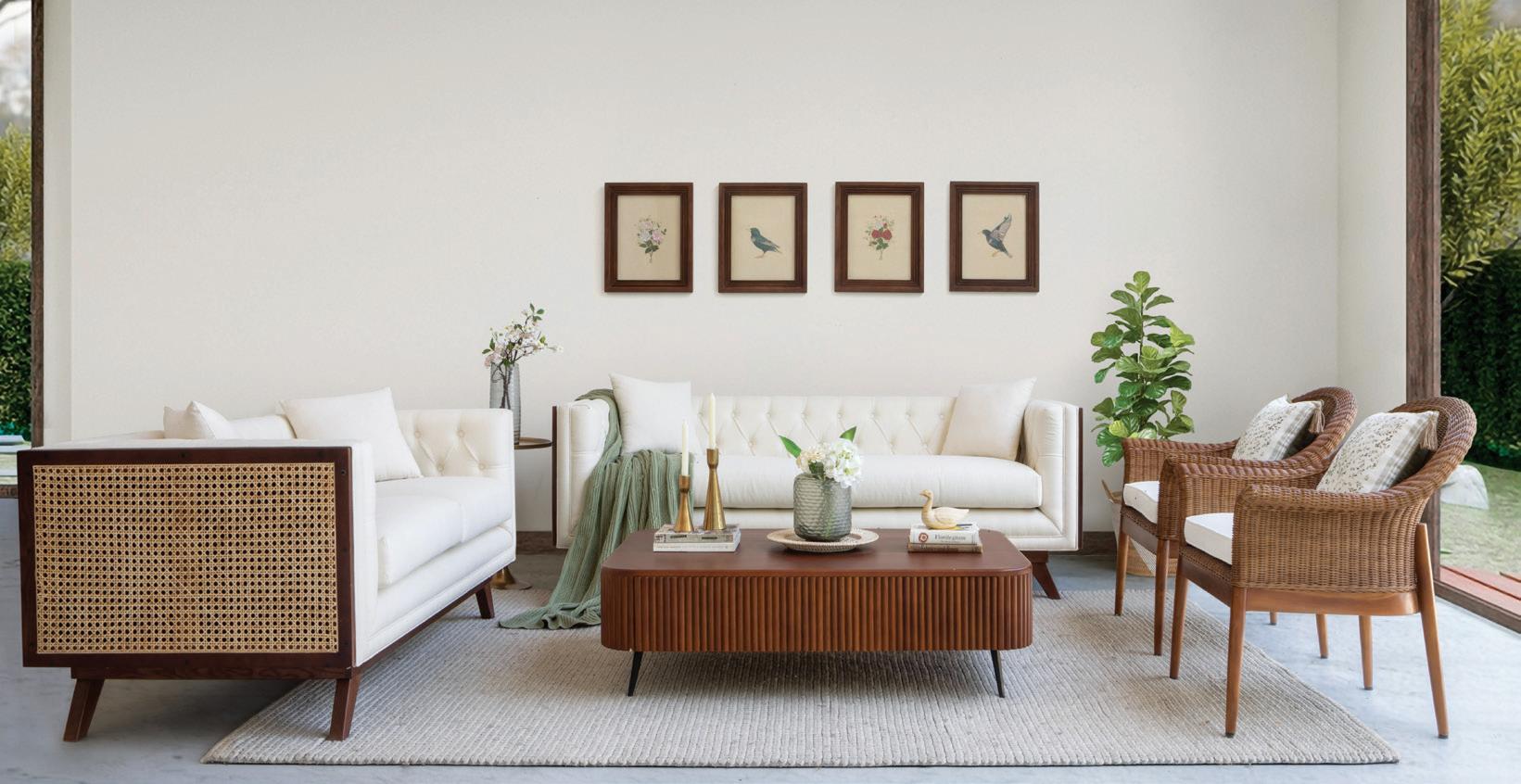

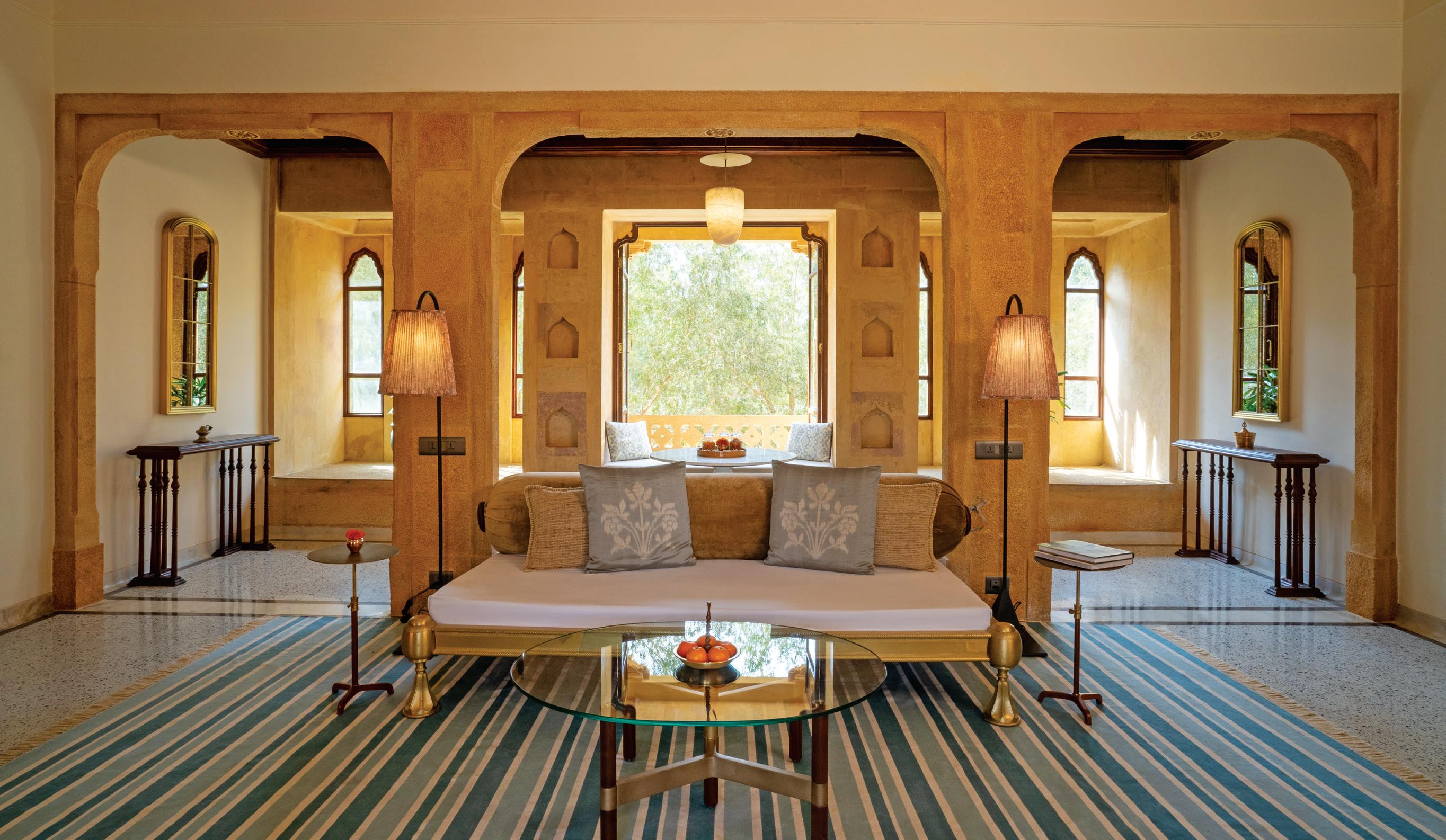
on a single piece or a large-scale project,” says co-owner Geetanjali Kasliwal. The company's 27-year journey has seen them masterfully combine wood, metal, and textiles into furniture that doubles as art, adorning spaces from palatial hotels such as Narendra Bhawan and Suryagarh, to Kshemavana Wellness Resort in Bengaluru.
“Hospitality projects offer a unique scale,” explains founder Ayush Kasliwal. “While retail projects allow for more experimentation, the hospitality sector demands consistency and adaptability, which AKFD's local presence and customisation options readily provide.”
Their advantage over Chinese competitors lies in their commitment to ongoing maintenance and upgrades, a crucial factor in the hospitality industry. This, combined with its unique aesthetic, has made AKFD the go-to for discerning hoteliers seeking to create meaningful spaces that blur the lines between furniture and art.
Many design brands and companies in Jaipur offer end-to-end design solutions. Leading among them is Fanusta, a company with an in-house furniture manufacturing setup. “In the hotel industry, design is not just about aesthetics; it's about creating a holistic guest experience,” explains Shailandar Kumar, Fanusta's founder. “This involves designing inviting lobbies, luxurious rooms, and relaxing amenities for spas and pools. The furniture and decor must cater to various functions, from dining and leisure to business and social gatherings. “Fanusta's secret is its seamless integration of technology. Their tech-driven e-commerce platform, augmented
reality experiences, and digital collaborations provide a global platform for artisans and an immersive way for consumers to discover and customise products. Their portfolio includes diverse projects with hospitality brands, among them for groups such as IHCL and ITC. Their projects span painting the dome ceiling at the Taj Mahal Palace in Delhi and crafting blue pottery bathroom utilities for the Devi Ratn, JaipurIHCL SeleQtions. A recent project saw them deliver a turnkey mock-up room for ITC Jodhpur, showcasing their ability to handle large-scale projects from start to finish.
X-factor: Handcrafted for heritage and modern hotels with a deep understanding of materials.
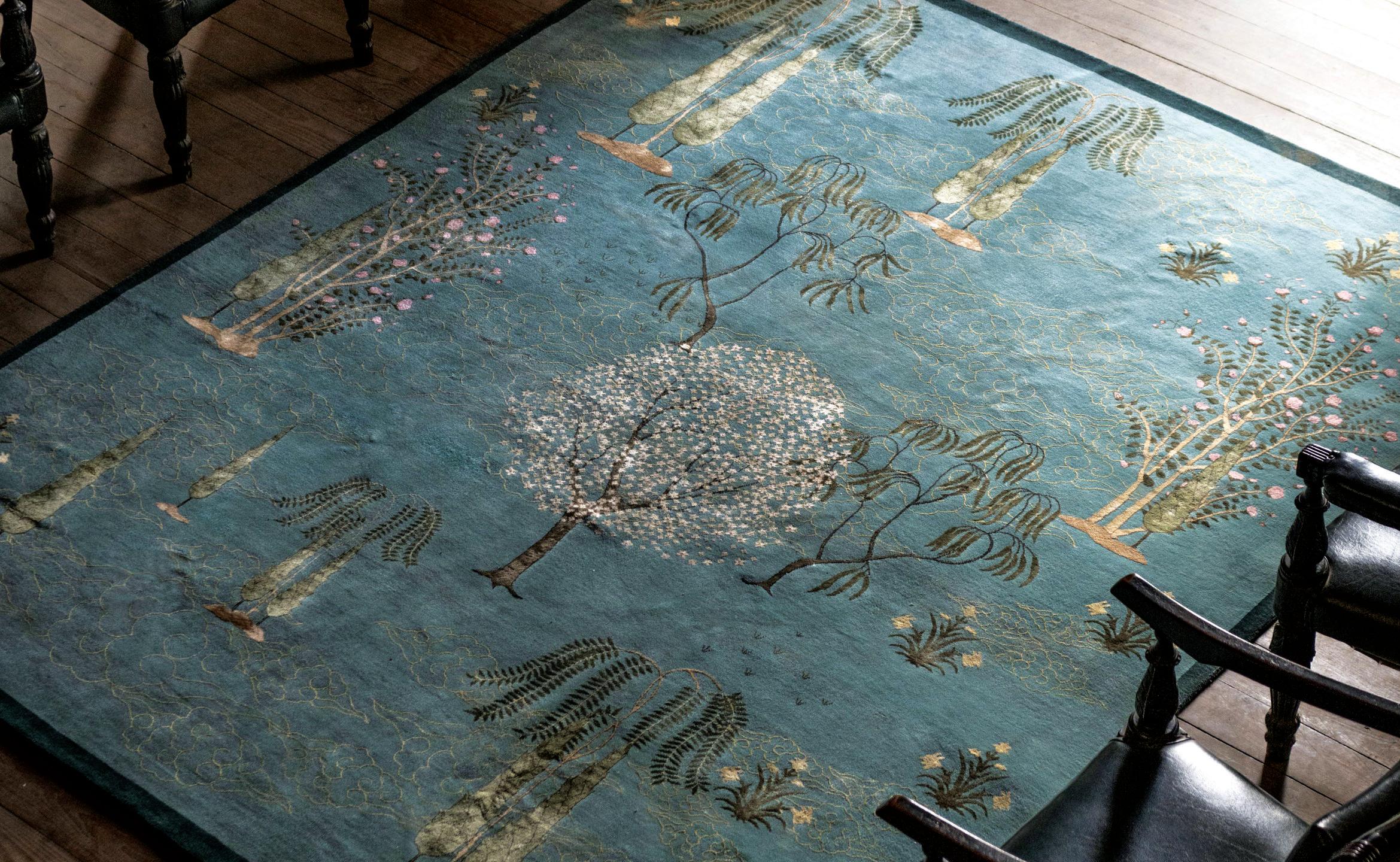
Jaipur's carpet and rug-making heritage is a rich tapestry woven with threads of history, culture, and craftsmanship. Introduced by the Mughals in the 16th century, the art of rug weaving found fertile ground in Rajasthan where artisans fused it with local traditions to create a distinctive style. Rajasthani artisans infused Persian techniques with their aesthetic, incorporating indigenous designs, motifs, and colours. They drew inspiration from their surroundings, depicting floral patterns, geometric shapes, and scenes from daily life in their rugs. The vibrant colours of Rajasthan, such as deep reds, blues, and yellows, found their way into the carpets, creating a visual feast for the eyes.
Brands such as Jaipur Rugs continue this legacy, employing traditional craftsmanship and cutting-edge technology. They've embraced digital tools for intricate design and e-commerce platforms, all while maintaining a deep respect for the artistry of hand-knotted rugs.
“Our focus in the hospitality sector is durability,” explains Kavita Chaudhary, the company's design director. “We engineer rugs that can withstand the heavy wear and tear of hotels, ensuring they remain beautiful and functional for years to come.”
Jaipur Rugs also offers a compelling alternative to Chinese-made carpets. “Our hand-tufted rugs are not only more affordable but often surpass Chinese options in quality,” Chaudhary notes. “We adhere to strict international standards while providing significant cost savings.”
Their portfolio includes projects for prestigious hotels such as the Gorbandh Palace, Jailsamer - IHCL SeleQtions, where they've provided everything from single lobby rugs to comprehensive flooring solutions for hundreds of rooms, staircases, ballrooms, and banquet areas.
Jaipur’s carpet entrepreneurs and weavers are more than just rug manufacturers. They are cultural ambassadors, preserving and celebrating Rajasthani traditions while contributing to the vibrant tapestry of the modern hospitality industry.
X-factor: Preserving the Persian rug-making legacy.

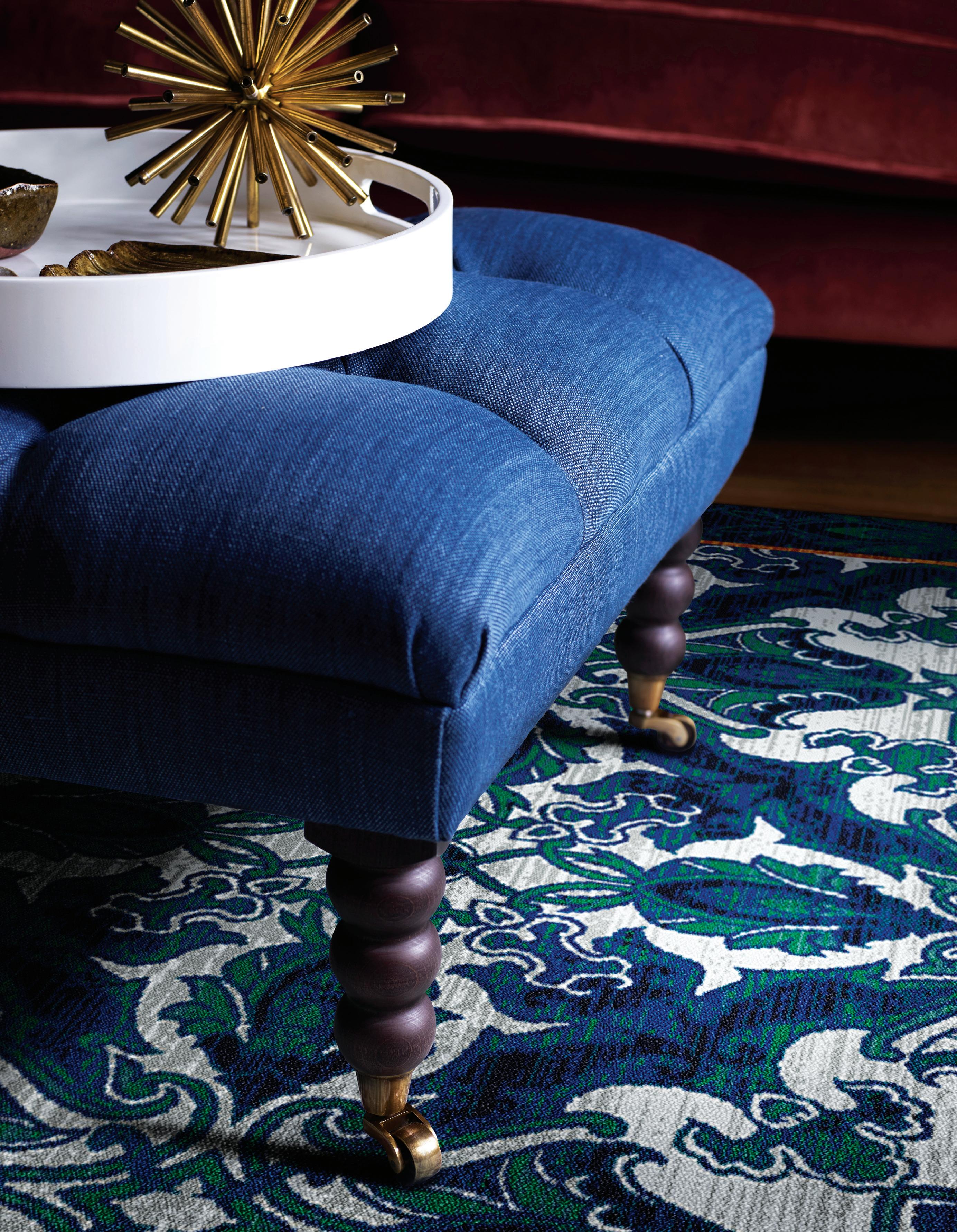
The exquisite Prive collection of bespoke rugs is the embodiment of Royal Thai’s commitment to partnering with innovative artists to offer a diverse and multicultural perspective through striking, oneof-a-kind floor coverings. The latest collection is the result of an exclusive collaboration with renowned British interior designer Lawrence Llewelyn-Bowen.
The artisanal ensemble is a convergence of the prolific designer’s knowledge of rug design’s centuries-old legacy, his professional experience garnered on the global stage, his vivacious personality and Royal Thai's exceptional craftsmanship. Each opulent design has a distinct and glamorous story to tell about the aesthetics, history and elegance of British handmade luxury.
As with all Royal Thai products, this series, too, marries beauty with technical expertise, thanks to the company’s state-of-the-art manufacturing process that has given seamless, durable floor coverings to leading hotels and institutions across the world.
X-factor: Exotic, voluptuous, colourful and sensual.
Available in: 4m x 2.74m (size); six collections and axminster weave.
Website: www.royalthai.com
Contact: Nikhil Kalra +91 96500 03572
PRODUCT OF THE MONTH
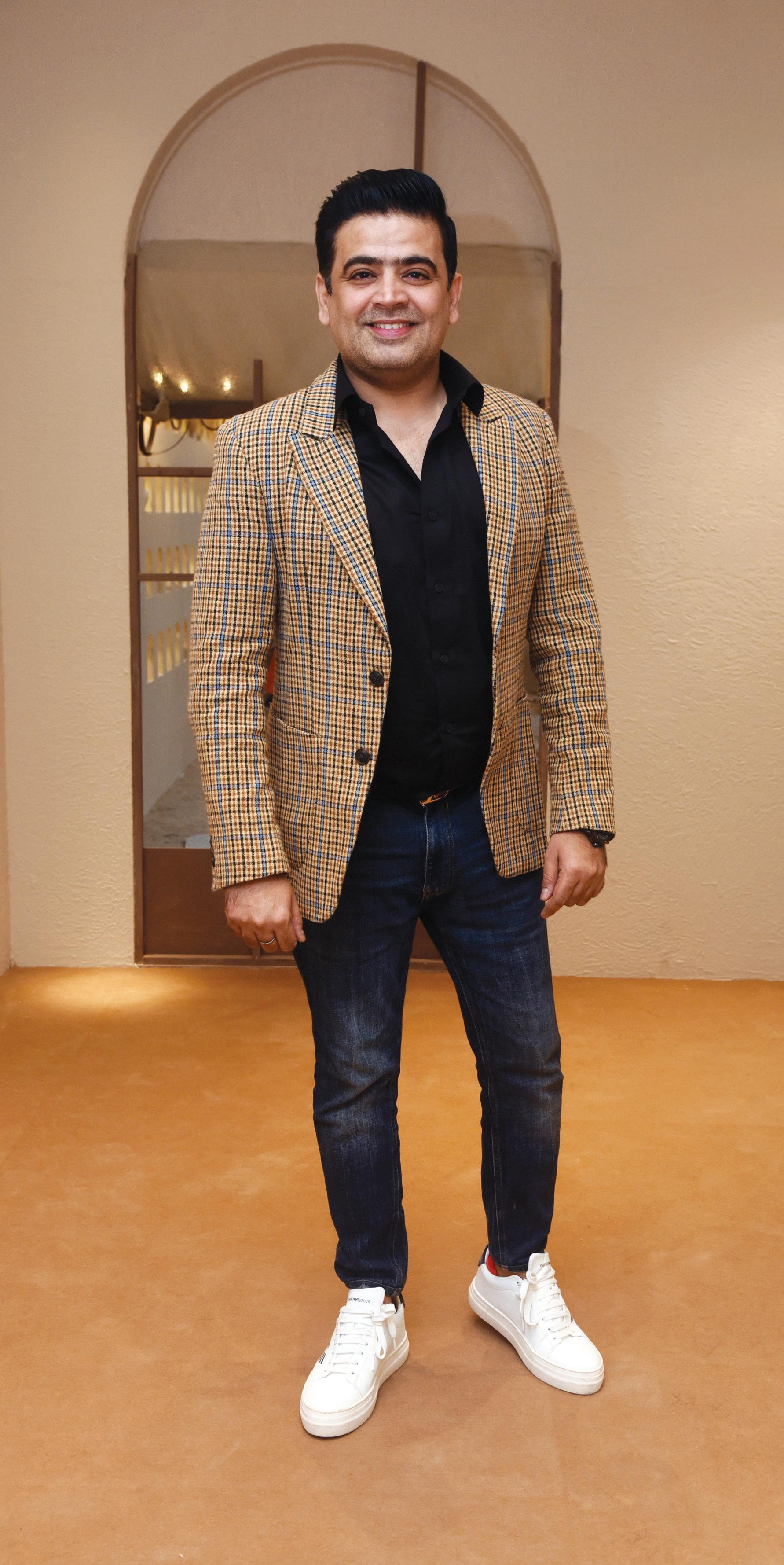
Haresh Manshani, cofounder Hybec, shines a light on the company’s remarkable growth and commitment to exceptional lighting solutions.
The professional journey, before the inception of Hybec.
I started my professional journey in my family's electrical retail store, where we catered to a wide range of electrical needs, from wires to switches. My two elder brothers continued my father's enterprise, infusing it with fresh vision and vigour. Together, we expanded the business by diversifying into imported lamps and decorative lights, bringing elegance to Indian homes. This experience sparked my interest in lighting solutions and set the stage for founding Hybec.
Initially, we faced resistance from established players in the market. As a young and new company, it was difficult to establish trust among customers. However, with time, people came to recognise Hybec not only for its products but also for the quality we offered. This commitment to quality helped us gain trust and establish ourselves in the market. We also adapted to evolving trends by introducing
new products, further solidifying our position.
Also expanding Hybec from a single retail outlet presented several challenges, including building a reliable supply chain and maintaining quality while scaling. These challenges taught us adaptability and resilience, shaping Hybec into a company that prioritises quality and innovation.
Today, Hybec has a strong pan-India network of more than 500 dealers and distributors and 50 franchise stores.
Made in India is now the new mantra for Indian entrepreneurs. What is your take on it?
We are incredibly proud that we create our products in India. By making in India, we also end up supporting local industries and creating jobs. This aligns with our vision of building a self-reliant and sustainable business.
Hybec states that 'it designs for the present while thinking about the future'. How is this statement put in action?
We focus on sustainable design and innovation, investing in technology and research to develop energyefficient and adaptable lighting solutions. Engaging with customers and industry experts helps us stay ahead of emerging trends.
What growth do you predict of the lighting industry in the hospitality sector?
The hospitality industry is focused on creating engaging and sustainable environments. As I mentioned before, hotels and resorts are increasingly using tailor-made lighting solutions to create the right ambience and mood for improving guest comfort

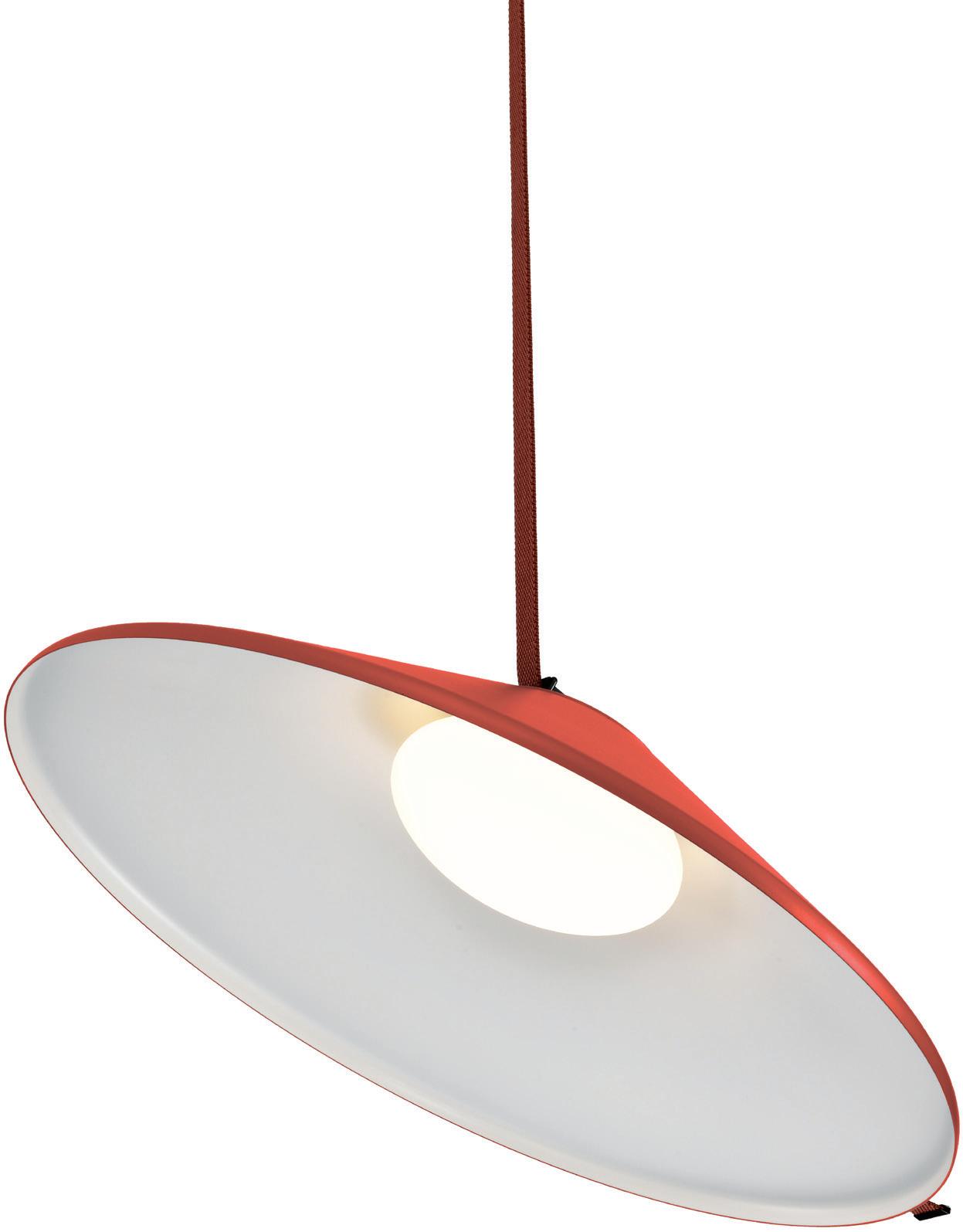
and satisfaction. With greater awareness of earth-consciousness, there's a strong emphasis on energy-efficient solutions like LED technology and smart controls to reduce operational costs and carbon footprints. This goes hand in hand with technological advancements. So smart lighting systems, controlled via apps or voice commands, are popular for offering personalised experiences and optimising energy use. There’s also the health and wellbeing angle. Circadian lighting, which mimics natural daylight patterns, is being adopted to enhance sleep quality and guest well-being.
At Hybec, we're committed to leading this evolution by providing innovative products that enhance guest experiences, improve energy efficiency, and offer customisable design options. By staying ahead of technological advancements and understanding the hospitality sector's unique needs, we aim to be a trusted partner for hotels and resorts worldwide.
What are your latest innovations, especially vis-a-vis the hospitality industry?
Our latest innovations include smart lighting solutions integrated
with home automation systems. For the hospitality industry specifically, we offer customised lighting solutions that create enhanced and immersive ambience and guest experiences.
Which are your notable hospitality projects?
We have illuminated several prestigious hotels and luxury resorts. We’ve worked with brands such as the Taj, Atmosphere Core, Hyatt, JW Marriott and St Regis, to name just a few. Our hospitality portfolio illustrates the versatility and quality of Hybec's lighting solutions.
What is the future vision for Hybec?
In the next 10 years, we aim to be a global lighting solution provider, known for innovation and sustainability. Our goal is to drive positive change in the industry by setting new standards for quality, efficiency, and design.

Aurika Mumbai Skycity, India’s largest hotel in terms of keys, trumps site constraints with design thinking and teamwork.

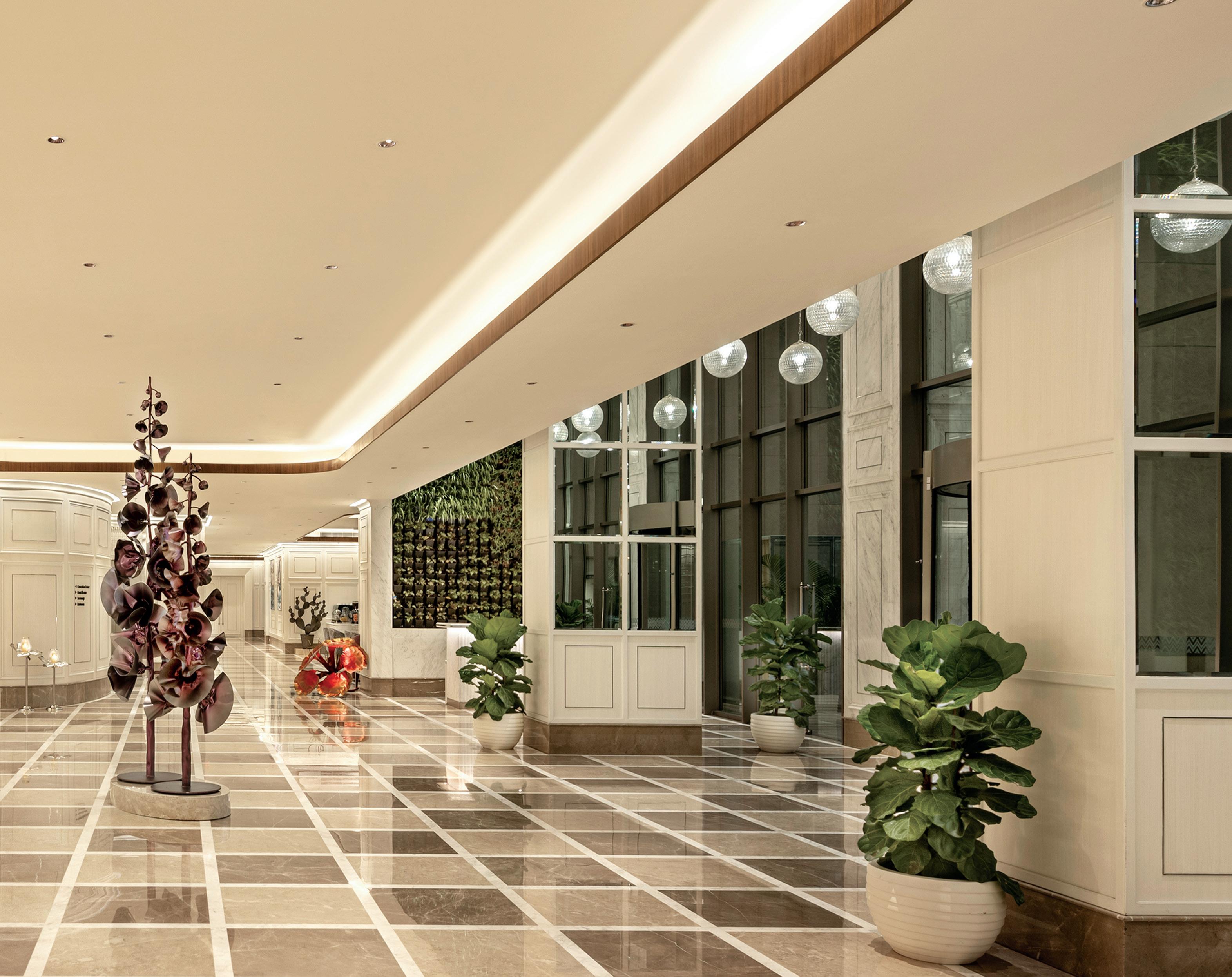
The hotel follows the Art Deco theme, represented in the lobby through geometric elements, an important part of the style. Seen are the floral sculptures that negate the need for cut-flower arrangements that are unhealthy for the environment.
Exclusive experiences, extraordinary ambience, contextual design, and sensitivity to sustainability— Lemon Tree Hotels’ luxury brand Aurika has carved a distinct niche within India’s hospitality universe by holding these core values close to its heart.
The latest pearl in its string of properties is Aurika Mumbai
Skycity, a massive 669-key hotel occupying a 9641.55 sq.mtr. plot near the city’s international airport. This is India’s largest hotel based on the number of rooms. While the hotel is aligned with the brand ethos of carving a unique presence through design, in this case, the narrative responds to the site limitations posed by the compactness of the plot and aviation rules.
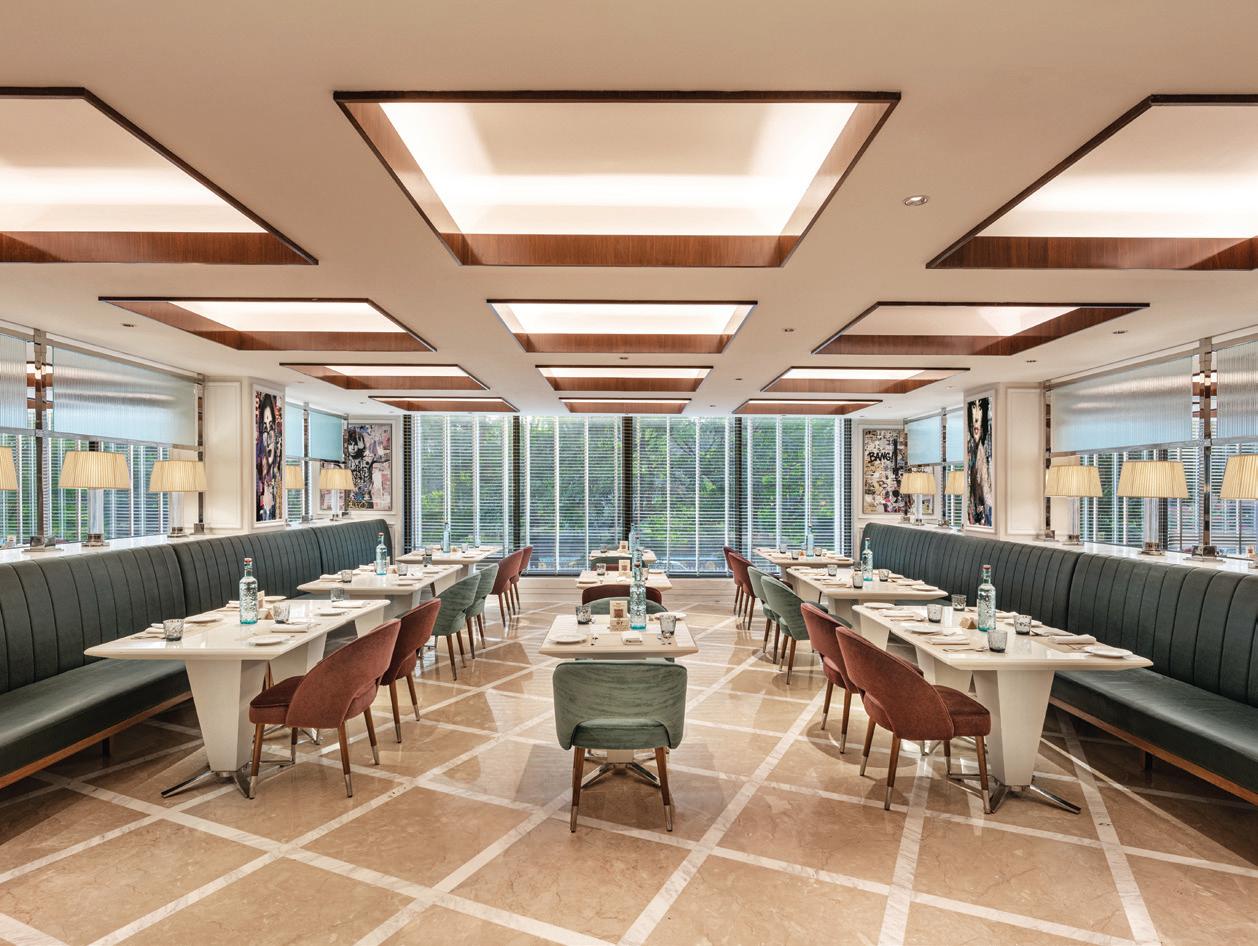
immersive ambience,” elucidates the architect, adding that the overarching interior theme is Art Deco, a style popular in Mumbai (then Bombay) during the 1940s.
While the architectural response to the challenges was creating smaller spatial volumes with lesser heights than usual to enable the creation of the required number of keys, the multi-pronged interior design strategy aimed to add illusory space through colour, reflective expanses, surface finishing techniques and patterns.
“Subtlety was the mantra we followed,” says architect Bobby Mukherji, whose eponymous studio was entrusted with creating a hotel per the brand’s guidelines: “Beyond the unusual”. Ritu Ranjan, Senior Vice President - Aesthetics and Design, Lemon Tree Hotels, collaborated with the architect in this transformative process. “We used an understated colour scheme uplifted in places with gentle veins of natural stone, deep jewel tones of upholstery, texturing techniques such as moulding and fluting, and striking objets d’art to create an
The lobby itself illustrates this stylistic direction with its series of ribbed, marble-faciaed reception counters deployed against panelled white walls and an unfurling of graphic flooring rendered from neutral-coloured stone. The nearby Tea Lounge carves a distinct place for itself within the overall lobby space with its plum-coloured singleseaters, teal banquette seating and round metal centre tables which, says Mukherji, explore jewellery giant Tiffany's iconic Atlas collection with its Roman numeral motif, playfully twirling the intricate band from that collection on his fingers.
Near the entrance, mirrorencased double-height columns amplify the delicacy of the globular glass pendants sourced from Moradabad. Collectively, the elements create a nuanced, richly detailed environment, and successfully divert the attention from its compact size (read low ceiling height).

“We used an understated colour scheme uplifted in places with gentle veins of natural stone, deep jewel tones of upholstery, texturing techniques such as moulding and fluting, and striking objets d’art to create an immersive ambience.”
While the design team curated a palette that abided by the aesthetics of the brand and hotel, they were careful to filter their material choices based on ease of maintenance and site conditions. So out went heavy carpeting and dark wood, and in came delicatelygrained marble, light area rugs and rich upholstery, among others, which evoke the feeling of luxury while being more suitable to the destination. Most of these elements, barring a few that had to be necessarily procured from abroad, were made in India— reflecting on the brand, and indeed the parent company’s, philosophy of being vocal for local.
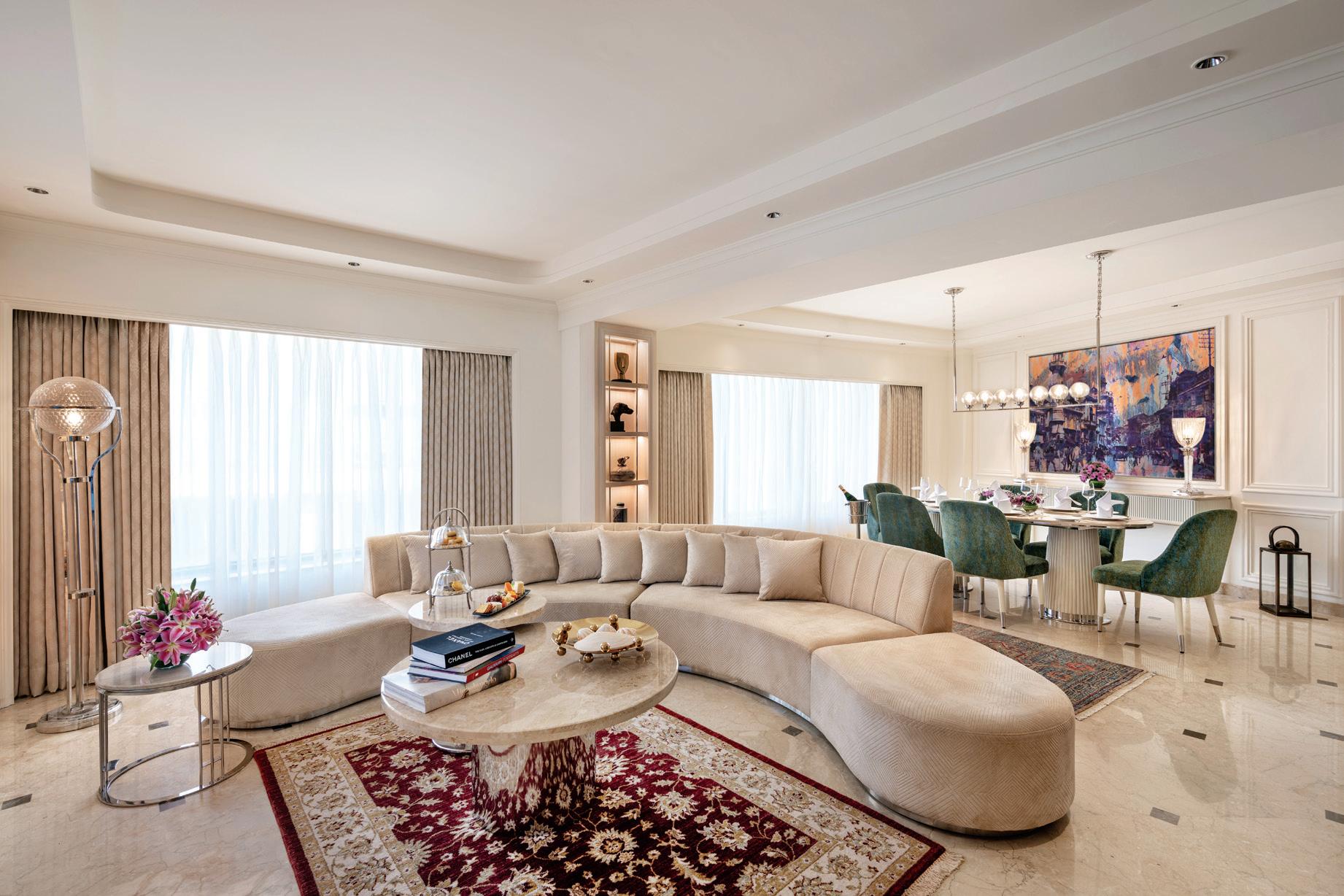

TOP: The expansive, 150 sq.mtr. Presidential Suite illustrates the strategy of an understated shell populated by vibrant, chromatic elements.
ABOVE: The Tea Lounge is delicately textured with the help of fluted surfaces and moulded panels. The bases of the round tables are inspired by jewellery brand Tiffany's Atlas collection with its Roman numeral motif.
RIGHT: Near the entrance, mirror-clad columns add the illusion of space, so important for a hotel with compact volumes. The reflective surface multiplies the delicate beauty of the chandeliers made in Muradabad.

The built-form takes a decisive correctional measure to alleviate the feeling of compactness created by dimensional restrictions right at the outset. Instead of creating a lobby as a singular volume with the same height, the spatial articulation places a doubleheight portion just inside the glazed entrance with a singleheight volume—the reception space with its several check-in desks—as its neighbour.
This volumetric play is engaging and fosters a sense of spaciousness as the guests step in, which then transforms into a more intimate feeling as they proceed to the adjacent scaled-down zone. Back in the double-height pocket at the entrance, a walkway on the mezzanine level leads to Ariva, the bar, and Mirasa, the restaurant. The footfalls on this connecting element overhead add their energy and sense of dynamism to the entrance below.
To handle a large number of check-ins in a hotel with a large room inventory, the design leverages the advantages of a double lobby, creating what General Manager Harkaran Singh calls the ‘hotel-in-hotel’ effect, clearly the most compelling move in the design strategy. A separate porte cochère leads to a secondary lobby, placed adjacent to and connected with the main lobby via a large doorway. This ancillary functionality handles larger checkins, minimising congestion and stress in the main lobby.
OPPOSITE: The arms of the hotel embrace an inviting swimming pool with a pool bar and a tranquil relaxation area.
A TEAM THAT WORKS TOGETHER
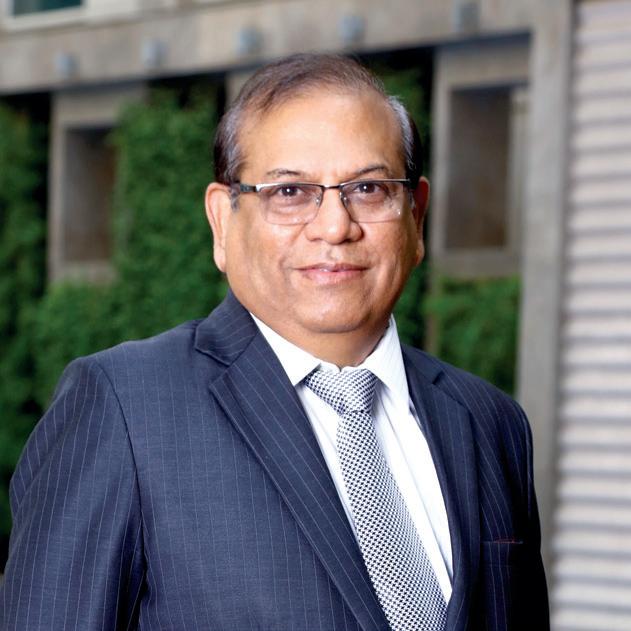
EXECUTIVE VP, PROJECTS & ENGINEERING SERVICES, LEMON TREE HOTELS
“It
was perfect teamwork, where each department supported the other fully, which allowed us to open Aurika, Mumbai Skycity (in record time).”
A HOTEL WITH A MASSIVE INVENTORY OF 669 ROOMS AND SUITES, COMPLETED IN A RECORD TIME OF FIVE YEARS, INCLUDING THE UPHEAVAL BROUGHT ABOUT BY THE GLOBAL PANDEMIC. HOW WAS THIS ACHIEVED? IT WAS ALL AN OUTCOME OF DISCIPLINE, PLANNING AND FORETHOUGHT.
DURING THE PANDEMIC, WHILE BEING MINDFUL OF THE HEALTH AND WELL-BEING OF THE TEAM, THE HOTEL’S PROJECTS DEPARTMENT SOUGHT SPECIAL PERMISSION FROM THE GOVERNMENT TO CONTINUE WORK ON THE ASSURANCE THAT THE WORKERS WOULD NOT STEP OUT OF THE CONSTRUCTION SITE, THAT HYGIENIC CONDITIONS WOULD BE MAINTAINED AND THERE WERE PERIODIC HEALTH CHECK-UPS
MOREOVER, ON THE IMPLEMENTATION SIDE, A DEDICATED TEAM TOOK DECISIONS ON PRIORITY FOR FUNDS AND APPROVALS. “IT WAS PERFECT TEAMWORK,” EMPHASISES JK CHAWLA, EXECUTIVE VICE PRESIDENT – PROJECTS & ENGINEERING SERVICES, LEMON TREE HOTELS, ”WHERE EACH DEPARTMENT SUPPORTED THE OTHER FULLY, WHICH ALLOWED US TO OPEN AURIKA, MUMBAI SKYCITY.”
A Building Management System controls all equipment within the hotel. Focusing on energy consumption alone, here’s how the hotel ensures it impacts the environment as gently as possible:
Variable Frequency Drive (a type of AC motor drive that controls speed and torque by varying the frequency of the input electricity) is a significant energy-saving piece of equipment used in the hotel. Depending upon the usage and the requirement, the speed of each machine can be reduced. On average, a speed reduction of 20% can result in energy savings of about 50%.
A heat pump, which has a dual function of heating and cooling, contributes to saving energy and power
Solar Reflective Index Paint used on the roof minimises heat entering into the rooms on top, reducing the electricity bills significantly.

EV Charging Points have been installed for electrical vehicles and there is the possibility to further scale this up.
Soundproof and Ecosense glass allows light but not heat to enter the room, resulting in substantial savings by reducing the usage of air conditioners.
In every hotel, or every building, fresh (hot) air from outside is sucked in and cool air from air-conditioned interiors is thrown out, leading to a rise in internal temperature. Heat Recovery Wheel is a device that allows both these air streams to pass next to each other, effectively lowering the temperature of the hot air from outside.
A large part of the uniqueness of the spatial experience can be attributed to art, which pays homage to the city and evokes the enduring allure of the silver screen. Mumbai’s iconic buildings make an unmissable and striking graphic presence on some walls; while on others, it is the 3D installations inspired by Bollywood that make interesting conversationstarters. Additionally, the city’s
maritime surroundings are reflected through commissioned artworks and textiles. By using floral installations in the lobby and doing away with flower arrangements, art has been used smartly to further the ‘green’ agenda that the brand holds dear. “By combining artistic expression, a homage to the city's history, and a contemporary twist, Aurika Mumbai aims to offer an unforgettable experience,” points out Ranjan.
Four striking floral installations by well-known artist and designer Alex Davis create spatial pauses and conversation points in Aurika spatial experience, these metal sculptures also

epitome of an Indian summer. The artist transforms a small flower into a larger-thanlife floor sculpture, allowing viewers to appreciate the flower's beauty and the craftsmanship of the artwork.

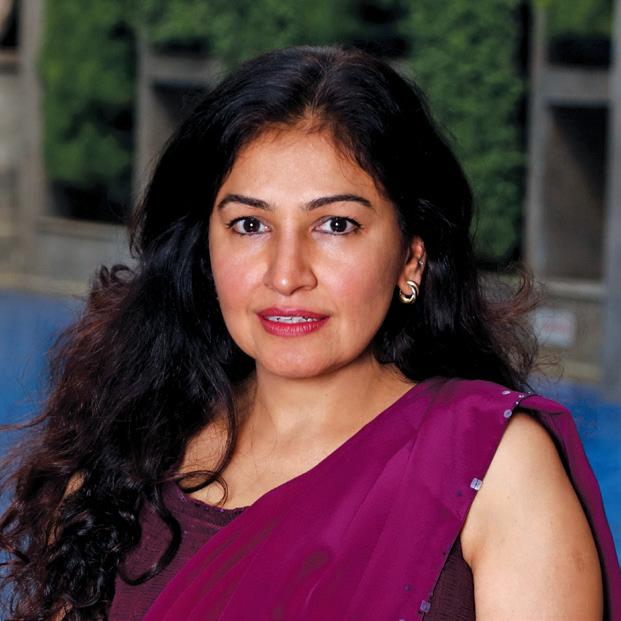
SENIOR VP, AESTHETICS AND DESIGN, LEMON TREE HOTELS
“By combining artistic expression, a homage to the city's history, and a contemporary twist, Aurika Mumbai aims to offer an unforgettable experience.”
is Davis’ interpretation of the showy flowers of the Malva species, reminiscent of the towering gopurams at the entrance of South Indian temples. The artist has created this botanical masterpiece, two of which grace the hotel’s lobby, by employing sustainable stainless steel.
Opuntia —nagphana in Hindi—belongs to the cactus family, and features thick, succulent, oblong to spatulate stems. The sculpture, rendered in oiled steel, stands near the Tea Lounge and draws attention owing to its rugged essence.
Heliconia takes inspiration from the magnificent, zigzag inflorescence of Heliconia rostrata. The standing art showcases the grace and beauty of both the stem and the flower as a set of three sculptures.

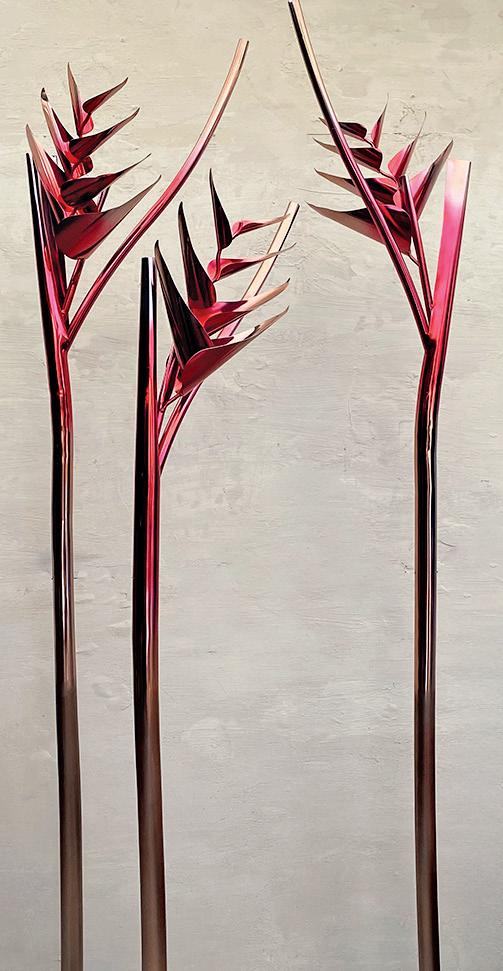
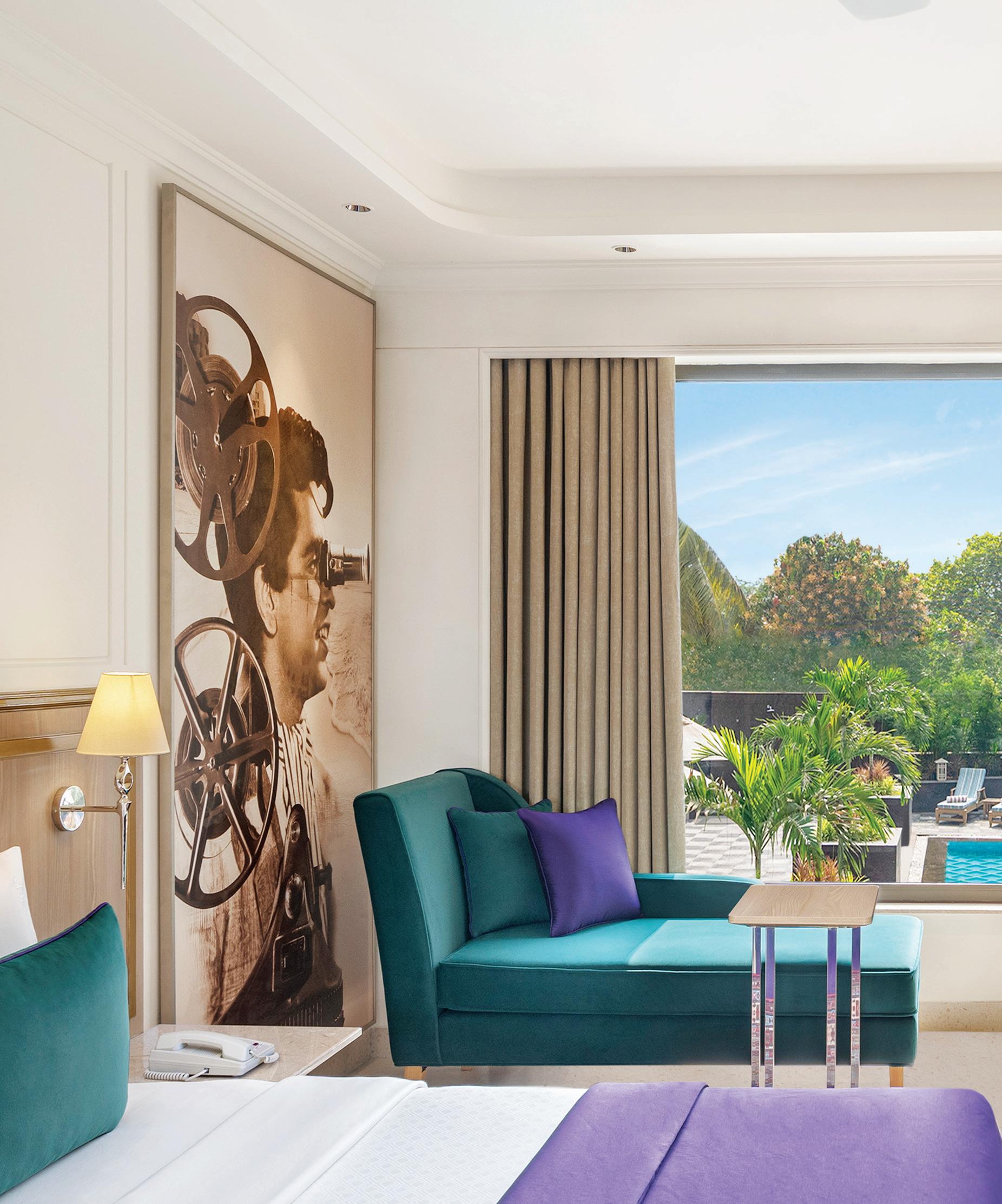
Art forms a large part of the narrative. Its cinematic and architectural inspiration contextualises the space, referring to Mumbai’s association with the motion pictures and its legacy of colonial buildings.
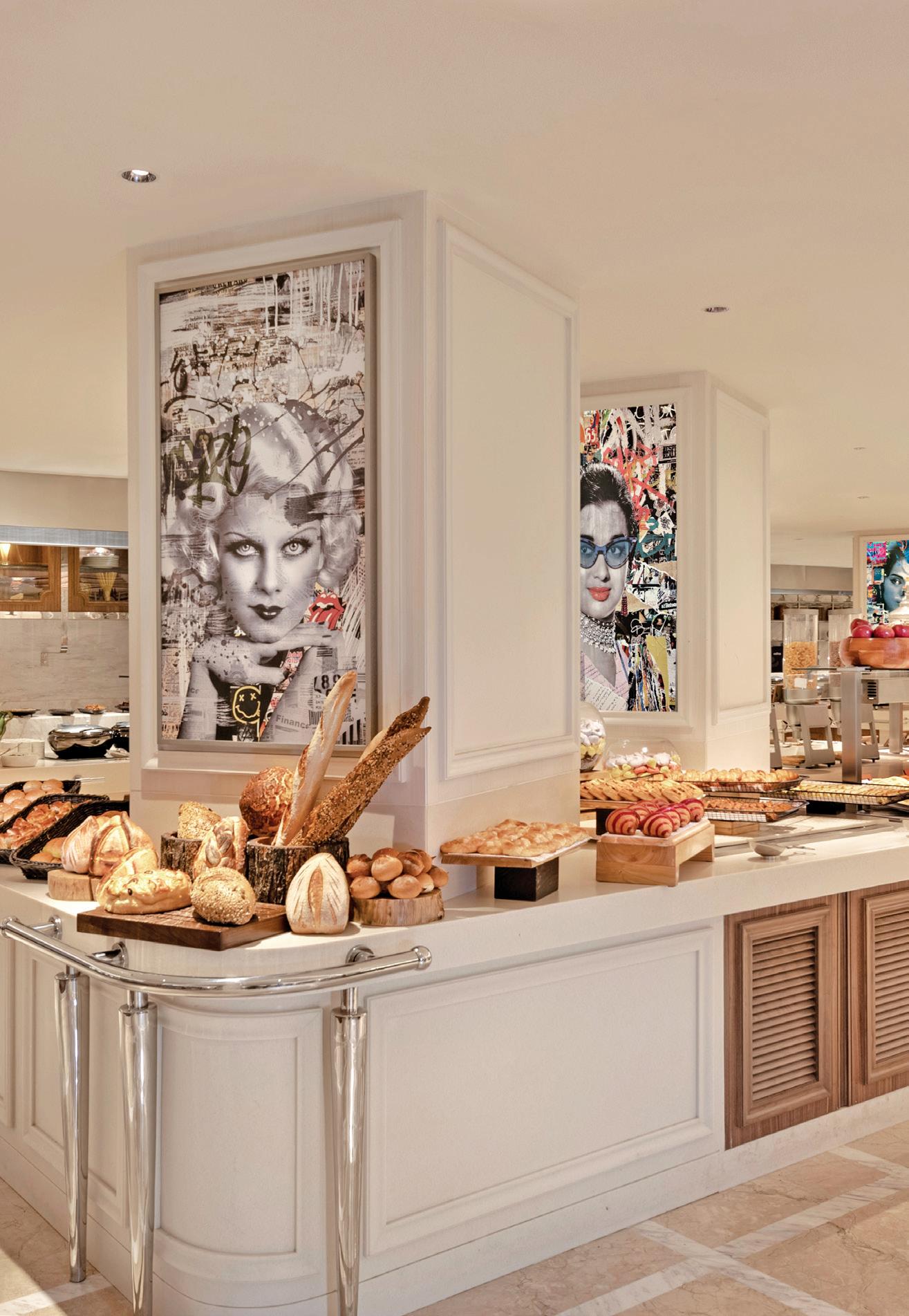
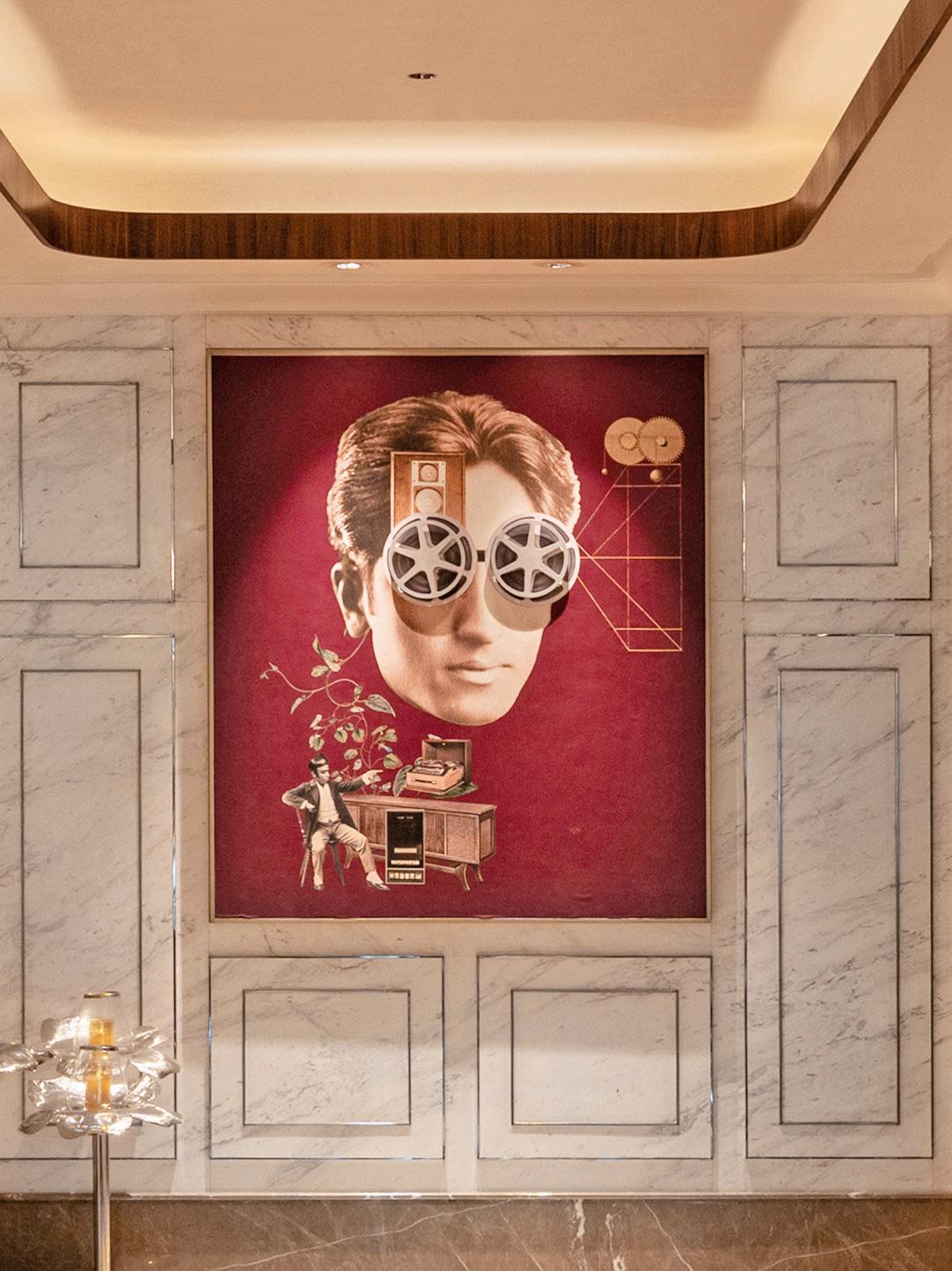
CLOCKWISE, FROM TOP LEFT: The Deluxe Pool View room; the guest elevator lobby; the reception lobby and the food counter at Mirasa.
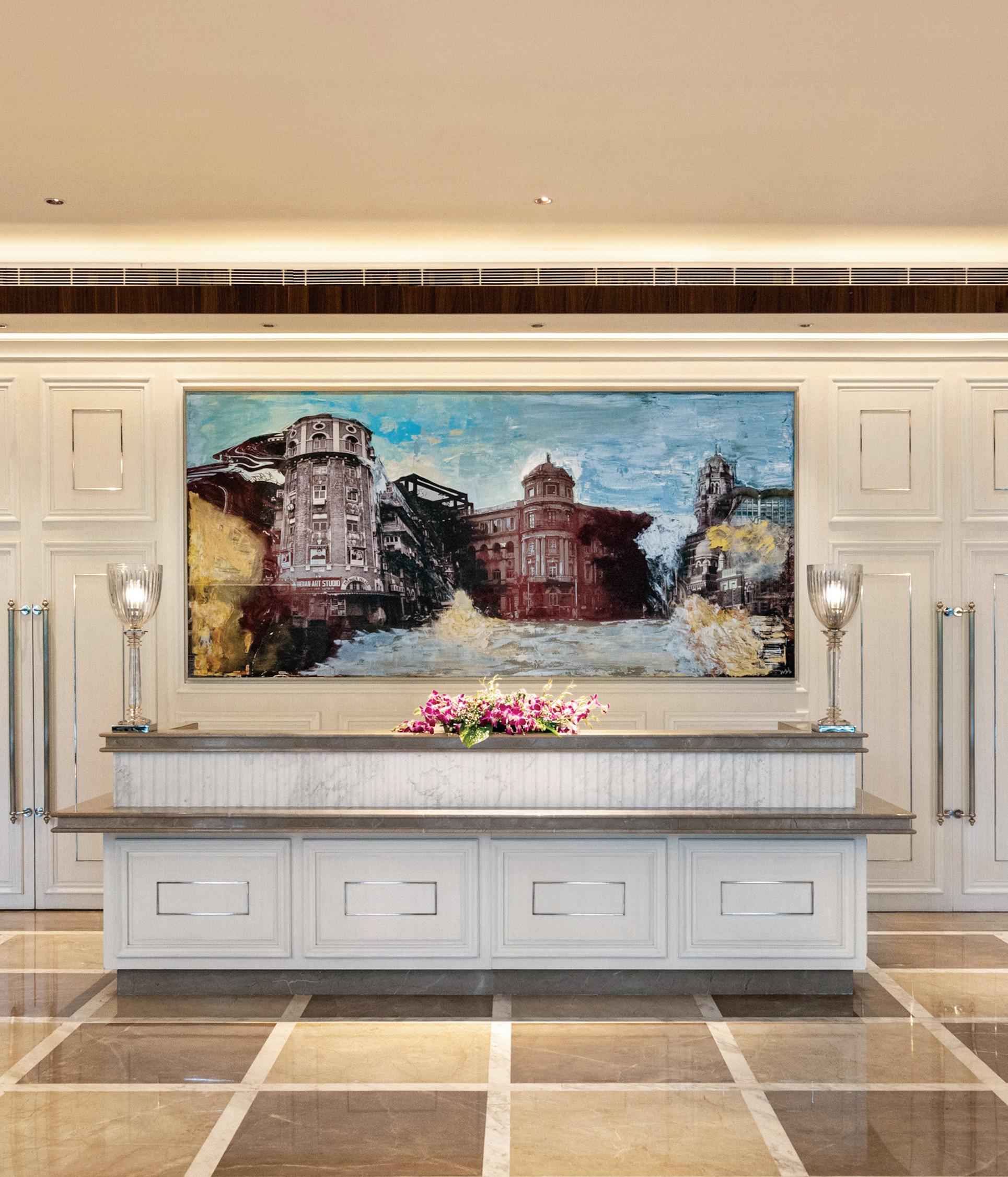
Lemon Tree Hotels, brand Aurika’s parent company, likes to think green, in every aspect. Aurika, Mumbai Skycity employs eco-friendly practices, such as energy-efficient systems, water conservation and recycling, renewable energy, waste management programs and the use of sustainable materials wherever possible. “All these measures contribute to the hotel’s green building certification by the Indian Green Building Council (IGBC),” says Aradhana Lal, Senior Vice President – Sustainability Initiatives, Lemon Tree Hotels.
CO2 sensors in the car park automatically switch on the fans when the Carbon Dioxide in the car park rises.
Air conditioners are equipped with filters and UV so that the air quality maintains particulate matter of 2.5 microns or less within the hotel.
DG sets are fitted with an RECD (Retrofit Emission Control Device) to prevent pollutants from the DG sets from entering the environment.

Almost 60% of the energy usage in the hotel is from renewable sources. About 400-500 units of electricity are generated per day through solar power.
All the rooms have EC fans which reduce power consumption by 25% even at top speed.
Every room is installed with a pressure regulator to prevent water wastage.
The hotel has a drinking water plant which reduces the usage of plastic bottles to achieve plastic neutrality. The plant also uses the latest CDI technology.
The ‘third-day linen change’ policy means that linen in the room is changed after the second day of a guest’s stay. Each day that the linen is not laundered saves enough water to satisfy a person’s drinking water needs for one month.
While an OWC (Organic Waste Converter) is de rigueur for commercial buildings, Aurika, Mumbai Skycity has gone to step ahead to install a biogas plant which is used for cooking, hot water boilers, etc
Waste segregation is mandatory at the hotel.
An advanced version of STP installed at the hotel employs membranes to purify the water better, which is then used for nonpotable purposes.


VICE
INITIATIVES,
“At Aurika, Mumbai Skycity, we go beyond compliance and seek opportunities to minimise our carbon footprint, conserve water, and promote waste reduction/recycling.”
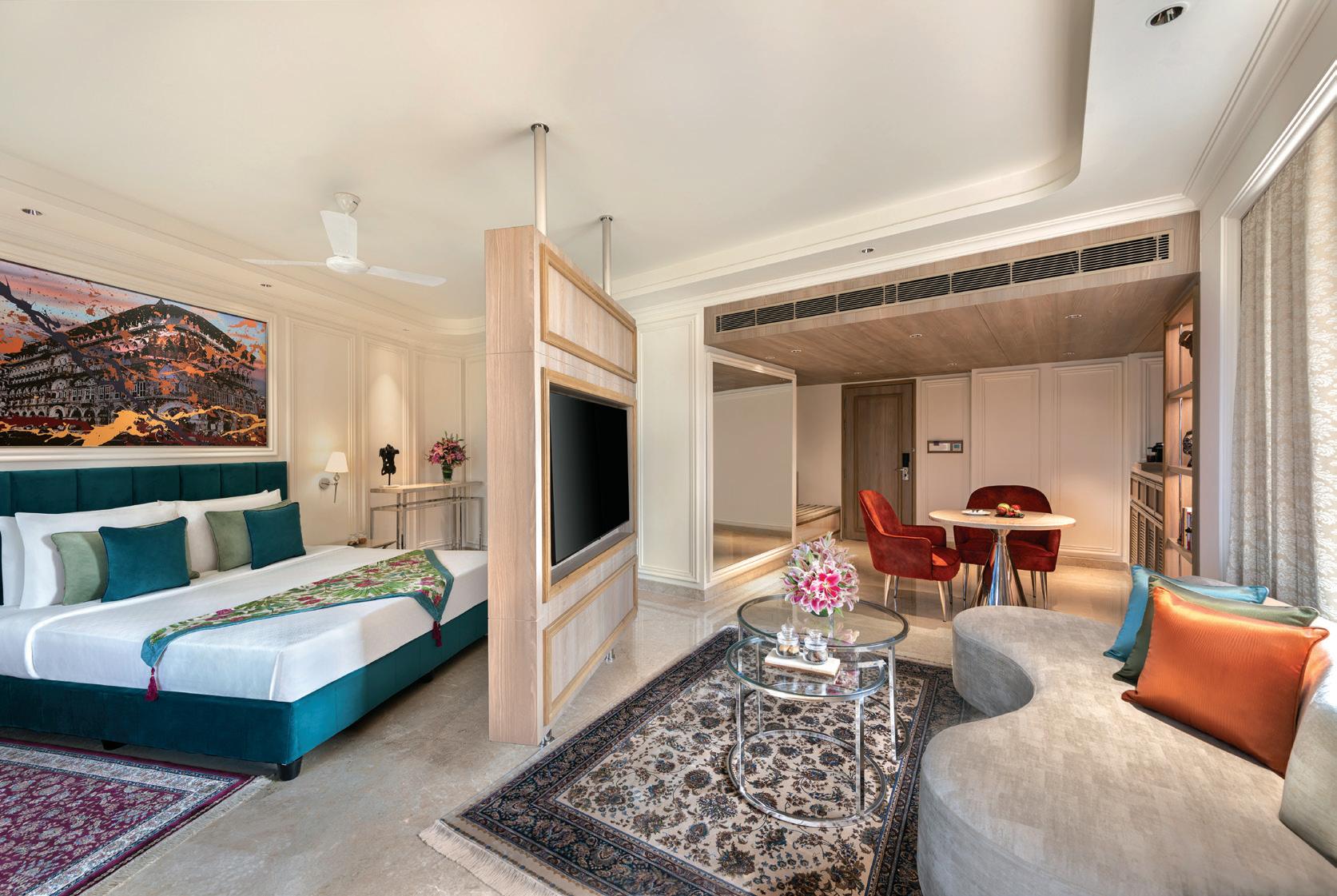
While the hotel’s public spaces articulate the chosen stylistic route clearly and aesthetically, Mirasa is where you can savour the theme at ease. Floor-to-ceiling partitions crafted out of marble and chrome-framed fluted glass, counter-top lamps that grace these dividers and scallopbacked, faux leather banquettes work together to erect a rich, nostalgic atmosphere, bolstered by quirky posters of Hollywood and Bollywood icons. Mirasa’s present footprint is spatial retrofit; its original size was incapable of handling the guest volume that would descend upon it during breakfast—and therefore became a critical area for redressal.
The enlarged avatar was achieved through smart spatial manipulation by architect Bobby Mukherji by ‘borrowing’ areas from the hallway, kitchen and the adjacent bar. The resultant awkwardness, he says, was visually erased by orchestrating the furniture islands and the flooring pattern at angles to each other and modulating the space with the help of ceiling design: either a single large trough bordered by cove lights, or a coffered pattern.
Additionally, the layout was designed as a series of seating configurations, segregated by the aforementioned partitions. This way, the restaurant can flexibly cater to the needs of groups both small and large. The buffet counter—all 120 feet long—is proof of the group sizes it can handle at the larger end of the spectrum.
As India’s largest hotel, Aurika Mumbai Skycity carves a unique presence through design. But behind that spatial narrative lies a remarkable tale of achieving delivery deadlines through dedicated teamwork and triumphing over site constraints through smart design moves.
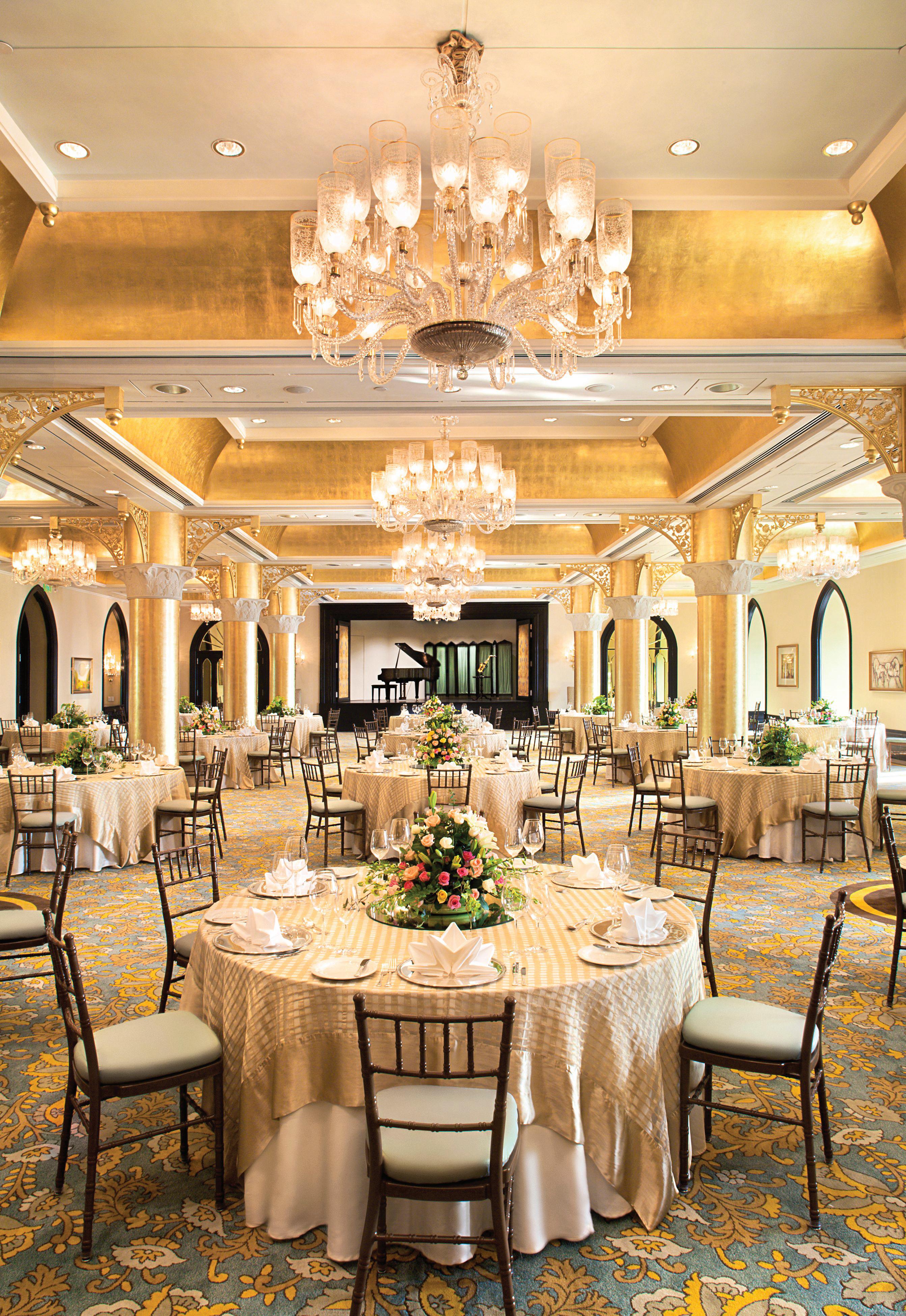











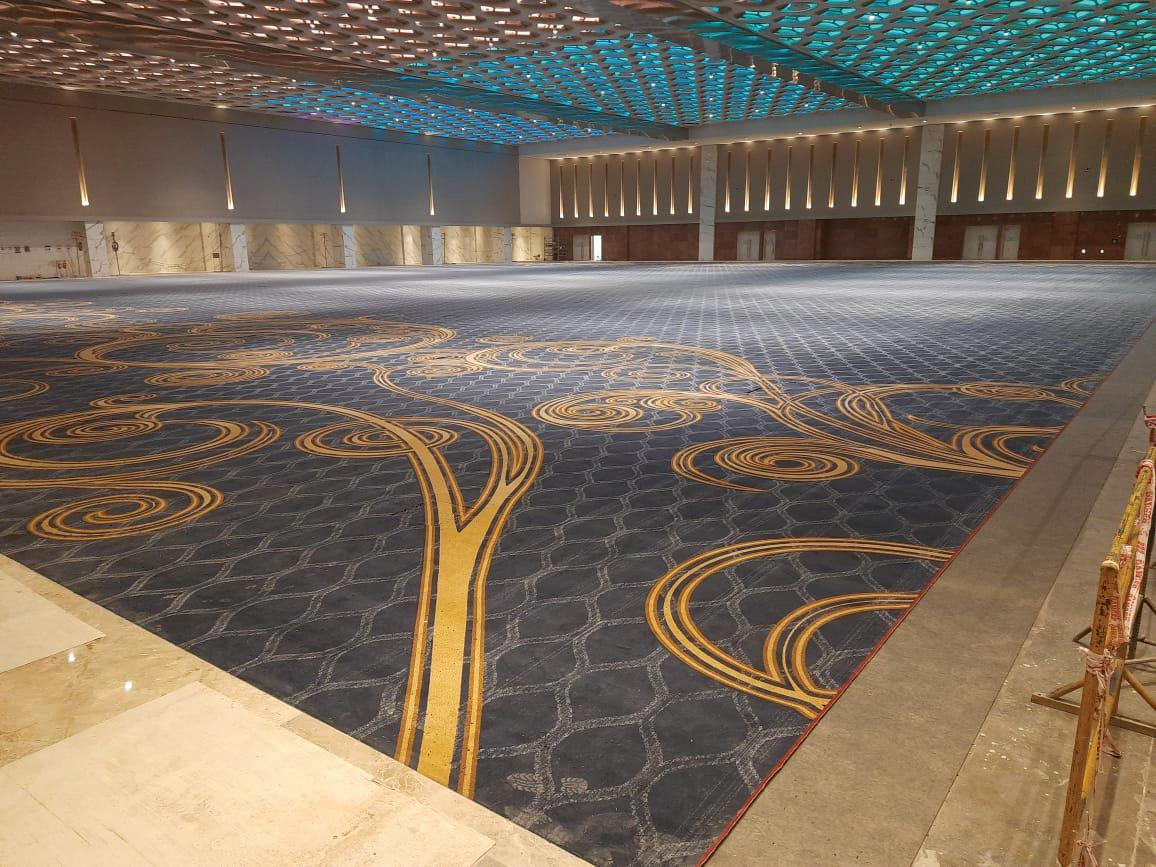




Kanota was a fabled trade route between Mughal-ruled Agra and Rajputdominated Jaipur. This fusion of Jaipuri and Italian design languages has been evocatively captured in the interiors of Villa Palladio, which sets a benchmark for contemporary luxury boutique hotels.
SHALBHA SARDA
Kanota, Rajasthan, has become an unexpected hotspot for designers, architects, and fashion photographers these days. Once a bustling route for travellers and traders between two ancient kingdoms—the Mughal court in Agra and the Rajput royals of Jaipur, today it is Villa Palladio, a boutique hotel that has placed the little town on the tourist map.
While modern Jaipur boasts no shortage of suave stays, Villa Palladio has a different design game altogether.
Villa Palladio marks the third collaborative venture between Swiss expatriate Barbara Miolini and Dutch designer Marie Anne Oudejans. Their creative partnership began in 2010 with the inception of Bar Palladio within the historic Narain Niwas Palace. The duo’s imaginative blend of vibrant blues inspired by the palace’s peacocks and art from the Veneto countryside has transformed the bar into an Instagram sensation.
Originally arriving in Jaipur in 2005 for a sabbatical, Barbara Miolini, a Swiss native, found herself making the Pink City her permanent residence. Meanwhile, Oudejans transitioned from a successful fashion label, Toca,
in Paris to the realm of interiors, incorporating commonalities of understanding design basics and trends. Beyond the foreign origins, the duo discovered a deep connection through their shared passion for amalgamation of architectural styles, a mutual fascination with Italian artists, and, most importantly, their shared love for Jaipur, a city that they both now proudly call home.
At first glance, Villa Palladio seems like an oasis on the road, a resting place for weary travellers of ancient days, echoing the charm of a caravanserai. However, the moment you step beyond the innocent-looking white-washed walls from the outside, you find yourself transported to a completely contrasting world within—a world of hues of red!
Oudenjans reflects, “In the 1990s when I was doing fashion, we broke many rules with our dresses. It was an incredible time; the world was undergoing a colour renaissance, transitioning from grey, black, and white to a vibrant palette. I found myself in the right place at the right time, and this is reflected in my interior designs.”
Miolini knew pink lingered longer when a tourist headed home from the Pink City of Jaipur. With the villa, she aimed to introduce some bright crimson and the pastel ochre colours that Jaipur is renowned for. She says, “I wanted people to dream here of exotic lands; the colour scheme was all part of the mood boards, and somewhere red kept coming back. Red is sexy and scandalous and stimulates the imaginative fantasy of each person’s own making. However, it could also become overwhelming, and that’s why there are shades and tints of red. The jaunty stripes mix a bit of white and bubble-gum pink in the salon; the chevron patterns and the unusual motifs on the walls offset the 'red effect'.”
Unlike the usual geometric, floral and abstract Mughal motifs, the paintings on the walls of Villa Palladio were deftly borrowed from the Italian countryside, paying homage to Renaissance artists and the time. When the roosters of Medici ceramics, the pomegranates of Botticelli, the Corinthian hibiscus flowers and the palm trees of the grove of Bordighera are superimposed on the Mughal
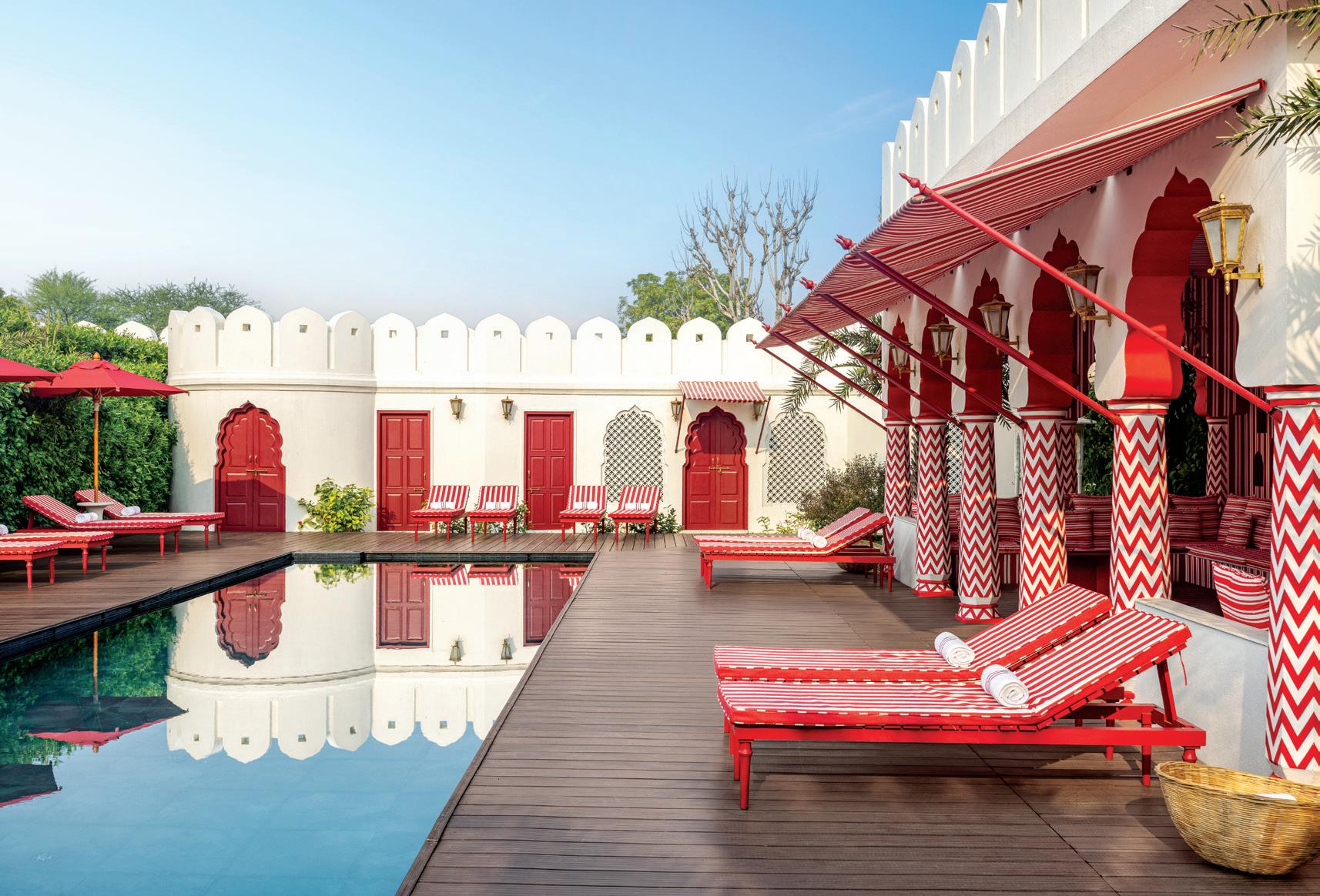
arches, castellated towers, the durg walls, and Rajputi jharokhas, a sense of déjà vu sets in.
The beauty of Villa Palladio is that it feels old and new, familiar and unique all at once, as if it were a dream. Miolini thinks that “design should make you dream. You are stepping into an ongoing aesthetics conversation with each of my projects. I love seeing how guests come up with their interpretations and references to our thoughts and how that contributes to each person’s Palladio fantasy.”
The original building was constructed in 1960 as a heritage haveli-style structure featuring chhatris, jaalis, jharokhas, and arches. The villa served as the residence of a nobleman of Kanota, Abhay Singh.
Was it a challenge to use Italian designs as flesh when the structure is very Indian at its bones? Miolini muses, “Jaipur and Italian designs are much more similar than one would think. Both have been centres of royalty and medieval global luxuries, building a beautiful vocabulary of aesthetics and sophistication when fused.”
History offers many testaments to blending two distinct styles of
architectural practices, as seen in the Musée du Louvre in Paris and the Nelson-Atkins Museum of Art in Kansas, exemplifying the narrative of their grandeur. The key lies in understanding that incorporating something new does not necessarily diminish the value of the old but can enhance its sculptural significance. Oudejans cleverly solves the problem by using a reference from Andrea Palladio (1508-1580), a Venetian architect who first showed the world a way to the Renaissance problem of placing a classical facade in front of a basilican cross-section in the 16th century.
The real problem was to keep the design aesthetic rooted to the land it belonged to, for which Oudejans employed local craftsmen. She states, “Simple village people bring my exotic European imagination to life. Almost all the furniture and decor at Villa Palladio has been locally sourced, including comforters, cushions, rugs, and lamps. The metal craftsman we worked with from the neighbouring village created the Beidermeier-style dining chairs for the veranda alongside the Palladio tents. The awnings are similar to
those seen in Italian palazzi. It is amazing to see how they have immense design sensibilities and meticulousness. Despite having almost no exposure to the Western world, Villa Palladio achieved precise results. It is incredible that some of them never had the opportunity to attend school. Witnessing the exposure to the world and the joy my modest efforts can provide is the most rewarding aspect of my work.”
Initially concealed by large jaalis, the central hall or the salon offers a slow and intriguing reveal upon entering. The salon is a maximalist space saturated in colour, featuring walls adorned with birds, flowers, and leaves, complemented by glossy red furniture, checkerboard floors, and trellis-patterned details. A striped corridor runs along the perimeter, playing a visually engaging game. Two exquisite oil paintings of horses, banners, and leopards add weight to the design, anchoring the entire space. The property boasts nine rooms, including tower rooms that blend palace elements and a circus-like tent. The exclusive suite boasts a separate living and bedroom adorned with mirrors and opulent vines, evoking a deep crimson Wes Anderson style.
The bathrooms, an extension of the room aesthetics, defy the sleekness trend in modern design, prioritising comfort and cosiness. Marble jaalis for showers and redand-white marble floors ensure continuity. Oudejans and Miolini embraced diverse lighting, avoiding halogens or track lights. Instead, the property is adorned with things such as hanging lanterns, Venetian wall sconces, and delicate table lamps, creating a homely ambience.
The pool house, nestled at the garden’s end behind hibiscus and date palms, features a lap pool in black slate with a candy-striped interior akin to caravan rooms.
Miolini aimed to make Villa Palladio feel like a home, foregoing restaurants in favour of dining rooms.
The concept emphasises the private nature of Villa Palladio, offering a menu designed for casual, homely dining, featuring lavish breakfasts, light lunches, poolside delights, and dinner pairings, showcasing classic Italian fare. The breakfast veranda exudes Indian aesthetics, while the garden veranda pays homage to Palermo, combining chevrons from 10th-century Norman-Arab architecture with whimsical vintage beach club décor.
In a world where cities such as Jaipur risk losing the artisanal quality of centuries-old architectural practices, Villa Palladio stands as a vibrant design lesson. While the cityscape may boast beauty, it often treads the path of familiarity, reluctant to embrace experimentation within its prebuilt heritage structures. Villa Palladio challenges this norm, reminding us that the past holds valuable lessons—the awe-inspiring ingenuity of Hawa Mahal, the theatrical spectacle of painting Jaipur in pink, and liberating the creativity of our ancient architects.
Villa Palladio effortlessly does that; it strays boldly from the regular designs and intertwines Italian Renaissance exuberance with the decadence of Maharajas, equally at home in Italy and India, swaying you every minute between the two countries.
TOP: The suite boasts a living room and a bedroom adorned with mirrors and opulent vines, evoking a deep crimson Wes Anderson style.
BOTTOM LEFT: Almost all the furniture and decor at Villa Palladio has been locally sourced, including comforters, cushions, rugs and lamps.
BOTTOM RIGHT: The bathrooms, an extension of the room aesthetics, defy the sleek trend in modern design, prioritising comfort and cosiness.
The original building was constructed in 1960 as a heritage haveli-like structure featuring chhatris, jaalis, jharokhas and arches. The villa served as the residence of Abhay Singh, a nobleman of Kanota.
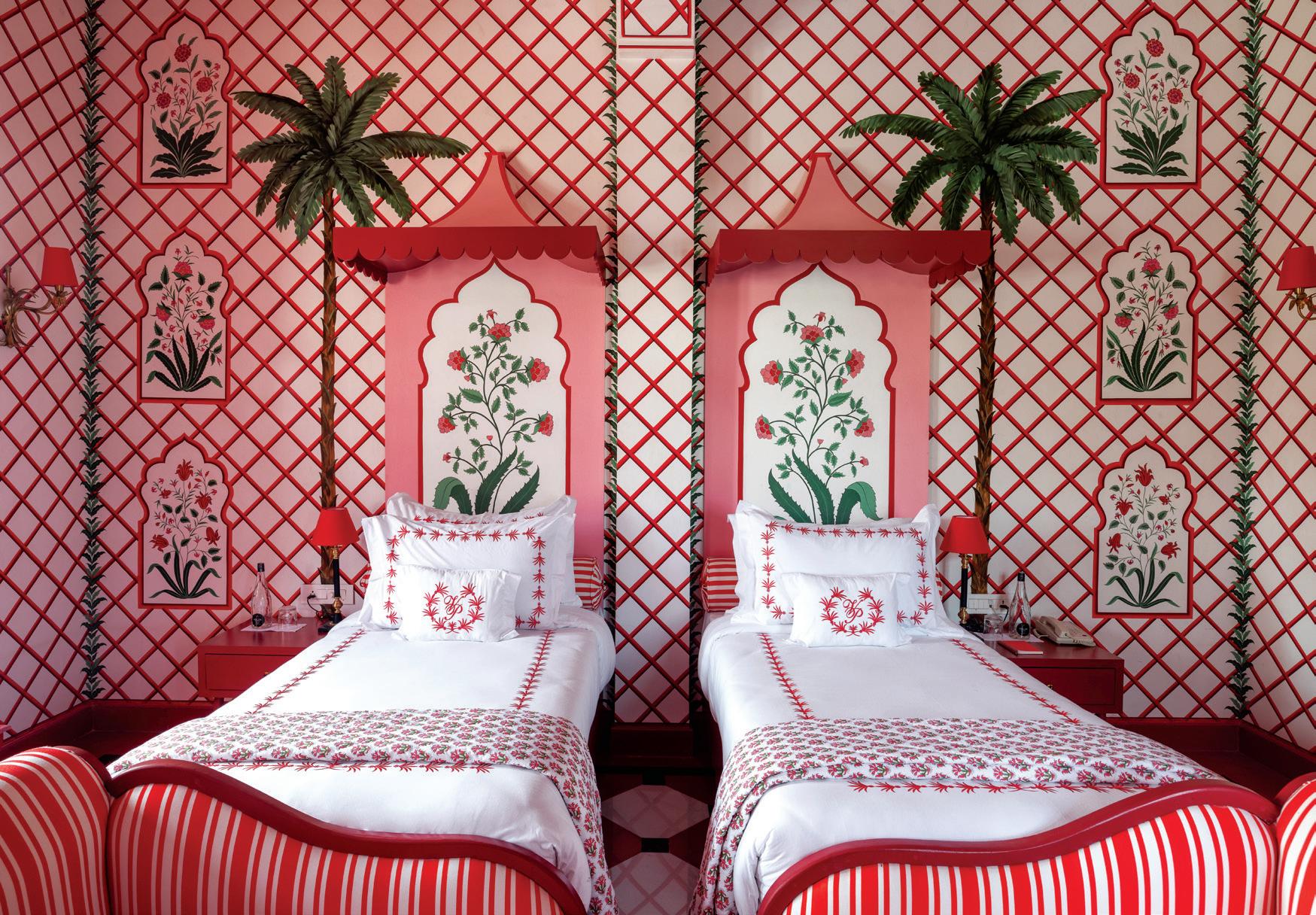
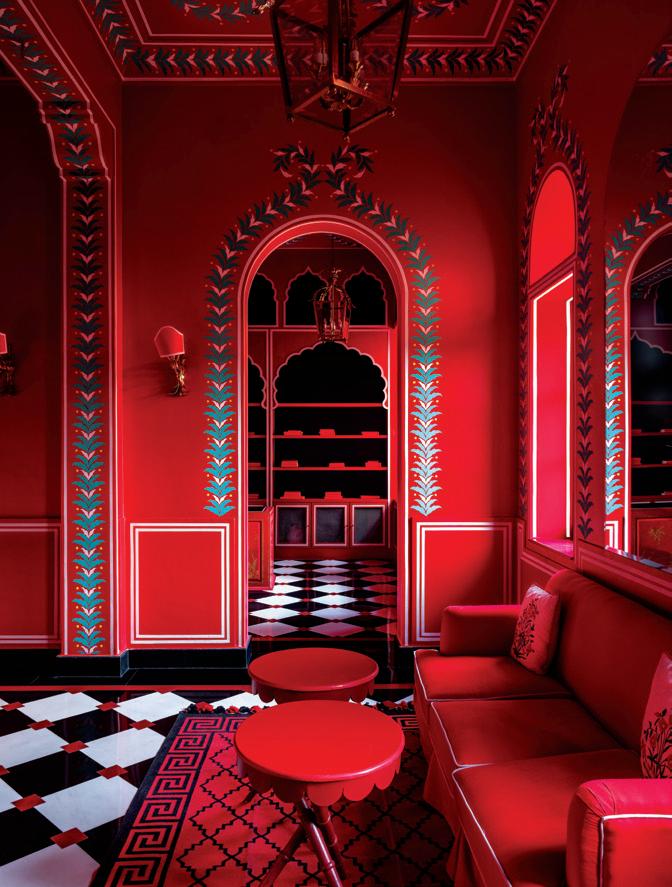
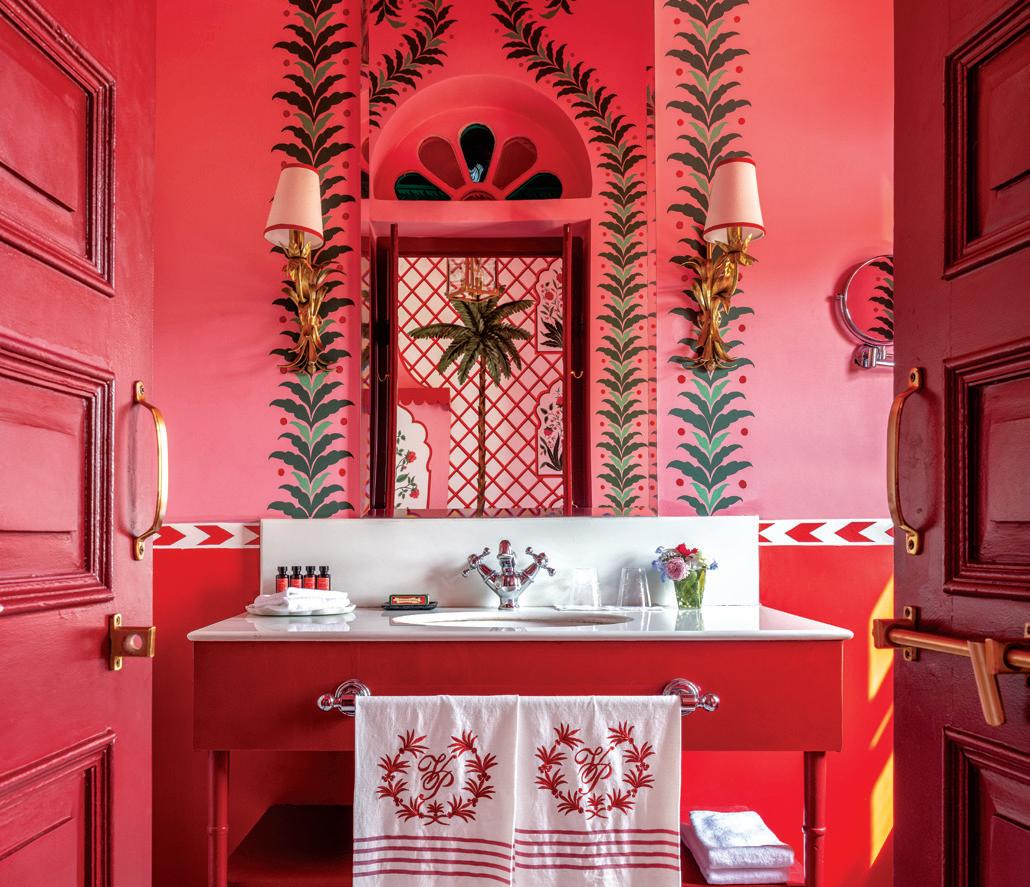

and logistical support for making their

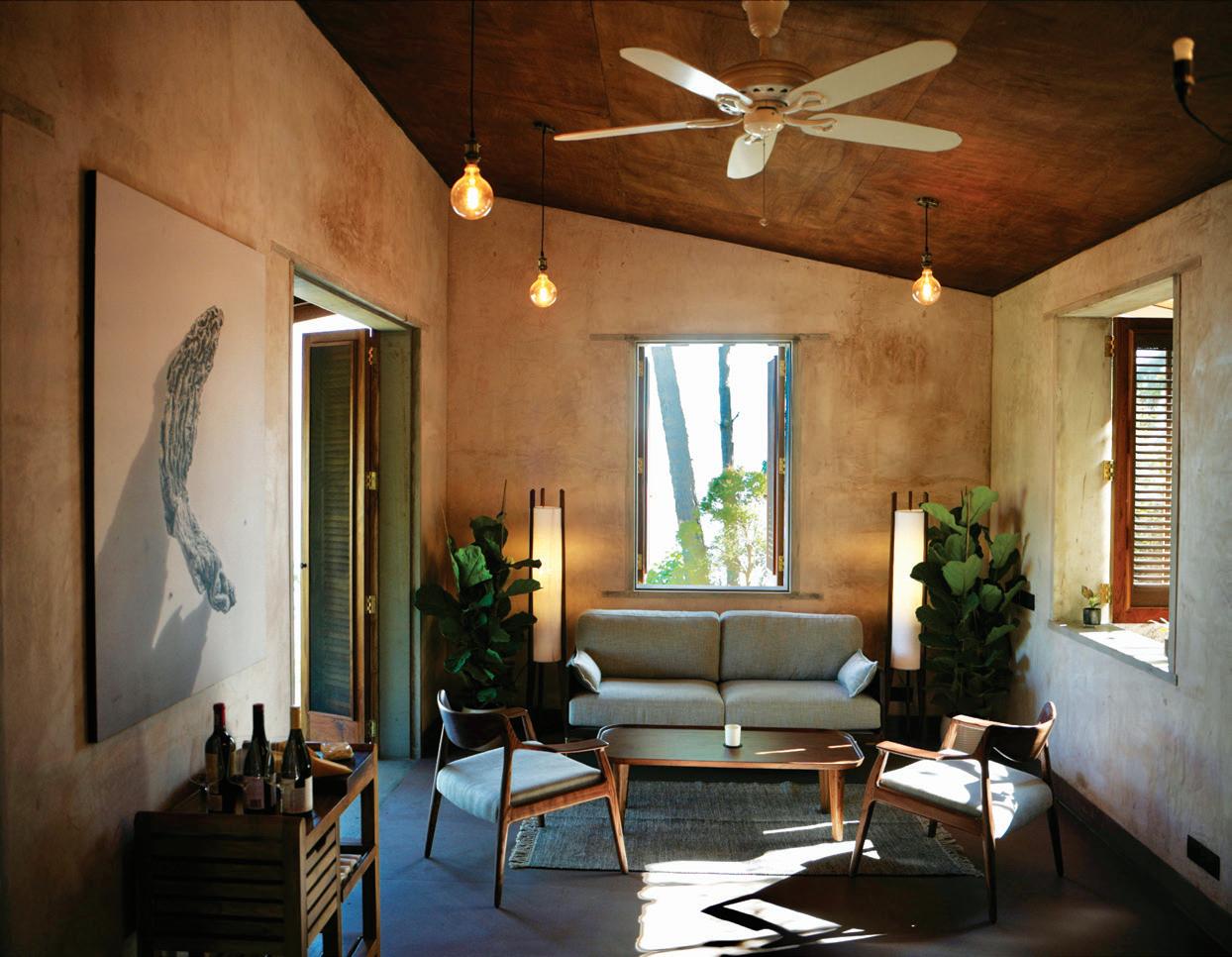
Want to create a distinctive destination restaurant? Here’s inspiration from the chefs who have made the concept work across India.
PRIYA PATHIYAN
When the Michelin Guide devised its system of grading restaurants by stars , the highest honour of three stars (introduced in 1933) was awarded to restaurants that served ‘exceptional cuisine that is worth a special journey’. This concept of ‘destination dining’ has made the culinary landscape an exciting one, with people planning entire trips around a particularly good restaurant, when they score a booking of course.
Inspired by evolved Indian diners travelling internationally to satiate their taste buds and acquire bragging rights by eating at the world’s best restaurants, a few chefs in India have dared to fly solo. Setting up kitchens in remote locations and finding financial backing and logistical support for making their dream projects a reality, they’ve been able to cash in
their culinary cachet to bring in guests from afar. They’ve created a set of loyal patrons who visit often and spread the word wide, giving hope to other chefs who would like to follow in their footsteps. There is learning here for Indian hotels, which are still struggling to get their dining mix and concepts right to create iconic dining brands, much as these independent chefs have done.
While it’s still too early for any of them to have broken even, let alone show sustained profitability, these pathbreaking restaurants are nevertheless the forerunners that everyone wants to emulate. So, what goes into creating a successful destination restaurant? Here are some tips we culled from the chefs’ stories…

A unique selling proposition
Chef Avinash Martins avers, “I believe a destination restaurant needs to have a strong USP, a great storyline, something different that others are not offering.”
Finding good support
The kind of investment needed can be daunting unless you find a backer who has full faith in your ability to pull in people from near and far. Being a successful chefowner does help.
Getting the right team
Attracting a team to a distant location can be a challenge. Training the locals may be time-consuming, but if you have the patience and the deep pockets, this can be a win-win for your restaurant as well as the community you are located in.
A readiness to do anything
According to Chef Amninder Sandhu, “In this business, you should know how to do everything. Things can go wrong at times. Throwing money at the problem does not always work.”
Most such restaurants rely on the support of local suppliers, an understanding of seasonal produce, and the best spots to forage for ingredients. Says Chef Amninder, “You need to do a lot of groundwork about sourcing before you launch a restaurant. It’s always a challenge, to work with unique ingredients, but if you are determined to go for them you can. It’s all about the mindset. Your brain is a monkey, you have to train it.”
Understanding the clientele
They are usually food enthusiasts,
knowledgeable people who have travelled the globe and want to understand the thought process behind what the chef is doing. They’re not straitjacketed by prices, but they do expect value for their money and respect for their dietary preferences.
While your location will play a big role in creating the best ambience, your choice of décor is important if you want to attract the most discerning diners. The logistics and cost of bringing in labour and materials to a remote area need to be considered carefully.
Putting out the correct message
You don’t need a huge ad budget. But messaging is imperative so that you bring in the kind of diners who are on the same wavelength as you. Every positive experience and social media shout-out counts too. The clientele is increasingly reached via word of mouth and social media rather than vanilla advertising.
A great product that you believe in and consistently evolve
Chef Martins says, “Remember, while social media and marketing campaigns help to amplify whatever you’re doing and bring you accolades from anywhere in the world, bringing diners to the restaurant, it’s your product that will carry it forward. If your product isn’t great, it will die a quick death. As a chef, you believe in your product and constantly evolve it. You have to always be on the ball, and relook at the product to see how you can better it from yesterday. It’s a constant challenge. One cannot get complacent.”

While the concept of destination dining may be new to India, many are venturing into the space. Like Damu’s Heritage Dine in the Chug Valley of Dirang district in Arunachal Pradesh, which is run by a collective of eight women from the Monpa tribe, whose culinary endeavours have been given direction by Chef Farha Naaz Laskar (known for showcasing her skills in MasterChef India Season 8 and running the Mamzaki food pop up in Guwahati) and supported by sustainable tourism practitioner Nishant Sinha through WWF-India. Their 11-seater eatery in an old tribal home opened in March 2024 and has already garnered a lot of attention on the culinary circuit, thanks to using foraged ingredients, almost nothing store-bought, and everything which is not fermented or pickled being freshly cooked. From yak cheese to pulled Mithun meat to many vegetarian options using millet, beans, corn, and Monpa orange, there’s a lot to explore.
If not something wildly adventurous, destination dining can also involve changing the narrative of the type of food available at a popular tourist destinations. An example is Saltt at Oleander Farms, which started the truffle oil transformation of the dining out scene at Karjat, or The Paisley Experience’s produce-centric tide-to-table menu that brought Pachkalshi and Agri flavours to the fore in Alibaug.
BUT FOUR CHEFS HAVE TAKEN DESTINATION DINING TO A SUBLIME LEVEL AND HERE IS HOW THEY DID IT.
VELIM, QUEPEM, SOUTH GOA
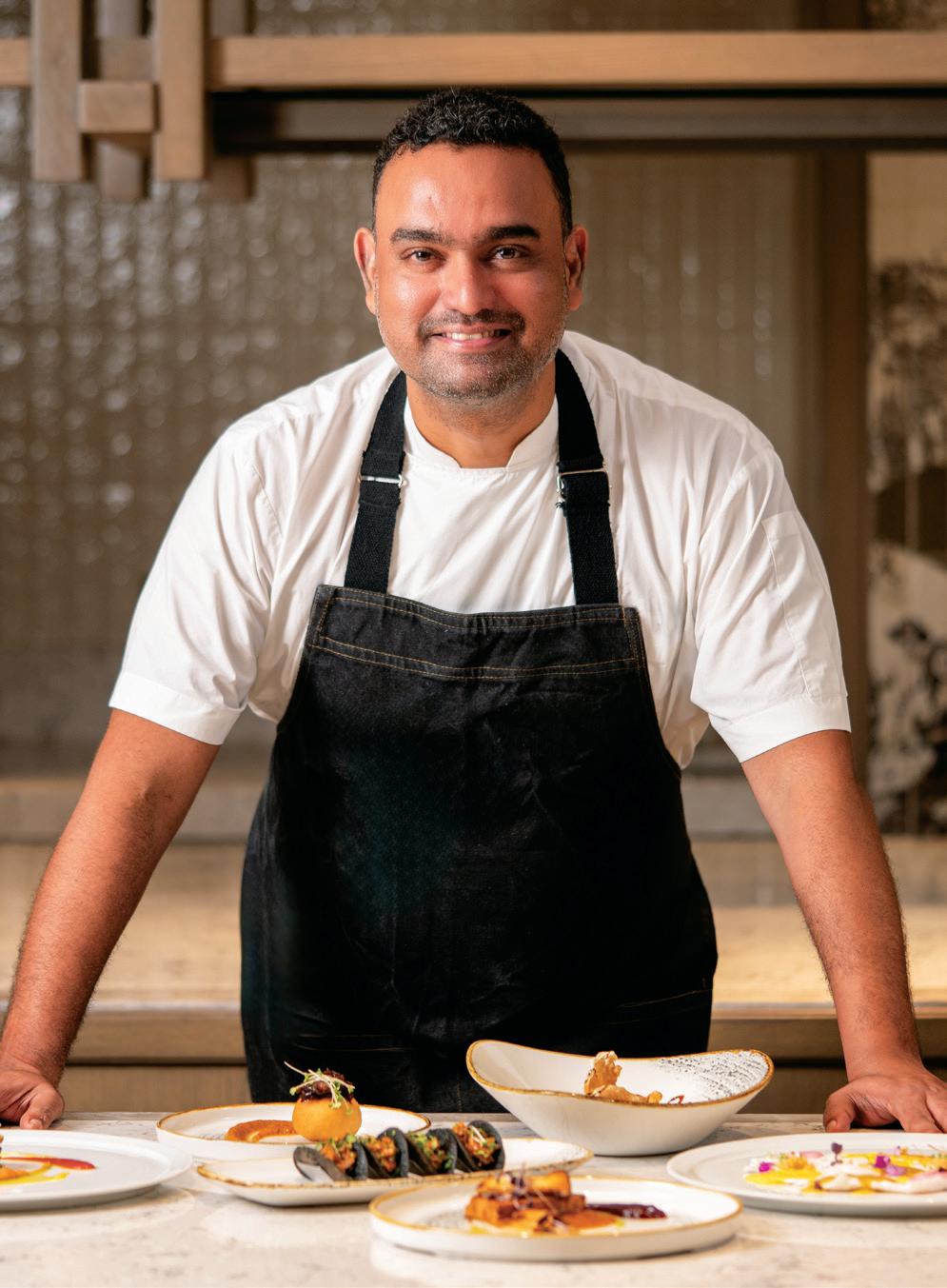
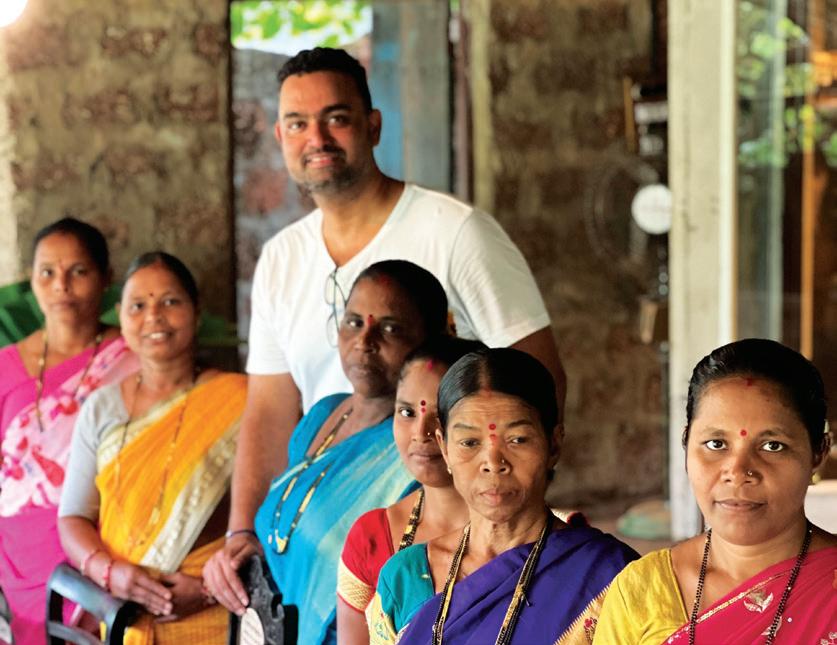
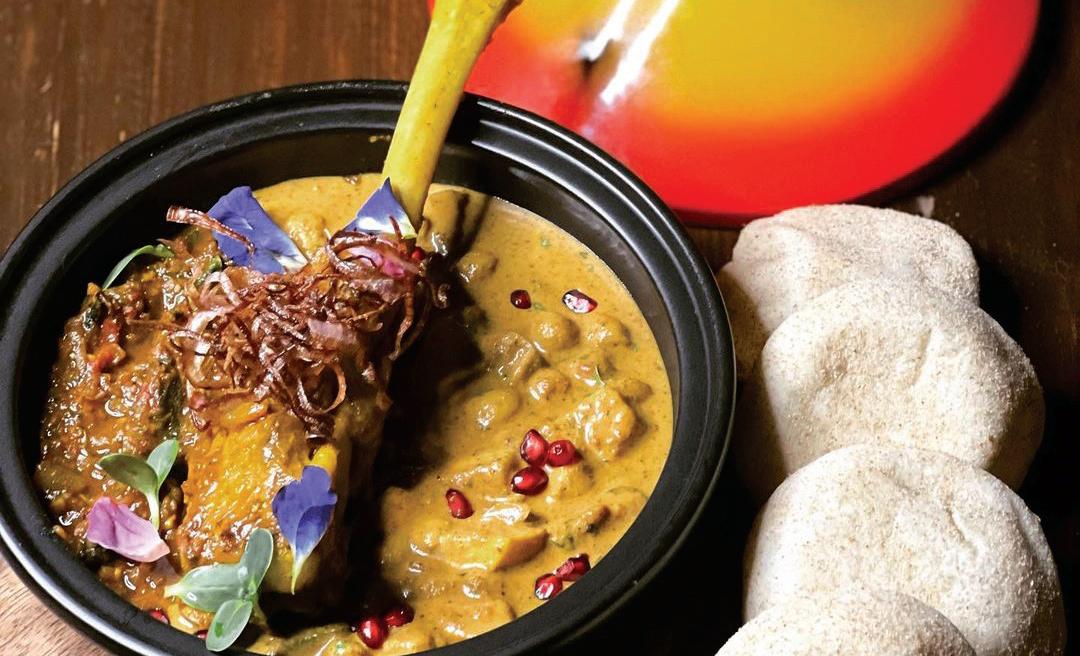
The back story: After working in the merchant navy, then training at OCLD and acing the five-star circuit and stints at places like The French Laundry, he opened his restaurant, the hugely popular Cavatina in Benaulim, North Goa, in 2013. Eight years later, spurred on by the new conditions created by the pandemic, he finally realised his dream of creating C’est L’avi –Table in the Hills (TITH) in 2021.
The birth of C’est L’avi –Table in the Hills: While the biggest investment is usually land, Chef Martins had the benefit of owning an ancestral 250-acre property on which he has built this ecosystem where he thrives
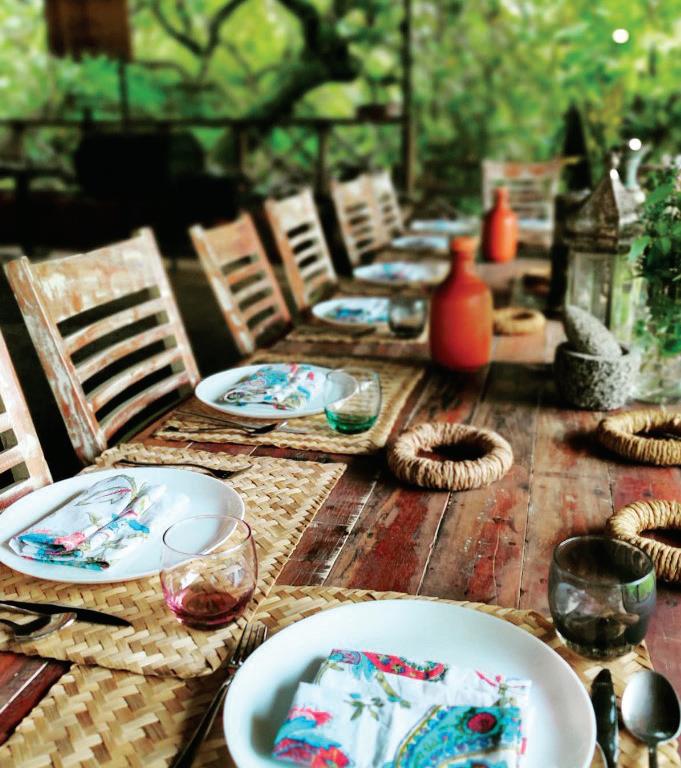

in harmony with animals, birds, and plant life. There were a few challenges, e.g. no approach road to TITH. Everything had to be carried manually to get the place ready for welcoming diners, increasing costs, but they’ve gone with eco-friendly materials like mud and wood. Chef Martins talks about his dream project, which was inspired by how chefs celebrate their mother cuisine internationally. “I knew I was going to serve food with seasonal and hyperlocal ingredients sourced from a five-km radius.”
Why it works: TITH elevates real Goan cuisine to a whole new level. The 12-seater dining destination has a show kitchen, and a garrafões cellar (blown glass bottles from the Portuguese). Guests get a chance to try the food of Goa re-imagined in a storytelling menu, a labour of love by local toddy tappers, farmers, bakers and many such. The celebrated chef describes the simple pleasures of TITH, “You’re sitting in the midst of a jungle. There’s a nice field that fills up into a rivulet in the rain. We use spring water to cook. The heat is wood fire from mango, cashew, coconut and jackfruit trees. We use coconut husks and shells to barbecue and smoke meats, and fresh catch from the local river or sea belt.”


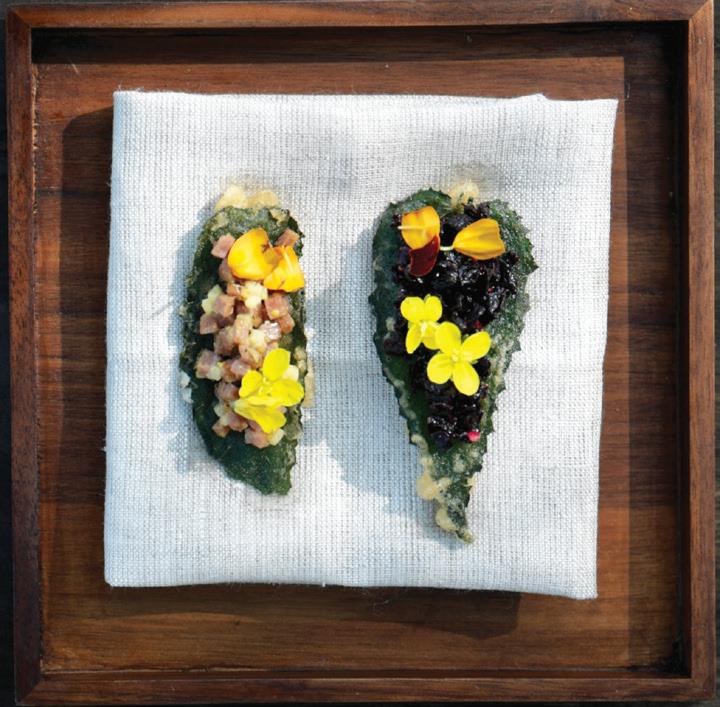
With villas designed by Bijoy Jain of Studio Mumbai and hand-built to blend into the natural surroundings, Amaya was the perfect hearth where Naar's audaciously creative fire was kindled.
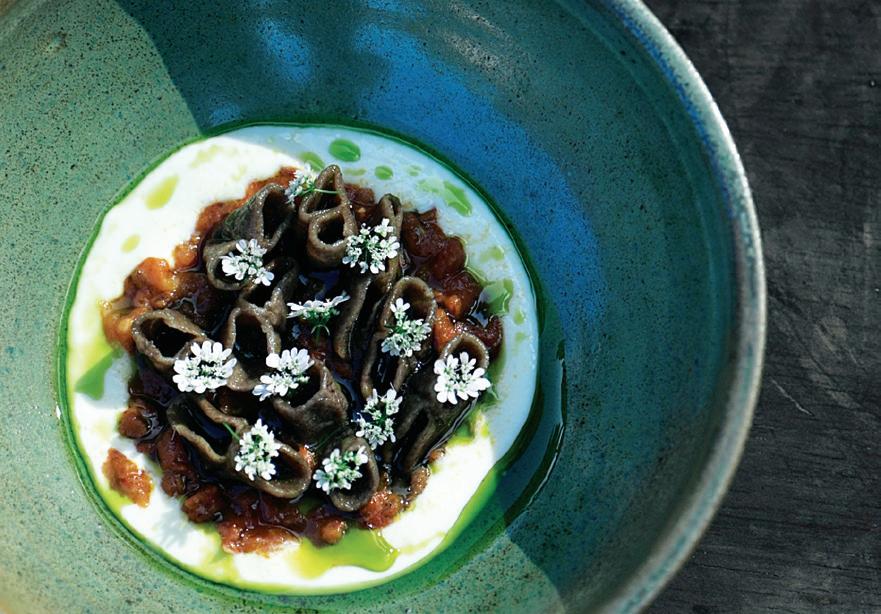
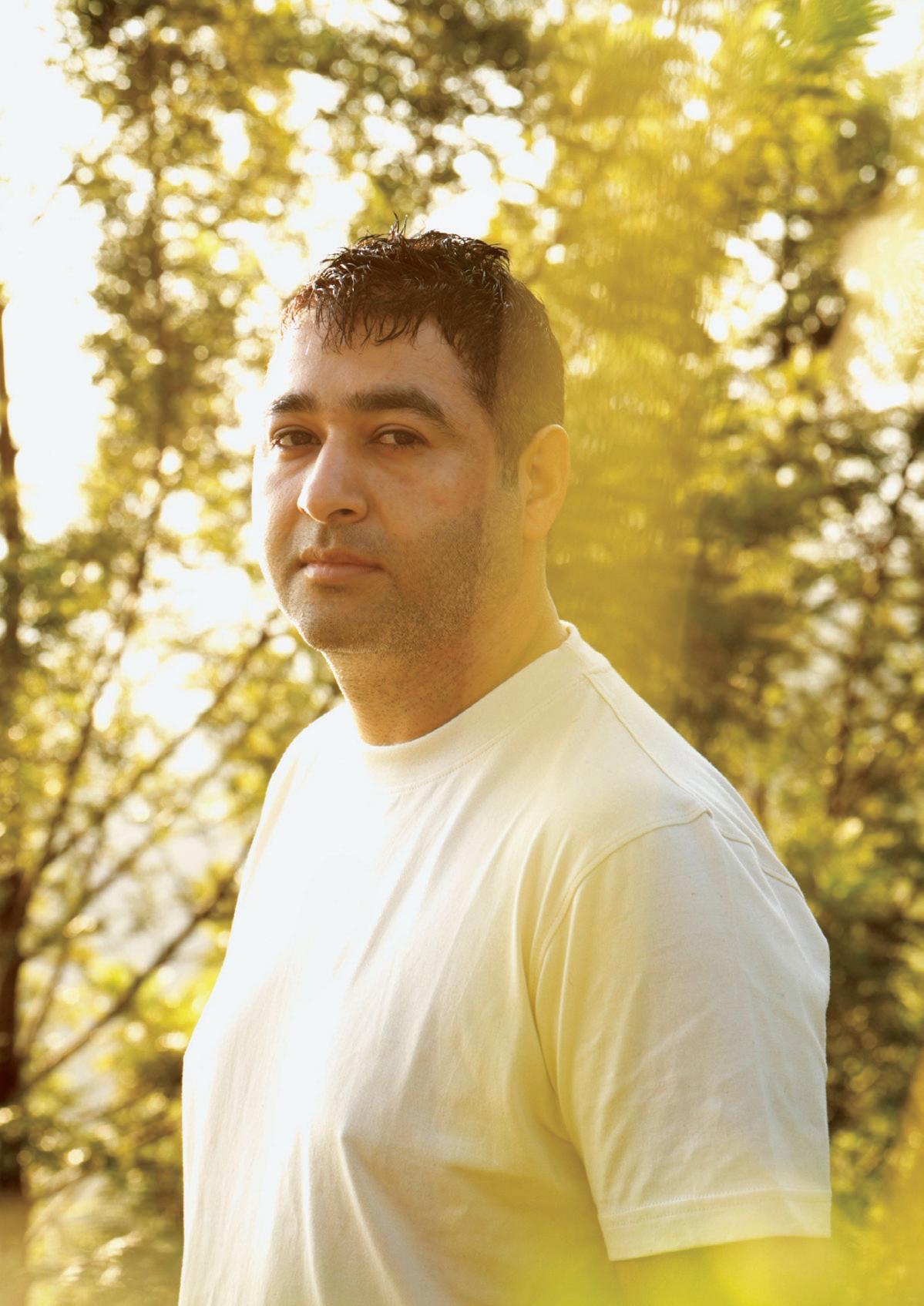
DARWA, KASAULI, HIMACHAL PRADESH
The back story: He had some serious culinary cred such as Noma, Alinea, and The French Laundry under his belt even before he started Masque in Mumbai (considered one of India’s best and most innovative restaurants) as co-owner and executive chef with Aditi Dugar in 2016. When he decided to part ways with Masque in 2022, the culinary world was eager to know where he would be taking his talent for experimenting with India’s regional recipes in modern formats and foraging for ingredients from faraway places.
The birth of Naar: A year later (November 2023), he opened his 16-seater restaurant Naar (meaning ‘fire’ in his native Kashmiri tongue) in Darwa, a small village in Himachal Pradesh, having found a kindred spirit in Deepak Gupta, founder of a sustainable retreat called Amaya. With villas designed by Bijoy Jain of Studio Mumbai and hand-built to blend into the natural
surroundings, Amaya was the perfect hearth where Naar’s audaciously creative fire was kindled. A food lab was set up for all his experiments. The shelves soon filled up with preserves and ferments that found their way into dishes which made diners rethink their notions of fine dining. Chef Sadhu blends the traditional with the contemporary so seamlessly that no one can determine the difference or the distance between them.
Why it works: It was the chef’s reputation that had patrons taking the flight to Chandigarh, and then doing the two-hour drive to Kasauli and beyond. But it is his brilliant Himalaya-centric menu that makes them sing praises for him. To find the peace of the mountains and the authenticity of the ingredients in this location is logical, but to enjoy the pathbreaking culinary art of a cutting-edge chef, find a sophisticated salon, a wine cellar and an ageing room here, seems nothing short of magical.
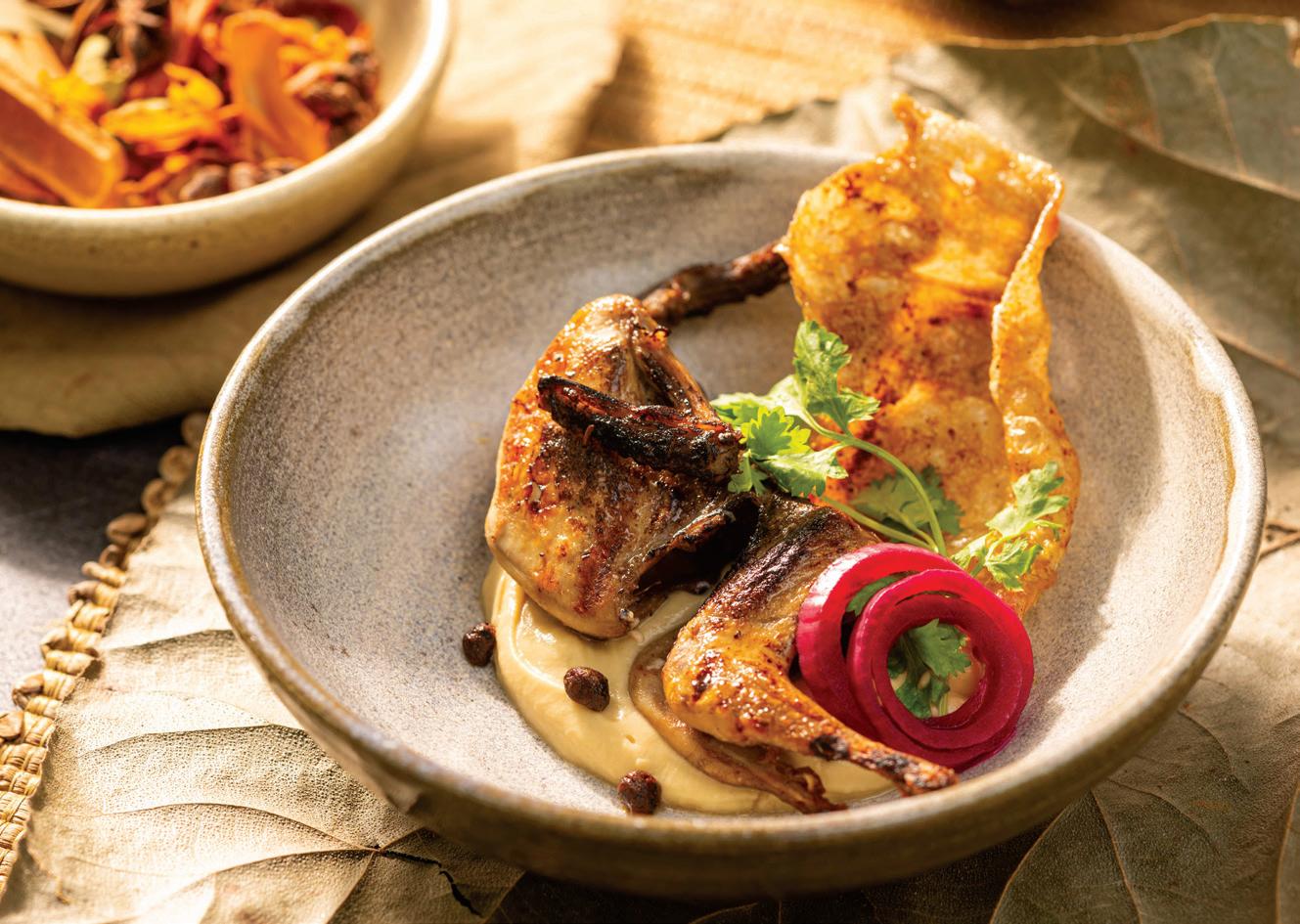


TIPESHWAR, YAVATMAL, MAHARASHTRA
The back story: Her runaway success with the erstwhile Arth in Mumbai, and then with Bawri Goa, had established her as a name to reckon with within the F&B industry. Being a contestant on Netflix’s The Final Table and guest judge on MasterChef India’s Season 6 brought her the recognition from the masses.
The birth of Palaash: While she worked closely with prolific restaurateur Sahil Sambhi on the Mumbai sequel to the Indian restaurant in Assagao, she was also setting up this very unique dining experience in distant Yavatmal. Amid the wilderness of the Tipeshwar Wildlife Sanctuary, Keyur Joshi, Co-founder & COO of Make My Trip, was creating Tipai–Wildlife
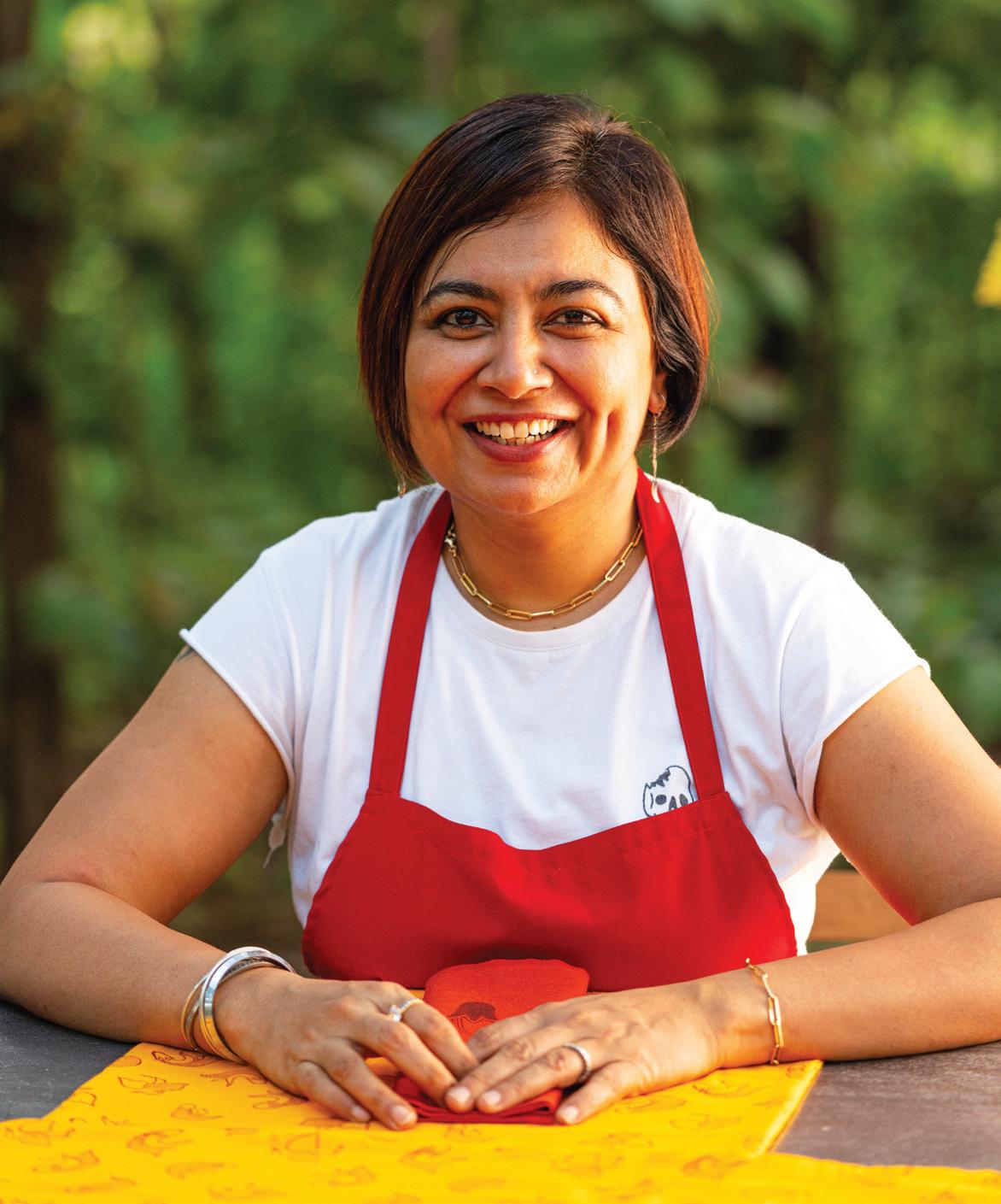
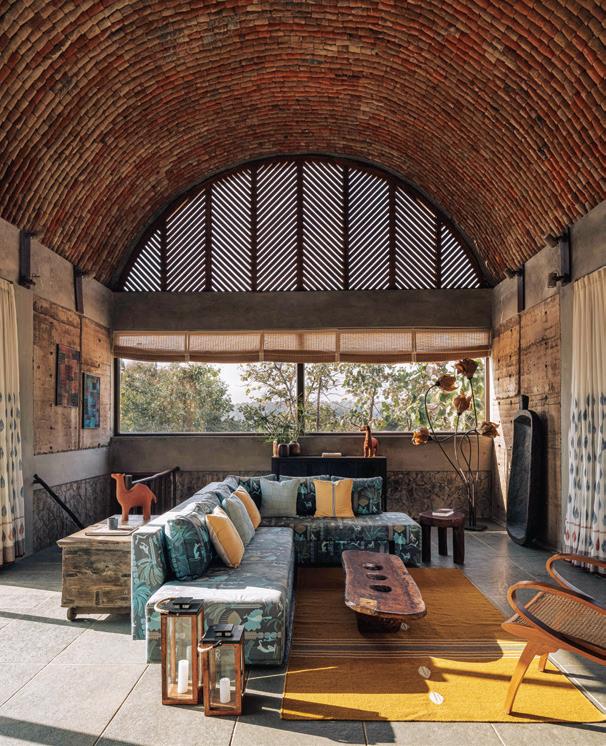
Luxuries India, a luxurious and sustainable resort in a forest. To go with the low-impact rammedearth and vault-roofing build, the untamed-on-purpose pathways, and glorious bio-pool, were the restaurants, with menus curated by Chef Sandhu. “With its six chulas, a robata, and a deep-fat fryer, it reflects a conscious decision to balance simplicity and safety.” The Tipai team believes that her
vision for Palaash extends beyond the plate, focusing on empowering local women and showcasing their skills in the menu. Chef Sandhu is visibly proud, “Since it is in Yavatmal, which is known for a high incidence of farmer suicides, I want to benefit the local farmers by sourcing produce from them for these restaurants.”
Why it works: While all three restaurants at Tipai have been well received, it is Palaash that has her fans going that extra mile to enjoy her culinary brilliance by taking the flight to Nagpur and the 2.5-hour drive to get to it. Functioning since November 2023, Palaash has made its mark with dishes that bring together the local as well as Chef Sandhu’s diverse life influences. Think Nagpur black crab with gauthi garlic and black chilli, bamboo-smoked pork or jackfruit, and puranpoli profiteroles. The multi-course menu cooked by an all-woman team from the locality is served in the al fresco restaurant under palaash trees.




The back story: Regenta SG’s Greenotel in Lonavala was the average mid-range hotel with midrange clientele and modest dining options. But the next generation of the hotelier family— sophisticated siblings Sanskriti and Sagar Gupta—had a new vision for the space.
LONAVALA, PUNE, MAHARASHTRA
The birth of Fiori: They convinced their father that a glamorous glasshouse restaurant serving top-notch European cuisine, elevated cocktails and excellent coffee was just what Lonavala was missing. They brought in Chef Gracian de Souza (who has headed hotel kitchens at Marriott, Intercontinental, The Landmark London and Svenska, sailed with Royal Caribbean cruises, and then made a major
impression with Impresario and the Speciality Restaurants) to curate the menu and transform the rather basic hill station into a destination for dining.
Why it works: Since it opened in early July 2024, Chef de Souza’s easy-breezy brand of superb Mediterranean flavours incarnated in an all-vegetarian menu has been wowing guests who visit Fiori. The restaurant’s polycarbonate sliding roofs can bring the sunshine in or allow guests to enjoy the rain, creating a stunning ambience whether they’re there for dinner and classy cocktails in the evening or breakfast the next morning! Chef de Souza says, “I kept the menu elegant yet not intimidating, focusing on comfort food and classic tastes.”
WE BELIEVE THAT REAL BEAUT Y LIES IN THE DETAILS and many more.
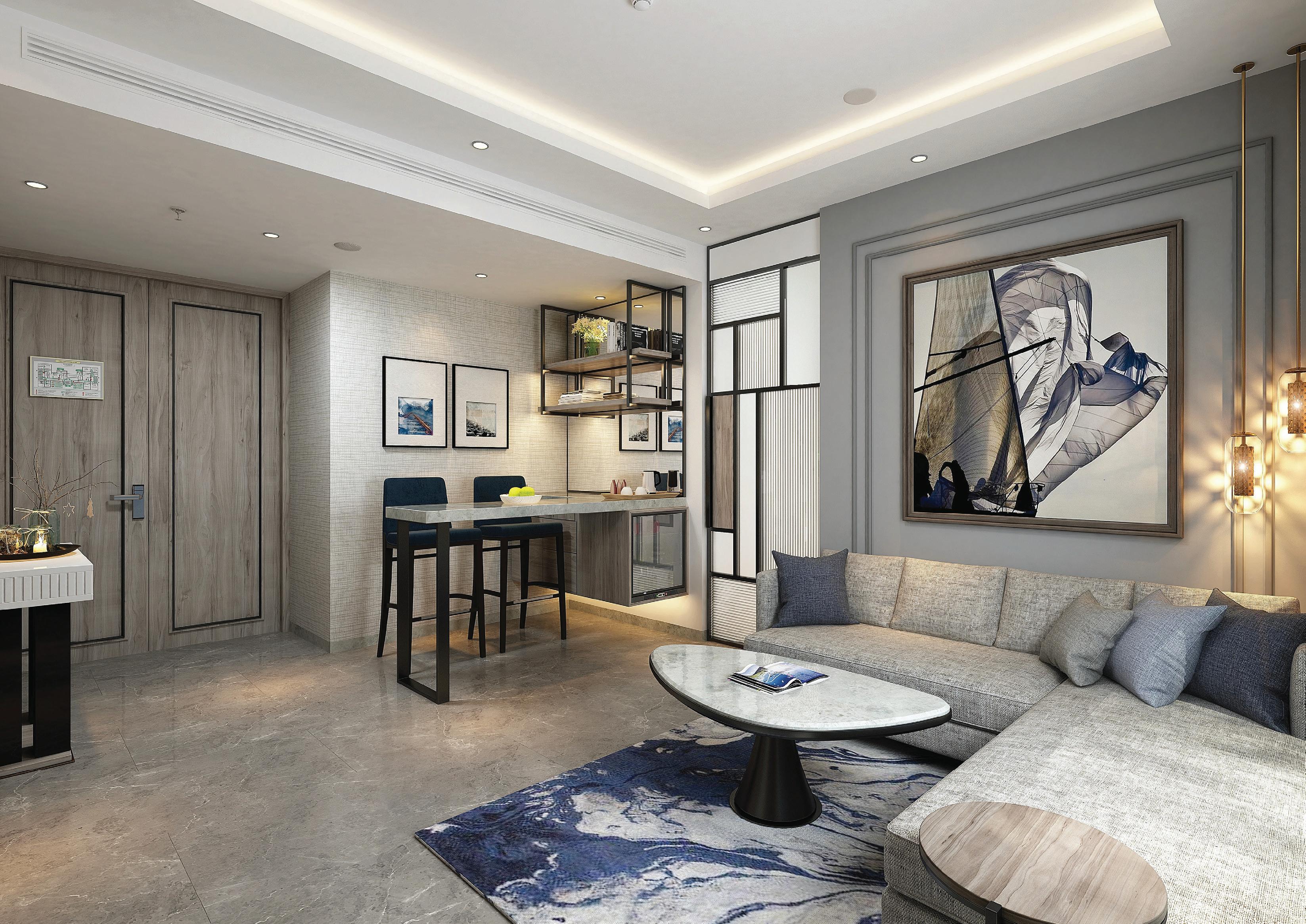




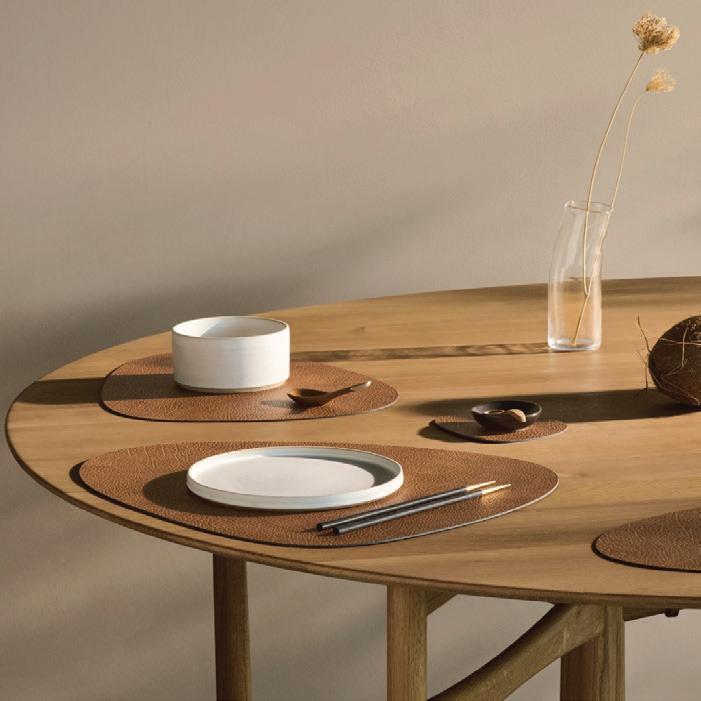

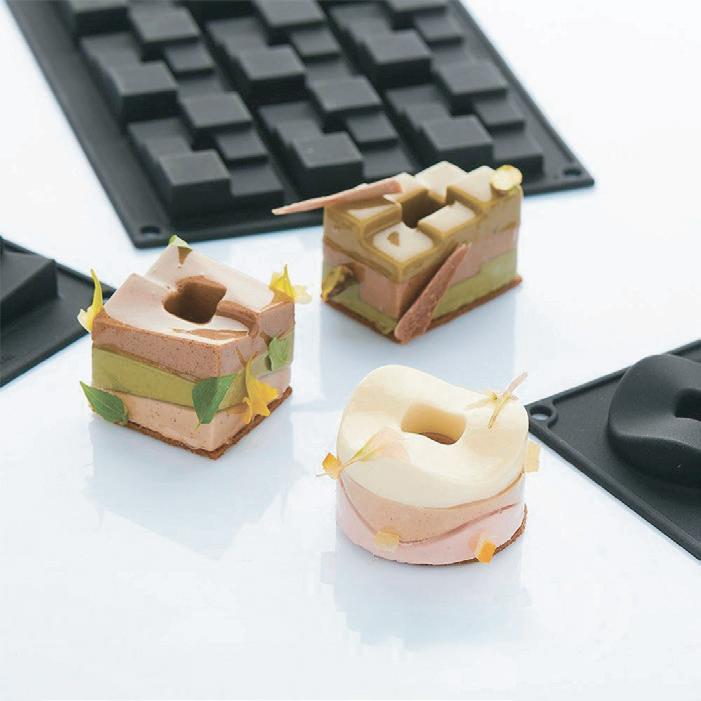
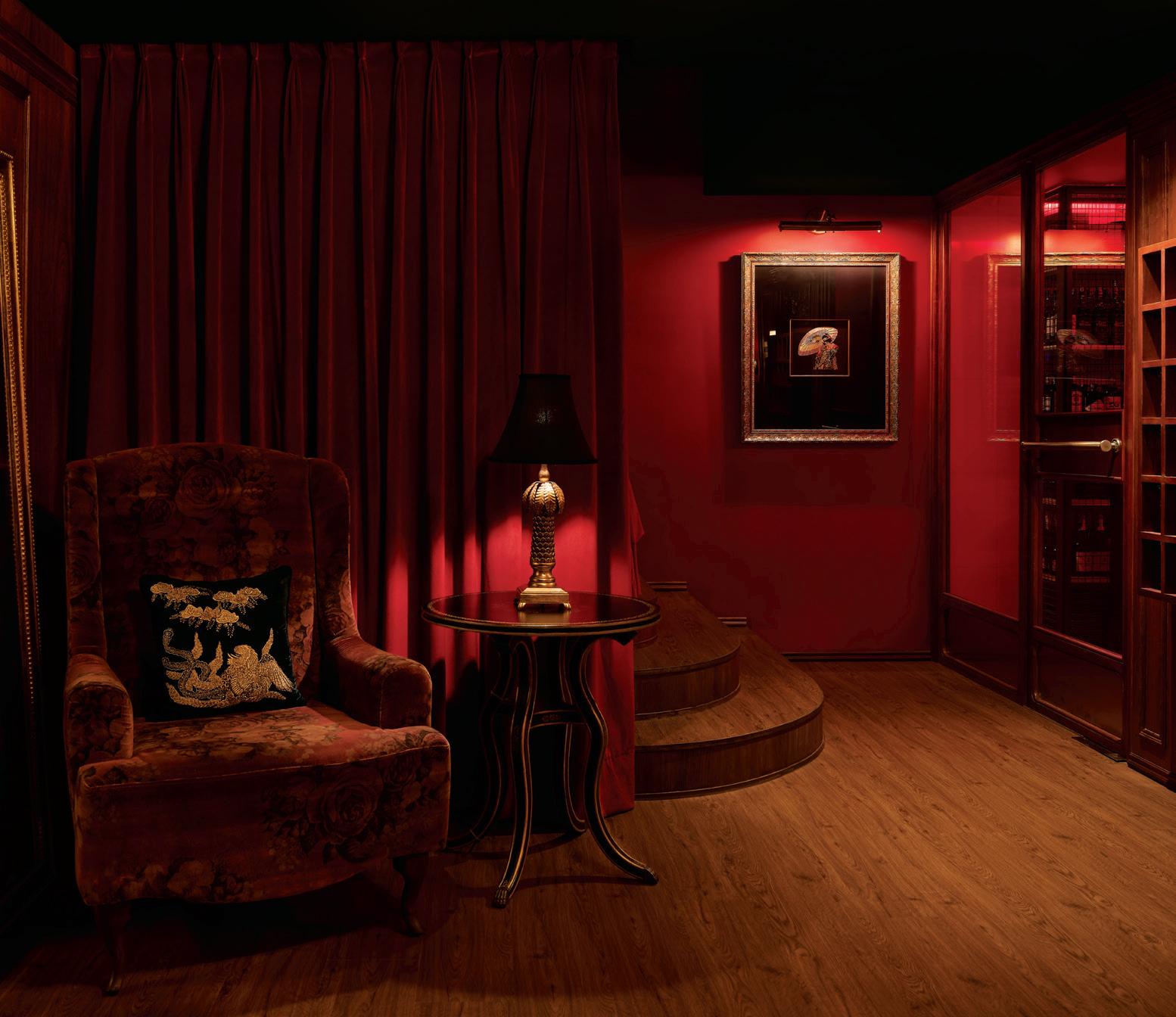
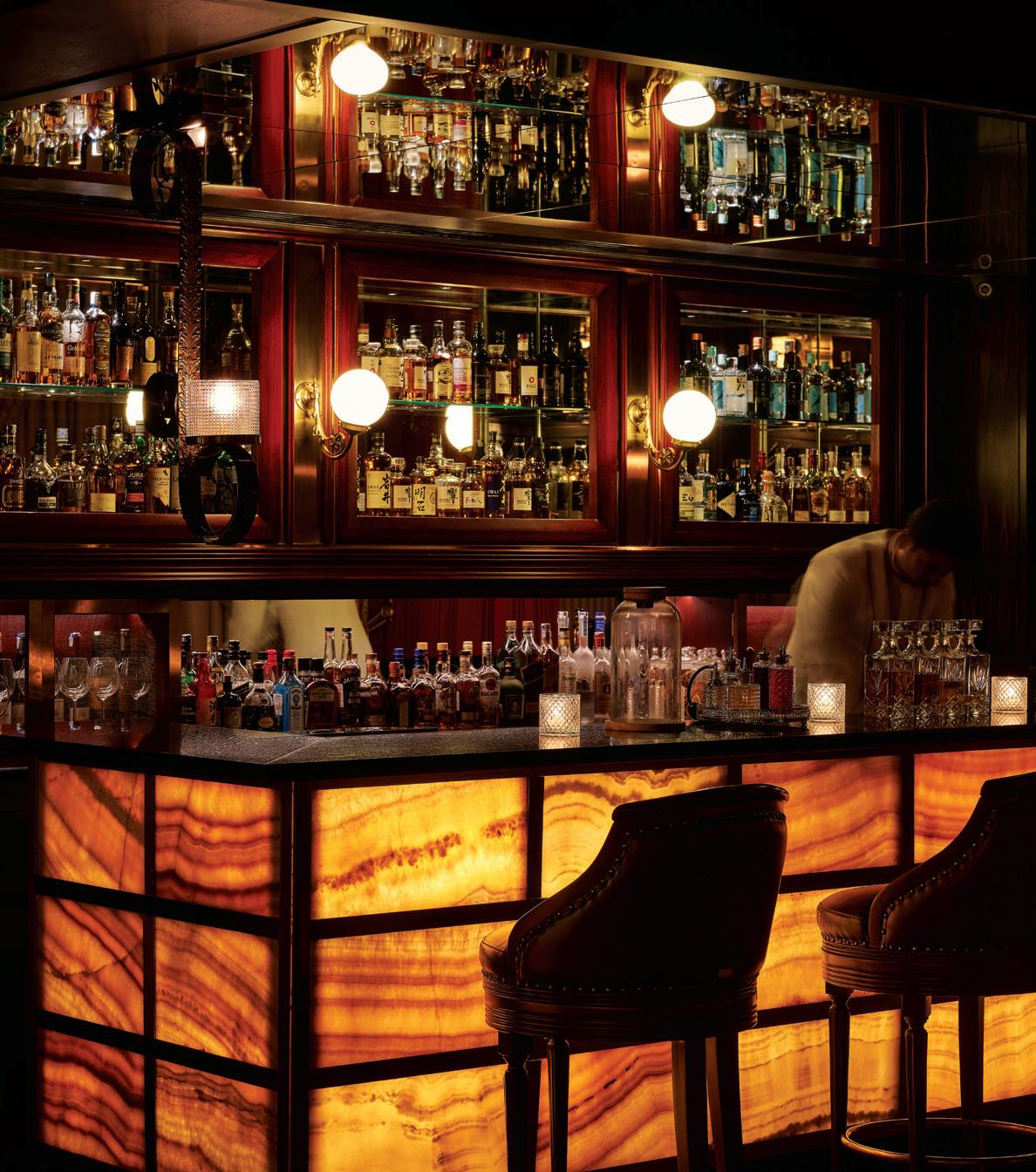
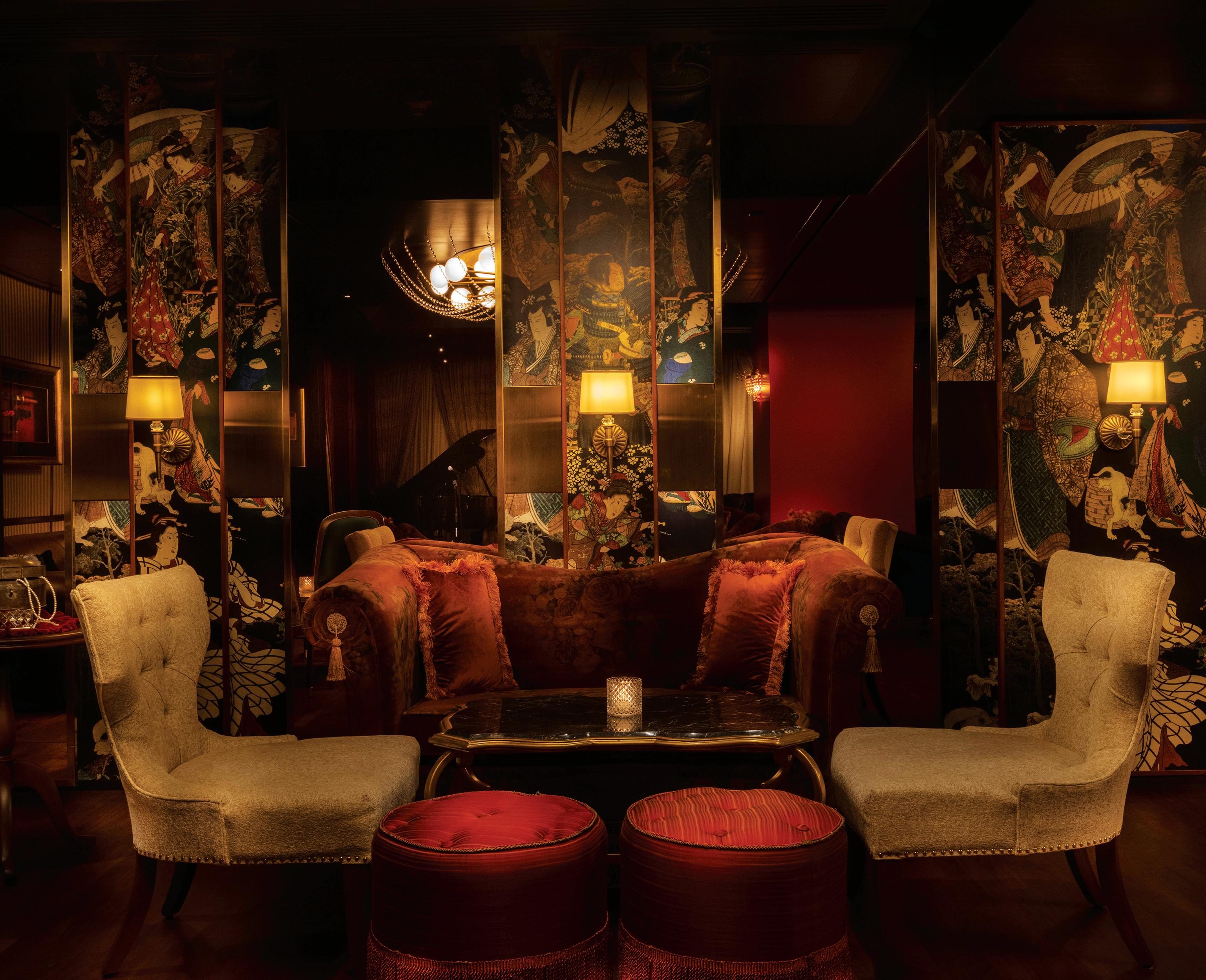


ZLB23, the speakeasy gem within The Leela Bengaluru finds itself listed on Asia’s 50 Best Bars. How did it shake up India’s hotel bar scene?
It’s just over a year old and ZLB23 at The Leela Palace Bengaluru already sports several feathers in its cap. The Kyoto-inspired speakeasy captured the 40th spot in the coveted Asia’s 50 Best Bars list this year and was the only Indian bar to make it to the top 50. Additionally, it was also anointed as the country’s best bar. This recognition came on the heels of the bar bagging the sixth position in 30BestBarsIndia’s 2023 ranking, and topping its ‘best bar design’ list.
“From a hotel bar’s perspective,” opines Vikram Achanta, co-founder, 30BestBarsIndia, “its arrival on the scene has suddenly got hotel GMs across the country to focus on their bar programmes. That is only good news for their hotels and the drinking culture in India.”
The team is celebrating. “We have immense pride in our hearts, as we created history through this recognition and have put ZLB23 on the vibrant and diverse bar map of Asia,” exults Madhav Sehgal, Area Vice President – South India, The Leela Palaces, Hotels and Resorts and General Manager, The Leela Palace.
“When we were ideating about a new bar concept,” he says, “we wanted to offer patrons in Bengaluru something different. A Kyoto-inspired speakeasy bar in a five star luxury hotel was a unique concept, untouched to say the least. From conceptualisation to design, execution and bringing to life, the journey of ZLB23 has been gratifying and memorable.”
Going by the enthusiasm with which the city’s discerning drink lovers have hailed ZLB23, the bar destination has proven to be as memorable as its creation journey. Weekday footfalls—which hover around 70 people every evening— almost double on weekends.
Part of ZLB23’s success can be attributed to the fact that it caught the COVID-19-catalysed trend for quiet, intimate places (just what the speakeasy culture advocates) at the right moment on its upswing. The Japanese influence added to the intrigue value.
Needless to say, ZLB23 takes both its thematic pillars seriously. True to the speakeasy nature, the access is deliberately elaborate and complex, involving a journey that crosses the clatter of a busy kitchen and involves taking an inconspicuous elevator marked with a mysterious ‘Z’—creating a sense of mystique that has resonated well with guests. The place-making—scripted by Shruti Jaipuria of Bengaluru-based MAIA Design Studio—strikes the right notes, too, to establish a sense of a secretive underground culture.

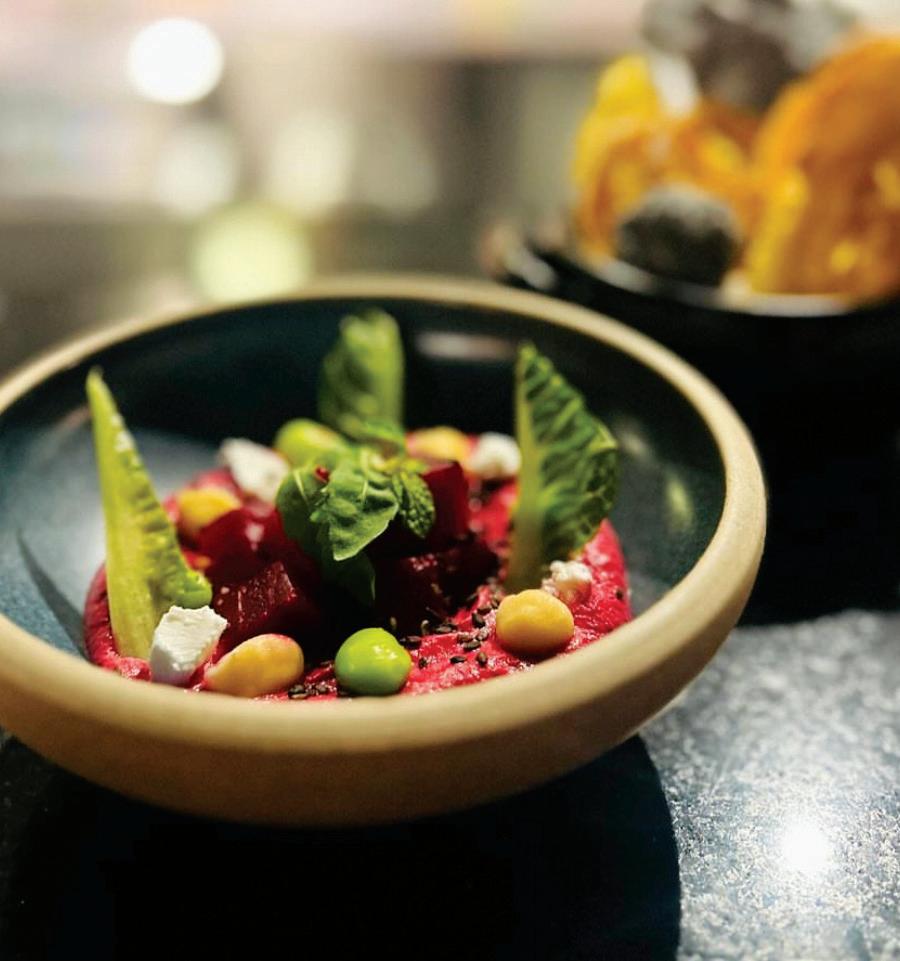

The soft, dim glow of chandeliers gently reveals a world of plush sofas, rich Japanese imagery, gleaming mirrored surfaces, and sumptuously embroidered textiles imprinted with traditional Indian artisanal forms (from Sabyasachi for Nilaya by Asian Paints’ Heartland Collection) that refer to Kyoto’s preoccupation with the perfection of handmade art and craft.
Within this immersive ambience, skilled mixologists serve a heady line-up of prohibition-era-inspired cocktails (the speakeasy, remember, is the birthplace of cocktails), flavourful and high on storytelling, while purists make a beeline for a fine selection of world-class spirits, including Japanese whiskies. The bar menu has been recently updated after a lot of experimentation, trials and errors, says Rajiv Mukherjee, head bartender. Given the nature of the bar, a lot of ingredients have to be sourced from the international markets. Suchismita Roychoudhury, ZLB23’s bar manager, enumerates a few that need to be sourced from Japan alone: “For Japanese Old Fashioned, we use kokuto sugar (Japanese brown sugar) from Okinawa. We import pomello, cold-pressed yuzu juice, as well as hachisunoha (dried lotus leaves) with which we smoke grilled food before plating.”
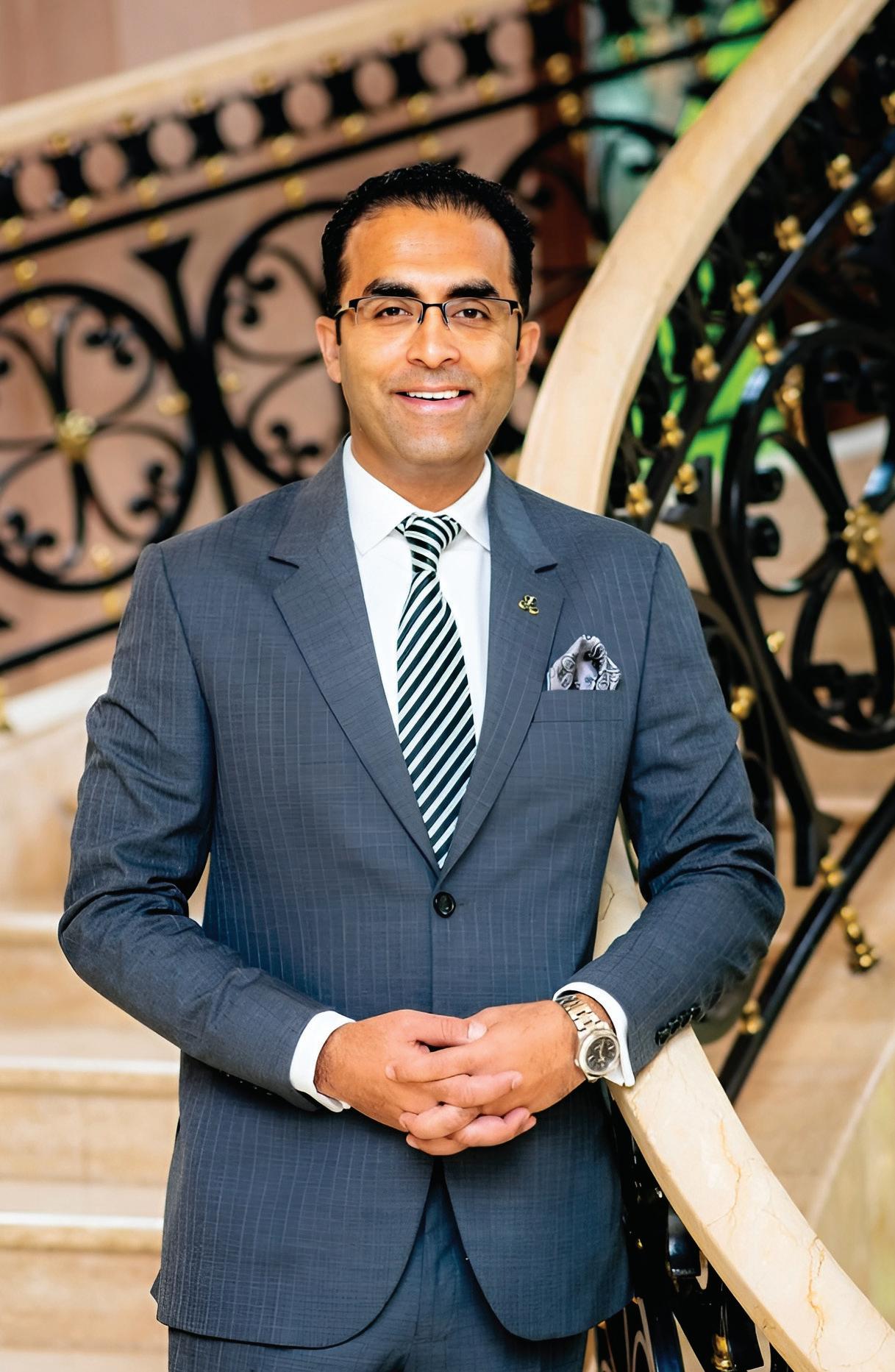
MADHAV SEHGAL AREA VICE PRESIDENT – SOUTH INDIA, THE LEELA PALACES, HOTELS AND RESORTS AND GENERAL MANAGER, THE LEELA PALACE BENGALURU
“A Kyoto-inspired speakeasy bar in a five star luxury hotel was a unique concept, untouched to say the least.”
ZLB23, facilitated by The Leela Palace, is working towards elevating the Indian cocktail culture through an exciting takeover programme.
The sustainability factor
But that’s not to say Team ZLB23 is not prudent with its resources. Innovation, inventiveness and economic sagacity converge in one of Mukherjee’s favourites at ZLB23, Kyoto Autumn. Its restrained presentation might be the very antithesis of Kyoto’s luscious autumnal beauty. But take a sip, and the tropical flavours of pink guava, passion fruit, and peach melded with agave spirits, paint a picture of the island nation’s autumnal fruit harvest on your tongue. Its decoration, a sliver of house-made guava jelly, is of particular interest. “This is made by cooking guava pulp on a nonstick pan,” reveals Mukherjee. “Guava contains natural pectin which tends to solidify when moisture evaporates during the cooking process. We use this method to make guava cheese.” Plum Manhattan, on the other hand, uses vermouth flavoured with plum and aged in a clay pot for that wonderful earthy scent. The pickled plum left over from the infusion process is transformed into a garnish by pairing it with feta and potato biscuit.
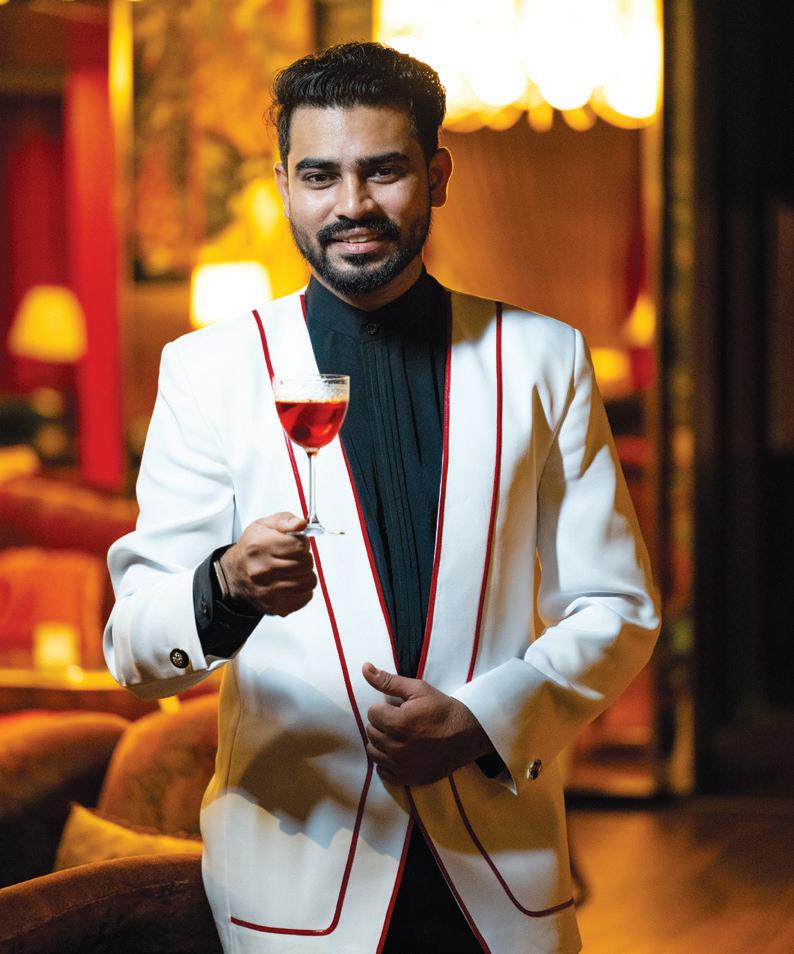
Achanta compares ZLB23's resonance with guests with that of Singapore's Manhattan bar. “Back in its heyday,” he says, “guests used to check into the Regent Singapore (where Manhattan is located), just so they could gain access to the bar, such was the rush and fame it had. (Editor: Regent Singapore is now Conrad Singapore Orchard.) One hears
Glassware and ice are important contributors to the beauty and presentation of world-class cocktails and spirits. ZLB23 uses the best-in-class ice machines by Hoshizaki (coincidentally, a Japanese brand!) to make clear ice blocks and spear ice, which is visually appealing with slow dilution.
All glassware is imported from Urban Bar, UK. They use the 1920 and 1930 series inspired by prohibition-era design. The delicate etched patterns mimic the bubbles in the drink, giving a wonderful effect and adding depth to the presentation.


Within this immersive ambience, skilled mixologists serve a heady line-up of prohibitionera-inspired cocktails (the speakeasy, remember, is the birthplace of cocktails), flavourful and high on storytelling.
similar tales now of ZLB23 at the The Leela Palace Bengaluru, and not a day goes by without us getting a call from a hotel across the country keen to also get their bar program on the map. Just for this, ZLB23 deserves applause for helping reinvigorate the climate for hotel bars in India.” Since the opening, he adds, ZLB23 has not slackened the pace, with their second menu already out. “The entire bar’s programming from the all-woman crew on the floor (and partly behind the bar), to the stellar bar bites and the live jazz, all come together in a
compelling offering,” he states. He also draws attention to the bar's soulful, nuanced interiors which were feted in 30BestBarsIndia's 2023 award cycle. “One of the design jury remarked on how the design was also risk-taking. Which five star hotel, especially one of Leela’s calibre, would allow entry to the bar via the back area of a restaurant?”
Elevating the cocktail culture
In addition to upping the benchmark for ambience, service, food and drinks, ZLB23,


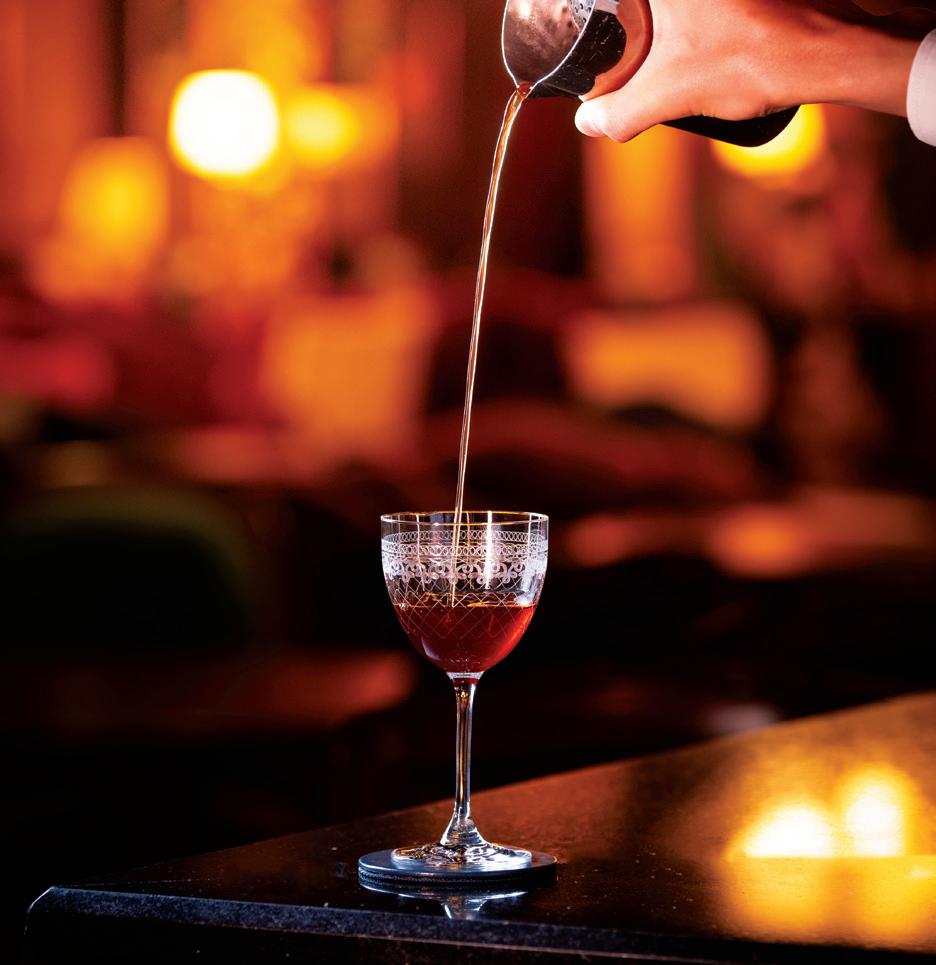

facilitated by The Leela Palace, is working towards elevating the Indian cocktail culture through an exciting takeover programme studded with award-winning libation luminaries such as Shingo Gokan and bars from across the world. While the drinks programme has been imagined anew, the bar has continued with its food menu—comprising small plates (a speakeasy go-to), serving indulgent world cuisine with a Japanese twist.
Hickory Smoked Duck, a star attraction—“It has converted non-duck eaters into fans,”
smiles Roychoudhury—features pan-seared duck breast with miso glaze, accompanied by a truffle passion fruit emulsion and pangritato. Among the many seafood options is Maguro Tataki, in which lean pan-seared tuna slices are topped with a rich chilli miso sauce and served with ossetra caviar and saffron tuile. Cream and crunch come together in the Burrata and Broccoli Toast with hazelnuts and edamame, while a gluten-free option shines with beetroot hummus, homemade crackers, mint vinaigrette, edamame and lettuce.
And then there’s the music, of course. ZLB23 has become quite a well-known jazz destination in the city, with curated live music performances (of jazz and more), underscoring the subculture kinship of both, the music genre and speakeasies. Prohibition Era Cocktails, Magnetic Music and Fabled Food. These are the pillars ZBL23 on which has been erected. All three dovetail into a multi-sensory experience that lingers, long after the lights have been dimmed and the last cocktail drunk…
BY DEEPALI NANDWANI

Now that the revolution has changed the government in our neighbourhood, it could be interesting to explore how hotels in India were once part of the social and cultural transformation. Back in the day The Grand Hotel, now known as The Oberoi Grand, Kolkata, was the largest and most opulent hotel in the city. However, during the Indian Independence movement, it became a hub for revolutionary activities and political meetings.
The Taj Mahal Palace Hotel, Mumbai has a secret room that was used as a bunker during World War I. The room, which remains largely undisclosed to guests, was a precautionary measure for the hotel’s guests and staff during turbulent times. The land The Leela Palace in Chennai was built on, was the site of the British East India Company’s trading post.
The wellness boom is redefining the very essence of how you relax when on a vacation. Hotels are stepping up with immersive experiences by offering recoveryfocused services for those who push their limits with extreme sports and active pursuits. But Willowbrook Spa at The Lake House on Canandaigua in the US takes the entire cake when it comes to customisation. Guests can craft their own personalised experience, from custom-blended massage oils to herbal tinctures. Outdoors, private barrel saunas overlook the serene lake, each with its own shower and resting area. These pods create an al fresco contrast bathing circuit—a revitalising experience for even small groups of friends.
The Internet of Things has reached the world of hotels and is transforming it in various ways. In Europe, hotels are leveraging popular entertainment platforms like Enseo that allow guests to log in to their favourite streaming accounts and automatically get logged out upon check-out. Some are upgrading a smart speaker, such as Amazon Alexa, to handle hotel-specific requests with systems that enable guests to use voice commands to request services such as housekeeping or valet.
India's coffee culture has introduced many to the pleasures of this beloved beverage. However, hotels in the country have yet to fully embrace the trend despite the rise of intriguing coffee brands and skilled roasters. According to a recent report by US-based Hotel Tech, a growing segment of coffee enthusiasts is willing to travel specifically for coffee experiences or expects higher coffee standards in their accommodations and hotel cafes.
Around the world, hotels are capitalising on the 'travel for coffee' trend to attract passionate coffee drinkers. Closer home, some travel to the coffee estates of Coorg for their share of coffee tourism. Hotels worldwide have leveraged the ‘travel for coffee’ trend to offer another experience for those who are passionate about coffee. The NoMad Hotel in New York, for instance, offers a coffee programme featuring high-quality beans. The Hoxton in London employs trained baristas and sources coffee from local roasters. At Park Hyatt Kyoto, baristas blend traditional Japanese aesthetics with innovative coffee prep rituals.
